Future Bloggery:
There is a free version, where you can read posts and subscribe to a free podcast, that contains “best of” old content.
If you upgrade to any of the paid versions, there’s much, much more.
Enjoy.
You're Already A Fan, You Just Don't Know It.
Future Bloggery:
There is a free version, where you can read posts and subscribe to a free podcast, that contains “best of” old content.
If you upgrade to any of the paid versions, there’s much, much more.
Enjoy.

When I lived in Portland, many years ago, I saw Wanda Jackson, on a tour where she was singing with pickup bands at each stop, usually a local act that was probably also the opening band, if I recall correctly. Anyway, the whole show was arranged by Miss Meghan, a DJ that I worked with back then, and she and her friend were the “between act DJs,” and I was there to help wrangle the gear, or something. (I might have just gotten on the list and showed up. It’s hard to remember precisely, as I got to do a lot of both when I lived in Portland and worked for KPSU.)
Anyway, Wanda was amazing, and it was a fun night of drinks and flirting and great music and rock and roll that was always my goal, most nights, back then. One of those nights that you don’t get to engage in, very much, anymore, for a lot of reasons, many practical, others… less so.
But, I know that any day now, I will be sad that she has passed, and I will get to remember that night again, then.
And, it’s also Friday, so: maybe we should just have a party in honor of someone truly great, and celebrate someone I like before they have passed.
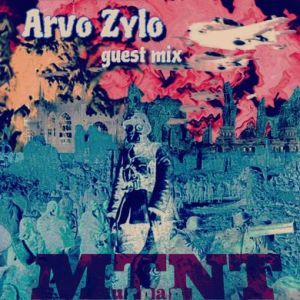
As is often the case, we scratch each other’s backs in the rough and tumble world of creative expression. And that is very much the case in radio. I’ve been a fan of Hollow Earth Radio for years now, a place that started out as an all ages venue, and has evolved into the radio station that it is today. Available on KHUH 104.9 in the Seattle area, and reliably available to listen to at their website, where they offer some great shows.
In particular, Urban Mutant not only seems to have a lot in common with my own show, but we have a guest DJ in common, too: Arvo Zylo, who is a regular feature on Mid-Valley Mutations, four times a year. In this case, Arvo guested on their show, and produced a radio mix that includes one of my tunes in it, among many, many other things.
You can hear it all here: The Arvo Zylo Guest Mix.
Thanks again, Urban Mutant, Hollow Earth Radio, and Arvo Zylo, for being a supporter of what I do!
I primarily know Tor Johnson from Plan Nine From Outer Space, but certainly, he is a force to be reckoned with, no matter how you encounter him. However, it is this comic strip, by Drew Friedman from the 80’s, that I always think about, when I think about Tor. I have no idea if it is based in truth, but perhaps that is not important.
How many Tor? Well, we only ever knew one. But perhaps we were not the ones better off in that scenario.
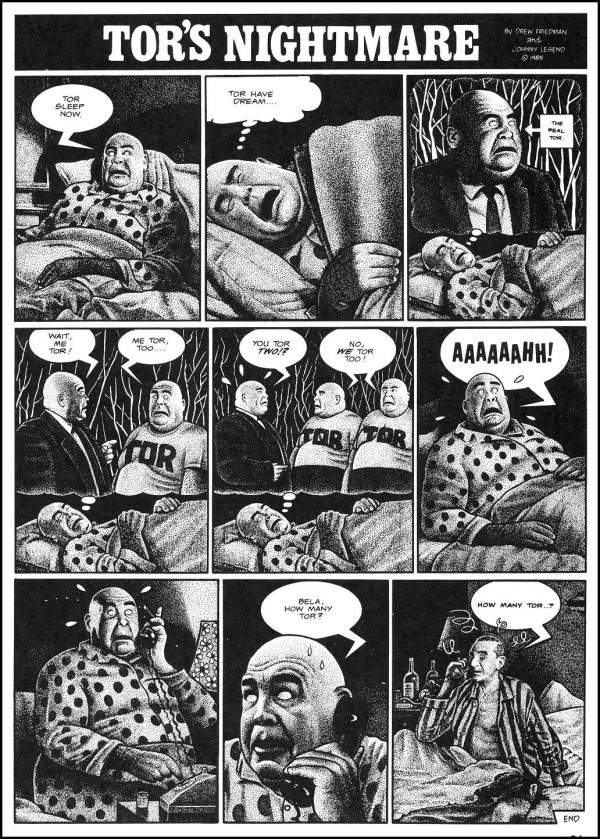
Is is September already? Woah.
But: I managed to get a lot done, while I had my head down. Sometimes, etc. cliche is its own blah blah blah.
This soundtrack is fantastic for writing to… and, to just listen, as well.
What have you been up to?
I feel it, more and more, each day.
The kids… are more clever.
And I… am more irrelevant.
And the four times I saw Motörhead are never gonna measure up to the Harry Stiles show they saw as a kid.
I’m loosing my edge.

Star of screen and radio, she was most well known for her portrayal of Nora Charles, in, “The Thin Man,” and the series of films and radio shows that came afterwards.
However, her career was amazing, and she’s worth seeing in almost anything.
And what a looker!

Here’s the first four hours of the original MTV broadcast, from 42 years ago.
Damn. This one certainly hurts.
Nearly speechless.
I saw this HBO special, as a kid, when we had free HBO for a weekend. I was not supposed to be watching. I did anyway.
And, certainly, have been a fan ever since. Precisely the kind of weirdness that would be what I would seek out, when I needed a kick in the funnybone. His Christmas Special is practically sacred Holiday Text.
So, this one will take a while to heal.
I’ll miss you.

Like all people, Ted Cassidy was more than the sum of his parts. But, sometimes, being known for even one thing means that you were known at all.
Ted did have a pretty varied career, when all was said and done. And there are plenty of obscure things that you will be surprised by, when you start combing through his Filmography. Still, I will probably remember him most for how well he wore a bow tie. Damn, what style.
And, while it’s probably how most will remember you, I do love to give this tune a spin every so often.
Happy Birthday, Ted.
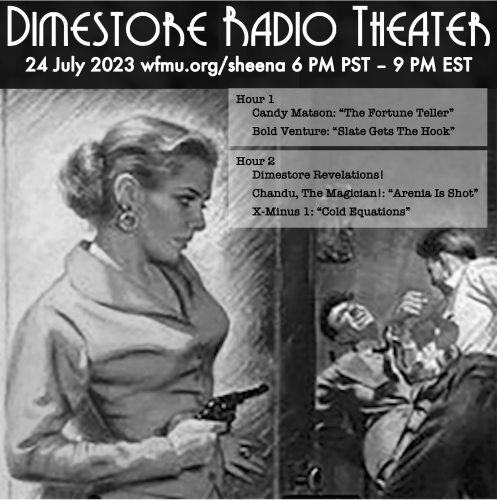
Yesterday’s episode of Dimestore Radio Theater featured the last episode of Candy Matson to be included on our show. In keeping with that, we were certainly a little somber in the chat. But: it was still a great show.
Enjoy:
45 Years ago today, the first Test Tube baby was born, ushering in a new era of medical science for women and families who were unable to conceive before that.
Seems like a good time to listen to this classic, in celebration.
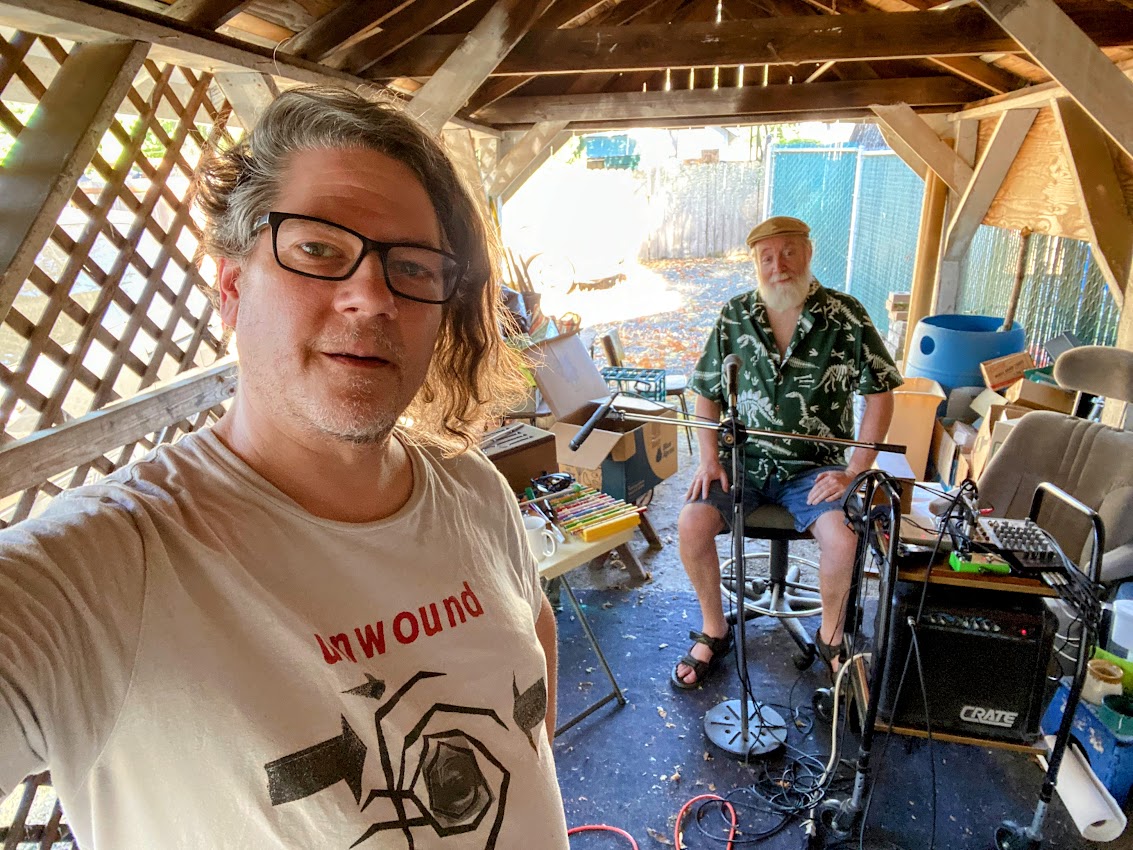
On July 22nd, Human Dinosaur met up for a recording session in Cottage Grove, Oregon, so that we could get started on the follow-up to our first release, which you can find below.
Every time I turn around, I have a new band. I’m not sure what I can say… except that I like to play music?
(This project was formerly called “XANDAR,” and a track was even played on an episode of The Watt From Pedro show before we realized that there are a lot of other bands called “XANDAR.” So… we went with something better.)
We have CDs… and a digital release. And… a lot more to come!
Here’s a cute, hour long documentary about how two men went to go walk on the moon for a spell on July 20th, fifty four years ago:
And, if you really wanna nerd out, here’s a 90 minute discussion of the Apollo 11 Computer, and how it did what it did:
It’s not like Marvel has anything good out right now.
Good Hello!
Fifty Four years ago, between July 16th and July 24th, three men stepped into a rocket ship and flew to the moon. Two of them, casually strolled around on this distant lunar surface – a place most kids only dream of – to perform a variety of experiments, take some measurements, gets some rocks, and come back home. One, lone astronaut, circled the backside of the moon, wondering if the other two would – or could – ever return, unable to reach NASA, alone with his thoughts. It is that experience of space – doing something no one had ever done, alone, so far away from humanity, that very, very few have had the chance to experience, and it is one that I cannot help but reflect on, almost constantly, at this stage in my life.
Growing up, I wanted to be an astronaut so badly. I watched NASA launches on TV, and felt a kinship toward Sci-Fi and the stars in a way that I never felt on earth. In School, I was allowed to go to the library and watch launches with other science and A/V nerds, a privilege that co-mingled with tragedy, when we watched the Challenger explode on TV. And yet, even that, for a while, didn’t deter me from wanting to reach for the stars. But life has a way of course-correcting, when your launch trajectory isn’t quite right. I didn’t have the math or the physical prowess to pull off being an astronaut, and as I got older, it seemed less and less likely that I could reverse this in a way that could line-up my behavior with what I needed to accomplish. My feet, for whatever reason, couldn’t make it that far off the ground, no matter how hard I tried.
So, instead, I go to space with music and art, and I try to imagine the things that I missed. It’s been a subject I’ve returned to, at every stage of my life. And, sometimes, it’s on the radio.
Mike Rogers – the lead singer of the Rotters back in the day – started a new radio show that’s on after me on Mondays: Sounds From Space. Two hours of NASA sounds mixed with electronic music, hosted by an AI, among other things. It’s great, but he had to skip a show on July 3rd, and asked me if I could help him out. So Mitch Headroom – my announcer on MId-Valley Mutations – decided to host a live Mini-Mutations performance, which involved a bunch of Apollo 11 samples, too. This was new electronic manglings and re-edits, presented in a continuous flow for maximum space-soundtrack impact. The show was a ton of fun to do, and gave me a chance to make some new Mutations, and it was great to help Mike out with his excellent show. You can see / read along with the live chat / listen to it all at this handy link here:
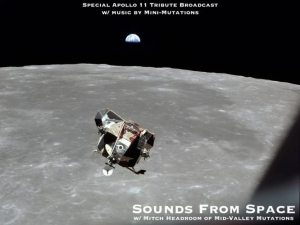 https://wfmu.org/playlists/shows/129326
https://wfmu.org/playlists/shows/129326
And: you should listen to Mike Rogers on Sheena’s Jungle Room in general. He has three shows, and they’re all great! One is all Japanese rock and garage. You know you love that, right? So tune in! You won’t be sorry.
And, since my mind was already thinking about space, I decided to re-master an old episode from over 10 years ago – “Moon Voyage,” made with all LPs – and present it with some new elements on MId-Valley Mutations. So, you’ll get to hear some vintage bumpers promoting my show, two hours of vinyl records, and newly added Apollo 11 samples, to flesh out the rest of the program. I’ve always been fond of this show, and it starts very strong, but the last half of the last hour is a little challenging, and isn’t for everyone. Certainly, the right kind of Mid-Valley resident will enjoy this one, as the playlist includes Hovercraft, Thrones, Universal Order of Armageddon, fennesz, Bruce Gilbert, Unwound, Édouard-Léon Scott de Martinville, Wendy Carlos, The Residents, Sinking Body, Man… Or Astro-Man?, The Butthole Surfers, Captain Beefheart, Men’s Recovery Project, Tangerine Dream, Negativland, the infamous “Davis / Coltrane” mash-up, Mr. Bungle and Puttin’ on The Ritz, with their mind-boggling version of “Sister Ray” that must be heard to be believed. And while I think the right people like this one too, I’ll totally understand if it’s just not your bag. So it goes. But, you get a nice set of 90’s rock, and plenty of Moon Talk. Sounds great, right? Why aren’t you listening now?
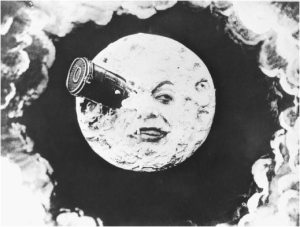 https://wfmu.org/playlists/shows/129594
https://wfmu.org/playlists/shows/129594
I’ve made a couple decisions about this newsletter, and my blog, which, if you are not already following it, I do recommend. (The address is easy to remember: AustinRich.org.) First, I did some minor re-designs on the site to improve readability, added a “Follow” button, and created some better menu tools. For those who don’t use WordPress, or haven’t been following any WordPress blogs, their “Follow” feature is pretty excellent, and allows you to manage “newsletter” settings for the blogs that you follow, rather than having someone else do it. So, if you would like, you can go there, “follow” the blog, and not only will you get newsletters as an e-mail (if you’d like), but you’ll be notified of all the activity on this blog, which you can receive either daily e-mail, or like this newsletter, as a weekly update, containing everything new from the last week. So you get a little extra content if you subscribe that way.
However, if you would rather just keep things as is, I will still send out this newsletter as I have before, until I hear otherwise from readers. So you have a variety of subscription options now. Lastly, this does allow me to put all the Newsletters in one “place” online, too, where it can be destination reading, if that is your preference. So there will be more than one reason to follow AustinRich.org, which is also a good thing.
Lot’s of ways to engage, but, really, it’s just an effort to keep in touch. And that’s the important thing. If I’m able to make contact with each of you, in some small way, then this was all a success. While I do still believe in the power of internet tools, I’m just REALLY suspect of most social media anymore. The mindlessly scrolling feels weird, and doesn’t feel like communication or interaction anymore, but more like a by-product of some kind of hypnosis. I’ve had more boons come my way, and more opportunities open up, as a direct result of this e-mail list, and I hear from people I missed and never talked to on social media. So… something tells me this is a little better for me, at least for now. I do miss my friends I used to chat with often in those spaces. But I feel like I still interact with those people in some other way… so I don’t think I’m missing much.
Here’s to trying to meet the summer – and all the challenges therein – head-on.
And, hopefully, with some cool space tunes, too.
—
Join the Mailing List! (Or nudge your friends to do so.)
https://bit.ly/ACRONYMNewsletter
Live, Interactive Chat!
During both Dimestore Radio Theater and Mid-Valley Mutations we have an interactive chat going, hosted by me! 6 PM PST / 9 PM EST on Mondays and Tuesdays, you can follow along with the playlists, as they are being updated in real time! I’m not on social media, and my e-mail response is a little slow lately. This is your chance to hang out with me on the Inter-Web-A-Tron. Chat with other listeners at both Sheena’s Jungle Room and WFMU, and get to have some real-time fun, all from the comfort of your favorite device. It’s the main way I get to interact with people these days, and I would love to see you there.
I’m also on UB Radio Salon on the last Sunday of the month, usually with The Fourth Sunday Players, but occasionally, The Fifth Sunday Troupe makes an appearance. These are scripted productions, with original, improvised music, SFX, jokes, actors spouting dialog… it’s’ a big show, as part of the Big City Orchestra crew. (These days: Ninah Pxe, dAs, Mike Dringenberg, univac, myself, and anyone else we can con into joining us.) Plus: UB Radio Salon is also on every other week, with occasional guests and whatnot. The show always includes live music, performed for the show, every week, for the last 15 years solid. It’s quite an achievement.
There’s lots of other stuff. I try to keep track of it all at austinrich.org, but, you know how it is? It’s probably incomplete, in a number of ways. I do my best.
The Physical Merch Store, with music and ’zines, all on Bandcamp. DJs: get in touch for complementary broadcast copies of your favorite albums I make, so you can share this music with your listeners too.
If there’s something you were curious about, and you can’t find a link or other info: just ask. I’m trying to get it all online and searchable but… well.. you know.
—
Austin Rich
“You’re Already A Fan, You Just Don’t Know It Yet.”
 Happy Sandinista Day, Sandinista National Liberation Front!
Happy Sandinista Day, Sandinista National Liberation Front!
In honor of this day, I will listen to “Sandinista!” by The Clash.
Or, at least, try to; it’s a very long album.
 In less than an hour… 6 PM PST… let’s go on a Moon Voyage.
In less than an hour… 6 PM PST… let’s go on a Moon Voyage.
Sheena’s Jungle Room. WFMU. It’s: Mid-Valley Mutations.
https://wfmu.org/playlists/shows/129594
(20:03 Update: The Show is over… but the link above does contain an archive, where you can listen along, and see the live, interactive chat from the show. All Vinyl! All Moon-Centric! All Fun!)
In my continuing search to find a place for my thoughts and notions out in the world, I will try to use this place a little more often. Perhaps I can find a balance between the e-mail newsletters, and other ideas, images, etc. There’s often something I’m thinking about almost every day. At the very least, I should probably start tinkering on here. There’s a lot of work left to be done, and I feel like I notice something else that needs fixing every time I look at this site.
So, perhaps posting to it more will help keep me motivated. There’s a lot of stuff that I would like to engage ya’ll with, and I’m still trying to figure out how best to do that.
Remember the days of blogs, when people would intentionally seek out someone they liked, and read what they said?
Let’s see if that will catch on, again.
 A Weekly Dispatch Containing Updates, Stories, Events, New Releases, and a few words about what’s going on with me, all to take the place of that dreadful social media you hate looking at anyway.
A Weekly Dispatch Containing Updates, Stories, Events, New Releases, and a few words about what’s going on with me, all to take the place of that dreadful social media you hate looking at anyway.
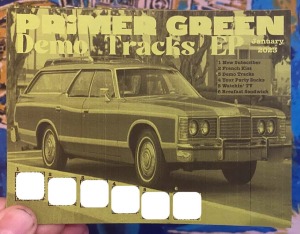 The new postcards are going in the mail today. For people who are Lemonade Stand Supporter, you can hear and see a color version of the postcard, now!
The new postcards are going in the mail today. For people who are Lemonade Stand Supporter, you can hear and see a color version of the postcard, now!
It should arrive at your home very soon. Thank you to all the supporters who make this happen every month.
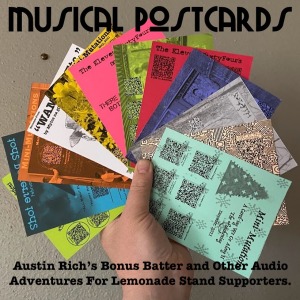
2023 marks the 30th Anniversary of the first zine I published, the 25th Anniversary of my first radio broadcast, and as if that weren’t enough, we have decided to relaunch our Digital Lemonade Stand. It’s a great way to start the year, and we hope that you will not only be able to take advantage of these changes, but tell your friends about it, too. Something like this is worth sharing, and we can’t wait to see where the next year takes us.
In the past, I’ve produced a Musical Postcard every month, now for over two years solid. 25 Different Cards to choose from, featuring 30 minutes of experimental music, or a new single by one of my rock and roll projects. Not only did these cards deliver music that you could only access via the codes on the cards, but Digital Lemonade Stand supporters would get access to bonus tracks and other media related to producing the cards. In the past, you had to go to the website, and stream the songs from the Digital Lemonade Stand itself. Now, you can subscribe to a supporter-only Podcast, that features ALL of the songs on each Postcard, AND all of the bonus material. Plus, if you visit the Digital Lemonade Stand itself, you can download mp3s and other media associated with the postcard, to add another dimension to appreciating the card.
These Musical Postcards have become one of the most written about and well-recognized project that I’ve produced recently, and through working on material for the cards, I’ve come to develop a working method that is not only satisfying, but very rewarding.
Making these cards isn’t precisely free. I do use as much cheap and recycled paper as possible, and I’m STILL using the same printer that I’ve used to produce my ‘zines for several years now, using thrift store and eBay printer ink to add a few more years to it’s lifespan. But there are costs associated with making these cards, most notably postage. Help me offset these costs, AND keep this dream alive, by visiting the Digital Lemonade Stand, and supporting me, today!
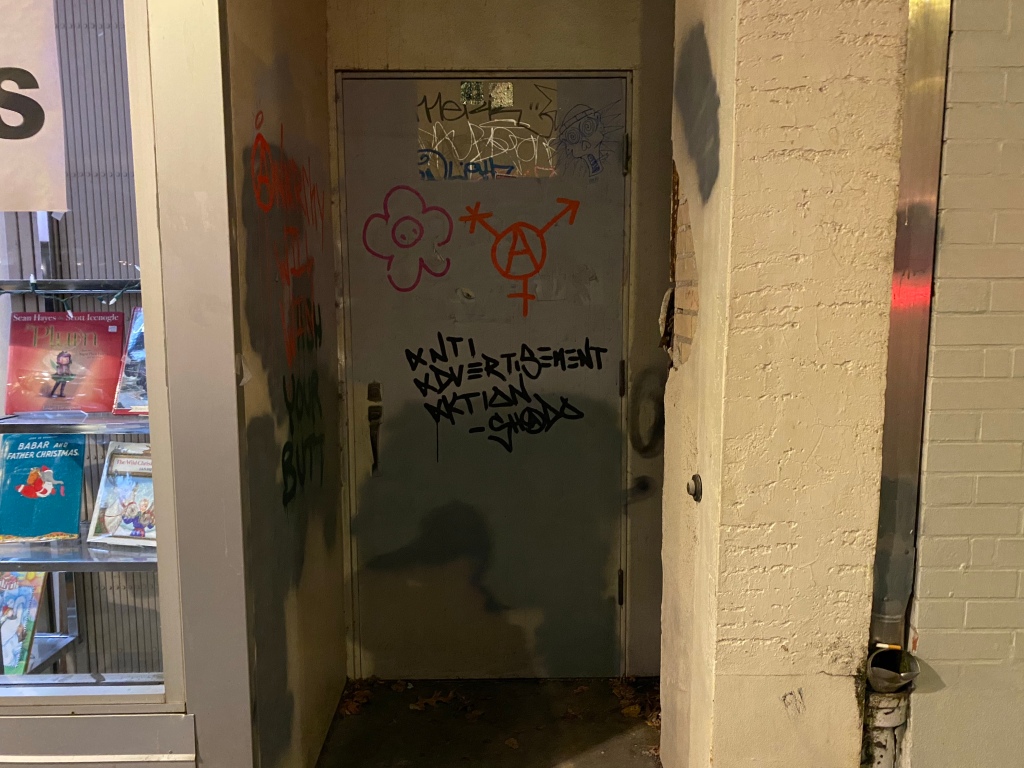
I still reach for my phone all the time, wanting to post to FB. I should actually post on a real wall from now on, if I had the courage of my convictions.
We sort of got snow. It was half-snow, really: snow in the air, but rain on the ground. It’s a bummer, because the other way around isn’t really possible. (Rain in the air, snow on the ground.)
I got a few messages from friends who were excited to tell me that they were happy for me, because it was snowing. Part of me didn’t want to correct them. It was nice to know they were thinking of me.
Here’s to hoping it actually snows in both the air and on the ground.
I guess this was what it was like before FB. No one really read each other’s blogs, either.

My boss was keeping an eye on me today. I tried not to screw up, but I’m only human.
 Design Lessons From Guitar Pedals. by Clive Thompson.
Design Lessons From Guitar Pedals. by Clive Thompson.
It just so happens, older technology that is more simple to use, and doesn’t require our hands and constantly attention or a flat screen to use, is a lot more fun to use, and practical for our bodies.
Food for thought.
Fleetwood Mac’s Christine McVie has died at age 79 – https://www.npr.org/2022/11/30/1139955248/fleetwood-mac-singer-songwriter-christine-mcvie-dies-at-79
In honor of here death, I will be listening to Schlong’s 1993 classic, “Tumours.”
December came too quickly.
And felt guilty and awkward about it, and won’t look anyone in the eyes ever since.
 I was astonished to find that three different people have already noticed that I deactivated my social media accounts. I would have never imagined. Part of me assumed that no one would notice, and certainly, I don’t really feel like anyone SHOULD have noticed. But, strangely, it happened. Certainly that will drop off at some point.
I was astonished to find that three different people have already noticed that I deactivated my social media accounts. I would have never imagined. Part of me assumed that no one would notice, and certainly, I don’t really feel like anyone SHOULD have noticed. But, strangely, it happened. Certainly that will drop off at some point.
The impulse to scroll through something when there is the smallest lull in everyday life is still very strong. Certainly this morning, when I first woke up, I really wanted to log back in. But I’m still resisting, for the moment. I wonder if it will last?
I DID export my FB content, and looked a little at the data. I first got on FB in 2007, then bailed on it for a few years. Because I tried to delete that original account, I couldn’t “re-login,” so I had to make a new account… and used the same account since then. (For 12 years.) I did take occasional breaks, I noticed… sometimes for months at a time. But since Covid I’ve been posting daily. Many, many… many times a day. It was not good.
In 12 years I posted over 10,300 times to FB. That’s 860 posts a year. Almost two and a half times a day.
Over half of the posts I made were about radio or shows I was playing, doing a “spot check” on my posts. And, more pointedly, the first several years I was on, it was almost ALL radio posts. It was really only about half way into that 12 year span that I started to get personal VERY regularly. I think the main issue there was that, usually, I would give up entirely on this blog, and all of that energy would wind up on social media.
Unfortunately, a fair amount of my more recent social media use has been downbeat. And, by my own hand, I think I’ve driven away anyone who would look at my social media accounts, leaving behind people that I don’t really know, except through music and radio.
Even more sad: I made about 10,000 other kinds of posts to FB that were not my actual posts: comments on other peoples posts, or engaging with other content in a pretty consistent way. I was just constantly looking for a community to engage in, never realizing that it was hours and hours of my life, being drained away, with no way for me to really re-direct that time toward… radio or ‘zines.
Sobering, for sure. Hopefully I can focus on how much energy I lost, and use that as a way of keeping me away from it in the future.
We’ll see.
Three days in a row of evening radio, two hours at a pop.
It makes me feel hyper-aware to do radio like that. Being in the moment like that… it’s nice. But it’s exhausting.
FB and IG are both off right now. We’ll see if I can stick with it. I don’t need that stuff in my life.
 More and more I feel like there’s some sort of dysfunction with the way I interact with social media. Certainly, it is designed to keep you there, and keep clicking / interacting. And at a time in the world’s history where we are all stuck at home, there is something sort of comforting about being plugged into some sort of cultural monolith that we can all “connect” over.
More and more I feel like there’s some sort of dysfunction with the way I interact with social media. Certainly, it is designed to keep you there, and keep clicking / interacting. And at a time in the world’s history where we are all stuck at home, there is something sort of comforting about being plugged into some sort of cultural monolith that we can all “connect” over.
Perhaps that is old fashioned of me to want some sort of cultural touchstone that we are all connected through? Growing up where we all read the same newspaper and we all watched the same three channels and we all played the same handful of videos games, I think I am always clinging to and searching for the “mainline” part of culture, where we are all congregating together, and having some sort of “moment” together.
Going to shows really helps fill that role in someone’s life. You ARE in an experience with a lot of other people, and you know, in that moment, that you are having some sort of moment together.
Can you replicate that in some sort of digital environment? I don’t know.
But I’m pretty sure being on MyFacester+ all day long can’t possibly be the answer.
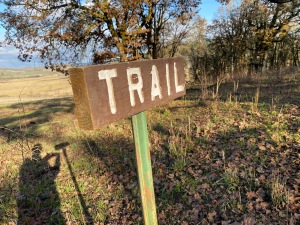
Colin forced me to go on a hike, which I was not particularly excited about, but was a good excuse to get out of the house.
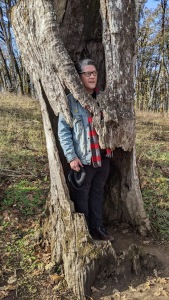 And in spite of my terrible mood, it was actually a very pleasant hike. I didn’t really take a lot of pictures, but maybe I didn’t need to. Maybe the idea that I need to interact with the world and capture it is the problem?
And in spite of my terrible mood, it was actually a very pleasant hike. I didn’t really take a lot of pictures, but maybe I didn’t need to. Maybe the idea that I need to interact with the world and capture it is the problem?
We also ran into this little guy. Seems like he was on a bit of a hike, too. Good luck, newty friend. Hopefully you enjoyed yourself in spite of yourself, too.
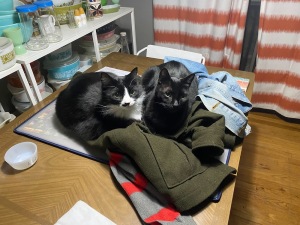 Trying to break bad habits.
Trying to break bad habits.
Sometimes, those habits have a hold that is stronger than you think.
Maybe I can re-invent again, back where I belong.
Unrelated: The Boys don’t seem to want me to put my coat on and go outside. I don’t blame them.
The August Postcard is finally ready, and went out in the mail today. You can expect it in a week, at the latest. This postcard project is now almost two years old, and as I continue to record and work with this format as something to express myself with, I think I find new ways to be productive as a creator. It’s an excellent motivator, and I really hope ya’ll continue to support the work I do.
This one features the EXCLUSIVE zer0-g mice “dem0-t ape,” which features our best raw performances, and some information about the WILD tour that we’ve been on. This is a good place to start, for those who are not familiar with the exploits of the zer0-g mice. We have two streaming shows available for you to enjoy coming up soon: one during the September Audio Waffle (stay tuned for more information), and then as one of the acts doing a streaming presentation for the annual Norcal Noisefest. And: you can catch us two more times on UB Radio Salon, at the end of August, and the end of September. And, sadly, that will be the end of the zer0-g mice.
But that’s not the end of the work I do. If you would like to see me keep at this, and make new stuff that you can enjoy every month, the best way it support it is to lend a hand. (patreon.com/austinrich) There are a number of ways to sign up, and you get free merch and stuff in the mail, for every level of support. I will be revising the Patreon very soon, so if you want to Grandfather in under the old system, now is the time!
Hopefully the September Postcard won’t be late. And: thanks for everything you do to keep me doing what I do.
#DIYArtist #MailArt #MusicalPostcards #ExperimentalMusic #univac #UBRadioSalon #TheFourthSundayPlayers #zerOgmice #BusyBusy
I’m watching Drag Race Season 13, and not a single queen had ever heard of Charles Nelson Reilly. Like, 100% had no idea.
Friends: our schools are REILLY underfunded. If we don’t start teaching our children about the important figures in history, how will they ever learn?
I’m stunned. Like, a Drag Queen who doesn’t know who occupied the upper right seat? How did that happen?
That moment when you realize that you have strong feelings about the song, “Hot For Teacher,” and you really can’t exactly put your finger on why. #WhoKnew?
A friend of mine gifted me a box of comics. (I’m not sure of the provenance of said comics.) They came in a “Fireball Whiskey” box, and while there was a stack that had been cut up for collage purposes, there was a huge box full of stuff that was ready to read.
What was incredible was that, aside from a few things here and there, this box has very little crossover with my own collection. (A few things, for sure… but not much.) And, more astonishingly: I don’t think I’ve read any of this stuff, and it was stuff that was on my radar as a 15 year old, but not really since.
I don’t have the HIGHEST hopes for the overall entertainment values of these comics. They’re beat to hell, there’s a lot of duplicates, and no complete runs. (Only a few issues of any given series.) So the entertainment value is probably fairly low. Still, as someone who went through a period where I would have LOVED to own all of these, I have a feeling that there will be more than just the Animal Man and Doom Patrol to entertain me.
Here’s a vid. Are there any DC Nerds in my friend group?
#FreeComics #DCDrek #ButMazingManIsCool #AfternoonAlphabetizing
Uhm, is there any part of, “All Rainwater is completely undrinkable,” that doesn’t sound pretty foreboding?
 Are you ready to enjoy the new Calendar Boy? It’s arrived, just in time for Summer.
Are you ready to enjoy the new Calendar Boy? It’s arrived, just in time for Summer.
A New Collection of 13 Tunes, by the various projects that have one thing in common: you can count on them, rain or shine, every month, to deliver new music, the entire Calendar Year.
Rock, Punk, Space Grunge, Electronic, Experimental, Free-Improv, and Noise. It’s all here, when you get to know Austin Rich, your new favorite Calendar Boy. Physical Copies are currently only available for pre-order, but you can enjoy the digital collection right now, on Bandcamp.
Joined by Colin Hix, Mike Capps, Moth Hunter, Chris Gerig, Scott Eave & Jerry Soga, this album presents the highs of a creative year that was mostly difficult for everyone. As we all sit and watch the days pass us by, at least we have some music we can enjoy.
Collecting all the material recorded in 2021 for Austin’s “Musical Postcards,” this contains Five 1/2 Hours of New Music that was recorded last year. Originally only available to those on the mailing list, these tunes are now available for anyone to enjoy. Not only are all of the postcards available as they were originally designed with fully functional QR codes, they are photographed too, giving you a sense of what they were like in the mail. You can download a folder of all 31 pieces that were recorded for this project as they were originally heard and mixed for the postcards.
Not only that, but Lemonade Stand Supporters (Patreon Fans) received four hours of bonus mixes, extra songs, and in some cases, instrumental versions of tracks, plus an advance link to a podcast episode that, at the time, was not released. This material was only available to those supporters, and has not been heard elsewhere since. All of this material is available as part of the extra material you get when you purchase this album.
But the album itself is something you don’t want to miss out on. From those 31 pieces that were made in 2021, 13 were selected to be re-mixed, re-vamped, re-presented, and in the case of The Short Pockets, our engineer provided a new mix that was different from the one you heard on the postcard. New elements were added, each track was re-considered, re-amped, trimmed and edited, and in some cases, completely overhauled, to improve each song, from the drums up. Additionally, everything was re-sequenced, and then re-mastered just for this collection. Some of you might have heard these in some form before. But this version is completely new.
The first 20 minutes of the album presents rock and punk songs in a much more traditional vein, sequenced to provide maximum entertainment. But the last hour distills the electronic and experimental work that’s been going on in a more or less continuous presentation, hopefully offering a chance to enjoy these performances in a new way. These new mixes have been painstakingly tested to ensure that they work in a number of contexts, and we all agree that this collection is, as they used to say, “All Killer / No Filler.”
While we could certainly go on, what’s important to know is that you can sit back and relive 2021, with your favorite Calendar Boy, and enjoy the sounds that made last year so memorable.
Do you have your Calendar Boy?
 This year has been another mess, as usual. And I could probably spend a lot of time documenting the things that went wrong. But I’m going to try and do something that doesn’t come easy to me: make a list of the things that went right. Maybe this will be more therapeutic than difficult, but either way, it might be worth it to try and remember the things that went well in a year that felt more like it was on fire than anything else.
This year has been another mess, as usual. And I could probably spend a lot of time documenting the things that went wrong. But I’m going to try and do something that doesn’t come easy to me: make a list of the things that went right. Maybe this will be more therapeutic than difficult, but either way, it might be worth it to try and remember the things that went well in a year that felt more like it was on fire than anything else.
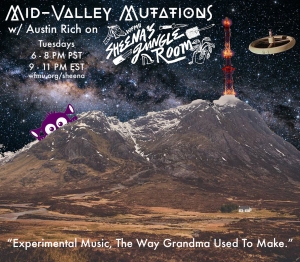 The Long & The Short
The Long & The ShortKeen-eared listeners who have been tuning into Mid-Valley Mutations recently have probably noticed that we have been in re-runs, for a while now. It’s been fun to take a bit of a stroll through some older episodes, to get a sense of where we have been. We’ve been on the air in some form since 1998, and with 23 years of shows under my belt, it can feel like there’s nowhere left to go, and no territory left to explore in the Mid-Valley.
So, when you get an offer to start DJing at WFMU, you suddenly realize that you feel like you are just getting started on this journey, and that there’s plenty left to explore, for at least another 23 years, anyway.
Through a series of wonderful circumstances, Mid-Valley Mutations is back on Tuesday, and more importantly, will be airing LIVE at 6 PM PST for two hours, every week. And you can hear this through the extremely hip and oh-so-exciting streaming site, Sheena’s Jungle Room on WFMU.
If you haven’t been listening, then you are in for a treat. Sheena’s Jungle Room has been blasting forth some of the most exciting new shows from all over the world. To get to be a part of this crew of DJs is no small matter. While I will try to keep my cool and do my best to fit in and not put my foot in my mouth, you can rest easy knowing that it won’t be long before they see me for who I am: an enthusiastic DJ who want to bring you the same show you’ve come to know, all these years.
“Well,” you say, tentatively as I begin to close up my Press Conference, “that might be enough information for the long-time listener. But what if I’ve never listened before? What can I expect then?”
Now that is a very good question! Let me see what I can do by way of a reasonable answer:
When I first pitched my show to KWVA in Eugene, OR in 1998, I opened with: “It’s like Over The Edge, but with my take format.” The staff didn’t exactly know what I meant in those days, but they gave me a show anyway, and that humble beginning led me to bring this show to KPSU in Portland, KMUZ in Salem, KLFM in Split, Croatia, and now, to the hallowed halls of WFMU.
And, each time, I’ve used the same pitch: My take on OTE. That is to say: I still DJ music, I still do cut-ups, I still include interviews and live performances when I can, and I approach each show as a self-contained Audio Essay, where I present what I think makes the most sense for that particular show.
In 2016, I re-launched the show with a new name, and since then, have focused more on collage, more on experimental music, and incorporating more of my own live mash-ups and cut-ups into each broadcast. I had this notion that someone else needed to step up to the plate, in an effort to take on what Don Joyce had begun, especially now that he had passed.
It’s been an evolution over the years, certainly. The show began as a simple DJ program, playing the music I liked as a 20 year old, and occasionally playing samples between tracks. I only slowly integrated “conceptual” ideas into the program later, and even then, tentatively, as if I might break something if I were to do it wrong.
It took a long time to get comfortable breaking radio rules, and even then, I found myself filtering the ideas of Don Joyce through my own interests. I would toss in crazy stuff when it occurred to me, but for long periods my show would take on a straight DJ format, with occasional live guests performing, followed by an interview. It was almost pedestrian, so much so that when I would remember my roots and do something very strange, it stood out, for better or for worse.
Now, in 2021, it is time to re-brand again, and for the better. If you’ve ever followed any of my shows before, then you might like this one, too. I’ve going to feature experimental / rock music / punk and post-punk music that I like, albums that I enjoy, mash-ups and remixes and other live weirdness that I’ve been known to incorporate in the past, and occasionally: just some straight up DJing because I’m into the records. You know? The thing radio has been based on for years?
Occasionally: I’ll feature some live performances and interviews, when it makes sense, and when I can make it happen. And, sometimes: I’ll cut up some old broadcasts to replay for modern audiences (There are 23 years of shows floating around the studio). What you can count on every week is that you can listen to Mid-Valley Mutations live on Sheena’s Jungle Room, c/o WFMU radio. And that is something truly exciting.
 The Excitement Is Palpable.
The Excitement Is Palpable.My first broadcast will be November 16th at 6 PM PST. (9 PM, EST.) I’m going to begin again with a very simple theme: BLAST OFF! As we launch Mid-Valley Mutations into the future, we casually introduce listeners to what they can expect as we explore the Mid-Valley.
If I haven’t yet offered enough insight into what you can expect from us, you can always find all relevant information about our program at midvalleymutations.com. Not only can you hear us live on Sheena’s Jungle Room, there’s a number of ways to listen to the show: podcasts, KLFM.org on the Wednesday after, etc. I’m sure there’s a way that you can enjoy our show, and we’ll help you find it!
If you have listened to us for years: thank you. If this is your first time: welcome! And, if you are somewhere in-between: we hope that you didn’t mind the re-runs for so long. This move to WFMU has been pending for a while, and we have had a hard time not just blurting out what’s up.
So, until we get started: Be Seeing You!
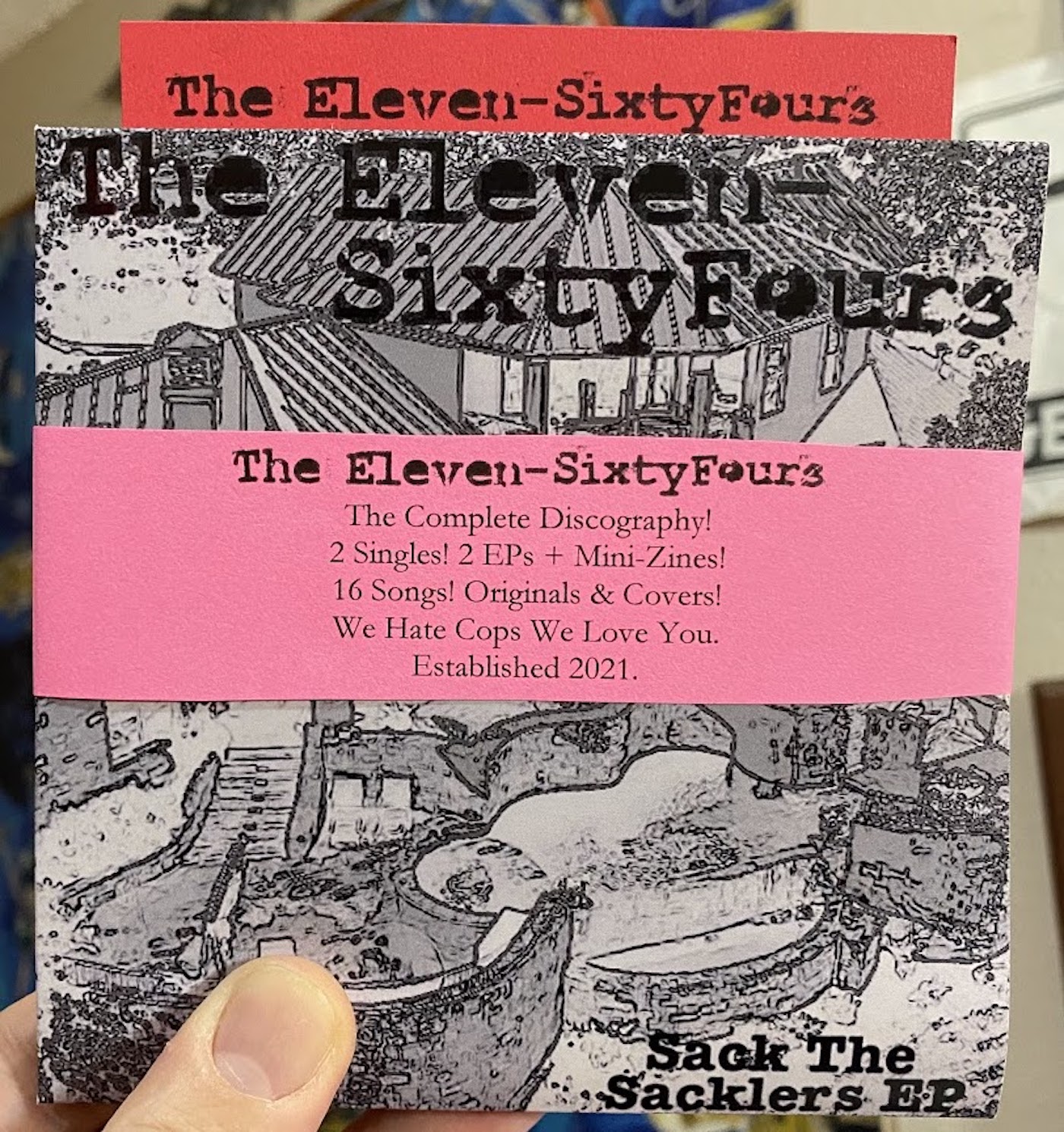
Now available digitally, on CD, and in a comprehensive “Discography” pack, it’s time you caught up with The Eleven-SixtyFours! Two EPs! Two Singles! 16 new punk rock blasts of middle-aged DIY, at the intersection of fury and nostalgia. If a 46 year old man can sit down in four different sessions to record this music, writing all the songs on the spot, then just imagine what you could do?
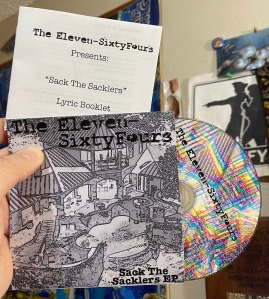 WTBC 0031: The Eleven-SixtyFours – Sack The Sacklers EP. (Available Digitally, or on CD)
WTBC 0031: The Eleven-SixtyFours – Sack The Sacklers EP. (Available Digitally, or on CD)
Six new songs about getting revenge on the 1%, how the cyberpunk future seems to match pandemic life, the consequences of ignoring the moment, and a dance craze that is sweeps the right wing that needs to be obliterated from the clubs, post haste. Get to know The Eleven-SixtyFours, with 13 minutes of three-chord manifestos that should make you want to quit your job before your job quits you. Sack The Sacklers. It’s for your own good.
 WTBC 0032: The Eleven-SixtyFours – Smothered, Covered, Chunked & Capped EP. (Available Digitally, or on CD)
WTBC 0032: The Eleven-SixtyFours – Smothered, Covered, Chunked & Capped EP. (Available Digitally, or on CD)
The Eleven-SixtyFours wear their influences on their sleeves, and now, you can hear them in this collection of six cover tunes, clocking in at just under 11 Minutes. Recorded over the span of a day, with the songs picked based on which ones came to mind the quickest when the question was posed, “What songs do The Eleven-SixtyFours cover?” The answer: this half-dozen pop-culture tunes, modified to fit the new sound from The Lava Lamp Lounge. Get it before one of these bands gets mad.
 WTBC 0033: The Eleven-SixtyFours – DIY OR DIE Single. (Available Digitally, or on CD)
WTBC 0033: The Eleven-SixtyFours – DIY OR DIE Single. (Available Digitally, or on CD)
The debut single from The Eleven-SixtyFours, so controversial that people on my mailing list requested they be removed when they heard about the anti-cop sentiments and “Max Headroom” references in this single. These two songs were spawned from an actual argument I had with a fellow musician. The following day, I wrote and recorded these two songs, which began the entire journey of The Eleven-SixtyFours. Two blasts of anti-authoritarian punk that suggests that, perhaps, the old systems should be dead?
 The Eleven-SixtyFours – WAKE UP! Single (Available Digitally, or as a Postcard.)
The Eleven-SixtyFours – WAKE UP! Single (Available Digitally, or as a Postcard.)
Our second single is another dose of un-refined, shot-from-the-hip punk music by someone who doesn’t really know what they’re doing. This time, a dance number dominates the single, sending kids to cut a rug late into the night so they can feel some semblance of order. But that’s only because the alarm goes off early in The Eleven-SixtyFours house, as we try to remind you that the fight is on-going, and will probably never stop.
* * * * * *
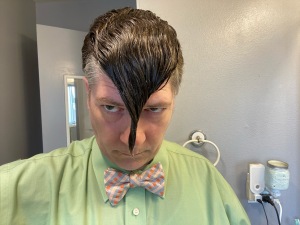 Meet The Eleven-SixtyFours.
Meet The Eleven-SixtyFours.I think everyone’s first band is a punk band, either by choice or through limitations. You’re not that great at playing yet, you have borrowed (or broken) gear, and as a young person, punk speaks so loudly to all the ailments of youth without having to be polished to do it. The Bullshit that Authority puts us through. The Brokenness of The System. How TV and Movies are pandering to some idea of how we should all behave that has no connection to real life, or how any of us want to live. When you are 15, all of that sounds like it was chiseled in stone. Wise words, handed down from a punk elder only a few years your senior, who makes it sound like a six pack and a basement show will cure you of any notion that the rest of the world has it’s shit together.
And, the problem is: Punk Rock is onto something. But the interests of an aging person sometimes veer away from the interests of Punk. And, as we get older, there is an element to Punk that becomes more obvious, that isn’t as so when you’re a kid: the rigidity of the scene, the patriarchal structure that often gets overlaid onto everything, and the narrowness of the musical form… it all eventually causes some of us to age out of Punk, as scenes like Experimental Music start to actually encompass the things you wish Punk Rock did. Punk is often a young person’s game, as the lifestyle becomes harder and harder to embrace as we all get older.
But certainly, some conversations I’ve been having with people in the last several years seem to evoke the need for someone to reduce an idea to a short punk song so you can scream it at them, in the hope that they can then understand it. A refrain I kept hearing was that when the environment and the politics get bad enough, “good Punk Rock” would make a big comeback. But where was this comeback? And while it did seem to produce occasional acts that I really enjoyed, on the whole, it didn’t feel like there was a movement happening anywhere like folks had predicted.
Perhaps it is both nostalgia and a less than 20/20 hindsight informing this thought, but I think we caught the last wave of the Mainstream Punk Movement in the 90’s, where the influence of Grunge Bands cast a light on the remnants of the ’80’s punk scene. This all breathed new life into bands like Bad Religion, and catapulted Green Day and Rancid to the top of the charts, and caused long-standing labels like Lookout! and Fat Wreck Chord to suddenly have some amount of pull in the major music industrial complex.
But quickly, what seemed like the beginning of a new national craze, where Punk would help foster more activism, and possibly move to make big changes, it was immediately subsumed into the dying music industry that was taking everyone down with them. Hot Topic and the rise of modern Emo started to dismantle any steps forward Punk seemed to have made, and the last 20 years has underlined the fact that punk has returned to the status of “just another genre,” with about as much cachet as Country Music, Hip-Hop, KPop… or Experimental Music, for that matter.
In fact, it’s probably fair to say that memes on Tik Tok have more political power than Punk Rock ever did. But some of those memes are pretty powerful.
As a fan of earnestness in music, Punk Rock is one of those genres where screaming the things you feel at the top of your lungs doesn’t seem at all out of place, and is encouraged. It’s certainly one of the last places where sloppiness and lack-of-skill are not deterrents. (Almost every other genre still seems to care about production and quality.) In fact, being able to write, record, and release music quickly is one of the backbones of Punk, and DIY Releases will always say everything you are saying in your music through the packaging, too. There seems to be a mode of songwriting where you can let go of the conventions that are usually expected, where you can just spew out a bunch of stuff that you want to get out of your head. In a way, it’s the music equivalent of a free-write: make all the mistakes and be as sloppy as you want, because there’s another kind of writing later where those other rules will be back in place.
The therapeutic element of Punk Rock seems to work on a number of levels. Listening is great, writing and performing it is great. But as someone who writes and makes other kinds of music, Punk Rock is a great way to get some of your interests sated, so you can put your mind into other kinds of art.
A large part of my interest in getting back into making and performing music again came directly out of feeling like I needed to do more than just talk on the radio about bands that were making a difference. As the Trump Presidency wound down, and as it seemed clearer and clearer that there would be no consequences for anyone involved – and more pointedly, a lot of people seemed to be okay with that – a kind of anger welled up in me that I hadn’t felt since I was in Cathead, 100 years ago. While I had set out to write the follow-up album to the Shot Reverse Shot record that I recorded in 2020, each time I sat down to record stuff this year, very different songs were coming out.
I have never tried to write Punk Rock songs on my own like this, but I immediately felt like I had to for this particular project. I programmed the simplest drums I could in a way that seemed appropriate, and cut a lot of corners to make it seem like there was a full song where it was just me in my office. Even still, I could usually fill the entire day with work to do even as I tried to DIY-it, even when I sat down to record just two songs. (That’s how each of the singles was recorded.) The EPs were two days for each one, over a single week. None of these songs were written before; I had no idea what I wanted to say until I sat down to write. And I should repeat: I’ve never tried to record music like this before.
Mixing / etc took longer. I would tinker with the songs all the time, trying to figure out how to improve them and make sure you could hear it all. I did one session of re-takes for other parts that I missed. Then I sent them to press. Stop fuckin’ with them and just move on. I feel like I waited too long already.
And, astonishingly: I think they’re okay.
I don’t want to suggest that this is great music, or that I’m writing at the same level as my influences. (There’s a reason that covers disc sounds a little better than the other stuff.) I don’t anticipate this will supplant all your favorite punk records. I might be fortunate enough for you to actually still keep the CD in a few years from now.
But in a way, that’s not the point. I had a great time writing and recording this stuff, and I think that comes through.
And: I mean every single word of it. And that feels important.
Enjoy!
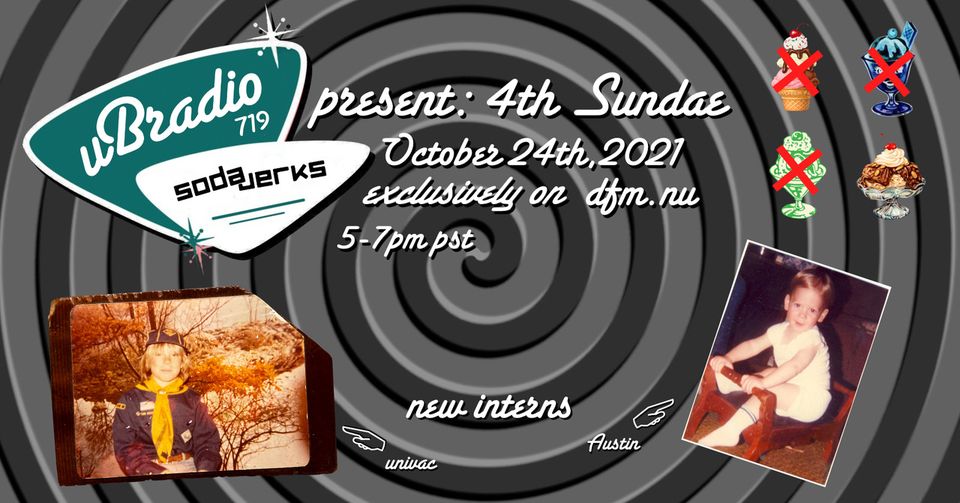
Starting this Sunday (and every 4th Sundae of the month), two new permanent (until they die) interns at uBradio Salon’s Chakra Chimp uBkitchens have volunteered to entertain your ear-holes monthly, curating a cacophonic soda fountain of bits of words accompanied by noises, via the magic of the internet.
Reluctantly sponsored by veteran sodajerks pxe & dAs, your pain will be theirs as well.
Make sure to bring a pocketful of quarters—you’ll want to play these sodajerks’ juke box.
Sunday, October 24, 2021
5:00pm-7:00pm Pacific
0.00-2.00 GMT / 2.00-4.00 CEST
UB RADIO SALON no. 719
SodaJerks Present: 4th Sundae
with guest hosts:
univac + Austin Rich
live audio broadcast via
DFM Radio International
https://dfm.nu/
LISTEN via the RADIO STREAM: > STEREO.dfm.nu or MONO.dfm.nu
(more stream choices at DFM.nu)
or radio player at UBUIBI.org
CHAT link on DFM.nu page
DISCORD chat: https://discord.com/invite/fJJgtQM

Usually I try to make a bit of a production about the holiday season, doing weeks and weeks of Holiday Broadcasts, and producing some killer radio content… for those who enjoy this time of year. So when I realized that it is already over HALFWAY through October when I had a chance to sit down and think about the Holiday Season, I realized that this year was not going to get the same kind of treatment that I try to offer most years.
However, as it happened, I managed to produce a fair amount of musical content, all centered around the holiday. Namely: three of the projects I’m involved with actually produced holiday items this year. And there’s plenty of other items to choose from, too, if you want to enjoy material from over the years, too. So this card is a little shortcut to all of that stuff. Here’s a little more detail, for those who are interested:
* * * * *
1.) The Eleven-SixtyFours new HOLIDAY VIDEO, “An Open Grave”!
The Eleven-SixtyFours are brand new this year, and have already released to singles. This track is from their forthcoming EP, “Sack The Sacklers,” and this is the first video from that EP. Perfect for Halloween, this is our theme song this year, helping get us in the mood when we’re just not feeling it.
* * * * *
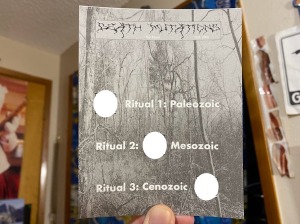 2.) DEATH MUTATIONS – THE RITUAL EP (Postcard)
2.) DEATH MUTATIONS – THE RITUAL EP (Postcard)
October’s postcard this year is a new release by DEATH MUTATIONS, with a new EP of Experimental Horror atmospheres. This is perfect for putting on the porch, and letting it play for anyone who passes by the house. It also works magnificently on it’s own, in your home or on the bus, commuting to work. Not for the faint of heart.
* * * * *
At least a couple years in the making, this new project is the collected effort between Le Petit Sac and Mini-Mutations, and offers an experimental horror release that is a frantic and chaotic as one would expect, with long passages of eerie, spooky sounds that are perfect for setting the mood.
* * * * *
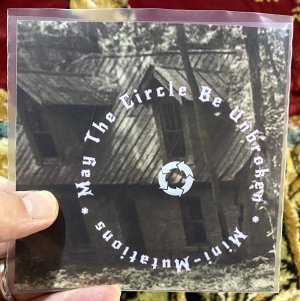 4.) Mini-Mutations – May The Circle Be Unbroken Split CD w/ Michael Cosma.
4.) Mini-Mutations – May The Circle Be Unbroken Split CD w/ Michael Cosma.
Produced and released last year, this split CD contains 30 minutes each from both Mini-Mutations and Michael Cosma, exploring some of the more eerie sides of experimental music. For the Mini-Mutations side, you are treated to an immersive audio narrative, with music, that takes you to some terrifying locations. This release now comes with a download code that offers an EXTENDED version of the story, and instrumental versions of the primary tracks. This is an excellent release that you can’t get anywhere else.
* * * * *
 5.) Austin Rich Reads “The Ways of Ghosts” by Ambrose Bierce
5.) Austin Rich Reads “The Ways of Ghosts” by Ambrose Bierce
One of the earliest attempts I made at spoken word, this collects all the pieces that I aired on the radio, plus some bonus bits that hadn’t been released yet, to create this holiday offering. The CD and the digital release each contain slightly different bonus tracks, making your preference determine what sort of extras you’re likely to hear.
* * * * *
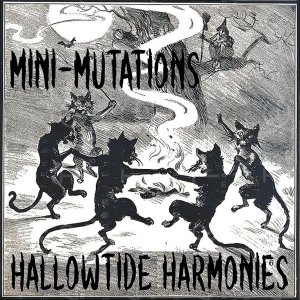 6.) Mini-Mutations – Hallotide Harmonies (Live Digital Album)
6.) Mini-Mutations – Hallotide Harmonies (Live Digital Album)
Recorded during the first Mini-Mutations tour, opening for Mark Hosler in 2018, this digital album collects all the spooky and scary material that I performed. Two and a half hours of live, mutated and creepy performances, guaranteed to put you in the mood for an All Hallow’s Celebration!
* * * * *
 7.) Austin’s Annual Halloween Spook-tacular Podcast!
7.) Austin’s Annual Halloween Spook-tacular Podcast!
For the past 18 years, I’ve been collecting and presenting Halloween Radio, every year around this time. Now, you can listen to all of those broadcasts, covering a number of shows with over 100 hours of programming. Music, Old Time Radio, listeners calling in with scary ghost stories, live performances, experimental radio, and plenty of vintage audio fun, as we mine all of recorded history for anything scary, spooky, sinister, or just plain full of Halloween Fun. It’s all right here, for you to enjoy!
 If you follow the podcast version of UB Radio Salon (which usually is available at some point after the live broadcast on Sunday), then you may have noticed that there was a Mini-Mutations appearance… yet again!
If you follow the podcast version of UB Radio Salon (which usually is available at some point after the live broadcast on Sunday), then you may have noticed that there was a Mini-Mutations appearance… yet again!
DFM.nu, a station in Amsterdam that has roots going back to the late 60s, decided to air every performance from all three days of NorCal NoiseFest this year, which was yet another way that people may have heard the stuff that we do. It was really cool to know that there were multiple ways, across several platforms, that you could see and hear what we do, with live interactive chat on top of it all. We had people from all over the world involved with, performing in, and listening to / watching, our performances. It was really cool.
Anyway, I was performing from my studio on the web stream roughly around the time that UB Radio Salon usually airs, so for their show (and on the re-broadcast, and finally, on the podcast), the Mini-Mutations set is included… along with some excellent and amazing other performers, too. This is at normal speed, but seems to be the audio from the stream… so you can hear what it was like for people live. (I made a remastered version will audio captured off of my mixer live, that sounds a little better.)
Enjoy this excellent slice of radio, with more Mini-Mutations!
Happy Birthday, Bryce Lynch! (Libra, might have guessed.)
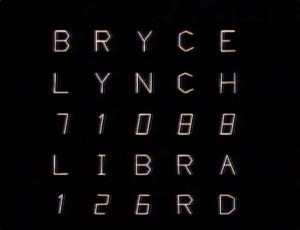
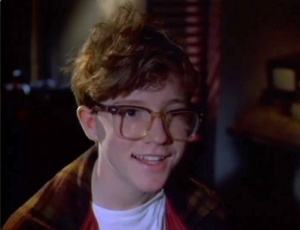
 Here’s a radio treat that can’t be beat! WSLR in Sarasota, Florida has a radio show that features a wide range of strange and interesting music. “Lumpytunes! Definitely Difficult Listening” is a wonderful show that brings you all sorts of music that you cannot hear anywhere else. On Tuesday, October 5th, they decided to broadcast four hours of NorCal NoiseFest, by playing it all back at 200%, and cramming it into a two-hour block. Maddness, you say? But of course! And it sounds wonderfully weird, too.
Here’s a radio treat that can’t be beat! WSLR in Sarasota, Florida has a radio show that features a wide range of strange and interesting music. “Lumpytunes! Definitely Difficult Listening” is a wonderful show that brings you all sorts of music that you cannot hear anywhere else. On Tuesday, October 5th, they decided to broadcast four hours of NorCal NoiseFest, by playing it all back at 200%, and cramming it into a two-hour block. Maddness, you say? But of course! And it sounds wonderfully weird, too.
Check the station archives to hear the show. There’s a Mini-Mutations shout-out at around One Hour, 24 Minutes into the show. Then you can hear LOB begin to introduce “Health Habits” around the One Hour, 36 Minutes Mark. (Thank you Dylan Houser for bringing this to my attention!) Always fun to hear Mini-Mutations on the radio.
 As our lives change, there is a need to break off the things you were doing before, to make room for your new way of life. It’s incredibly common: people start new jobs, new relationships, and new chapters of their lives, almost constantly, depending on how you craft the particular narrative you are interested in making about your own life. This seems to be a fairly common practice for many people: we focus on the new way our life will take shape, and then decide what part of our old life still fits into the way things are now.
As our lives change, there is a need to break off the things you were doing before, to make room for your new way of life. It’s incredibly common: people start new jobs, new relationships, and new chapters of their lives, almost constantly, depending on how you craft the particular narrative you are interested in making about your own life. This seems to be a fairly common practice for many people: we focus on the new way our life will take shape, and then decide what part of our old life still fits into the way things are now.
This week has been spent playing catch-up, for sure, and I’m still not fully there. “Things” are afoot, and as I learn the new steps of this dance, I’m far less close to the parts of the ballroom I once frequented, where plenty of previous chapters of my life all happened. I’m still trying to figure out what I can still reach here, and where those things will fit into these new dance steps that are very new to me.
I’ve always been good at starting things, but wrapping up a chapter has always been challenging for me. I feel like I never know exactly how to “land” the story until well after I already have, and the urge to go back and do it right this time often leaves me to either freeze up, never end things, or worse, overthink the ending to the point where it only makes sense to me. Perhaps this is a portent of how difficult future endings will be, but certainly, it makes me wonder why ends are like this. Saying goodbye, graduations, transitions. All of these things seem to be common experiences for almost everyone, and yet, they seem more difficult than almost anything else.
As I pirouette around the close of some chapters and as I two-step my rewrite on others in this new mixed-metaphor book / dance I’m trying to learn, I wonder: what part of all of this will feel like it needs a revision in five years, and which parts will I finally come to terms with, regardless of how it all turns out?
 Where do people hang out online when they want to socialize?
Where do people hang out online when they want to socialize?
I don’t even know anymore.

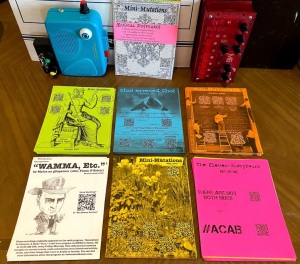 The Lava Lamp Lounge Print-Shop has been working overtime lately, sorting out everything in time for the Rich Treasures DIY Pop-Up at The Art Department here in Salem, OR. If you haven’t heard, you should mark your calendar: June 26th, 2 – 5 PM. (Only three hours! Don’t be late!)
The Lava Lamp Lounge Print-Shop has been working overtime lately, sorting out everything in time for the Rich Treasures DIY Pop-Up at The Art Department here in Salem, OR. If you haven’t heard, you should mark your calendar: June 26th, 2 – 5 PM. (Only three hours! Don’t be late!)
I will be selling an array of items that I’ve made over the years, and it will probably be one of the primary ways to see me in person, in a sort of “public” manner, this summer. I would love to see you there, even if you just want to stop in and say hello.
For sale to the public for the first time: Musical Postcards! Probably the highest profile art project I’ve done, these postcards have not been for sale before, and were instead only available to Lemonade Stand Supporters (and a select group of folks who are on the old-school mailing list). In fact, if you sign up for the Lemonade Stand right now, you will get a June Postcard popped into the mail for you, today, as a thank you for signing up.
However, if you would like to purchase these cards (for use at home, or to send to a friend), they will be available at The Art Department during this event, individually, or as a set, where you can get all of them at a discount. The music on the cards is only accessible through the QR Code; these aren’t available to download elsewhere, and you can’t get this music on other releases. These cards contain music by four different musical projects, totaling almost three hours of new music. Included in this are two singles by actual rock-and-roll combos, a long spoken word piece, and four different studio sessions by Mini-Mutations, unavailable in any other form. These postcards have all been designed by Austin Rich, and come on colorful cardstock, so you can see them coming as your postal carrier walks down the street.
These postcards have been mailed all over the country, all over the world, and has been referred to as a new musical format, something that is very exciting for people who want to make music that can be distributed easily, and cheaply, in a way that could be affordable to anyone with a stamp.
There aren’t that many of these, so make sure to show up promptly if you are interested in these rare items. These are expected to sell out, to make sure to stop by early!
See you soon!

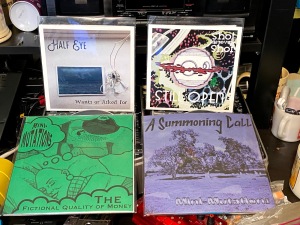
A selection of records will be available at the Rich Treasures Pop-Up, featuring a number of musical projects that I’ve been involved with. 8″ and 7″, lathe-cut, mono records that really get to the heart of what my various sounds and projects. There are limited quantities, and this music is not available in other formats, or on compilations. If you want these sounds, you will want to come to this event. One item is limited to one copy, so consider getting something quickly.
 These records all have bonus materials that are unique to these items, too. Bonus collage inserts and ‘zines, download codes for items that are not on these records, and are not available elsewhere. And all the covers and items were printed and duplicated in The Lava Lamp Lounge, with a little help from Salem Blue Print Company. The lathes were cut by Gorbie Lathe Cuts in Milwaukie, OR. We really keep all of this stuff down home. One of these is a compilation, and comes with downloads of material from the first 15+ years of radio, a gift item what was available at my 40th birthday party (and not really very often since.
These records all have bonus materials that are unique to these items, too. Bonus collage inserts and ‘zines, download codes for items that are not on these records, and are not available elsewhere. And all the covers and items were printed and duplicated in The Lava Lamp Lounge, with a little help from Salem Blue Print Company. The lathes were cut by Gorbie Lathe Cuts in Milwaukie, OR. We really keep all of this stuff down home. One of these is a compilation, and comes with downloads of material from the first 15+ years of radio, a gift item what was available at my 40th birthday party (and not really very often since.
I love music, I love making music, and I love records. Hopefully you will love these records, too.
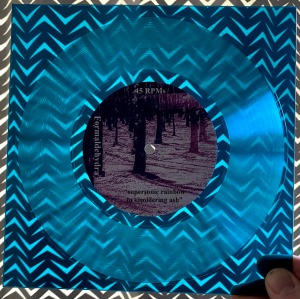
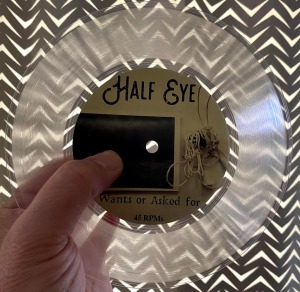

I’m really looking forward to the DIY Pop-Up happening at The Art Department. Please, join me!

Please visit patreon.com/austinrich to support the work I do!
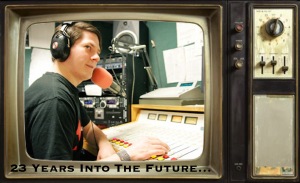
On this day in 1998, I began my first radio broadcast on KWVA in Eugene, OR. It began at 4 AM, and ran until 7 AM. A momentous day for me! It had taken months of calling and stopping in to chat with the staff and then my application got lost and then the staff changed. But: eventually the stars aligned, I walked in and spoke with the station manager, who had found the application, and at the next staff meeting, they agreed to let me on in the least desirable spot. I leapt at the chance.
I spent the evening before in the bar with friends, wandered out at 2:30 AM, picked up my records at my house, walked to the studio, and began an odyssey that I’m still on to this day, 23 Years Later. I haven’t really left that studio, in a way.
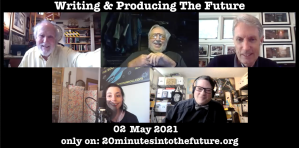 To celebrate my 23rd year, I launched a new show about the eerily prescient sci-fi program, “Max Headroom,” where I’ve been watching and discussing the show with my friend Heather, who has never seen it. And, as if that weren’t enough, I interviewed three of the creators of the US version of the show yesterday, so I could get the full scoop on Network 23 for my 23rd year in radio. The fact that new episodes come out at 23:00 Hours, GMT is merely icing on the cake.
To celebrate my 23rd year, I launched a new show about the eerily prescient sci-fi program, “Max Headroom,” where I’ve been watching and discussing the show with my friend Heather, who has never seen it. And, as if that weren’t enough, I interviewed three of the creators of the US version of the show yesterday, so I could get the full scoop on Network 23 for my 23rd year in radio. The fact that new episodes come out at 23:00 Hours, GMT is merely icing on the cake.
For some, there are plenty of things about the number 23 that are interesting, and while my own particular numerological curio happens to be the number pi (which kept – and keeps – popping up in my life, for a variety of reasons), as an enthusiast of all the dada streaks in our culture, 23 has been of interest to me, too, as it does re-occur in places that are well-worth investigating.
I knew that, going into my 23rd year of radio, that I would want to do something meaningful and significant, to me, if to no one else. And, since I’d been toying with a certain idea regarding “Max Headroom” for a while, it only made since that I should try to line up this new show with this occasion. We even got our release date to line up with the original UK broadcast of the 1985 telefilm, and it felt like we were doing everything right. I was trying to infuse the show with my brand of “Headroom”-style humor, and we pre-recorded so far in advance that there would be no missed deadlines this year, which felt like a win all around. Finally, it seemed like I had done everything right this time.
What we could not count on was that fate had other plans for and and this show. While I knew in the back of my head that it was possible we could get a few listeners, and many even some mail and interactions from fans, I was not prepared for the fact that the first person to contact us was none other than Martin Newell of The Cleaners From Venus. And, sort of like a story torn from his own songs, Martin called his friend Steve Roberts, who called his friends Brian Frankish and Michael Cassutt… and so on.
It’s one thing to get interaction from listeners. It’s quite another to have among those listeners The Greatest Living Englishman, with connections to the “Max Headroom” creative team.
The power of 23 indeed.
I’ll be honest: I couldn’t have lined all of this up on my own, even if I had intended it. I can pick release dates and I can try and be as clever as I want to be, but I could never have planned for something like this. I never could, and I never will be able to.
I’ve been on countless radio shows and podcasts, worked at and visited a ton of stations and studios, and produced hundred of hours of radio in my life. And, here’s where I could name-drop ’til the cows come home, not that I don’t already do that a lot anyway. And yet, with all this experience under my belt, I still don’t know what tomorrow holds.
Coincidences and strange encounters, like those of “Max Headroom” and the world of rock and roll, do not afford you a chance to know what is coming next. One day I’m on the phone with Ronnie James Dio’s manager, and somehow this leads to getting free tickets to The Faint, Patti Smith and Ministry. Another time, you get to spend an hour with Exene Cervenka, live on the radio, because once you played an Angry Samoans song for a listener who happened to have connections. Still another time, I’m sitting in while a live episode of “The Puzzling Evidence Show” is being aired on KPFA, watching as these two radio weirdos are offering some of the best verbal wordplay I’ve ever been witness to. I recall Johnathan Richman calling to apologize for missing our scheduled interview, because he had a break-down and was already running late for the show, and he hoped some guest list spots would be enough to make it up to me. Getting to know all the living members of Negativland has been personally fulfilling in a huge way, while being let down by Jello Biafra at a Zolar-X show was actually the perfect kind of encounter to have with him, with hindsight. The time I met Bloodhag long enough to get on the guest list to a show where I got to party with Andrew from Dead Moon is the kind of coincidence that radio just puts in your lap on a regular basis, and it’s not exactly something you can plan around. I stepped into a radio booth 23 years ago hoping to play some silly records and mix in this faux “religious radio” spiel I’d been working on with my friends. And In the here and now, it has led to me talking to my favorite Hollywood Creators, and not just a super-stoned J Mascis backstage at a metal show I was at in Texas.
I think that is what radio, ultimately, is. In the long run. There’s always one more hour to fill, and there’s always another phrase to turn while introducing the next bit, and there’s always a new twist on an old idea that you could try, and there’s always a new strange coincidence that leads to you having a conversation with someone you admire that you could never have anticipated.
So I have no idea how to predict what is coming after this.
What I can say is that, strange coincidences and name drops aside, most of that 23 years has not involved having cool things happen to me. The majority of that time has involved sitting alone, in front of a radio consul, trying to create something that I would want to find if I was sitting at home, listening instead. And while that kind of life is a little lonely, to be sure, and has lead to periods of solitude over the long haul, it all seems worth it when I perfectly nail a one-hour broadcast, or get to do something wild like this.
Being a radio creator is a strange and wonderful life, and sometimes, only when you can reflect on the long arc of things, can you see that the things you did to get here were part of a larger pattern, much like thinking back on a radio show you just heard, to find the running theme through the entire show.
In the moment, there is only pushing forward. You can’t predict what exactly will happen. There is only finding the next track, the next sample to mix overtop, the next perfect transition, the next idea for a show.
There is only moving forward. To the next show, the next year, the next milestone, and hope that the not-knowing is something you can live with. While I love to reflect, I must also scan the horizon, looking for the next outcropping where I can land my radio boat, and hope to find the next thing that inspires me to build a little show there.
Thanks for listening, all these years. Let’s see if we can make it to 46.
Be seeing you.
Do you have memories of “Max Headroom”? Why not call in, and leave a message. It may well end up on the show!
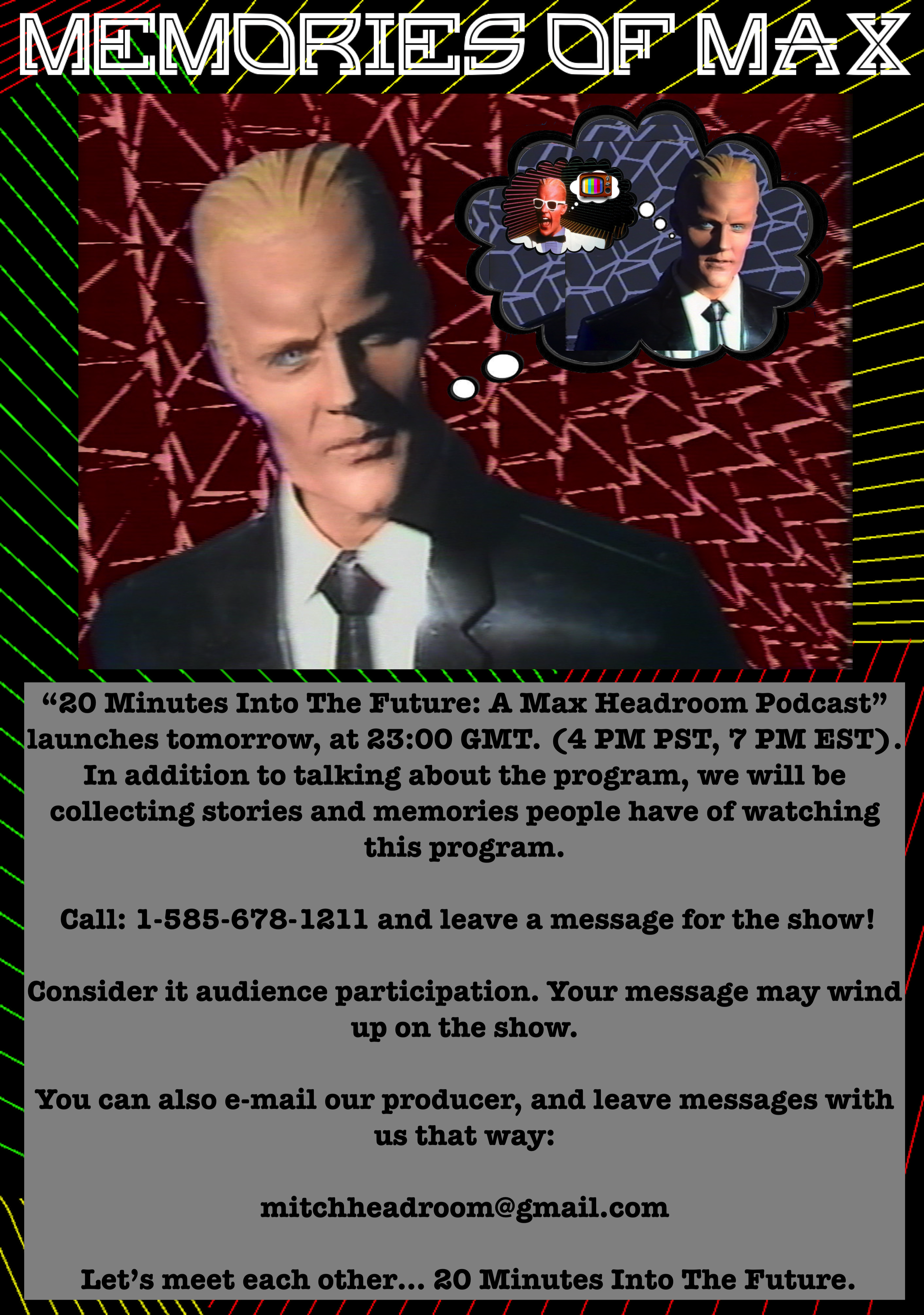
Call in with your Memories of Max, and listen to our DEBUT EPISODE, which drops at 4 PM PST, 7 PM EST, or 23:00 GMT.
Let’s go… 20 Minutes Into The Future!
Here is my contribution to the Mail Art Book I mentioned a bit ago. I like the collage, myself. Hopefully something happens with this book someday. There’s some good stuff in there, so far.

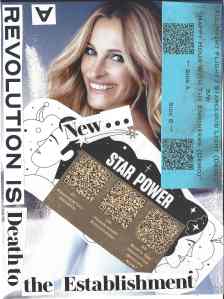
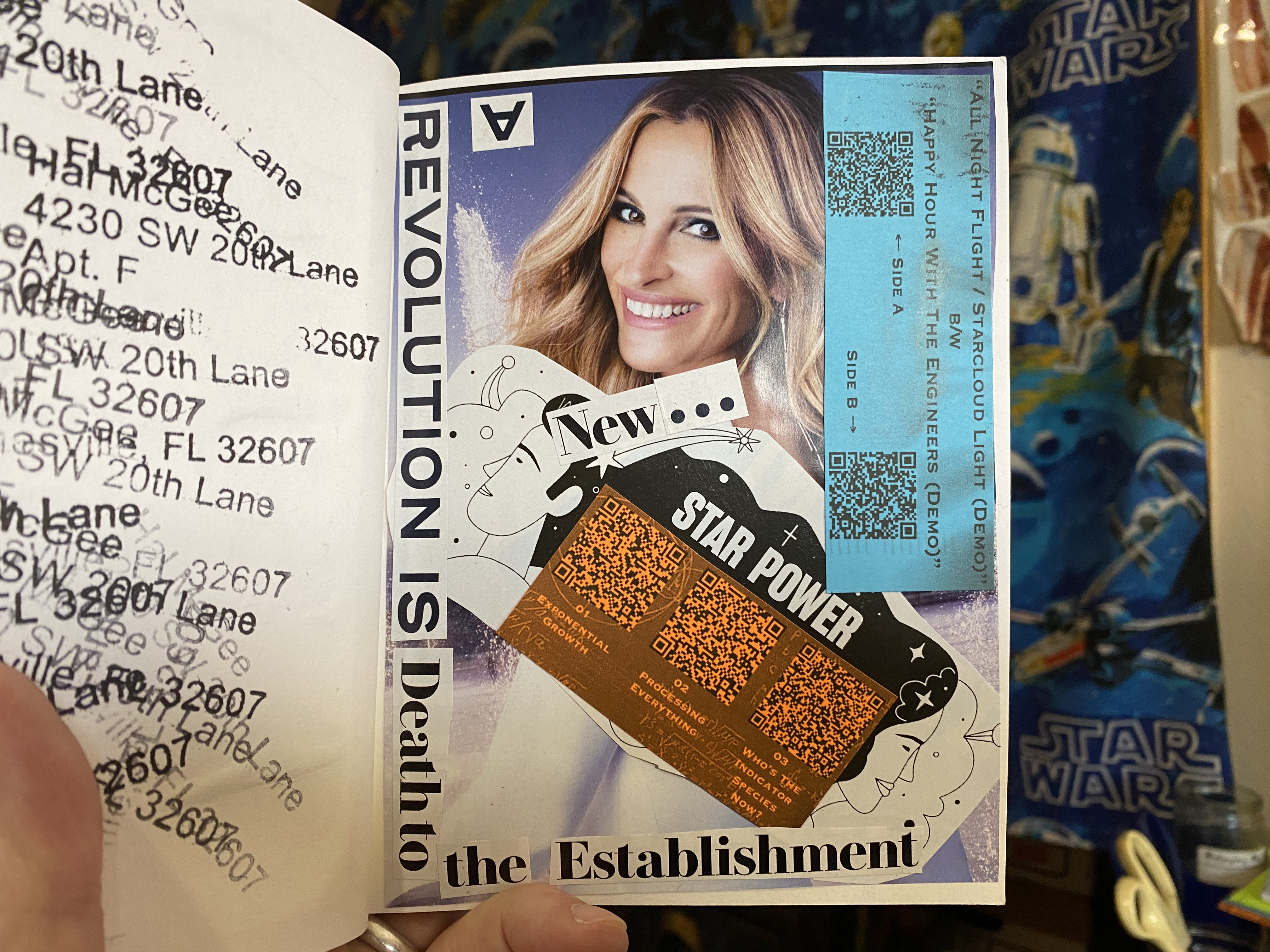

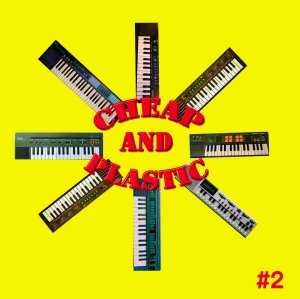 My continued friendship with Hal McGee and his Electronic Cottage group of artists has been fruitful yet again, as I had another track included on the most recent compilation, Cheap And Plastic #2. This is a sequel to the 2012 compilation that has a killer line-up in and of itself, so to be included in the follow-up, which again has an incredible playlist, is nothing to sneeze at. And the comp was sequenced by Chris Phinney too, who knows a thing or two about how to sequence a compilation. I’m continually impressed with the kinds of work this group churns out, and it humbles me when I think that I’m occasionally not in the mood to write and record. To see how much material these folks have put out is pretty motivating.
My continued friendship with Hal McGee and his Electronic Cottage group of artists has been fruitful yet again, as I had another track included on the most recent compilation, Cheap And Plastic #2. This is a sequel to the 2012 compilation that has a killer line-up in and of itself, so to be included in the follow-up, which again has an incredible playlist, is nothing to sneeze at. And the comp was sequenced by Chris Phinney too, who knows a thing or two about how to sequence a compilation. I’m continually impressed with the kinds of work this group churns out, and it humbles me when I think that I’m occasionally not in the mood to write and record. To see how much material these folks have put out is pretty motivating.
The Cheap And Plastic concept is actually pretty great: sure, it can be easy to make a lot of experimental music when you have a ton of gear, often very expensive, that can accompany you while you perform an instrument that you are playing “live.” So, to cut to the chase: what can you do with the cheapest gear you have? There’s a little more to it than that, but the idea is to be quick, to be cheap, and to find inspiration in the innovation that thrift-store gear can offer you.
 To that end, I decided to use a keyboard that M found for me while in a thrift store: a “Beat Bugs” branded toy that is shaped like a skateboard and has a keyboard on one side. While the samples of animated kids characters playing Beatles songs will be LOVELY to bend, there is something very simple about the generic synth sound that I’m really fond of. I’ve used it a few times on different pieces, but usually as an overdub, on top of other stuff I’m recorded. For this piece, I only used this keyboard, and allowed myself to add another take over the previous one, provided I panned it differently.
To that end, I decided to use a keyboard that M found for me while in a thrift store: a “Beat Bugs” branded toy that is shaped like a skateboard and has a keyboard on one side. While the samples of animated kids characters playing Beatles songs will be LOVELY to bend, there is something very simple about the generic synth sound that I’m really fond of. I’ve used it a few times on different pieces, but usually as an overdub, on top of other stuff I’m recorded. For this piece, I only used this keyboard, and allowed myself to add another take over the previous one, provided I panned it differently.
Using only those two tools (this keyboard and panning), I proceeded to compose something of which I’m really quite fond. There are no samples, and no slowed down loops that I’ve manipulated on the computer first, which then creates a bed of sound for me to mix and chop samples over. None of that. In a way, it’s just me, the keyboard, and the music that came out of me. Some of the simplest sounds I’ve ever made.
While my track is only one of many, it’s not what this is about. You really should check out the whole thing, as the other artists are very excellent, and there’s tons of cool things in this collection. And it’s LONG! I’m still working through it, there is so much excellent music here!
I get to make some cool music, and participate in some cool stuff, and I’m truly humbled by how lucky when I think about it. Hopefully some of you are entertained by some amount of this, because I’m having a very good time.
I bought one of these portfolio folders from the @artdepartmentsupply and put my fave old show fliers in it.
I attended / performed in all of these shows, except the X flier, which I got from an ex many years ago, who has since passed away.
I have twice as many that still need a home, but these are the important ones. At least they won’t rot away in a box somewhere, not being seen or stored well.
Looking at these makes me miss being in Cathead more than I have in years. And it made me miss a period in PDX where Cheryl and I would go to shows several days a week.
And another era, before that, when Sierra and I would go to shows all the time in Eugene.
And even further back, when I wanted more than anything to see live music, and play in bands, because holy shit, these albums are amazing.
Music is the best, and I wish I could put up fliers again.
I fuckin’ miss all of you.
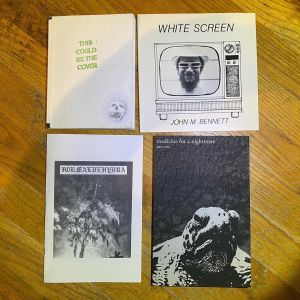 I’ve been very lucky, and have received a few excellent books in the mail lately, which I’m very much looking forward to reviewing.
I’ve been very lucky, and have received a few excellent books in the mail lately, which I’m very much looking forward to reviewing.
“This Could Be The Cover” is a book where it is mailed around to different artists, and they each fill a page before mailing it to someone else. (I got it from Hal McGee, and I desperately need to fill a page and send it along.)
“White Screen” was published by my mail-art pen-pal, John M. Bennett, in 1976, one year after I was born!
Formaldehydra’s new CD / Zine is perfect for trying to get work done in the afternoon.
“Medicine For A Nightmare” is a beautiful book / zine that contains art written / drawn / photographed during the pandemic.
Amazing stuff, and I’m very excited to have a change to get stuff like this!
Thanks friends!
I went to check out the #SalemSnailMailArtSwap at The Art Department today, and it was really excellent! It’s so cool to see an art show like that in Salem, and I couldn’t wait to check it out. Plus, I hadn’t been in since a lot of the new changes have been made, so it was worth the trip. The store looks great, and I picked up a new portfolio so I can hold my old show fliers. I already need another one.
Anyway, not only is the show incredible, and the other entries are very, very cool, I was stoked to see that my entry was prominently on display! How very cool! I don’t think I can do the show justice here, only to say that I was really excited to see so many other people who are local, and also participate in mail art! I am humbled to be included in such an excellent show.
Has anyone named the snail yet? Because it is amazing.
The other artists did incredible work, so you should check it out the next time you’re downtown. I’m looking forward to hearing about the other excellent events that they will put on this year!
Thanks again!
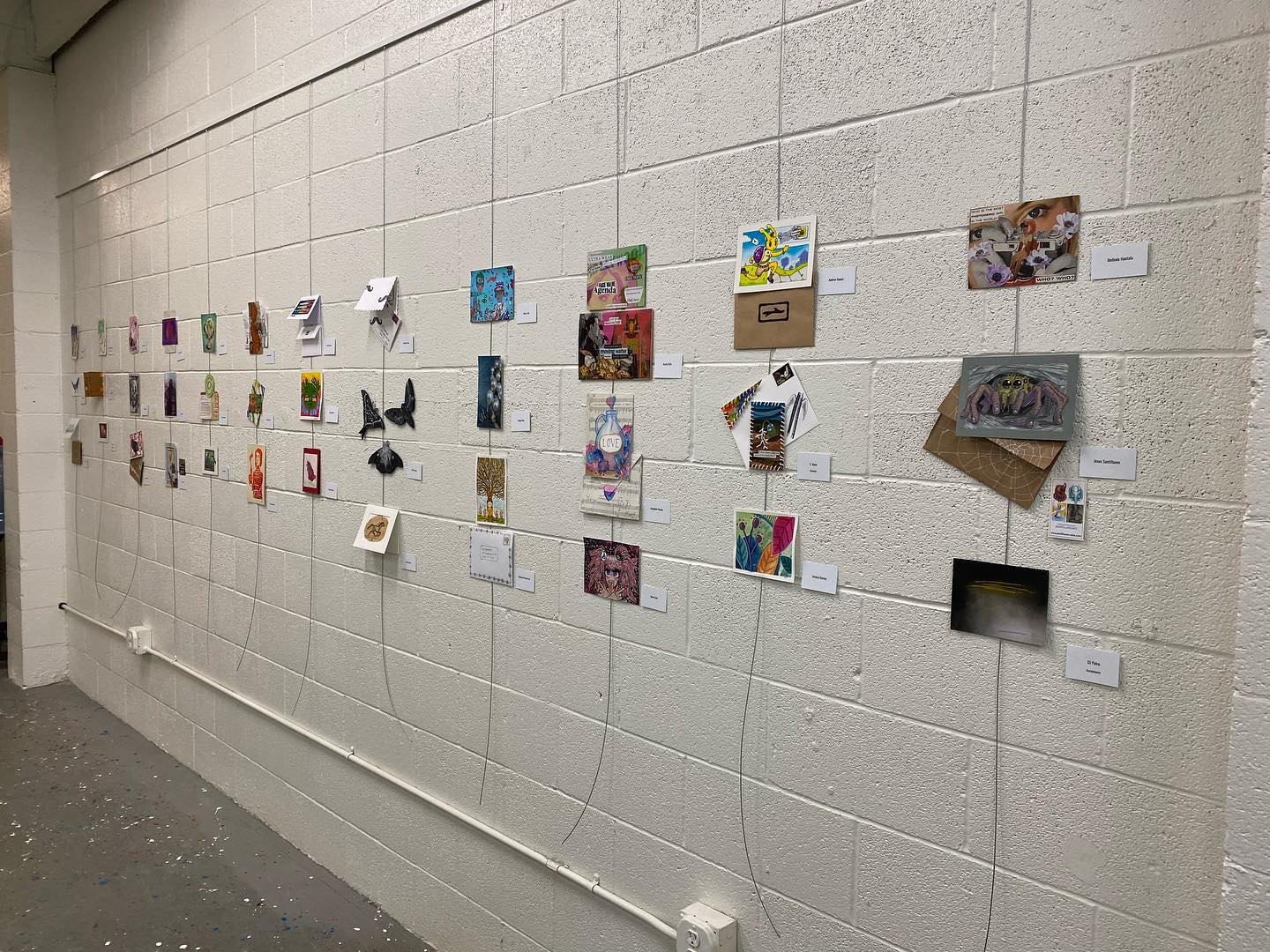

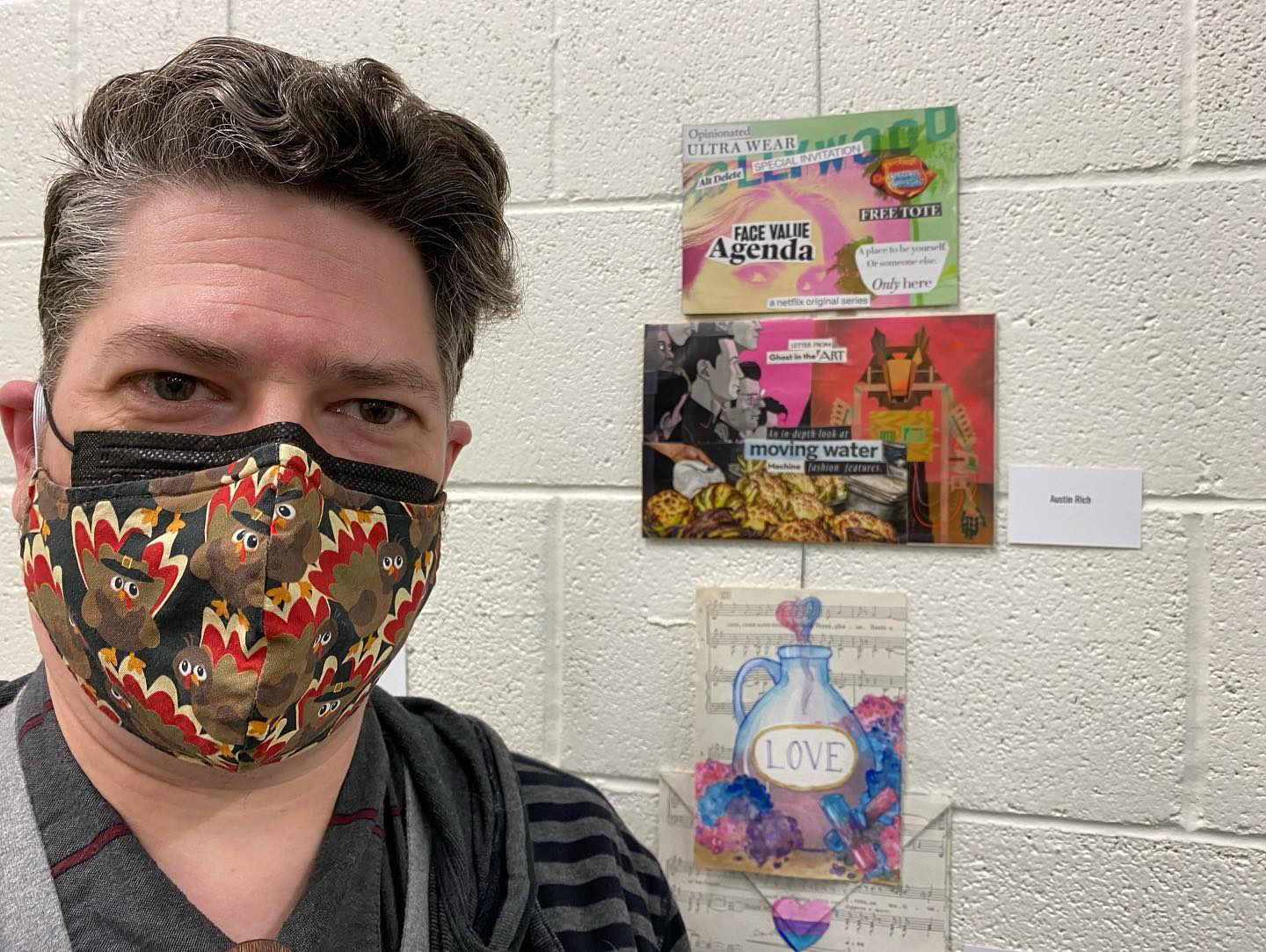

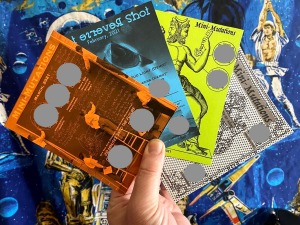 It must be March.
It must be March. This month, Mini-Mutations has a new 30 minute EP that you can only hear via the new postcard that is being mailed out to mailing list subscribers AT THIS VERY MOMENT. This EP, “Five Hundred Thousand,” is a three part exploration of new material, new ideas, and new experiments that is at the heart of all that Mini-Mutations does. I’m excited to have the EP out, and would love to share it with you.
Which brings me to these postcards. Every month, original content that is not available any other way is available for you to enjoy, directly sent to your mailbox. It’s a musical postcard that combines old-fashioned Postcard technology with new-fangled QR-code technology, to offer you new music in the privacy of your own mailbox. Join the mailing list, and receive each new postcard when they are made! These were recently written up by the Eugene Weekly, and are now an international sensation! (Cards have landed in Canada, Germany and Taiwan.) We’ve hit almost 30 states, too, so help me make it all 50, and join the mailing list, today!
As an incentive: this month’s postcard comes with some bonus material, in addition to the new Mini-Mutations EP. On March 21st, a new podcast is launching. 20 Minutes Into The Future: A Max Headroom Podcast is a show where we watch Max Headroom, and talk about it. With this postcard, we offer a chance to hear the first episode before the show officially launches. You can find out more information about the show at 20minutesintothefuture.org. We officially launch on March 21st. Our second episode, where we discuss the UK Telefilm, will coincide with the 36th Anniversary of the original broadcast. Keep your eyes on the website, as we will be hosting a watch party on Zoom, the details of which will be on our site. In the meantime, you can enjoy our first episode via the postcard, before anyone else can hear it.
March is going to be a great month, and. It all starts with this new postcard. Get yours, now!
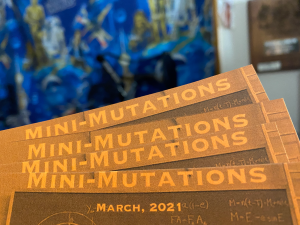 Is it that time of year already?
Is it that time of year already?Marking the one year anniversary of our collective horrific experience that we’re all still working through, here’s 30 minutes of new Mini-Mutations, meditating on everything that it means to be in the particular rut we’re all in these days.
If you are on the mailing list: don’t worry! You will receive a postcard, just like normal. We received a couple of donations last month specifically for postage, and if you would like to help us out on that front, we would happily accept the help.
If you have not received a postcard yet, and would like to know more, you can visit austinrich.org/postcards/ to get all the information. And, if you just want to take the plunge: sign up for the mailing list.
I’ve been spending a lot less time on social media, and interacting over there just does not scale for me, right now. I need that time to focus on my kittens, editing podcasts, returning actual mailed letters that I get from people, and recording things. That doesn’t mean I won’t be off it entirely, or that I won’t return. But I just don’t have the bandwidth for it at the moment. Maybe in the future. When I’ve got a little more space for it in my everyday life.
So, if you would like some interaction, e-mail or traditional post is sort of where it’s at. I would love to get an e-mail or letter from you. I think it is actually be better way to roll…
I dig this new card. Hopefully, you do, too.
Our new program launches on 21 March 2021. There’s a lot more information over on that page.
 Our Premier Episode will be airing at 23:00 PM, GMT, on 21 March 2021.
Our Premier Episode will be airing at 23:00 PM, GMT, on 21 March 2021.
6 PM, EST, or 3 PM, PST.
You can hear a sample of our pilot now if you subscribe to the show:
iTunes RSS or Generic RSS. We are also on Mixcloud.
Subscribe today, and live… 20 Minutes Into The Future!
* * * * * *
 36 years ago, BBC 4 took a chance on a very unusual 60 minute “telefilm,” that was to offer the backstory for their new “digital presenter,” who would be showing 13 weeks of music video programing later that Spring and Summer.
36 years ago, BBC 4 took a chance on a very unusual 60 minute “telefilm,” that was to offer the backstory for their new “digital presenter,” who would be showing 13 weeks of music video programing later that Spring and Summer.
What began as an experiment in testing out “cyberpunk” on broadcast television, became “Max Headroom,” who ran rampant through our culture as he moved from mainframe to mainframe, infecting us with the same kind of digital buoyancy that we were all looking for in the…
View original post 329 more words
 Combing back through all the various missives that have reached me in recent months, I failed to mention that Mini-Mutations has been getting a little action on the radio shows of Lord Litter!
Combing back through all the various missives that have reached me in recent months, I failed to mention that Mini-Mutations has been getting a little action on the radio shows of Lord Litter!
Lord Litter has been making compilations and radio shows since 1987, and you can find almost all the broadcasts on archive.org. It seems as if the Lord seems to enjoy the split release I put out with Michael Cosma, which you can still get on CD, and digitally through haltapes.com. I’m quite proud of that one too, as it is my Halloween release.
So, why don’t you tune in to Lord Litter’s show? He’s got excellent taste, and a very cool radio show.
 File this one under the, “It got shoved in the back and was lost for a little while,” heading, as it was certainly overlooked.
File this one under the, “It got shoved in the back and was lost for a little while,” heading, as it was certainly overlooked.
Just before the end of the year, Lob Instagon released the most recent installment of their COMPLEXITY compilation series, something that was very long overdue, and which, as of this writing, is accepting submissions for the SIXTH volume. This is a series not bound by genre, but does try to keep submissions in the “eight minutes or less” category of music. As the saying goes, “Life is Complexity – Complexity is NOW.”
This isn’t the first time I’ve been on one of these compilations. For this particular series, I’ve been working on a very long Mini-Mutations piece, that is all about Complex Numbers. I recorded the bulk of the piece way back when I first submitted to this comp, so I actually haven’t revisited any of this material in quite some time. It is sort of foreign to me, in that way, and I’m pleasantly surprised at the results.
These comps are all fantastic, and are a good overview of some excellent artists working in experimental music right now. Plus, I like the mission statement: as long as there are new submissions, and as long as everyone is still interested, this series will keep going. And, they are free! What better price for you to enjoy some excellent new music.
Thanks again for your support, and thanks again to Lob, for making such excellent music for the work to enjoy.
 The February Postcards are ready, and will go out in the mail tomorrow. Anyone currently on the mailing list will receive one. If you would like to get on the mailing list, then just send an e-mail to austinrich@gmail.com. Make sure to mention you want to join the postcard mailing list, as the bots are only so good at all of this. And, if you are feeling so inclined, please make a donation, to keep the postage flowing.
The February Postcards are ready, and will go out in the mail tomorrow. Anyone currently on the mailing list will receive one. If you would like to get on the mailing list, then just send an e-mail to austinrich@gmail.com. Make sure to mention you want to join the postcard mailing list, as the bots are only so good at all of this. And, if you are feeling so inclined, please make a donation, to keep the postage flowing.
This month’s postcard includes a pair of demos from the new batch of songs that the Master Control Unit has been outputting, for the second album by Shot Reverse Shot. These demos will not be available anywhere else, any will only be heard in this format on this postcard. (They might not make the final cut for the album; you never know.) If you want to hear these, you should get on the mailing list, NOW.
And, if you want to get the album or the 7″ by Shot Reverse Shot, why not check out the Bandcamp page, for all your merch needs.
It’s a little musical concert… sent straight to your mailbox!
Enjoy!

{AN} Eel, out of Toronto, Canada, is one of those tireless artists who is constantly working on new projects, in a way that keeps Mini-Mutations on track. (If I want to feel motivated, I just think about Chris Phinney or Dylan Houser or {AN} Eel, and I realize how lazy I truly am. You should check out their work. They are very impressive.
Anyway, this particular compilation series is a stellar run of collaborations, where all eight volumes include collaborative work by two different artists. I’ve been on one of these comps before, and it is a great change of pace to work with someone you have never worked with before. (And, remotely, even.)
This time, I worked with an artist who goes by the name BB, and I actually did a very atypical bass performance on this particular track. But, really, our track is only one part of this comp. There are 34 other artists on this comp, collaborating on 18 tracks. It’s pretty epic. And, now, you can enjoy it, here. Thanks again, {AN} Eel! You are a powerhouse in the world of experimental music.
 It’s been very odd to get contacted by strangers, who want to get on the postcard mailing list. And, when I finally got copies of the Eugene Weekly,* it started to make a little more sense why they. might be inclined to seek out my e-mail address: the story takes sup half a newspaper page. That’s a lot of column inches devoted to this thing that I do. If I read this in a paper, I would probably contact me, too.
It’s been very odd to get contacted by strangers, who want to get on the postcard mailing list. And, when I finally got copies of the Eugene Weekly,* it started to make a little more sense why they. might be inclined to seek out my e-mail address: the story takes sup half a newspaper page. That’s a lot of column inches devoted to this thing that I do. If I read this in a paper, I would probably contact me, too.
But the length of the story is still wild to me. This is sort of like being told, “Yeah, can we write a little something about (insert some small thing that you do creatively),” only to find that they are going to run with it in some amount of detail. I never thought that the postcards would be such a hit, but they were certainly a big hit with me when I got them. The way of the world is very strange.
Anyway, seeing the photo that I took in my office / studio, I realized there’s a fair number of personal Easter Eggs that are visible, and not just my trademark bow tie and Hal Jordan graying temples. So I thought it might be fun to run down some of the more interesting ones. It never occurs to me that, perhaps, I have had some adventures and have seen some things until I try to summarize something as simple as what’s in the photo that was seen in the paper.
So, to my best recollection, here’s a run down of some of the things you can see in this photo. I would say that the only real difference between the cropped photo and the full photo you can see on the website, is that you can see a lot more of the boxes of comics and ‘zines from my collection.

Anyway, in the photo, you can see:
My childhood teddy bear, Jasper, who I have had since I was four or five.
No less than two pieces of gear gifted to me by kiisu d’salyss of the band The Secret Light, who was in the very first band that I was ever in, and who has consistently gifted me useful pieces of gear over the years.
Not one but two velvet paintings, that I was given by the owners and operators of the Velveteria, when I was an employee there way back when.
A Dead Kennedys poster that was given to my by my long-lost friend Lyra, who I haven’t seen in years, and who I miss dearly.
A Star Wars kite that I have had since I saw Return of The Jedi when it was new as a kid.
A Tom Waits poster that I was gifted by the staff at the record store across from the B. Dalton bookstore I worked at.
A They Might Be Giants poster that I got from KPSU when I worked there.
A Weezer poster that was gifted to me by my sister who was downsizing the stuff she owned.
And Tiki Commander Geordi Laforge, the newest addition to that wall back there.
I’m sure there’s more, but those are the ones that stand out.
austinrich@gmail.com.

*(Thanks again, Marc Time & Cori Larson! I will happily take more copies, if you happen to have extras lying around and you would like to send it along!)
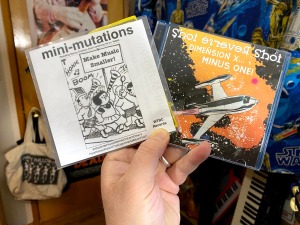 $18. Both the new Mini-Mutations and Shot Reverse Shot albums in one set.
$18. Both the new Mini-Mutations and Shot Reverse Shot albums in one set. Save four dollars when you buy both the new Mini-Mutations and the new Shot Reverse Shot albums together, at once! These both came out in January or 2021, and offer two different takes on the kinds of music that we like to make.
 Reading Nancy Comics And Listening To Irv Teibel (Experimental).
Reading Nancy Comics And Listening To Irv Teibel (Experimental). The new album by Mini-Mutations! Professionally duplicated CDs provided by kunaki.com, these discs contain new music and live performances not available elsewhere, and now you can get it on this continuous audio presentation that deals with some of the thorniest issues in our world. Home-made packaging contains your own mutated money, a chance to join Professor Schwartzwelder’s “Mini-Mutations Civil Disobedience 101” Club, and a card that proves your disc was inspected by #34, the most well-regarded inspector money can buy. Limited quantities, not available digitally. Get yours today!
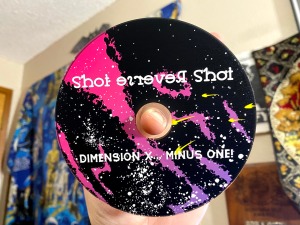 Dimension X… Minus One! by Shot Reverse Shot (Not Experimental)
Dimension X… Minus One! by Shot Reverse Shot (Not Experimental) The debut album by Shot Reverse Shot! Professionally duplicated CDs provided by kunaki.com, these discs contain new music by the interstellar collection of cyborgs, clones and androids, who perform new tunes written by the Master Control Unit, and produced by Austin Rich! Old Time Radio On Your 21st Century Stereo! This music is not available digitally, so if you want to hear these songs, you’ll have to get the disc! Limited quantities, so you should get yours today!
I’m quite proud of these releases, and I can’t wait for you to hear them. Hopefully you enjoy these as much as we do.
 $5. Limited Quantities! INTRODUCING CHEFSAC… with REMIXES!
$5. Limited Quantities! INTRODUCING CHEFSAC… with REMIXES!
In February of 2020, the excellent release by Chefkirk and Le Petit Sac – INTRODUCING CHEFSAC – landed, just before the pandemic really took hold of our everyday lives. This was a pretty excellent gift to receive just before everything went sideways.
Then, a number of artists were secretly contacted by CHEFSAC to provide them with remixes of this material, for a series of releases that have been coming out on the cassette imprint of Sweatband Records.
I am happy to announce that a remix Mini-Mutations is among the many remixes that are available as a part of this series of cassette releases. And we are in pretty good company, too. There’s a pretty excellent group of folks on the Sweatband Records roster, and I do like the idea of a humble remix titled “What You CHEFSAC” making an appearance on one of these tapes.
I’ve largely self-released my own material, and I’ve enjoyed the flexibility and the freedom to do exactly what I want, the way I want to. But I’ve also been lucky enough to get on compilations for the NorCal NoiseFest every year, and both Arvo Zylo and Hal McGee have been kind enough to include stuff I made on their releases, too. Sometimes it seems improbable that anyone would like this stuff enough to release, but I guess the fact that I have faith in this project at all has helping make it a reality in the world at large.
Anyway, there are a very limited number of these tapes, and I don’t think there’s plans to do more than one run, so if you want the tape, contact me directly. First come, first served; these won’t be on the Merch Page just yet, but I will certainly sell one to you. $5. Limited Quantities!
Once we are sold out, I will make the track available somewhere else, so it doesn’t fade into obscurity.
Thanks again, Chefkirk and Le Petit Sac! Always fun
 WTBC decided to hit the ground running this year, and that means that we have four new releases, all within the first month of 2021! And with these releases, we are debuting a brand new project that we have the pleasure of working with: Shot Reverse Shot. THIS IS NOT EXPERIMENTAL MUSIC. Shot Reverse Shot offer Space Grunge Metaphors that offer a charming glimpse into the musical world of deep space travel. This band isn’t like anyone we’ve worked with before, and we are very excited to bring you this band.
WTBC decided to hit the ground running this year, and that means that we have four new releases, all within the first month of 2021! And with these releases, we are debuting a brand new project that we have the pleasure of working with: Shot Reverse Shot. THIS IS NOT EXPERIMENTAL MUSIC. Shot Reverse Shot offer Space Grunge Metaphors that offer a charming glimpse into the musical world of deep space travel. This band isn’t like anyone we’ve worked with before, and we are very excited to bring you this band.
WTBC now offers professionally duplicated CDs, limited edition lathe cut records, and hand-made ’zines and paper ephemera, all delivered from our house, to yours! These are just some of the things we have to offer for the music and written-word enthusiast in your life. And all of them are available, NOW!
Our musical postcards contain new music by WTBC artists, designed in-house, and mailed directly to your home. The music on those postcards are unique to those cards, and are currently unavailable any other way. Think of them as socially distanced audio performances, that you can enjoy from the comfort of your mailbox.
We also have 8” records, split tapes and CDs, and a selection of ’zines that are not available elsewhere. If you want to enjoy these unique items, visit our store, and find releases by Mini-Mutations, The Olsen Twins Ghostlight Ensemble, Shot Reverse Shot, Half Eye, Formaldehydra, DEATH MUTATIONS and more, all of this – and more – are all waiting for your enjoyment at wtbc.bandcamp.com.
Order Today! And: Be Seeing You!
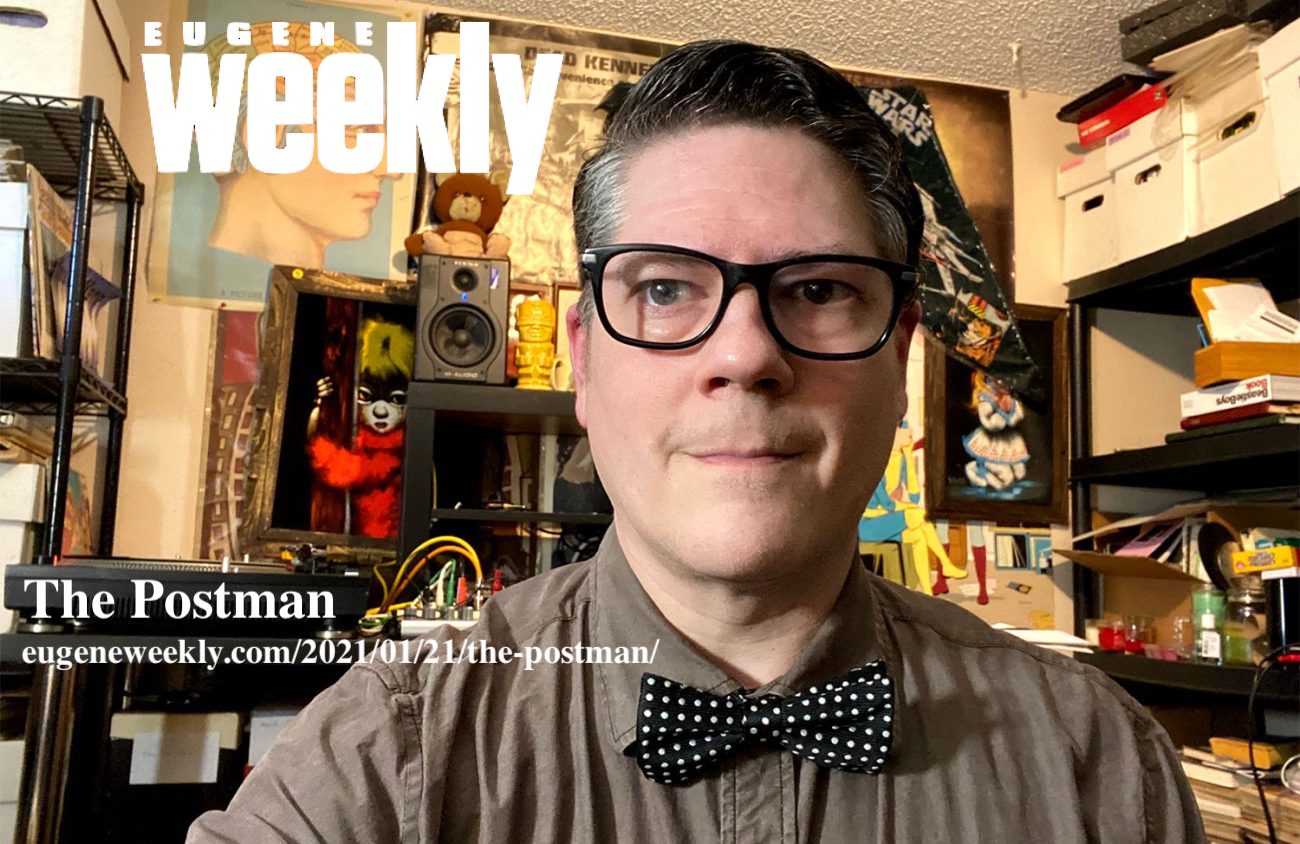
Sometimes, word of mouth does you right.
A friend told a friend, who requested a postcard, and told another friend, and I was suddenly on the phone with William Kennedy of the Eugene Weekly, talking about postcards.
I assumed it would be a small blurb about something different happening with the mail. Instead, it is much longer.
You can read the article here.
Now: can someone from Eugene please save and send me a copy? I’m still sort of blown away…
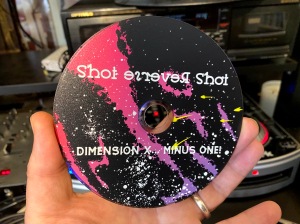 Sometimes, we lead lives that are more charmed than we remember, or even realize at the time. Little experiences can change everything around us in big ways, and the smallest things said at a point in the deep past can echo forward in strange, and unpredictable ways.
Sometimes, we lead lives that are more charmed than we remember, or even realize at the time. Little experiences can change everything around us in big ways, and the smallest things said at a point in the deep past can echo forward in strange, and unpredictable ways.
For example: I had become good friends with a gentleman who used to be known on the Inter-Web-A-Tron as kungfuramone. They had always been a cool dude, and was involved in at least a few bands that had made albums and played out. One had even toured.
Anyway, when kungfuramone moved to Portland, he happened to land a room at Jesse Sutherland’s house, during the transition period between The Automatics and The Epoxies starting to take off. (I remember being at their house during an early “Adhesives” practice session.) Knowing kungfuramone allowed me to attend a number of cool parties and gatherings; one of my birthdays was spent at an Epoxies show, which was incredibly memorable.
During one of the many parties I attended at their house, which was a wonderful pad that was a lot of fun to hang at back in the day, I remember getting into one of those kitchen conversations that you have with a group of your friends when you are several drinks into the evening, and almost anything else could happen. A few of us were talking about the next projects that they were going to work on, and most of it revolved around, “I wanna write a song about this,” or, “my next album will be like that.” It was actually quite lovely, listening to all these friends of mine plan the next step in their creative lives.
I was involved in radio at the time, and I had been in a couple bands before that. But nothing to write home about, and certainly nothing that recorded very diligently, or seriously. So as a way of contributing to that conversation, I threw out the following sentence:
“Someday, I’d like to just record a full album of songs that I wrote. Nothing fancy, just something that I came up with.”
I remember Jesse nodding, and saying, “That’s not too hard. You should do it.”
I am recalling this scene, this experience, this moment more and more, and now that I have professionally duplicated copies of my new album in my hands, it is pretty impressive to have finally done, even if it was almost 15 years later.
It took me the longest time to realize that if I wanted to make art, that I had to do it myself. I had to start the band, I had to design the image, I had to record the song myself. And then, it took a while to discover that I could even teach myself how to do things I didn’t know how to do, if it was important to me, and contributed to the work I was doing. I was not young when it occurred to me that I should probably try and write ‘zines and join a band. I was in my 20s before I even stumbled into radio. But to call myself an artist took until I was well after 40, and realizing that I could make music – any kind of music that I wanted to – was probably only obvious to me last year.
I’m not sure I learned much more than is the obvious lesson in nearly every self help book and confidence boosting guide that I have ever been exposed to. I had to undo, and work through, so much built-in confusion and self-doubt that I couldn’t, and shouldn’t, make art that was important to me. I still run into that problem. What business, what right do I have as a white, middle aged guy, to think that my art needs to be presented to the world. Especially the esoteric crap that I make.
Anyway, this album was a strange thing to dream up, a weird thing to make, and a bizarre thing to see completed. And now, for some reason, a 50 minute album of space grunge is now available to be listened to by anyone who likes to the idea of a sci-fi electronic rock album.
Thanks Jesse Sutherland, for inspiring this one. Thanks Jesse Ransom, for being a part of that original conversation.
Thanks everyone else, for making it possible for me to make stuff like this.
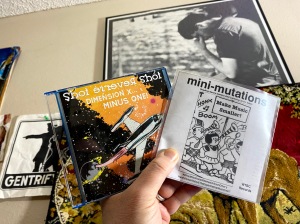 If You Host A Radio Show, WTBC Has Got You Covered.
If You Host A Radio Show, WTBC Has Got You Covered.Promotional copies of our newest releases are available now for radio personnel and podcasters to obtain, for use on your programs.
As a current DJ, and someone who has built their show largely on the kindness of other artists, I have often depended on promotional materials to help flesh out the program. Knowing that DJs can often have a deficit of money to spend on producing their shows, WTBC is offering their newest releases, or any old releases, to DJs and radio staff.
Here’s how it works: send an email to austinrich@gmail.com with information about your show or podcast. WTBC has a secret stash of promotional materials that we can e-mail or send to you, physically, so you can play them on your shows. It’s pretty simple, really, and hopefully it will help get the word out about our new endeavors.
Radio and Podcasts are the cornerstone of how we spend our time in the 21st Century, and it is important to know that our DJs and podcasters have the best possible tools to present the bests possible shows to their listeners. Just know that, in this effort, WTBC has your back.
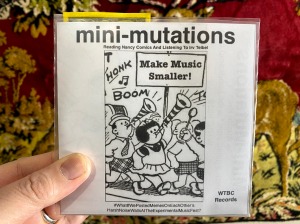
$10 From WTBC Records. Not Available Digitally! Limited Quantities On Physical Media Items! Act Fast!
There is so much in this world this is constantly vying for our attention. New TV shows. Social Media. That person in the street yelling about the Venusians who are about to invade our planet. And let’s not forget that string of local pets and animals that all want you to rescue some kid who is stuck in a rusting tractor out in Old Man Thornton’s corn field. Are you really the only one home at this hour of the day? Isn’t there a volunteer fireman nearby, somewhere?
With all of that going on, sometimes you just want to get away from it all. Maybe, for example, you want to disappear with that book of Nancy comics that you enjoy so much, and sit in a graveyard for while to read it, without the prying eyes of your neighbors trying to figure our which of the two of you prints their own money. But even in the most remote graveyards, with the world sufficiently blotted out by the sounds of nature, it would be wonderful if someone made the perfect soundtrack that you could listen to. Not too loud, of course. But just loud enough to really make the cops wonder what you’re up to.
Now, of course, there are many albums that would be perfect for this kind of listening experience, and Columbia House now has a section for this genre in their 12-CDs-For-A-Penny club this year. But, while it might not be a new, or even unique, idea to make an album meant for just such listening condition, Mini-Mutations might as well throw their hat into the ring, with their newest musical offering on CD, and not available in other formats! (Yet!)
 “Reading Nancy Comics & Listening To Irv Teibel” is the CD you need To Guide You On The Best Possible Path During Your Journey Into the 21st Century.
“Reading Nancy Comics & Listening To Irv Teibel” is the CD you need To Guide You On The Best Possible Path During Your Journey Into the 21st Century.While some albums offer only one use in your daily life, this collection of live performances and unique-to-this-disc recordings will actually serve many functions for you, and is the perfect multi-tool for these troubled times. The circular nature of the disc allows for replacement in any circumstance where a coaster, frisbee or improvised wheel is needed. In conjunction with the cover, it can also act as a windshield scraper, or as a visor in particularly sunny conditions. There are ample blank white spaces on the cover and interior, which enables you to use those surfaces for taking quick notes if you write very, very small. Fortunately, the cover is recyclable, too.
The entertainment within, however, can be used in a multitude of ways, too. Either as a guided meditation, or turn by turn instructions for that trip to visit your relatives, this disc can fulfill the essential functions of any listened audio that you might find you need to hear out in the built world. Weather it is the audio descriptions of the art at a local museum, the commentary track by a director that you know and love, or even as a new soundtrack to accompany a viewing of The Wizard of Oz, you will find that our new album can meet almost any need that you might have in this modern, bustling world.
Certainly, we also recommend that you consume the media in a traditional manner at some point, too, but when it comes to the value proposition of this material item, it is important to note that we have designed it with flexibility in mind, even if the disc itself is not actually so.
 Critics Might, Someday, Consider Raving About Some Project Tangental To This One, So You Get In On The Ground Floor, While You Still Can.
Critics Might, Someday, Consider Raving About Some Project Tangental To This One, So You Get In On The Ground Floor, While You Still Can.Your average album might come with some digital files that are easily lost or misplaced in the flotsam and jetsam that is the average computer interface. And, knowing you, you have a very particular way you like your meta-data to be encoded, anyway. This is why this album is not available digitally, to prevent this kind of problem. When you rip this disc in the comfort of your own home, you will know that we had nothing to do with the way you choose to misplace your files afterwards. And that’s a promise you can count on!
Instead of those hopelessly old-fashioned files, as if you are an .mp3 hoarder from the late 20th century, your purchase includes the following 21st Century items that you can keep as long as you remember that they are important in this fast-paced world of one century later:
YOUR PURCHASE INCLUDES:
An audio Compact Disc, which contains the audio of the brand new album by Mini-Mutations, for you to play at your neighbors when they are fighting or making love!
One New Composition, Unique To This Disc, Never Before Heard by Mortal Humans! Plus four live performances, not available to enjoy elsewhere anymore! This music is not for download. To get it, you need to own this disc!
One Black And White Cover, containing images and information that DIRECTLY RELATE to the audio on the disc!*
An information card that you can fill out, so you can join Professor Schwartzwelder’s “Mini-Mutations Civil Disobedience 101” Club!
One piece of Mutated Money, which is not legal or valid tender in the United States, but apes some of the elements thereof, including unique serial numbers so I can track your international movements at airport checkpoints!
Each album is numbered, and was Inspected by #34, the most trustworthy inspector that money can buy, ensuring the the product you have just purchased is of the highest possible quality, when it comes to experimental music from Salem, Oregon.
* We actually coordinated those elements together, in some fashion, if you can believe it.
 Supplies Are Limited! Offer Void In Wisconsin & South Carolina!
Supplies Are Limited! Offer Void In Wisconsin & South Carolina!On average, Mini-Mutations puts out no less than 12 releases a year, which makes the first one of 2021 to be an absolutely essential part of any respectable person’s record collection, if they like being respectable, that is. So why not avoid the rush after everyone has read about this on vice.com, and order your copy of this album today, before the sands of time disappear like the days of our lives…
 Available Now: The Debut Split 7″, and The Debut CD, from the New Space Grunge combo, Shot Reverse Shot!
Available Now: The Debut Split 7″, and The Debut CD, from the New Space Grunge combo, Shot Reverse Shot!Blasting out of the garage in a space-faring vehicle knocked up over the weekend by some old friends, the Space Grunge sounds of Shot Reverse Shot are now ready for you to enjoy! This is not experimental music, nor is it loud ‘n’ fast punk rock, avant jazz, or, really, like anything else WTBC Records has released. This collection of electronic rock music, programmed by the Master Control Unit and performed by a loose collection of clones, cyborgs and androids, offers a unique look at the musical story of the future we have often been denied. Now, you can pick up these new sounds from deep, deep space.
 Half Eye Limited Edition Split 7″ From WTBC Records and Gorbie Lathe Cuts!
Half Eye Limited Edition Split 7″ From WTBC Records and Gorbie Lathe Cuts!Hand-made, lathe cut 7″ record by Gorbie Lathe Cuts, available in stunning white, offering the first music on 7″ by either Half Eye or Shot Reverse Shot! Covers printed by Salem Printing & Blueprint company. This package was hand-cut, folded, glued and assembled in Salem, OR, and contains an assortment of wonderful goodies, including: a download code for the B-Side to the Half Eye tune, a thrilling number called “Sex Bender”; a limited-edition mini-zine only available here, titled “Mirrors,” created by Matt Orefice & Austin Rich; and, the “Seven Bound Beacon EP,” a short digital release by Shot Reverse Shot that can only be accessed through this record. There’s only a handful of these that were made, so get yours today!
$12, Shipping Included in the US. Not available digitally! Limited quantity! Order today!
 Dimension X… Minus One! The Debut Album from Shot Reverse Shot.
Dimension X… Minus One! The Debut Album from Shot Reverse Shot.Are you ready to bring Old Time Radio to your 21st Century Stereo? This album contains 15 tunes by the newly assembled rock ensemble, Shot Reverse Shot! Futuristic Electronic Space Grunge for you to enjoy, today! But this isn’t just a simple musical album that you put on to enjoy while washing the dishes in your native pod or craft. This professionally duplicated disc is a 50 minute journey with the crew of the Starship Hyperion, as they travel beyond The Furthest Stars, into emotions and places that people have never had to visit before!
 Produced by Austin Rich in Quarantine, this album is not available digitally! If you want to hear these songs, they are only available on these CDs, provided by kunaki.com, and in limited quantities, too! Packaged with the album is a code for access to the, “Don’t Count The Suns EP,” exclusively available with this release.
Produced by Austin Rich in Quarantine, this album is not available digitally! If you want to hear these songs, they are only available on these CDs, provided by kunaki.com, and in limited quantities, too! Packaged with the album is a code for access to the, “Don’t Count The Suns EP,” exclusively available with this release.
$12, Shipping Included in the US. Don’t miss out on this unique musical release! Not available digitally!
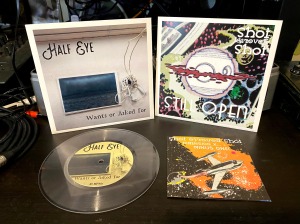 Limited Edition CD / 7″ Set!
Limited Edition CD / 7″ Set!While preparing the 7″ and CD releases for Shot Reverse Shot, we discovered that our supply chain could offer unique items from other timelines. While we could only get a few, we managed to procure a very small number of the 7″ on clear lathes, with different labels! This 7″ comes with a re-packaged version of the debut CD, professionally duplicated, and is the perfect starter pack for the person who is interested in booking first-class tickets with Shot Reverse Shot. These are very handsome looking records and discs, so they will go fast.
$20, Shipping Included in the US. Supplies are Limited!
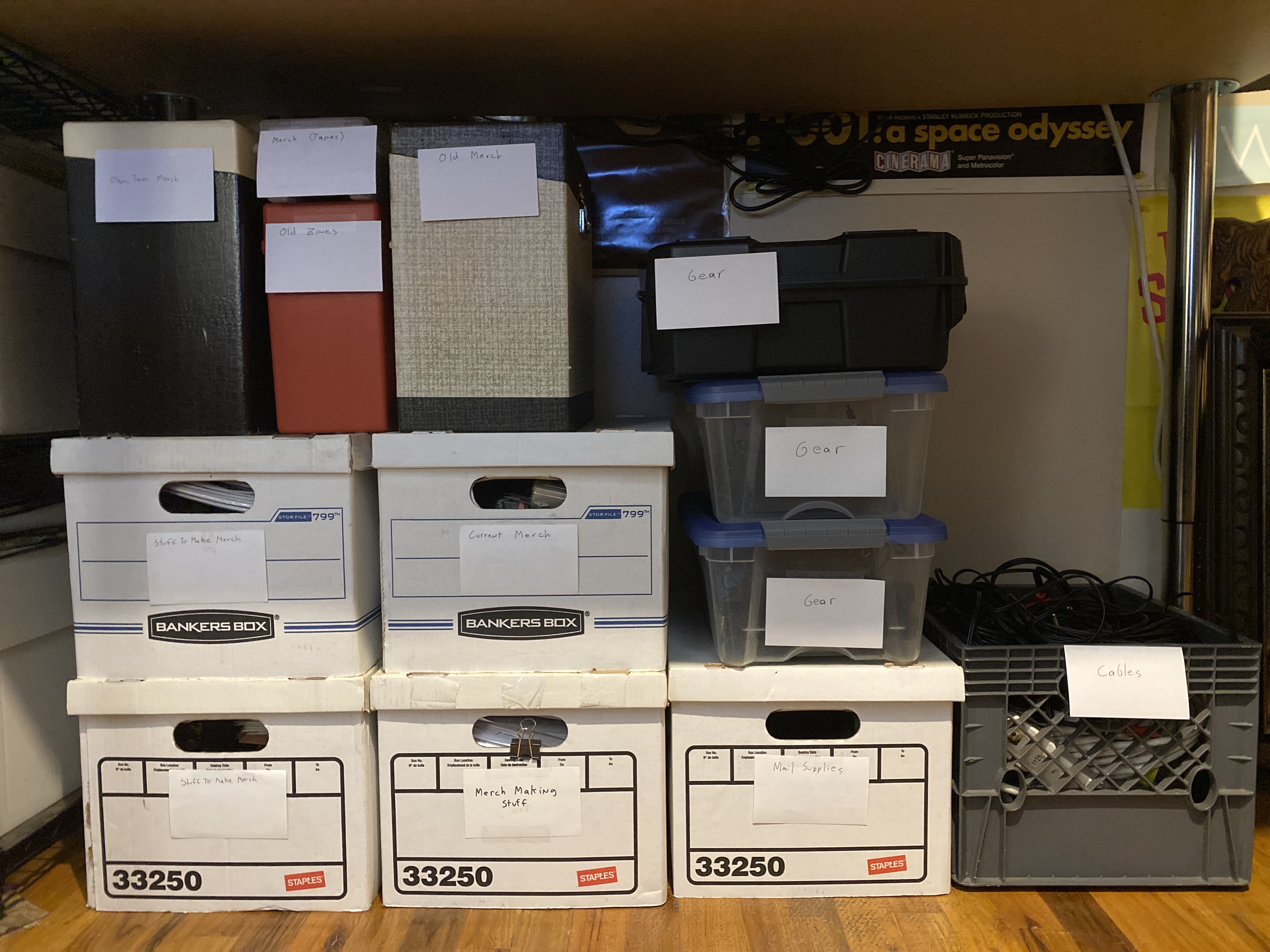 This has been a disaster for a while. So getting this sorted and labeling the boxes feels like a big win.
This has been a disaster for a while. So getting this sorted and labeling the boxes feels like a big win.

Nearly half of that table contains gear that was donated to The Lava Lamp Lounge by kiisu d’salyss of The Secret Light. My studio monitors are the ones the used for mixing their first record. Hopefully I can do good work with them here.
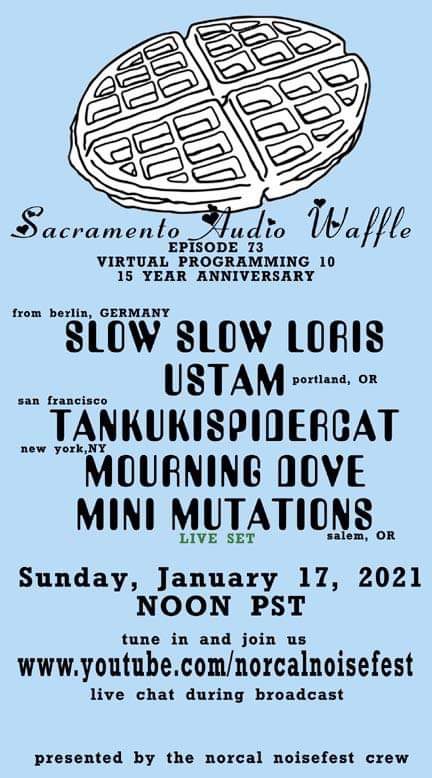 I should probably clean my table.
I should probably clean my table.
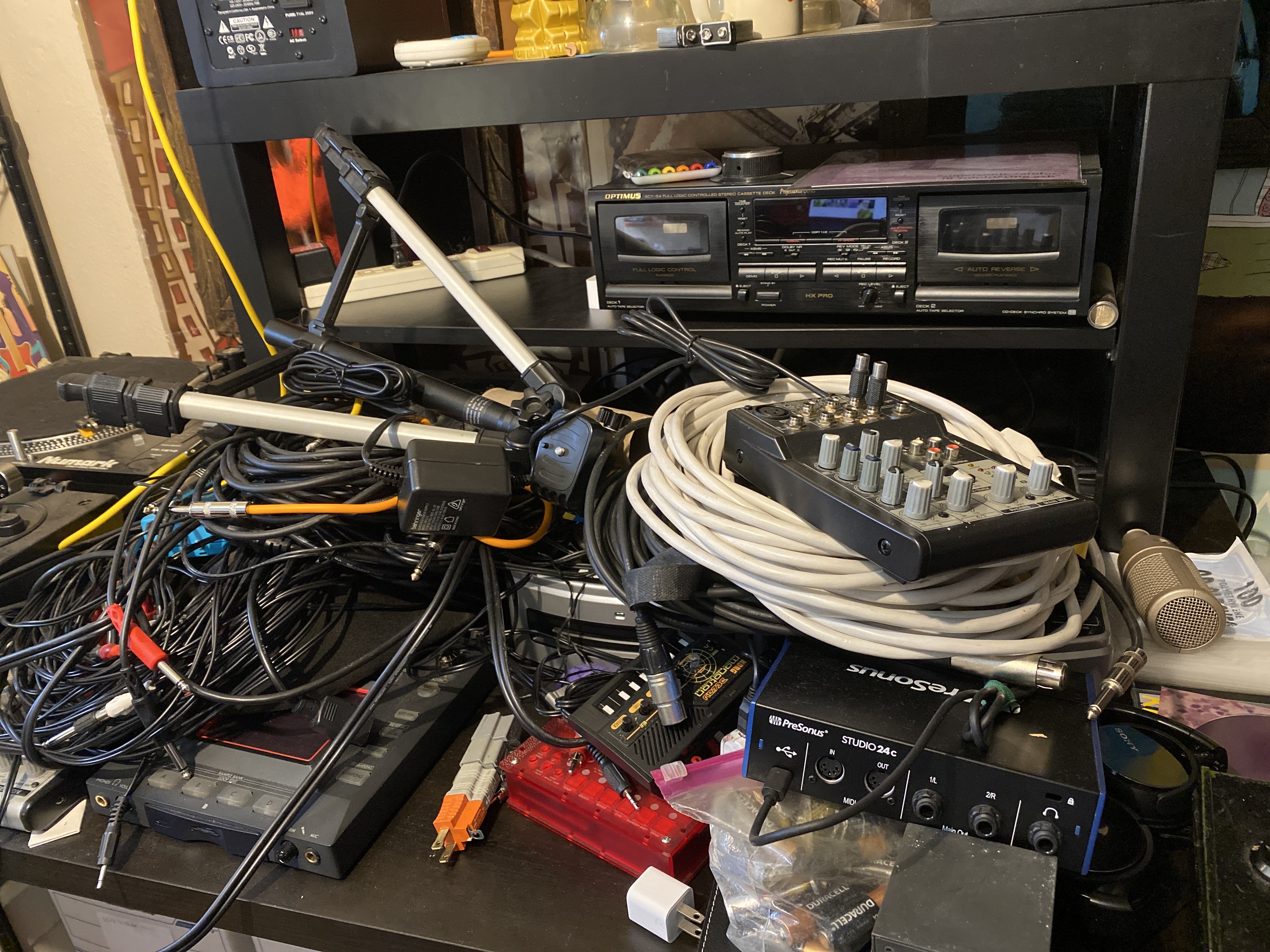
Well, let’s see how long I can stand the quiet.
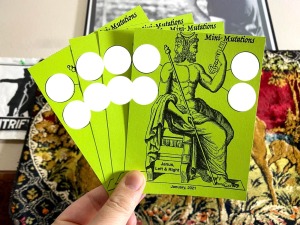 Dropping into the mail today are the January 2021 Musical Postcards, the first of this year! We test-drove this idea last month, to great success, and we are going to do this again, every month this year.
Dropping into the mail today are the January 2021 Musical Postcards, the first of this year! We test-drove this idea last month, to great success, and we are going to do this again, every month this year.
If you are are on the mailing list: you will get one. If you would like to join the mailing list, here’s the page for doing that.
Over 30 minutes of new, original music by Mini-Mutations, only available on this postcard. It looks pretty snappy, so I would love to send one to you.
And now that I’m not really on FB these days, this might be a good way to keep in touch.
Let’s send some mail!

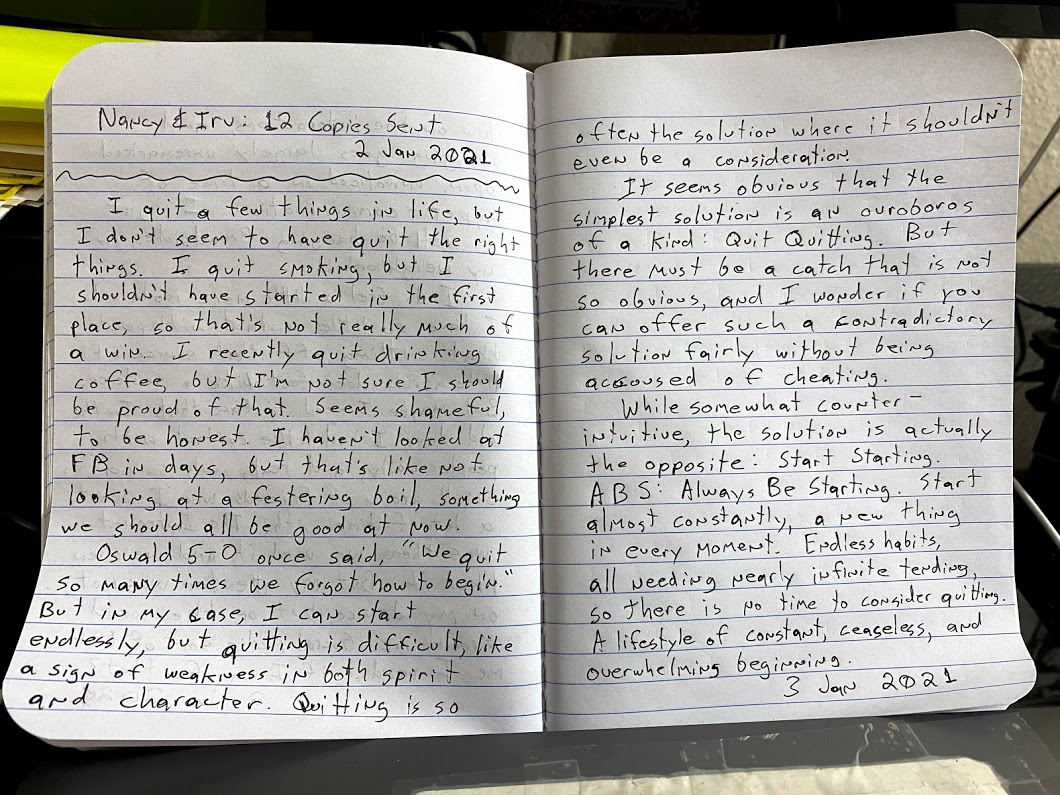
I’m probably going to take a long-ish break from FB, for personal reasons. But I miss you all. Let’s have a phone call, soon?
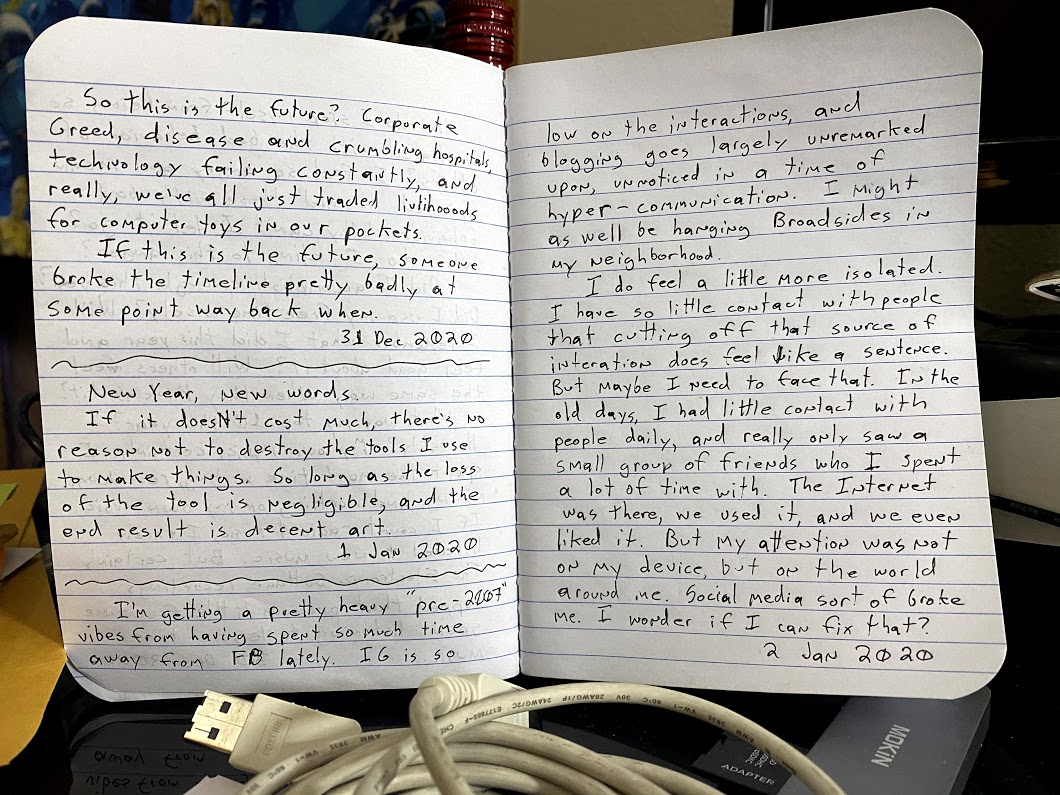
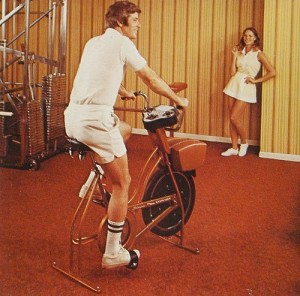 I spent a lot of time in December on the Exercise Bike. Here’s the breakdown:
I spent a lot of time in December on the Exercise Bike. Here’s the breakdown:
I averaged 27.7 MPH while on the bike in December.
I burned a total of 12,046.1 Calories. (About 24 Hamburgers.)
I cycled a total distance of 328.03 miles in December. That’s almost to the southwestern part of our state, where California, Oregon and Nevada all sort of meet up.
I updated my spreadsheet, too, as I realized I would like a running total that doesn’t require scrolling back through all the old data.
Happy New Year.
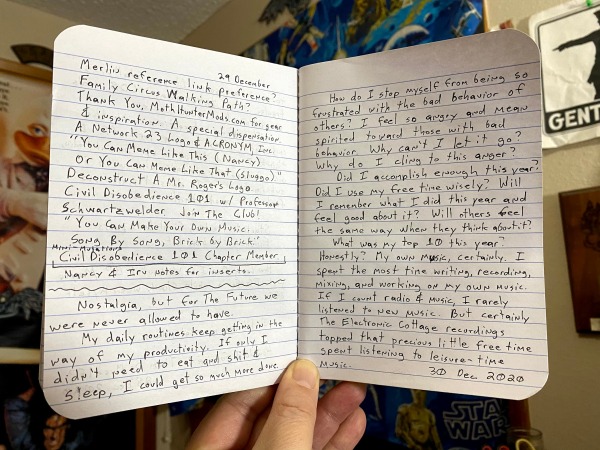

Join us for a YouTube Premier! The last Mini-Mutations Performance of 2020!
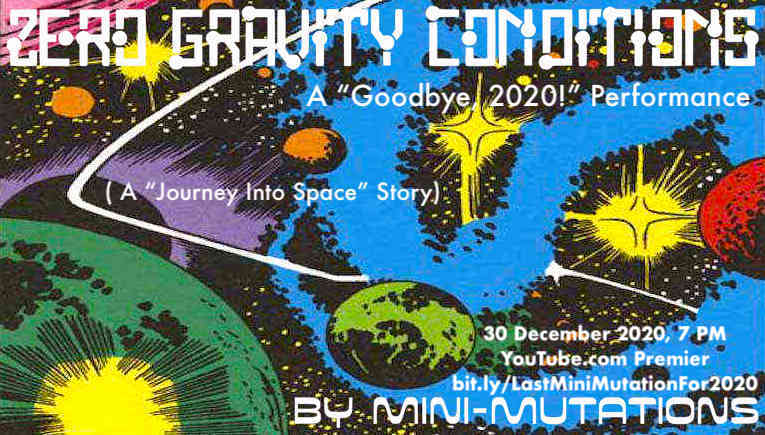
 Well, the Santa Ana Noise Fest last night was a blast, and there was a fairly decent turnout, considering all the technical difficulties that we were plagued with. But, in the end, it all worked out, and you can now watch the entire thing at your leisure. There was over four hours of content, all told, and the line-up was international. It was nice to make new Music Friends, and the chat was pretty lively. So, congratulations, Santa Ana Noise Fest. Maybe I’ll get to visit you in person, someday.
Well, the Santa Ana Noise Fest last night was a blast, and there was a fairly decent turnout, considering all the technical difficulties that we were plagued with. But, in the end, it all worked out, and you can now watch the entire thing at your leisure. There was over four hours of content, all told, and the line-up was international. It was nice to make new Music Friends, and the chat was pretty lively. So, congratulations, Santa Ana Noise Fest. Maybe I’ll get to visit you in person, someday.
 This year, I decided to go a little holiday themed, and revived an old TV Program I used to be involved, with, “Cleaning Up After Snoop & Martha,” where I clean up after they bake something in the kitchen. For some reason, the show was not a hit, as they were never on the program. But sometimes the show offered practical advice, and in this episode, I offer a recipe for Perfect Mini-Mutations, which is the right kind of thing you’ll want to be baking between now and New Year’s Day.
This year, I decided to go a little holiday themed, and revived an old TV Program I used to be involved, with, “Cleaning Up After Snoop & Martha,” where I clean up after they bake something in the kitchen. For some reason, the show was not a hit, as they were never on the program. But sometimes the show offered practical advice, and in this episode, I offer a recipe for Perfect Mini-Mutations, which is the right kind of thing you’ll want to be baking between now and New Year’s Day.
The first two minutes and five seconds of this video are interstitial bits from the live stream, that relate to the show. (Same with the last 1:23 of the video.) It gives it all context for how it was seen on the live stream.
If you want to watch the entire live stream, here are the links. In the first video, there is about 30 minutes of “pre-game” looping videos, and Mark butts in once to talk about the history of experimental music. The bulk of the show is in the second video.
Thanks again, everyone! It was a ton of fun, and I can’t wait to do it again.
 It is so much more complicated than Deja Vu, and yet the sensation certainly lives within the realm of similar experiences. But only Borges* himself managed to relate this experience in a way that I feel addressed it with any sense or value. At least, he artfully articulated the experience, no less than three times in his own written work.
It is so much more complicated than Deja Vu, and yet the sensation certainly lives within the realm of similar experiences. But only Borges* himself managed to relate this experience in a way that I feel addressed it with any sense or value. At least, he artfully articulated the experience, no less than three times in his own written work.
I, myself, have been compelled to explore the concept as ineptly as I was able over 10 years ago, and while I certainly wore my influences in my prose, I know that I was no closer to having nailed down the moment, this experience in any useful way. Perhaps the closest I came was making another appearance on UB Radio Salon, where I read both my own ham-fisted attempts at this concept between the three more elegant efforts by Borges himself.
But an inability to express this experience does not prevent it from happening. As I catch these glimpses of the person I once was, I cannot rationalize how they would react to me without eventually landing on some kind of disappointment. I see the posturing arrogance of the person I was, as seen through a random blog post, an old photograph, or even a simple memory of having done something, and I know that person would never give me the time of day.
I try to live within the musings of my past self, and I find the experience uncomfortable the words don’t fit, and I worry that the person I was is the person I’m be judged for, that his crimes are the ones that I will be left doing the time for. I see all of his nonsense, and wonder how transparent I’ve always been. How just on the edge of bullshit every utterance was. All the grand plans were made up along the way, and I know what folly that youth would soon go through.
Can we ever learn to live with who we used to be?
Will I look back on these words with a grim moment of pain, as I realize how boneheaded I sound, now?
Or will I be a worse person, then?
* * * * * *
It’s to that other one, to Borges, that things happen. I walk through Buenos Aires and I pause, one could say mechanically, to gaze at a vestibule’s arch and its inner door; of Borges I receive news in the mail and I see his name in a list of professors or in some biographical dictionary. I like hourglasses, maps, eighteenth-century typefaces, etymologies, the taste of coffee and the prose of Stevenson; the other shares these preferences, but in a vain kind of way that turns them into an actor’s attributes. It would be an exaggeration to claim that our relationship is hostile; I live, I let myself live so that Borges may write his literature, and this literature justifies me. It poses no great difficulty for me to admit that he has put together some decent passages, yet these passages cannot save me, perhaps because whatsoever is good does not belong to anyone, not even to the other, but to language and tradition. In any case, I am destined to lose all that I am, definitively, and only fleeting moments of myself will be able to live on in the other. Little by little, I continue ceding to him everything, even though I am aware of his perverse tendency to falsify and magnify.
Spinoza understood that all things strive to persevere being; the stone wishes to be eternally a stone and the tiger a tiger. I will endure in Borges, not in myself (if it is that I am someone), but I recognise myself less in his books than in those of many others, or in the well-worn strum of a guitar. Years ago I tried to free myself from him by moving on from the mythologies of the slums to games with time and infinity, but those games are now Borges’ and I will have to conceive of other things. Thus my life is a running away and I lose everything and everything is turned over to oblivion, or to the other.
I do not know which of the two is writing this piece.
 I keep asking myself, day after day:
I keep asking myself, day after day:
Why do you stay on Facebook, when you know so much about how awful it is?
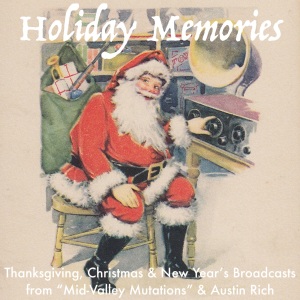
For many years I tended to ignore the simple pleasures of the holidays, and as my radio show became more singular, I resisted the holiday season, often openly mocking it (with shows like, “Christmas Music For People Who Don’t Like Christmas Music,” etc.).
But even someone like me, who has come to enjoy radio at it’s most unusual or atypical, there is a certain appeal to finding the place between “typical holiday music” and “what I usually do on this program.” And with Old Time Radio, punk rock holiday albums, experimental live radio and performances, and everything in-between, I have been fortunate enough over the years to avoid, “Here’s some Christmas Carols for you to enjoy this year.” The closest I come to that is putting on detective radio shows for the holidays.
Regardless, there are over 20 years of Holiday Programs in our “Holiday Memories” Podcast feed, waiting for you to enjoy. This includes broadcasts on a number of stations, in a number of forms, with a wide range of holiday offerings for you to put on and digest. Over 100 hours of programing, with over 80 different shows to choose from. This year, we’re adding some new items to the feed, including some holiday episodes of Somewhere In-Between: A Radio ‘Zine that are new this year, and a handful of new Mid-Valley Mutations, where we feature a Hal McGee holiday album, cut up some amazing Old Time Radio stories, offer some futuristic Christmas Carols, and a full episode-long holiday deconstruction by Mini-Mutations. We’re pulling out all the stops this year, and we would love to have you come and join us, too.
The easiest way to get it is to subscribe with our App-Agnostic-Feed, where you can get all the goodies. But you can also find it in iTunes. (I’ve heard it is in other services too, but I haven’t put that to the test.) Just search for “Holiday Memories Austin Rich,” and it usually comes up pretty quickly.
The Holiday Feed contains everything from all the end-of-year holidays from November through January, so if you want individual episodes for separate holidays, here are all the Christmas Shows, and here are all the New Year’s shows.
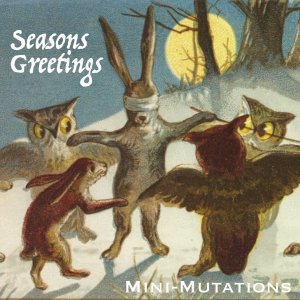 If you would prefer a little music that has a seasonal flavor to it, then you might want to look into our “Seasons Greetings” digital album, perfect for the kind of person who enjoys the holiday season, but wants their music very, very weird. Almost 2 1/2 hours of Mini-Mutations not available elsewhere, with over an hour of bonus instrumental tracks. This includes live radio jams, live performances in front of audiences, spoken word with sound FX, everything in-between. This one is only available digitally, so head to our Wanting To Be Cool online store via bandcamp, and enjoy some new tunes that speak to this time of year.
If you would prefer a little music that has a seasonal flavor to it, then you might want to look into our “Seasons Greetings” digital album, perfect for the kind of person who enjoys the holiday season, but wants their music very, very weird. Almost 2 1/2 hours of Mini-Mutations not available elsewhere, with over an hour of bonus instrumental tracks. This includes live radio jams, live performances in front of audiences, spoken word with sound FX, everything in-between. This one is only available digitally, so head to our Wanting To Be Cool online store via bandcamp, and enjoy some new tunes that speak to this time of year.
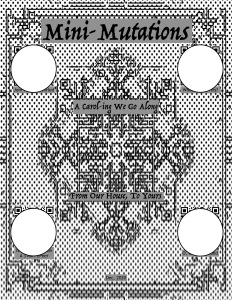 And, if that’s not enough, we have, hew this year, the Mini-Mutations Musical Holiday Card, with an EP of new Holiday Carols that you can only get via the mail. This is part of a monthly Postcard Project that I’m working on in 2021, and if you want to start getting these, then you’ll want to contact me with your address. There will be one-of-a-kind music offerings through these postcards, that only come via the mail. Support the US Postal Service, and small experimental artists, and get something cool in the mail.
And, if that’s not enough, we have, hew this year, the Mini-Mutations Musical Holiday Card, with an EP of new Holiday Carols that you can only get via the mail. This is part of a monthly Postcard Project that I’m working on in 2021, and if you want to start getting these, then you’ll want to contact me with your address. There will be one-of-a-kind music offerings through these postcards, that only come via the mail. Support the US Postal Service, and small experimental artists, and get something cool in the mail.
While this year has been a bummer, and it is hard to get into the holidays, maybe our atypical traditions will be the perfect antidote to the holiday malaise.
 The Santa Ana Noise fest is just around the corner, and as usual, everything is different this year. This includes being entirely online, which means that we all had to make videos, and that some of the “live” elements of our performances are “taped” so we can actually pull this off.
The Santa Ana Noise fest is just around the corner, and as usual, everything is different this year. This includes being entirely online, which means that we all had to make videos, and that some of the “live” elements of our performances are “taped” so we can actually pull this off.
The long and the short of it is: this will be one of the last shows that Mini-Mutations will be playing this year, and I’m excited about the line-up, the show, and everything about it. And: it will be the perfect way to celebrate that lethargic feeling that sets in after Christmas and until after New Year’s.
Show starts at 7 PM, and will be live streaming from This FB Event Page. Sets are short, so if you are late, you might miss a few acts. I’ll be in the chat all night, so drop in, and check it out.
Here’s a little promo for the event. On the event page, it says I’m in the second set, so that probably means I’ll be on before nine, PST. For this set, I’ve revived my “Cooking w/ Mini-Mutations” television program, where I offer some instructions on how to make Perfect Mini-Mutations for then Holidays. This should be a lot of fun, and I hope you get a chance to drop in for the live show.
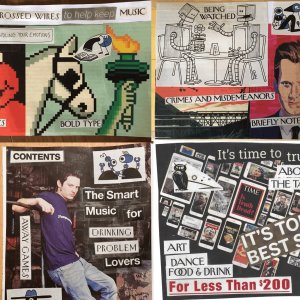 For a while now I’ve been experimenting with mail art. I used to do this a little bit in the 90’s, but never very often, or with much consistency. That didn’t really change for most of my life, but in the last few years I’ve been getting much more into it, and have been trying – when time allows – to stay on top of it as much as possible.
For a while now I’ve been experimenting with mail art. I used to do this a little bit in the 90’s, but never very often, or with much consistency. That didn’t really change for most of my life, but in the last few years I’ve been getting much more into it, and have been trying – when time allows – to stay on top of it as much as possible.
To that end, this year I’m engaging in seasonal, musical postcards. 12, in fact; one each month. To get a sense of how to do it, and what the process would be, I have a postcard made and ready for December of 2020, too. The first batch of cards, for mailing list members, go out today.
If you would like to get on the mailing list, and receive a musical postcard with 30 minutes of new audio material, all via the mail, then contact me via e-mail and mention this in your message. There’s only so many of these, so if you want one, you should say so, soon.
Curious about the Postcards Project? This link should help answer your questions.
Really, this is just a good way to get more engaged with the mail. And for that reason alone, this will be a lot of fun.
 As it stands, the real job ahead of us in 2021 in convincing our family members that they need to get on board with some much more progressive politics than any of them think they are willing to allow. Because, every single one of those people who voted for and are aligned with a more fascist interpretation of America are someone’s family.
As it stands, the real job ahead of us in 2021 in convincing our family members that they need to get on board with some much more progressive politics than any of them think they are willing to allow. Because, every single one of those people who voted for and are aligned with a more fascist interpretation of America are someone’s family.
So: how do we get our family members to improve points of view that are truly distasteful?
 Over the last 12 Days, I’ve cycled 156 miles.
Over the last 12 Days, I’ve cycled 156 miles.
That’s all the way to Winchester Bay from here.
Anyone know if the lighthouse is open?
The 11th is like the 1st of the month, but it’s doubled down.
Like: No, really. The month has STARTED, fool.
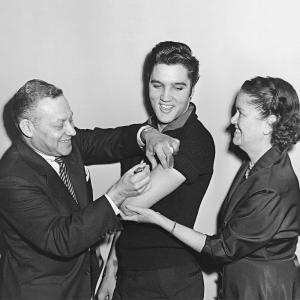 In 1954, Polio was still a big problem. A Vaccine had been developed, but no one wanted to take it, unless their doctor directly recommended it and explained the reasons for needing it to you, in person. That wasn’t going to be enough to get everyone on board, and so while there was a cure on-hand, getting Americans on board was the problem. Educating people about getting the Polio Vaccination was slow work, and Americans are a cowardly, superstitious lot. And how do you reach all people in all classes? Literacy is still an issue, and for many, it was easy to refuse the vaccine, even if it was easy to get.
In 1954, Polio was still a big problem. A Vaccine had been developed, but no one wanted to take it, unless their doctor directly recommended it and explained the reasons for needing it to you, in person. That wasn’t going to be enough to get everyone on board, and so while there was a cure on-hand, getting Americans on board was the problem. Educating people about getting the Polio Vaccination was slow work, and Americans are a cowardly, superstitious lot. And how do you reach all people in all classes? Literacy is still an issue, and for many, it was easy to refuse the vaccine, even if it was easy to get.
After two years of struggling to solve this problem, they hit upon an idea: Let’s get Elvis Presley, one of the most popular rock musicians at the time, to help promote the idea of vaccination. Elvis is then vaccinated on The Ed Sullivan Show in 1956, which is seen by millions of people, and is accompanied by some clear Public Health Data. This event was reported on widely, so even if you didn’t have a TV, it was that generation’s, “Shot heard round the world.”
According to many historians, that single TV appearance alone accounted for nearly 80% of the population getting vaccinated, something that was unheard of before. By 1963, it had been announced that the number of Polio cases had dropped to zero, which is truly astonishing, when you consider that nearly a decade previously, it was nearly impossible to imagine any way that could ever happen.
The power of celebrity, indeed.
I’ve been thinking about the kinds of celebrities now, that could have that same kind of juice, and could get that many American’s on board with a massive vaccination effort. Clearly, Americans can’t really think for themselves, and need a trusted celebrity, who is loved across parties and across economic backgrounds, and at this point, across generations. Presidents are too divisive, and this issue is so politicized that, like with the Polio Vaccine, the appeal of the celebrity has to be so universal that people of different opposing religions will still stand six feet apart from each other in the same line just to get the vaccine, and that’s a pretty tall order.
Universally Loved? In 2020? Wouldn’t that be Pikachu, or an Animal Crossing character?
 This is something very pleasant, and unexpected, that I only just heard about, and that I find very exciting.
This is something very pleasant, and unexpected, that I only just heard about, and that I find very exciting.
I was recently name checked in an interview by Cian Orbe Netlabel (a Netlabel from Rancagua, Chile), with Serbian experimental artist LEZET. What a wonderfully strange, international confluence of events. And, fortunately, you can read the entire interview, in English, here: Interview with LEZET (6 December 2020).
So, dig this big crux: one of the strange up-shots of the pandemic has been the simultaneous isolation of a number of artists, all over the world. So through mutual friends we each have in Hal McGee (and his “Electronic Cottage” group online), we were both recruited to work on a compilation produced by {AN} EeL, which featured a wide range of artists being paired off to create work together. The results are “Two Halves Vol. 7,” which features 18 tracks by 36 different artists, all producing collaborative tracks. For this project, {AN} EeL paired myself and LEZET, who I was unfamiliar with at the time. But, in working on this track, and then through being more aware of their work through {AN} EeL and Hal, I’ve become quite fond of LEZET’s work.
The track we produced together is called, “Riverside Hop Scotch Game,” and you can hear it here:
It was incredibly easy working with LEZET. They mailed me some recordings, without much conversation about what to do with them, or how we wanted to work. We had initially discussed the possibility of LEZET following the muse, and having me coming in to flesh out the track afterwards, but it’s hard to recall that conversation exactly. What I do remember is that when I received the tracks, I immediately heard where my accompaniment would fit in, and very quickly we had a finished tune.
We submitted the track, and I didn’t think much more about that specific song until the comp came out. And it was very cool, not only to find that our track was very early in the running order, but that the entire collection was very, very cool. (I’ve included the entire thing below.
I would have thought that would be the end of it. We both had other projects, and while I was following LEZET’s work with interest, I didn’t imagine I’d get mentioned in an interview like this.
In the question, “Which are your favorite music projects who inspire your work?” Mini-Mutations gets a mention, along with a whole mess of other great artists, too. I feel like I’m in very good company on that list, and I’m sort of nervous about having to live up to the quality of the other artists on this list.
I did a lot of collaborations this year, and in a way, the album I did sort of got lots in the shuffle, as it was packaged with a zine. Between that and other non-musical projects, this has been a very a-typical year for both myself and Mini-Mutations. But it is very inspiring to know that people like LEZET are enjoying the journey, as we both feel out what to do in the coming year.
2020 has been wild, yo.

I’ve been curious about the Santa Ana Noise Fest for quite some time, but the timing has always been bad for me to attend. This has been the annual problem with attending the Olympia Experimental Music Fest, in that the timing of the show is nearly always around my anniversary, which makes it very difficult to attend. NorCal NoiseFest is probably the one that is perfectly timed for my natural travel rhythms every year, though I had intended to make more trips in 2020, before Covid, that is.
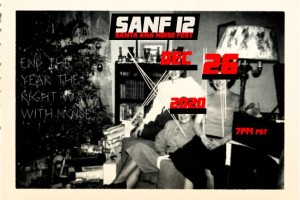 Anyway: this year, they have gone entirely digital, and that has not only made it possible for me to attend, but has really opened the roster up in a way that has allowed 17 acts spread out over five countries to perform, all in one evening. In fact, speaking of the line-up: damn! An impressive run of folks from a number of flavors of experimental music, and considering the date, I have revived one of the more well-loved things I have done for live shows: Cooking with Mini-Mutations. I think you will enjoy what I have etc’d for you this time. (Content note: this is a pre-recorded video, unlike my other recent live streaming things, which have been live. I will be in the chat live, but the video is not exactly live. You’ll see what I mean on the 26th.)
Anyway: this year, they have gone entirely digital, and that has not only made it possible for me to attend, but has really opened the roster up in a way that has allowed 17 acts spread out over five countries to perform, all in one evening. In fact, speaking of the line-up: damn! An impressive run of folks from a number of flavors of experimental music, and considering the date, I have revived one of the more well-loved things I have done for live shows: Cooking with Mini-Mutations. I think you will enjoy what I have etc’d for you this time. (Content note: this is a pre-recorded video, unlike my other recent live streaming things, which have been live. I will be in the chat live, but the video is not exactly live. You’ll see what I mean on the 26th.)
I’m really looking forward to this. There’s a number of acts I am completely unfamiliar with, and a number that I really enjoy, and it should prove to be a fun way to spend the night. This will be the first thing on Twitch that I have been involved with, so that will be fun, too. I hope to see you in the chat! It’s nice to have music things to look forward to.

 Beginnings are easy. Everything is open to you, nothing has been decided, and you can make anything possible.
Beginnings are easy. Everything is open to you, nothing has been decided, and you can make anything possible.
Endings can be dramatic, if done well, and they should be easy if all the art work is done. They should snap into place, and sort of feel like they follow from the beginning and the rest.
It’s the middle part that is the hardest, in all things, because it is there where the hard work has to be done.
We seem to be in a very strange place right now, where we are in transition, while we wait for reality to adjust itself to the new way our world, and our country, will be in the future. But we are far from there, yet. And getting there will be very difficult, and most likely, not easy. We aren’t in any places or phases where things will be easy, for a while.
We’ve been manipulated and had our desires toyed with, and now we are on the other side of something, but what, exactly, is hard to say. The problems of most people were not solved with a new president, and might not even be solved by having the pandemic handled in a way that matters. It turns out that mosts problems revolve around having to have a job, make money, and pay bills, and that pandemics and poor presidents only exacerbate those issues.
Further to the point, our communities are rules by laws that are inequitable, and enforced by government approved militias, and that does not rest easy for those of us who have ben subject to the horrors of those laws and enforcers. A new president and a vaccine does not change the systemic problems that are the thrust of this “middle section” of the story, and is why it will be the most difficult part of the entire ordeal.
There’s so much work to be done, even with a new president who will already make things slightly better than they were before. (If you don’t see that there will be slight improvements under the new president, then I think you might not actually be a progressive person in any useful way.) But to get to the end of the story, the dramatic moment when we repair our government and make the world more equitable for the largest number of people, we are anywhere but near the end.
We are only really barely past the beginning. We are in uncharted territory, where we don’t have a compass, and we don’t know how to get to the end we want, let alone the end we need.
We are currently lost, and the feeling is starting to mount that we could be lost for a very, very… VERY long time, before we find anything that could lead us to somewhere safe.
I hate reading the news. I hate trying to figure out what all the latest information means. And I hate the mounting evidence that the half of this country that feels burned by this election are going to go out of their way to make everything worse for all of us. For them, the story is only just beginning, too.
But what I do feel, more than anything, is that it is time for me to double down. It’s time to find new reserves of determination that I didn’t know I had, and figure out how the things that I do can actually make a difference.
And since I’m still in the middle, it is gonna be hard figuring that stuff out.
For a while, anyway.
 I fell down on the job, so to speak, with my goal of writing at least 1000 words a day, as I didn’t get a chance to sit down and write at all the last two days.
I fell down on the job, so to speak, with my goal of writing at least 1000 words a day, as I didn’t get a chance to sit down and write at all the last two days.
Or, rather, I did, but in different ways. On Saturday I wrote about 100 words in Social media posts, as I was busy most of the day working on another project that I only just completed this morning. Then, on Sunday, I was busy working on a couple other things, and while I did actually end up writing about 1300 words yesterday, it was actually for “work,” and not extra. (I actually wrote some bits for a video, which will be seen soon enough.)
I find it interesting that in two days I still managed to write 1400-ish words anyway, mostly though Social Media and a handful of other projects that require a little writing to go with them. This is something I’ve been thinking about a lot lately; even if you aren’t trying to write, you often end up writing anyway, regardless of your real intention. This is largely a function of our modern lives. Texting and e-mail are very easy and very useful, and can communicate more nuance than in a quick exchange. And, it allows you to gather your thoughts visually, and sort them into different paragraphs, depending on their relative connections to each other.
I certainly blew it today, as the days I have been the most successful in writing at all are days that I write in the morning, and that seems significant. I can already tell I won’t write as much today as I did yesterday. But I was also doing a number of other, non-writing things. There’s only so many hours in the day.
Still, over the last week, I’ve written almost 7000 words, and that’s not a terrible average, even if today sort of throws that out of wack again. I suspect that even professionals have days where they can’t really get much done, and I shouldn’t focus too much on what I haven’t done, but instead on what I have finished.
Plus: I think I need a new metric, because what if I spend a day editing video? That’s certainly creative work, that I am doing to scratch a different part of my brain. But, if that’s the case, how much video editing is equal to 1000 words? How much of a song is equal to 1000 words? How many photographs, or ideas for comic strips, are equal to 1000 words?
What is the equivalent form of a “writing sprint” in other creative forms? Can they even be compared?
 The first time my parents brought home a VCR that they had rented from a local shop, the also brought home the movie Romancing The Stone. That sentence is so quintessentially mid-80’s that in my memory we are all wearing spandex, Magnum PI t-shirts, and each of us sporting a single glove and / or a Madonna-esque fashion hat while we watched the movie. But that was probably not the case, either. What I do remember was that they probably rented other movies along with that new-to-us VCR, but the only one I remember 30+ years later is Romancing The Stone.
The first time my parents brought home a VCR that they had rented from a local shop, the also brought home the movie Romancing The Stone. That sentence is so quintessentially mid-80’s that in my memory we are all wearing spandex, Magnum PI t-shirts, and each of us sporting a single glove and / or a Madonna-esque fashion hat while we watched the movie. But that was probably not the case, either. What I do remember was that they probably rented other movies along with that new-to-us VCR, but the only one I remember 30+ years later is Romancing The Stone.
A friend of mine recently said that they had watched it for the first time this year, and hated it, and a part of me suddenly got curious about what didn’t hold up. As a youth, I probably saw this and the sequel a number of times, and my love of Raiders of The Lost Ark sort of embedded in me a love of adventure / treasure hunting stories, that certainly caused me to sit up and take notice of this one. And, at 12, this glimpse into the world of adult relationships in an International setting really appealed to this small town Oregon Boy, where it was so completely foreign to me. I was immediately enamored with all of it, and found there to be a lot in the film that puzzled me, as I tried to understand why these two were falling in love with each other at a time when I was only dimly aware of what it meant to fall in love at all.
It is true, with 2020 eyes, this movie is problematic, a sort of cringey time-capsule, where this document somehow manages to make the mighty Kathleen Turner seem like she is out-of-her element, and needed the help of a man to make it through this horrible experience. There’s some fairly weird scenes that border on the strangeness of the “Ghost Blow Job” from Ghostbusters, which serves no function except to have a racy moment on screen with our leads. It certainly has so much 80’s running through it that, in spite of first-hand memories of the movies, I have to remind myself that it is actually a nearly 40 year old film.
I keep considering the words of Joe Dante himself, who recently has said (in a number of different ways) that every movie ever made needs a warning label on it, that says, “Warning: This Movie Was Made Before Today.” Every film embodies the taboos and mores of a particular time / place / point of view embodied by the creators at that time, and while it isn’t an endorsement or even an attempt to say, “Well, it was just like that, then,” what both he and I am saying is that in 1984, choices were made by people who were thinking to themselves, “What’s going to look good on screen?” rather than wondering for example, “How woke does this movie appear to audiences?”
The film itself is, in many ways, is probably more progressive than a lot of the fare that was being made in 1984, and certainly was one of the few films being made at the time that was written by a woman. As a kid, I think I only really responded to the treasure hunt elements of the movie, which I think is entirely conveyed by the fact that, before this week, the part of this movie I remembered the best is the 15 minute segment where Joan & Jack decide to use the map to find The Stone, which they do find fairly quickly. After which, the movie goes back to where it had been before, with the various romance and kidnapping subplots driving the remainder of the story.
In a way, the movie is a sort of patchwork of different soap-opera style subplots, and in the same way that a lot of soaps all have soap stars as characters in their shows, Romancing The Stone features a romance author getting embroiled in a story that is lifted precisely from her books, so much so that the characters all know her stories and tropes well, and the plot begins to bend toward things she’s seen in her novels before. Even the Stone itself is hidden in a way that is directly lifted from her first novel.
This element of the film isn’t really commented on, but the movie is framed by Joan and her editor reviewing a recently completed novel, and the one at the end is meant to imply that it is the story we have just seen on screen. This frame story suggests that, perhaps, in a sort of Total Recall sort of way, that some – all? – of her experiences in Columbia might be in her head.
Or, perhaps, in the parlance of a different Arnold action flick, she has entered one of her own romance novels? The kidnapping subplot is the pretext to get Joan to Columbia, but Joan’s sister is rarely seen (or heard), and most of what happens has little to do with the kidnapping, and more to do with the map, and The Stone. All three serve as McGuffins, and are only secondary to the primary plot. The film is really about how the people who are all searching for The Stone manage to bring Joan and Jack together by accident, in the fashion of a true romance, like the kinds that Joan writes and Columbian drug lords seem to love.
From the moment Joan gets to Columbia, every experience is something pulled from the kinds of adventure romances that she writes, which is very interesting for a couple of reasons. In the 1980s, one of the few genres of storytelling where women did have any real agency was in a Romance novel. In a romance, a woman can be the lead, and her concerns and interests (and desires) are allowed to be manifest, in whatever way she wants. While these stories are predicated on the idea that you need a man to complete yourself, everything prior to the pairing of the couple at the very end is about revealing how independent the protagonist really is.
She lives alone, fighting off the street vendors every day, a fairly savvy city dweller. Then, Joan gets on a plane and goes to Columbia by herself, a trip she has never done before. She manages to handle herself fairly well, considering a strange thug that comes after her, and when she meets Jack, she dictates the pace of their budding relationship. She’s onto Jack when he is trying to pull fast ones, and in the end, she handles the Columbian thug herself, even though she is calling for Jack’s help the entire time she’s fighting him. She really didn’t need his assistance, but is was nice to see that he did try, anyway.
Even worse, Jack abandons her for a while at the end, leaving her to have to negotiate getting out of Columbia with her sister, by themselves. Considering some of the Columbian government was out to get her previously, one can only imagine how difficult that must have been. Not to mention that Joan’s sister has just had her husband murdered by Columbian gangsters, creating all sorts of difficulties, which would call upon Joan to be the emotional center for her sister after she, herself, has been through the most insane experience of her life. Joan is going to need some time to process this experience, and probably will need some time to make sense of what she’s been through.
Instead, the movie decides to portray her and wistfully looking out windows, thinking about Jack. The final scene is so incredibly torn from the pages of a romance novel that it is unbelievable, and seems to me to be the evidence that she has climbed into one of her novels. Jack abandoned her and her sister, at a time when they really needed his help. Instead, he chases after his fortune, the shallow desire he’s hidden behind the entire film. And, to his credit, he gets his fortune, alligator boots, and all. But the idea that he could return, suddenly, to sweep her off her feet, so they could sail off down the streets of New York now that he can financially support her… and she wouldn’t be angry with him? She wouldn’t have a million other questions for him, all around the problem of, “Why do you suddenly show yourself again, now, mister?” In the final scene, she is still acting like she’s in Columbia, and in many ways, she never left, which is clear in that she is playing the part of a Romance Novel protagonist, and not that or Joan Wilder.
At this early stage of his career, Zemeckis was not yet willing to openly toy with the reality / fantasy presentation of his films, so this movie is not interested in exploring where the line between reality and fantasy is precisely drawn. And as a kid, I sort of missed that, too. I was entirely in the fantasy, not realizing that the movie is about a relationship forming, and not about a treasure hunt that I wanted it to be. But I missed a lot of what was going on in this movie as a young man. While there’s no way that a film like this can hit the same buttons that it did when I was a kid, I can clearly see the elements did speak to me to me, both then and now, which made that experience very enjoyable.
 The seed of the idea behind any release is often worth getting into, and when it comes to the Electronic Cottage Split series (organized by Hal McGee), the seed is deceptively simple: two artists, selected by Hal himself, go off to produce 30 minutes of material together, developing the release as a partnership. There are 29 installments in this series, which has yielded some surprising and incredible results as these have been coming out. The strength of the series not only relied on the artists involved, but their efforts to work together. If it had been approached randomly, or even with a little less thought, and if even a few of the artists had only phoned it in, then this could have seemed like a shoddy series at best.
The seed of the idea behind any release is often worth getting into, and when it comes to the Electronic Cottage Split series (organized by Hal McGee), the seed is deceptively simple: two artists, selected by Hal himself, go off to produce 30 minutes of material together, developing the release as a partnership. There are 29 installments in this series, which has yielded some surprising and incredible results as these have been coming out. The strength of the series not only relied on the artists involved, but their efforts to work together. If it had been approached randomly, or even with a little less thought, and if even a few of the artists had only phoned it in, then this could have seemed like a shoddy series at best.
But Hal has sort of buried the lead when it comes to this series, and how these splits have been organized. Because, while they might seem to be odd pairing in a couple cases, what he has done upon closer evaluation is concoct some clever and wonderful pairings with the artists he has selected. This shouldn’t be surprising, as many of the projects that Hal involves himself in are very well thought out, and offer unique music listening opportunities that you just don’t find elsewhere.
On installment #23, of this series, the matching of Ben Presto with Jeremiah Paddock seems to be particularly inspired, and the proof is in the musical pudding we all get to enjoy during this holiday season. While I knew a little about Jeremiah’s music before this release, I was completely new to Ben’s work, an Italian artist who has been working for well over 10 years. Another bonus to this series is that Hal really introduces you to incredible artists from all over the world, and this series seems to really highlight the world-wide flavor of this project. I’m always learning about new avenues to explore in music, and Hal inevitably leads me to places I’m very happy to have visited.
We open this album with Ben’s homage to film soundtracks, a breathtaking voyage through some of the musical ideas of cinema, while taking them into places that belong, very much, to Presto and their delightful bass playing. There is, in a way, a bit of a story that is developed throughout Ben’s songs. We open with our protagonist having gone through a particularly harrowing psychedelic experience, where they have wound up dead in the end. Not only must they escape the actual life they once led in the mortal world (first by physically leaving, then by spiritually saying goodbye), our protagonist must then bid farewell to the material world entirely, and thus embrace the emptiness of what lies beyond… whatever that might be. Fortunately for us, the metaphor maps nicely over the struggles that we all have in any new beginning, or rebirth, that we might have to go through. I’m also reminded of the “Black Blotter” episode of Fringe, for some reason: that same kind of psychedelic experience we are prone to having if we start having a “bad trip.”
“Farewell” stands out among these tunes, as it not only breaks the format of the rest, but does not lean on Ben’s bass playing and synth lines to create the brooding, atmospheric pallets that would make Mr. Carpenter proud, for sure. These songs all feel of a piece after you’ve been through them once, and I can’t imagine how you could listen to them separately, now. Presto’s performances and playing on these songs is superb, and while these are not discordant or even that “noisy” compared to some releases in this series, these songs are certainly only skirting the edges of popular music. And yet, they could very much live near the world of popular music fairly comfortably, on a movie soundtrack, for example. Overall, if I had to pick, I would say my faves are “Escape From New York,” and, “Nothing Out There,” just for the gloominess that they both evoke.
While some trips can be ominous, there is something a little wistful about the way that Jeremiah gets into a car with his guitar, and goes on a somewhat pleasant drive. Certainly, like on drives 5, 12, 14 and 15 in this collection, we hear some of the sense of foreboding and anxiety that this regular, routine trip can cause our protagonist, but while we are still on a journey into something that might be scary if we dwell too much on what’s going on in the world outside of the car, inside the car we get to hear Jeremiah’s dedication to trying to find the ways that we can endure this particular trip, through offering us some of the lighter thoughts that we can entertain through a guitar.
And it is very, very fun. Jeremiah’s guitar playing takes center stage on these drives, and it is something to behold. While these are loops and other studio compositions, they highlight some of the best kinds of playing that Jeremiah has to offer, and gives a dizzying insight into they way their mind works, musically. This offers a great cross-section of Jeremiah’s style, and I find these songs endlessly listenable, and I would say that I could probably play this comfortably at a party with a bunch of squares and some would probably even start tapping their toes. It is incredibly catchy experimental music.
I’m still working out how to interpret the final drive. It doesn’t have the same wistfulness of some songs, nor the lurking threat that other’s portray. We’ve arrived, somewhere, and it is dramatic. But how should we feel about it? How should we interpret the sense of joy and the sense of horror, both competing for attention? Perhaps we are merely meant to acknowledge it, and find a way to try and start over tomorrow, without feeling dread.
What I like about this release is that is doesn’t feel too “weird,” in spite of the deep weirdness that is at work here, too. These are very beautifully written songs, played very straightforward and with heartfelt attention to detail, then well mixed by people trying to create a total package. The performances are strong, and they don’t muck about too much with studio gloss to cover up the imperfections. This music is what it is, no frilly extras or filigree around the edges, and as a result, they work wonderfully together.
I can imagine that others who are not precisely into experimental music could find this a very good entry point into what this kind of music can do when it isn’t strictly noise. As someone who likes to find the edges of what experimental is and isn’t, this release fits into that territory perfectly.
 I closed the door and began to look down the hallway, trying to outsmart the Monkees parody that my life had become. But in my case, it all made no sense. At least in the Monkees it was a segue from one part of the story to another. In my case, the chaos of life isn’t as simple as there being any actual story to it. It was so random, so completely insane, that there couldn’t be a narrative that you could chart though it. It’s just a series of experiences, with no arc to them.
I closed the door and began to look down the hallway, trying to outsmart the Monkees parody that my life had become. But in my case, it all made no sense. At least in the Monkees it was a segue from one part of the story to another. In my case, the chaos of life isn’t as simple as there being any actual story to it. It was so random, so completely insane, that there couldn’t be a narrative that you could chart though it. It’s just a series of experiences, with no arc to them.
It’s the repetitive, meaningless nature of it all that makes you want to crawl into a story.
Down the hallway, every door was labeled something far too obvious. “Western.” “Sci-Fi.” “Drama.” None of them fit my mood, or what I was looking for. I always feel like I have to back-solve to find the story that I want to live in, the place where I feel the most comfortable. I know that I like Repo Man, so I need to find things that also evoke that same feeling, then try and figure out what genre they are. And it’s usually a long shot, not even something that is really in the same league, but is close enough, I guess? How do you find that door? “Feels Like Repo Man but might not be really all that much like it?” Is that a door I can open?
I pop into the Sci-Fi door and just look for anything that is vaguely interesting, but I find myself retreading the same five stories that I always do, and even that path to finally saying, “Fuck it, I’ll just do Red Dwarf again,” is far too over trod, and in the end, feels a little unsatisfying.
There needs to be a genre called, “I’m between stories and I don’t really know what I want yet, but I kinda want something that I like, but not exactly like something I already like.” And I wander the hallway, door after door, looking for that label. I find, “Stories that are secretly a romance but they don’t really appear that way at first.” But I’ve spent a lot of time in that room already, and I’d rather not go back unless it’s another Green Lantern comic that I haven’t seen before, or something like that.
There’s a door marked, “Stuff labeled Strange & Weird but is really mundane and average,” which is a place I visited constantly for years. I sort of liked how simple it was. It delivered what was on the tin. No lies there.
I didn’t even bother with, “Sports Stories that are cool, we promise.” They’re almost never as good as Slapshot, and probably never will be.
There is something about the honesty of “Pornography” that is also very simple. You’re not there for the story. It’s about something else. I wish there was a room that was sort of “Reverse-Pornography.” I’m ONLY interested in the story. But really strange, odd, not exactly a story that is easy to follow, or even that has any obvious components to it. Maybe even impenetrable? Well, sometimes, anyway. I certainly do love some straightforward things, for sure, so that’s not it. But there needs to be a focus on the story, before the other qualities first.
There’s a door called, “The things we’ve all done over and over again, everyone, and we somehow have these random things to connect all of us,” and every time I try to remember that I don’t go in there much, I find that I have lived in there, for years and years on end, and that perhaps I’m still inside that room, and that this Hallway is inside of that place?
I’ve never seen a door called, “Real Life,” but I wonder if I could see it if there were one? That seems like cheating, to just sit around in real life, but with a narrative forced on it. It’s almost like cheating. You couldn’t bother to even come up with another way to present this idea? You had to frame it in the context of something that was “true” in order for it to be palatable? “True” isn’t exactly the best way to describe real life. Real life is boring, and has a repetition to it. But you can ignore all of that, and force a sort of story on top, if you cut out this, and omit that. It’s only Real Life in name, and I can only imagine why someone would even want to find that door.
But I secretly think about that a door a lot.
What sort of story would I prefer to live inside? I don’t know if I know the answer to that question, and if I did, could I explain it to you? Could I tell you about the story that I’m looking for, the narrative that really makes me excited to keep going forward, to find out how it all resolves? How can I describe this thing to you? I’m not even sure how to find it myself, let alone how to tell you what I want it to be, how I want it to turn out, where I want it to conclude before it really tickles my fancy.
The door I’m the most afraid of is, “The Stories In My Head.” I know it’s out in the hall, and occasionally I feel like I almost glimpse the sign on the door. But I always turn away at the last minute, even though I’m not even sure if I’ve actually found it. The idea of what, if anything, might be inside, and if I were to conform that thing, the actions I would then have to take to nurture it in just the right way, in order for it to live.
The knowledge of what it will reveal about me when seen by others. The embarrassment at the limitations of my own imagination and ability.
The wonder at how it can constantly lurk beneath everything else that I do, and at the same time, scare the crap out of me in so many compelling ways.
For some reason, I’m so much more comfortable in the Hall, not that I should be trying to live there. It’s probably worse than all the others combined.
You can pretty much assume that I probably haven’t cooked / made something, especially anything even SLIGHTLY more complicated than “microwave.”
What should I make for the holidays? I’m pretty much willing to try – and fail – at almost anything. Maybe I should focus on Indian food?
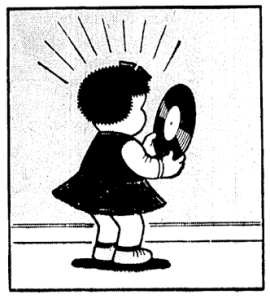 It was a delight to catch up on my podcasts, and to find that Mini-Mutations made a appearance on the November 21st episode of What’s This Called?, the program hosted by Ricardo Wang. What a true delight. You can hear the entire episode here, which is a just a direct link to the show hosted over on his site. It’s always a treat to hear my material mixed in with other stuff, although I feel like I should probably send him some new stuff, as I feel like I’ve made a lot bigger advances since then.
It was a delight to catch up on my podcasts, and to find that Mini-Mutations made a appearance on the November 21st episode of What’s This Called?, the program hosted by Ricardo Wang. What a true delight. You can hear the entire episode here, which is a just a direct link to the show hosted over on his site. It’s always a treat to hear my material mixed in with other stuff, although I feel like I should probably send him some new stuff, as I feel like I’ve made a lot bigger advances since then.
Still, it’s nice to hear this stuff, and the CD is out of print, meaning the only way to hear tracks like this is from DJs that play the tune on their show. I might re-issue that disc eventually, but for now, you can pick up, “You Are There,” digitally, which contains bonus tracks that are not on the CD.
Thanks again Ricardo!
 Today is the first day that I don’t have to work on my November Novel in a month, and there’s something sort of relieving about not having to crank out words on any particular schedule about any particular thing for a little while. Which, of course, is funny, as I will still be writing a number other bits of text here and there and whatnot, in a number of other capacities. (Like this 1261 word “thought.”) The point is: I won’t be working on that novel anymore, and that alone feels like a sort of lifted weight.
Today is the first day that I don’t have to work on my November Novel in a month, and there’s something sort of relieving about not having to crank out words on any particular schedule about any particular thing for a little while. Which, of course, is funny, as I will still be writing a number other bits of text here and there and whatnot, in a number of other capacities. (Like this 1261 word “thought.”) The point is: I won’t be working on that novel anymore, and that alone feels like a sort of lifted weight.
There is a weird experience you go through when you are “done” with something, especially in the creative world. The project is “complete,” but you have been working on it for ages, so it is still active in your mind. Not only that, but the project is only “complete” in one sense. The “novel” is done, but I still have to edit it, if I want anyone to read this at any point. Another “project” to take on, someday, and certainly not any time soon. Even still, I can help but keep thinking about the characters, and considering parts that I should revise. I’ve had these people and this idea in my head, every day, for 30 days now. It’ll be a while to let all these ghosts move on.
Regardless this one is done, and there isn’t anything immediately on the horizon for now, as I spend my time wrapping up a number of other projects that have been on the so-called back-burner, while I was writing all November. Which, itself, is something interesting to contend with: the limited amount of creative juice that I have in a given day, and why I can’t just knock out 2k words in the morning and then write a full song in the afternoon.
This is a fairly obvious realization, but we do all have a limit to how much we are able to do in a day. While I try to maximize my own output as often as possible, the reality is that no matter how clever or smart you might be, you do need to let the engine rest if you do plan on any more big trips this year. You might be able to go and go all night long as a teen, but as a grown man, you need to save that for special occasions, so to speak.
I’m attracted to a number of different kinds of creative expression, and they all run into the sustainability problem. You can do them for a while, at a pace that makes sense, but after a while even that pace will get to you, even if you think you have it all balanced. Radio is the perfect example: it requires a consistent creative effort, and sometimes that effort can begin to feel like a lot, just to do the regular bare minimum, even if it feels like it shouldn’t be too much to exert, for the first 100 weeks anyway. There will be a week that you want to take off, and in spite of all of that, you still have to make a show when you don’t want to.
There is something about trying to establish good creative habits, and finding the right balance, in spite of whatever it is that you might want to be doing, otherwise. Like any muscle, you might not be able to be as creative as you would like, as often as you like, at first. But the more you do it, the better you get at it, etc. etc. None of this is news, but the implementation is the interesting part. If you ever say to yourself, “I want to be a creative person,” usually the first question is, “How do I do that?”
I often get told that I produce a lot of material as an artist, and perhaps that is true. But I don’t know how to do any less, to be honest. And the reason is because I’ve been doing it for so long, that the habit of making things is fairly well ingrained.
I was able to take on #NaNoWriMo this year is related to the number of years that I did try to do it and failed, terribly, for a number of very boring reasons that aren’t obvious until you have to stare it down in the debriefing after the fact. It has taken almost 20 years of attempts to know what I need, how to go about it, and what I should do to set myself up for successfully completing my book in 30 days. But the handful of times that I’ve actually beaten #NaNoWriMo were only possible when I learned from the previous times. (And, honestly, I think there’s only been two novels I wrote of those that could, MAYBE, be revised into something that would work as a book or story that I would feel comfortable sharing.)
It’s that same sort of attitude that I’ve applied to almost everything that I’ve done in life, that allows me to do anything at all as a middle aged man. I didn’t realize that writing ‘zines in my teen years prepared me for being able to write in the here and now. (The consistency of writing stuff for all sorts of DIY presses, where there’s no real deadline, forced me to be self-directed in order to finish anything.) When I have to get up in the morning and write 2000 words and there’s no one waiting for that text on the other side of me writing it, that really is where the creative rubber hits the road.
Doing radio for over 20 years, a lot of it not amazing, has only taught me what not to do, and how to get to the point where I can fairly easily do the kind of show I wish I’d been doing for over 20 years ago. Ditto for music. Failing at doing what I intended to do has only made it possible to successfully do what I want to do, now.
Again, none of this is “earth-shattering” or even that much more insightful than the hundreds of self-help style commentaries you can find in books, blogs and podcasts. All of what I’m experiencing also felt like I’d read or heard someone else talk about it. Putting in the work over the years is where we get our skills or cleverness from. As a middle aged man I have an advantage that the 18 year old I was did not have. But without having been an unskilled teenager making an effort, I wouldn’t have any of the leg-ups that I do have now, and I recognize that advantage.
Case in point: driving. I’ve only had my license for a single year, and I would say that in all the time that I’ve been behind the wheel, I still haven’t had enough hours to really consider myself any good at it. I should have been driving since I was 18, so that now I could easily do it, almost as a second nature, and free up my mind to think about other things. But as a new driver, I still make a lot of mistakes, I’m still very nervous, and when I do everything correctly and successful, it still feels like the exception, and not the rule. I just haven’t put in the hours yet, and not enough to say I have that skill confidently.
All of this is easy to reflect on when you are on the other side of a project. But it is nice to know that all the years I spent writing and mixing records and working on songs that didn’t go anywhere weren’t wasted efforts, and that I seen their benefits today.
Now, the matter of taste is another matter entirely, but just from my own perspective, I know that I could never have finished a #NaNoWriMo style challenge when I was 18, even though I would have been sure that I could. Just from the skill and planning perspective alone, I know that I’ve learned a lot over the years about what is a reasonable expectation, and what I can successful pull off on my own. While I have always wondered what I could accomplish if I had a partner, I will say that if I could write one novel a year for the rest of my life, even if they were never published, at least that would feel like I accomplished something.
Maybe this year I’ll try to edit this one in March, something I’ve never actually tried.
 You can now order this record from WTBC via Bandcamp. In addition to the music on the record, which is unique to this release and unavailable elsewhere, there is also over an hour of videos and audios you can enjoy, not available elsewhere, included via QR codes, with covers and collages created and designed by Formaldehydra & Mini-Mutations.
You can now order this record from WTBC via Bandcamp. In addition to the music on the record, which is unique to this release and unavailable elsewhere, there is also over an hour of videos and audios you can enjoy, not available elsewhere, included via QR codes, with covers and collages created and designed by Formaldehydra & Mini-Mutations.
This release does not come with bandcamp downloads; the digital bonus materials are only available via QR codes, that you can only find in the packaging for this release. Truly a unique item that we promise you will love.
Outside of the US: we will have to charge for shipping. Inside the US: it is included int he cost.
$12 per disc. Limited to 30 copies.
Several have already been spoken for, so order yours today! Here’s a little promo video to whet your whistle…
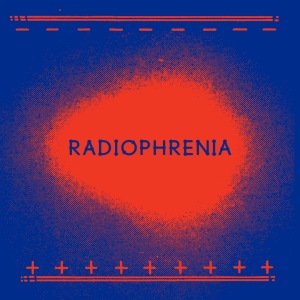 For a number of years now, RADIOPHRENIA has curated a two-week long radio broadcast, in November, to feature and highlight some of the most interesting (and compelling) sound and radio artists around the world. They highlight some of the most unusual broadcasters and sound artists working today, and it is always worth tuning in for, to see what they have going on each year. (Fortunately, you can stream it all using this link.)
For a number of years now, RADIOPHRENIA has curated a two-week long radio broadcast, in November, to feature and highlight some of the most interesting (and compelling) sound and radio artists around the world. They highlight some of the most unusual broadcasters and sound artists working today, and it is always worth tuning in for, to see what they have going on each year. (Fortunately, you can stream it all using this link.)
Beginning today, RADIOPHRENIA begin their broadcast, and it is off to a great start. You can review the schedule here, but I urge you to listen at 5 PM PST on November 10th (1 AM GMT on November 11th), to hear Mid-Valley Mutations. A special show has been assembled just for them, containing excerpts from my favorite broadcasts I made this year. This isn’t precisely new material, if you listen to the show regularly, but it’s assembled in a new way, specifically for this show, and will give people who don’t normally hear what I do a chance to check it out.
I’m very proud to have been selected to be a part of RADIOPHRENIA this year, and I’m looking forward to hearing all the other artists too, and finding out what they did, too.
Thank you RADIOPHRENIA, for championing unusual sounds and radio, all over the world.
 I’m off to an okay start, I think. I made a spreadsheet where I (and anyone) can chart my progress this year. I can easily help make one for you if you find something like that motivational.
I’m off to an okay start, I think. I made a spreadsheet where I (and anyone) can chart my progress this year. I can easily help make one for you if you find something like that motivational.
I also began with an outline, and then started writing. I have a feeling this one might work.
Hope you like detectives!
 In the early 2000s, I first heard about NaNoWriMo from a number of Inter-Web-A-Tron bloggers that I had made friends with in Portland. Since then, I’ve made a number of attempts at actually completing a NaNoWriMo novel, and often, they are detective stories. Most of the time, I never finish. (Especially the years I was in college; I usually started strong, then petered out just before Thanksgiving.)
In the early 2000s, I first heard about NaNoWriMo from a number of Inter-Web-A-Tron bloggers that I had made friends with in Portland. Since then, I’ve made a number of attempts at actually completing a NaNoWriMo novel, and often, they are detective stories. Most of the time, I never finish. (Especially the years I was in college; I usually started strong, then petered out just before Thanksgiving.)
Once, in the last 20 year, I’ve completed the 50,000 words in 30 days goal, and while that story has sort of languished since then, I’ve suspected that I could do it again, and learn from the mistakes of the past.
And, as we are in for a long winter, and since writing and isolation are a good combination (hopefully keeping me occupied the whole time) seems like a good hobby this winter.
I’ve got a few ideas, and no reason to leave the house. I think I’m gonna do this. I don’t think I’m gonna do an official registration on the site, but I’ll do the next best thing, and track it all on this blog. I may put links in to the story as it develops.
Hopefully this will be fun, too. It’s only 1,600-ish words a day, which is likely less than the amount you write on social media every day.
Any fellow writers want to take this on with me? We could start a writing club, have Zoom Encouragement meetings, etc. It’s a no-pressure thing.
As I suspect a lot of us will have a lot of time on our hands this winter.
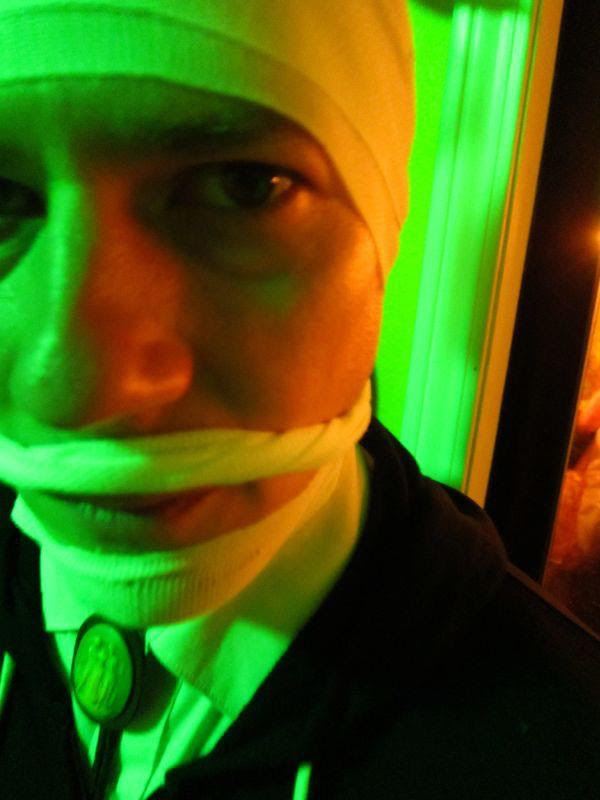
I started getting serious about Halloween radio in 2003, and since then, I’ve done my best to offer some very cool sounds that complement this time of year. With that in mind, I have a few Halloween themed audio albums that you can enjoy, and a Halloween podcast that you’ll want to subscribe to! We had a lot of fun this year, and I’m pretty proud of what it out there. So, maybe you can add these to your holiday playlists?
* * * * * *
Part  of Hal
of Hal  McGee’s Electronic Cottage Splits series of releases, which has paired 40 artists in a number of complementary and impressive ways, and created an excellent body of work that displays a great cross-section of experimental artists working today. Michael Cosma & I cooked up a little Halloween release, with eerie tunes and a spooky original story set to music. An hour of experimental Halloween sounds that will complete any home. You can pick up a digital or CD version from the EC Bandcamp Page, or get a CD version from the WTBC Store.
McGee’s Electronic Cottage Splits series of releases, which has paired 40 artists in a number of complementary and impressive ways, and created an excellent body of work that displays a great cross-section of experimental artists working today. Michael Cosma & I cooked up a little Halloween release, with eerie tunes and a spooky original story set to music. An hour of experimental Halloween sounds that will complete any home. You can pick up a digital or CD version from the EC Bandcamp Page, or get a CD version from the WTBC Store.
* * * * * *
 Now five years old, this release compiles some recordings made for Halloween Radio, with some new recordings and other bits and bobs, to present our first Spoken Word release. The centerpiece is a reading of an Ambrose Bierce collection of stories, with music and SFX that highlight the supernatural eeriness of these creepy tales. You can pick up a digital copy form the WTBC Store.
Now five years old, this release compiles some recordings made for Halloween Radio, with some new recordings and other bits and bobs, to present our first Spoken Word release. The centerpiece is a reading of an Ambrose Bierce collection of stories, with music and SFX that highlight the supernatural eeriness of these creepy tales. You can pick up a digital copy form the WTBC Store.
* * * * * *
 Recorded live, while on tour with Mark Hosler during the first Mini-Mutations tour, the shows were building up to a big Halloween performance at the Re-Bar. This digital album collects almost two and a half hours of halloween atmospheres, creepy cut-ups, collage stories about trains & haunted houses, with lots of ghosts flitting about the entire time. While this only captures the “spooky” parts of that tour, those were some of the most fun, and they’re all here, for you to enjoy. You can pick up a digital version form the WTBC Store.
Recorded live, while on tour with Mark Hosler during the first Mini-Mutations tour, the shows were building up to a big Halloween performance at the Re-Bar. This digital album collects almost two and a half hours of halloween atmospheres, creepy cut-ups, collage stories about trains & haunted houses, with lots of ghosts flitting about the entire time. While this only captures the “spooky” parts of that tour, those were some of the most fun, and they’re all here, for you to enjoy. You can pick up a digital version form the WTBC Store.
* * * * * *
 This program launched in 2020, and it’s a collection of all sorts of stories about life in these modern times. For October, I read stories and poems that help put listeners in the holiday spirit, with selections from Richard Brautigan, Ambrose Bierce, Henry Wadsworth Longfellow, Mark Twain, Robert Frost and O. Henry, some classic tales that are perfect for those late-night flights of fancy. The last installment of this four episode series airs tomorrow on KMUZ at 10:30 AM, but you can also catch all the shows by Subscribing To The Podcast.
This program launched in 2020, and it’s a collection of all sorts of stories about life in these modern times. For October, I read stories and poems that help put listeners in the holiday spirit, with selections from Richard Brautigan, Ambrose Bierce, Henry Wadsworth Longfellow, Mark Twain, Robert Frost and O. Henry, some classic tales that are perfect for those late-night flights of fancy. The last installment of this four episode series airs tomorrow on KMUZ at 10:30 AM, but you can also catch all the shows by Subscribing To The Podcast.
* * * * * *
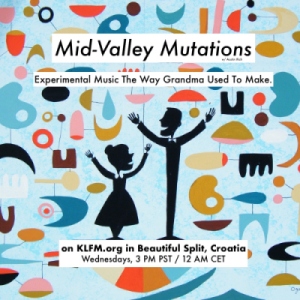 Keeping in-step with our annual tradition (going back to 2003), we offer four new radio broadcasts, with live music, a returning a guest, and a long trip to the movies… in an at-home, safely quarantined kind of way. It all begins with a live Mini-Mutations / forest journey into an ancient place I’ve never been to before, so I can catch a performance by Daona in a clearing. Then, I get lost on my way home, wind up in a House on Haunted Hill, then get stranded on Horror Island, and finally, get to the radio station where I get to hang out with DJ Victrola, who is more than game to talk Horror Movies with me. It’s a little MST3k, a little “live music overdrive,” a little “podcast hang with a friend you care about,” and all of it is very, very “in the mood.” The best way to stay in touch with this show is to subscribe to the podcast, here on iTunes, which includes roughly the last year or so of podcasts. But you can always visit midvalleymutations.com, to find all the back-episodes.
Keeping in-step with our annual tradition (going back to 2003), we offer four new radio broadcasts, with live music, a returning a guest, and a long trip to the movies… in an at-home, safely quarantined kind of way. It all begins with a live Mini-Mutations / forest journey into an ancient place I’ve never been to before, so I can catch a performance by Daona in a clearing. Then, I get lost on my way home, wind up in a House on Haunted Hill, then get stranded on Horror Island, and finally, get to the radio station where I get to hang out with DJ Victrola, who is more than game to talk Horror Movies with me. It’s a little MST3k, a little “live music overdrive,” a little “podcast hang with a friend you care about,” and all of it is very, very “in the mood.” The best way to stay in touch with this show is to subscribe to the podcast, here on iTunes, which includes roughly the last year or so of podcasts. But you can always visit midvalleymutations.com, to find all the back-episodes.
* * * * * *
 If you want immediate access to hundreds of hours of free Halloween radio, then this is your one-stop shopping for all the fun. We have done it all over the years. Phone calls from people who had ghostly or supernatural experiences? Check. Recordings of Old Time Radio Horror broadcasts? Absolutely! 60’s monster songs and spooky frankenstein dance numbers? Undoubtedly. Trips through the Punk-In-Patch? In a Misfits shirt and everything! I even get guests to come and read scary stories on the radio, use Ouija boards, play live, or just enjoy the ambiance. I re-run all the old Closet Radio Halloween programs, and feature my annual sister-in-radio, DJ Victrola! This feed offers all the episodes, from all the shows, and give you the chance to enjoy some one-stop shopping for everything Halloween Radio. You will most definitely want to subscribe to this iTunes Feed so your party will have the right vibe! Can you dig it?
If you want immediate access to hundreds of hours of free Halloween radio, then this is your one-stop shopping for all the fun. We have done it all over the years. Phone calls from people who had ghostly or supernatural experiences? Check. Recordings of Old Time Radio Horror broadcasts? Absolutely! 60’s monster songs and spooky frankenstein dance numbers? Undoubtedly. Trips through the Punk-In-Patch? In a Misfits shirt and everything! I even get guests to come and read scary stories on the radio, use Ouija boards, play live, or just enjoy the ambiance. I re-run all the old Closet Radio Halloween programs, and feature my annual sister-in-radio, DJ Victrola! This feed offers all the episodes, from all the shows, and give you the chance to enjoy some one-stop shopping for everything Halloween Radio. You will most definitely want to subscribe to this iTunes Feed so your party will have the right vibe! Can you dig it?
* * * * * *
This has been an excellent season, and I look forward to it every year. Hopefully this brought a little joy to your ears, and helps set the tone for a fun a excellent season. This year has been hard. Maybe some fun music and radio will soothe you, for a little while, anyway.
Take care.
Coming soon. I had a couple small roles in making this film. Here’s a taste of what to expect.
Michael Cosma & I received a very sweet review from Jerry Kranitz, an author of the book, “Cassette Culture: Homemade Music and the Creative Spirit in the Pre-Internet-Age.” Jerry is also a member of the Electronic Cottage community, and actively supports independent artists of all kinds. Here’s his review of our release, which you can still get from Hal McGee’s Electronic Cottage website for both a CD or Digital version. (You can also get a CD from the WTBC Store.) Thank you so much, Jerry! What a cool review.
* * * * * *
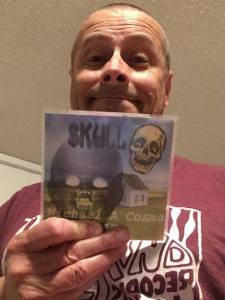 EC Split 4 by Michael A Cosma & Mini-Mutations
EC Split 4 by Michael A Cosma & Mini-Mutations So far, I’ve found four films for my October Horror Festival, that contains only films where people wander around a mansion or castle, there’s the suggestion of ghosts, and suits of armor are part of the set design.
So far, I’ve found four films for my October Horror Festival, that contains only films where people wander around a mansion or castle, there’s the suggestion of ghosts, and suits of armor are part of the set design.
The House on Haunted Hill (1959)
The Bat (1959)
Horror Island (1941)
The Secret of the Blue Room (1933)
Two of these films are from 1959, which is interesting. (I wonder if there was a shared set, even?) But the second two are straight off of the original “Shock Theater” package of films, which was assembled by Screen Gems in 1957, and distributed to a number of TV stations across the country. The original Shock Theater package came with 52 movies. (One a week for a full year.) A second package, the year later, came with 20 more films, and by then, Horror Hosts were popping up all over, hosting these movies late at night. The Shock Theater package ushered in a new age of interest in horror movies, at a time when rock and roll was on the rise, and American Culture was seeing the influence of teenagers in a big way, something that wasn’t the case in the years before.
I think the appealing thing to me is that most o these films seem to include some sort of secret passage, or secret doors that lead to strange rooms. I think there’s any number of people who would love to live in a house with this kind of design, and while I’ve never lived anywhere like that, if you throw something like this into the film, I’m pretty much into it.
I’ve seen some of the Shock Theater package, but not all of it. But I suspect there’s a few more Suits Of Armor Shlock out there that I’m not familiar with. The idea is sort of genius: use cheap movie FX and a single, “Haunted House” set with an ensemble cast to plow their way through a tense (or, in the case of Horror Island, comedic) script, probably very quickly, based on older movie making practices of the “B” variety.
I’ve found all of these to be wonderfully charming in a corny way, and I’d be curious to see if I can find more for this list. I suspect there’s a lot more that I’m not familiar with.
In the meantime, I’ll keep working my way through the Shock Theater package. I’m sure that’s a good start.
 There is a genre of movie that doesn’t get made anymore, where people wander around a castle or a mansion late at night, looking for ghosts or money, and occasionally they hear a suit of armor fall over.
There is a genre of movie that doesn’t get made anymore, where people wander around a castle or a mansion late at night, looking for ghosts or money, and occasionally they hear a suit of armor fall over.
I would like to see more movies like this.
Serious long dark tea-time if the soul, today.
These guys are still great.
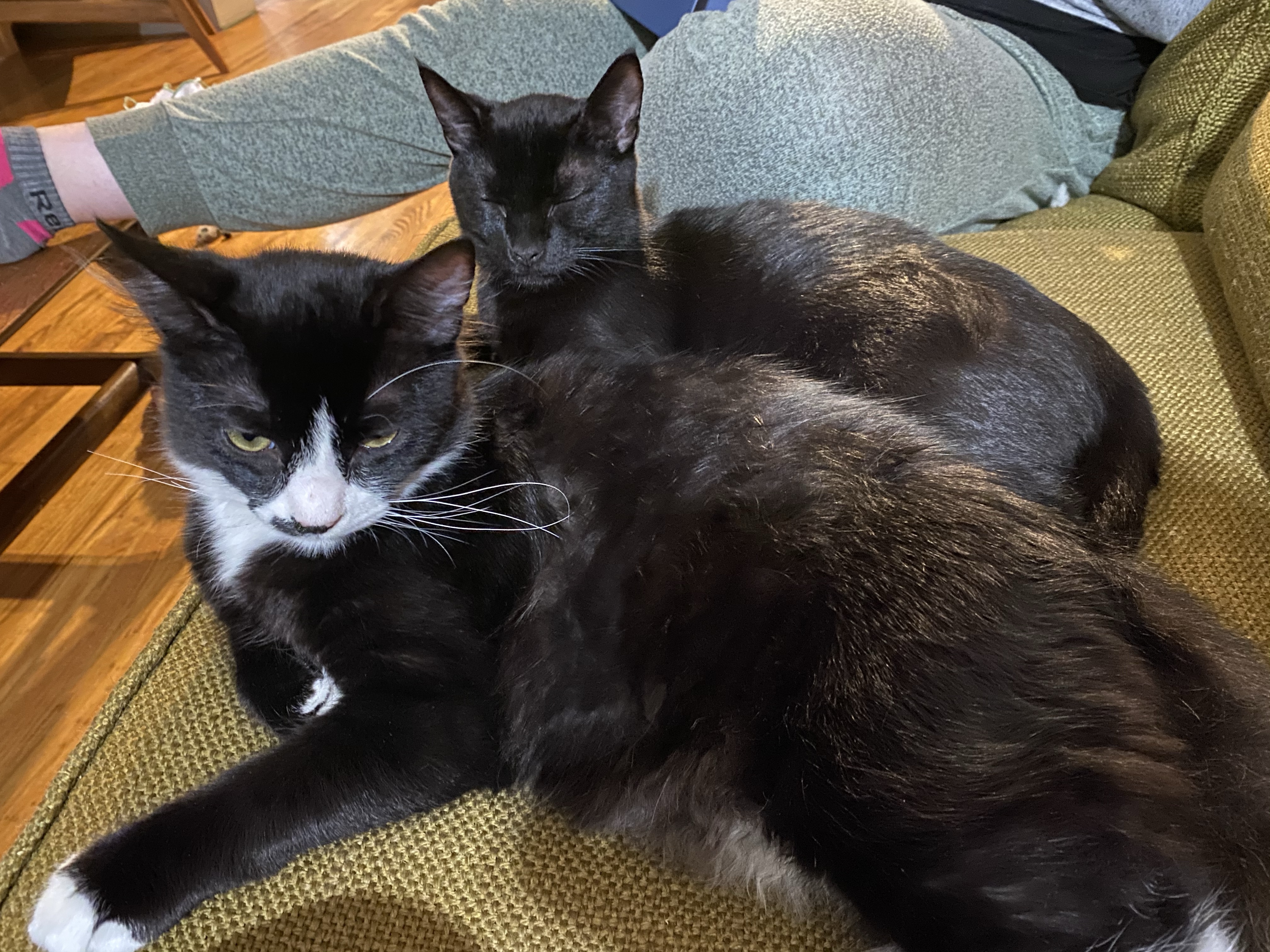

Half Eye is Seattle artist that began in the early 90’s, combining home recordings, indie rock riffs, and odes to Udo Kier, issuing a number of albums that are dark, murky explorations of longing and loss, with a sense of humor that is as much a puzzle as it evokes a guffaw. Over the last 30 years, Half Eye has cultivated a unique sonic pallet that is immediately recognizaable, and yet only implies influences without directly pointing fingers.
Shot Reverse Shot materialized in the summer of 2020, when a sufficiently futuristic-sounding date had finally been achieved. This quintet of rock & roll androids, clones and cyborgs, have been locked in the server room this year, plugging into the Master Control Unit, so they can lock down the algorithms that will render their first tunes into sound recordings, in an audio range that you can hear! The first of these songs have been pushed to the server, and with Austin Rich producing these tracks, they are sounding pretty excellent.
WTBC is very excited to be releasing their first 7”, and with the help of these two artists, we think this record, made by Gorbie Lathe Cuts, will be something very special. These songs are not available online, and comes with beautiful covers and a collaborative mini-zine, all designed by Half Eye & Shot Reverse Shot. Bonus digital materials will give you plenty to enjoy while you spin this 45, and people who purchase this record will get a special discount when purchasing the forthcoming Shot Reverse Shot album coming in December.
Limited Quantities, on White, Lathe Cut Discs.
This is Rock Music! Not exactly an “experimental” release!
Available in November. Pre-Order NOW!
$12 includes shipping. (A little more for outside the US.)
WE NOW LIVE IN THE FUTRE.
Over a year in the planning, this new split record was made by Gorbie Lathe Cuts, and is available for pre-order, as we speak. The record itself won’t ship until November*.
New material by Florida artist Formaldehydra & Oregon artist Mini-Mutations, recorded during the recent fires we suffered from in September. This music isn’t online, and while sold through Bandcamp, cannot be streamed there. If you want to hear these songs, they only exist on these discs.
These records are hand-made in every way; the covers / inserts were printed on free paper with used ink cartridges, cut by Austin in The Lava Lamp Lounge. QR Codes activate unique bonus materials not available elsewhere. And, only available in limited quantities. Once they are gone, they are gone. Just like our dwindling forests.
$12 includes shipping. (More outside the US… Let’s talk.)
The forests need our help. Maybe this will be The Summoning Call?
* Possibly sooner, but hope for the best / expect the worst, yes?
There is a part of me that is having a really hard time feeling like any of this will work out well for anyone.
What an incredible weekend. I’ve attended a few live events online, and they are usually fairly lackluster, without a lot of engagement (or, really, people even showing up). So it was so impressed to find that we had about 100 viewers for most of the three days of NoiseFest, and it really did feel like a weekend gathering, rather than a digital show that we all watched from our homes. The chat was lively and fun, and I think everyone involved had a great time.
I don’t’ have a lot to say that I haven’t said before, so I will merely say: I’m still recovering. For some reason, even though I was at home, it felt like I was with this crew of folks for the entire weekend, and it was nice to know that I could re-create that with something like this.
Anyway, I had fun.
Here’s a couple links I think you’ll appreciate:
This playlist contains all of my contributions to NorCal NoiseFest this year, including my 20 minutes performance, a pair of commercials I made for the Sacramento Audio Waffle, my ad for the WTBC Store (at wtbc.bandcamp.com), both NOYZ STALLYNS performances (the SAW performance, which sets up our NoiseFest Performance), and the five minute film that I made that got shown on Day Three. The ads were sprinkled throughout the three day broadcast, so here’s the condensed playlist, that contains all the pertinent stuff. I even managed to capture to the Real Time Chat window that was going during my performance, which you can watch with the audio of my set to accompany it.
* * * * * *
This playlist contains the three, uncut, livestreams from the entire weekend. It is a total of 19 Hours of Programming, from a crazy wide-range of musical artists, from all over the spectrum of Experimental and Noise. In fact, this year is a fairly reflective, introspective year, with a lot of sets that include long, thoughtful pieces. It would advise watching it with the live chat turned on; there’s some pretty excellent moments from the participants in there, too.
The NorCal NoiseFest Live Stream continues to be excellent, and yesterday was no exception! Over 6 1/2 hours of experimental music and video programming, some of it streamed live from our respective studios, some of it pre-recorded, for everyone’s sanity.
There’s more to come! Today’s stream starts at 2 PM, and I have a few bits and bobs in the show that you might enjoy, including a five minute short movie that hans’t really been seen since it was shows to an audience in Corvallis earlier this year (which you can see around 5 PM.)The line-up today is silly good, so hopefully I’ll see you in the chat! Enjoy!
From “mild” to “moderate” is also how I describe my interest in this news story, too.
The Live Stream last night for NorCal NoiseFest was excellent! So many incredible acts, and all of them available to watch, right now! (Or at any time you like.) Five hours of experimental programming, all for you!
Today’s stream starts at 2 PM! And I’m on at 4 PM and 5 PM! You should tune in! It will be excellent!
 A BRAND NEW episode of my new radio show starts at 10:30 AM, today!
A BRAND NEW episode of my new radio show starts at 10:30 AM, today!
After a month off for re-runs, we begin a slew of new episodes with a Pledge Drive broadcast, on our new day and time!
Tune in, to find out why you should donate to KMUZ, and digest this radio diary, from my home, to yours.
Enjoy!
What’s really frustrating is that he is probably incapable of processing how apt it is that he’s got it.
He probably had to be told a few times before it sunk in that he had it.
Being sick and having to go to work anyway sucks.
If only I had any sympathy for him.
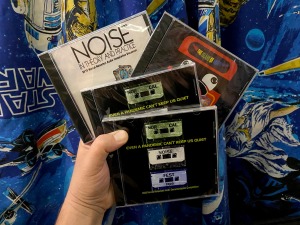 For the last four years in a row, I’ve participated in the NorCal NoiseFest, the longest running festival of its kind. So much goes on at this fest, in terms of meeting people, swapping cool music and gear, discussing our particular audio landscape, and everything in-between, that the idea of skipping a year was really hard on all of us. But it didn’t take long to figure out how to move the whole thing online, and soon enough, all the usual things associated with the fest needed to get sorted out: t-shirts, the schedule, etc. And, of course, the compilation.
For the last four years in a row, I’ve participated in the NorCal NoiseFest, the longest running festival of its kind. So much goes on at this fest, in terms of meeting people, swapping cool music and gear, discussing our particular audio landscape, and everything in-between, that the idea of skipping a year was really hard on all of us. But it didn’t take long to figure out how to move the whole thing online, and soon enough, all the usual things associated with the fest needed to get sorted out: t-shirts, the schedule, etc. And, of course, the compilation.
For the last three years I’ve contributed a track to the comp, and it has been wild to be on a disc with some of these incredible artists. Some real heavy-hitters come out for the fest, and the comp usually captures an excellent cross-section of performers, and a view into the world of experimental music that is pretty varied and excellent, even for those who have never experienced this kind of music before. It seems like more and more people attend the fest each year, and more and more people get involved in the comp, too. The number of tracks per disc on the three I have only increases with each year.
The new comp is out; you can get it (and other merch) over at the Square Site, or you can pick up the stuff that you don’t find there on the BandCamp Page. And, here’s a little factoid that you might enjoy: the more stuff we sell through the merch stores, the more the artists get paid this year. Since no one can pay the cover at the venues this time, and since there’s fewer opportunities for artists to make sales in person, this is going to help all the performers involved make a little scratch.
So please, consider getting some cool schwag, and support people like me with your generosity!
Some of the artists that appear this year’s disc: Kompripiotr, Juice Machine, Don Haugen & John Frank, Human Fluid Rot, +DOG+, Skrunt Skrunt, Instagon, Chopstick and so much more. 33 Artists in all! At that rate, you are enjoying over three performers for every entertainment dollar you spend on this collection. A bargain during almost any calamity.
If you are interested in making a deal directly with me, I have physical copies ONLY, on CD, of the last three compilations. I am selling them for $10 apiece, or any two for $18, or all three for $24. I don’t have an official link, but if you message me, we can work out the details. After the fest, I’ll be re-designing the online store, where some stuff that has not been up previously will be available for purchase, including two new lathe cut records! But if you want to support the fest as a whole, I would use the links above.
I’m very proud of the work I’ve done on these comps. And, for an added bonus, the track on the 2018 disc is a collaboration with Mini-Mutation & Red Panda Death March. What more could you ask for in your musical entertainment? You should pick one of these up, today!
Holiday Special is one of the hardest working people involved with the NorCal NoiseFest every year, and the is mostly because AV is a totally essential part of the fest, and they handle all the photography and Performer Profiles, as well as tons of other stuff. So I was flattered to be asked to be in one of the profiles this year.
Here’s the best thing I’ve seen all day: someone else cutting down my rambling conversation by 1/10th and improving the way I sound by 100 fold. If you’ve ever been curious about what I do, and wanted a three minute summary, this is it:
NorCal NoiseFest YouTube Channel:
See ya this weekend!
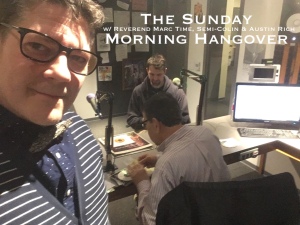 Marc Time has been doing double-duty over at KWVA ever since the virus changed our lived completely and dramatically. He’s been re-running a wide-range of his old shows, not only during his normal time slot, but all over the schedule. And with a large archive like his, there’s a show for every occasion.
Marc Time has been doing double-duty over at KWVA ever since the virus changed our lived completely and dramatically. He’s been re-running a wide-range of his old shows, not only during his normal time slot, but all over the schedule. And with a large archive like his, there’s a show for every occasion.
I’ve been lucky enough to guest on his show a few time, and this Thursday (1 October 2020), at 8 AM, KWVA will be re-running the episode where Colin Hix (from /root_DIR) and I tell Cathead stories, and hang out with Marc for his show. I reveal some new production pieces I made just for his program, and overall, it’s a lot of fun.
Here’s my archive or the program.
Marc is one of those people that I will not be able to visit until the virus is handled; he and I are different generations, and I don’t want to risk spreading anything to him if I can avoid it. So until we can hang out again, it will be recorded memories like this.
Tomorrow. 8 AM. KWVA. Tune in!
 Sometimes it’s difficult to make sense of the past. Things happen quickly, you do a little of this, a little of that, and then, before long, it’s been almost 30 years and you have to rely on old journals, the memories of close friends and collaborators, and at times, strange information that you end up Googling online, to fill in the gaps.
Sometimes it’s difficult to make sense of the past. Things happen quickly, you do a little of this, a little of that, and then, before long, it’s been almost 30 years and you have to rely on old journals, the memories of close friends and collaborators, and at times, strange information that you end up Googling online, to fill in the gaps.
The funny part about archaeology, in whatever form it takes, is that the things you do find are often as surprising and unexpected as the things you set out to find in the first place. Sure, you might think you found the remains of an excellent village that you can then now try and make sense of, very quickly you discover that the only section of the village that is yielding anything worth looking at is the dump, and even those finds are mixed with… let’s just say, garbage.
Digging through old files, boxes of fliers and documents, and my own “source documents” from various events and experiences, has (more or less) yielded a near-complete list of the musical endeavors that I have participated in, going back to my first efforts in 1994. I have excluded anything that never made it past the “idea” phase; we had to have played out at least once, either live or on the radio. This immediately controlled for some of the more odd and ambitious groups I was involved with, but also brought the idea down to earth in a way that was manageable. This list is the stuff that there is enough evidence to occasionally raise the odd question about this one or that one, every so often.
Obviously this is in progress, and obviously, there’s probably some obvious bits I have strangely omitted, for some strange reason. I hope to improve this list as new evidence is uncovered, and as The Archive is massaged into some sort of shape that makes sorting through documents and files much, much easier. Until then, if you help remind me of something that I clearly forgot and / or omitted, I would be happy to hear from you.
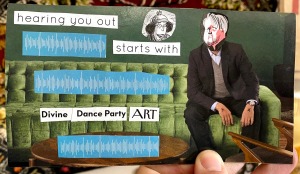 As the future becomes less and less certain for all of us, we all need to find something fun to cling to that will offer us some hope as we strap in for an uncomfortable year coming up. It’s hard enough to remember to do the chores if everything is falling apart, let alone face the neighbors with the same vim and vigor that you once contained. You need a little something to put a little zest in your step, even if it is temporary and arbitrary.
As the future becomes less and less certain for all of us, we all need to find something fun to cling to that will offer us some hope as we strap in for an uncomfortable year coming up. It’s hard enough to remember to do the chores if everything is falling apart, let alone face the neighbors with the same vim and vigor that you once contained. You need a little something to put a little zest in your step, even if it is temporary and arbitrary.
 With that in mind, we are sending out 12 postcards next year, one for each month, that will offer a unique look into the work I do. With the inclusion of visual art and QR codes, you will get a multi-media creative piece of mail art, delivered to your home once a month. This is very much inspired by the wonderful musical postcards that Dylan Houser / Formaldehydra has been sending out this year. They are such a delight to receive, I had to go and make my own.
With that in mind, we are sending out 12 postcards next year, one for each month, that will offer a unique look into the work I do. With the inclusion of visual art and QR codes, you will get a multi-media creative piece of mail art, delivered to your home once a month. This is very much inspired by the wonderful musical postcards that Dylan Houser / Formaldehydra has been sending out this year. They are such a delight to receive, I had to go and make my own.
There is no cost to you, if you want to get your address on the list, just send me an e-mail. But donations are very much appreciated.
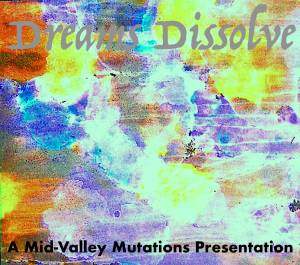 At 3 PM, PST (12 AM, CET), join us for another episode of Mid-Valley Mutations! Before our very ears, our own dreams will dissolve until all we can hear are the sounds of everyday life.
At 3 PM, PST (12 AM, CET), join us for another episode of Mid-Valley Mutations! Before our very ears, our own dreams will dissolve until all we can hear are the sounds of everyday life.
Enjoy!
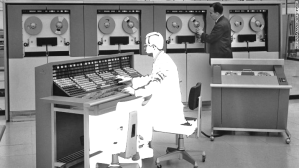 I got banned from FB. For the fourth time, actually. A three day suspension. In a way, I’m sort of surprised it hasn’t happened more often, or more pointedly, because of how often I engage with it. At this stage, I would certainly shut me down if I used my own website this often.
I got banned from FB. For the fourth time, actually. A three day suspension. In a way, I’m sort of surprised it hasn’t happened more often, or more pointedly, because of how often I engage with it. At this stage, I would certainly shut me down if I used my own website this often.
Every time, it has been for the most boring reason. This time, I commented the phrase, “Americans are fucking weird,” on a post. There was no ability to appeal; my account was shut down for three days, and I had to think long and hard about why I might want to return.
I’ve had a problem with Social Media for a while. I made an album about it. I just feel this need to keep in touch, and I really try to do it. But apparently my relationship with it is not quite right. There’s something wrong when I seem to want to break the rules of a platform constantly, and more importantly, I don’t feel right about how much energy I put into it, anyway.
I’m going to make a conscious effort to change the way I use FB, and all social media, for that matter. Something doesn’t feel right about the relationship I’ve developed, and I need to find new ways to interact with everyone in a way that is sustainable, and healthy. You may have noticed I finally decided to make this site Ad Free. I’m hoping to do that on all my sites, soon. I’d like these places to be about the content I make, and not about other garbage.
As time moves on, I will try to reduce my relationship with FB (and all social media) tremendously. My hope is to keep it for music, and even then, largely for communication. I like making art, and keeping in touch with my friends. But the psychic cost of using FB the way I was using it needs to come to an end. I don’t need that in my life. I need to remove myself from the picture, as best I can.
I can share more stories of reasons I got banned. They are all boring stories, and they illustrate how FB is becoming less interesting, and more uniformly gross and arbitrary. I loose large number of friends daily, who no longer post there, and I wonder why I keep doing so, myself.
I’m looking forward to the reclaimed time. But more importantly, I’m looking forward to new ways that we will keep in touch.
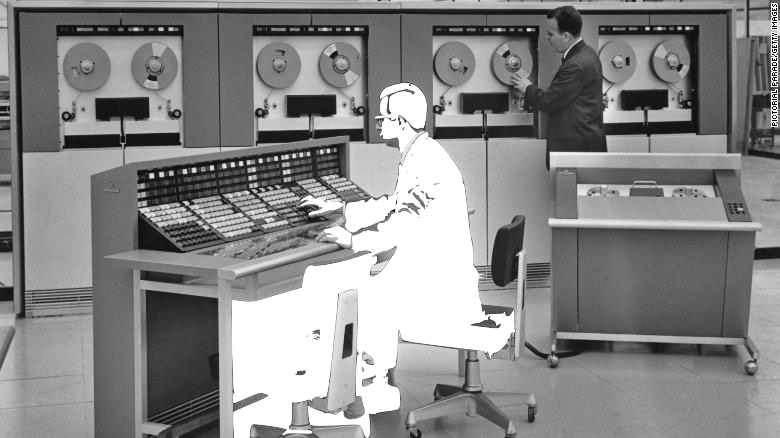
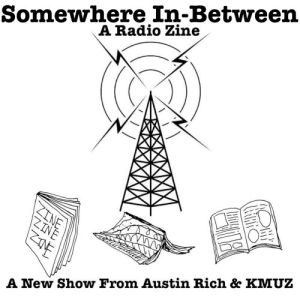
In the interest of trying to get the radio ‘zine to find the right home, KMUZ and myself have decided that we need to move this show to a time that better suits the program. To that end, we will be moving the program to:
You can find out more information on the official Listen Page for our program, and of course, the Listen Links over here have also been updated.
I really like doing this program, and I hope that you enjoy it, too. And I think Fridays are the perfect day to do so.
Beginning OCTOBER 2ND, you will be able to catch the show it it’s new time.
Until then: enjoy plenty of back episodes at betweenradiozine.com, our home away from home.
Thanks you!
 You just can’t keep me off of DFM.nu, and with all the excellent stuff that happens over there, I bet you can imagine why. I’m practically becoming a regular over on UB Radio Salon, and at this point, das & Ninah of Big City Orchestra could have me on every week anyway. What else am I gonna do until the isolation is over?
You just can’t keep me off of DFM.nu, and with all the excellent stuff that happens over there, I bet you can imagine why. I’m practically becoming a regular over on UB Radio Salon, and at this point, das & Ninah of Big City Orchestra could have me on every week anyway. What else am I gonna do until the isolation is over?
I’m quite excited about this one, as they have started a new series within UB Radio Salon: “UBRoom,” which features the only Zoom Call you will ACTUALLY want to join. There’s a whole cast of characters joining us for this one, and as we perform a very special show in two acts, you can settle in for the dada radio Zoom Call that really must be heard to be believed.
Coming Up: Sunday, September 20th
5-7pm US PDT / Midnight-2am GMT / 2-4am CEST
UBRadio Salon *SPECIAL SERIES*
UBRooms Session no. 2
Live broadcast with BCO & friends within the covid influence. Together yet apart, sound and words. Improvised radio art.
BCO’s remote cast of characters:
• OTIS FODDER
• AURORA JOSEPHSON
• AUSTIN RICH
• DINA EMERSON
• LESLIE SINGER
along with pixie & dAS in the Chakra Chimp Research Kitchens
via DFM RTV International
http://dfm.nu/
RADIO STREAM: http://STEREO.dfm.nu / http://MONO.dfm.nu
*** more stream choices available at DFM.nu
CHAT: http://dfm.nu/chat
* * * * *
UB RADIO SALON on Internet Archive >
https://archive.org/search.php?query=ub+radio+salon&sort=-publicdate
Subscribe to UB RADIO SALON podcasts:
iTunes >
https://podcasts.apple.com/us/podcast/internet-archive-collection-ubradio-salon/id1458916069
iHeartRadio >
https://www.iheart.com/podcast/269-internet-archive-collectio-49069740/
TuneIn Radio >
https://tunein.com/podcasts/Music-Podcasts/UB-Radio-Salon-p1216892/
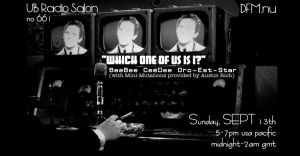 Considering any logistic or technological issues that may happen tomorrow due to smoke, fires or viruses, I will be making another appearance on UB Radio Salon, the wonderful program hosted by das & Ninah of Big City Orchestra. I’ve made a few appearances on the show now, and we sort of have a rhythm to these things, now. I will be in the Lava Lamp Lounge, and they in the Chakra Chimp Research Kitchens, and we will be performing two live improvised radio pieces, “Which One of Us Is I?” The program will feature the writings of Jorge Luis Borges, among other things. Tune in, and enjoy the soothing sounds of UB Radio Salon.
Considering any logistic or technological issues that may happen tomorrow due to smoke, fires or viruses, I will be making another appearance on UB Radio Salon, the wonderful program hosted by das & Ninah of Big City Orchestra. I’ve made a few appearances on the show now, and we sort of have a rhythm to these things, now. I will be in the Lava Lamp Lounge, and they in the Chakra Chimp Research Kitchens, and we will be performing two live improvised radio pieces, “Which One of Us Is I?” The program will feature the writings of Jorge Luis Borges, among other things. Tune in, and enjoy the soothing sounds of UB Radio Salon.
Coming Up: Sunday, September 13th
5-7pm US PDT / Midnight-2am GMT / 2-4am CEST
UB RADIO SALON no. 661
“Which One Of Us Is It?” BeeBee CeeDee Orc-Est-Star with Mini-Mutations provided by Austin Rich
via DFM RTV International
http://dfm.nu/
RADIO STREAM: http://STEREO.dfm.nu
***other stream formats at DFM.nu page
CHAT: http://dfm.nu/chat
* * * * *
UB RADIO SALON on Internet Archive >
https://archive.org/search.php?query=ub+radio+salon&sort=-publicdate
Subscribe to UB RADIO SALON podcasts:
iTunes >
https://podcasts.apple.com/us/podcast/internet-archive-collection-ubradio-salon/id1458916069
iHeartRadio >
https://www.iheart.com/podcast/269-internet-archive-collectio-49069740/
TuneIn Radio >
https://tunein.com/podcasts/Music-Podcasts/UB-Radio-Salon-p1216892/
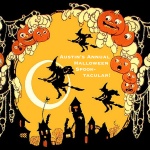 Austin’s Annual Halloween Spook-tacular!
Austin’s Annual Halloween Spook-tacular! Subscribe with an agnostic feed.
* * * * * *
Halloween has always held a very special place for me, in that it is such a different holiday than almost anything else. Fall is setting in, the actual seasonal change fills you with a sense that you should celebrate the spookier elements in our lives. Dressing up, passing out treats, becoming in tune with the past. It is something we don’t do in that way at any other holiday, and for that, I am actually pretty excited. It has bee fun to see, in the last several years, the holiday become something that is celebrated for months in advance. It feels like something that I could even sense, way back in 2003, and I could tell there was a hole in the musical landscape, that could be filled by Halloween Music.
While there were certainly others who were collecting halloween music, and certainly I was only an amateur back then, I had hit upon this idea that summer, and needed to see it through: let’s put together a Halloween Mix to accompany the party my roommate was holding on The Day. To that end, I assembled a several hour mix of songs that I found, many in my collection (but certainly others from the internet and friends collection, as was the style at the time).
The mix was quite successful, so the following year, throughout the month of October, I brought this mix to my radio program on KPSU. And, since then, I’ve done my best to bring variations on this mix to the airwaves, to help ring in the season, usually beginning at the end of September.
Now, 16 years later, there are a number of shows available for you to enjoy, all with spooky novelty songs, scary Haunted House sound FX records, Old Time Radio in the horror and supernatural genre, and everything in-between, and, of course, plenty of visits from Vincent Price and Edgar Allen Poe. Over one hundred hours radio for you to enjoy, perfect for parties, putting out on the porch, or enjoying late at night, with all the lights out!
This is also a good time to pick up a copy of the new Halloween Release by Michael A. Cosma & Mini-Mutations. Designed like a Halloween record from the old days, this release contains songs and a spooky story (with SFX), that works perfectly out on the porch, on repeat.
And while you’re waiting to enjoy the music, check out the podcast. You won’t be sorry.
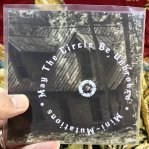

A split release as part of the EC Split series by The Electronic Cottage. The CD includes download codes for “Hallowtide Harmonies” and “The Ways of Ghosts.” You should pick up the digital version from HalTapes, if you can!

It’s not the pandemic, the isolation, or the wildfires that is terrifying me.
It’s the fucking capitalism.
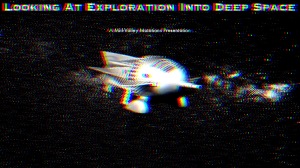
At 3 PM, PST. (Midnight, CET.) A new episode of Mid-Valley Mutations, will be on KLFM.org. Tune in live, to hear it on the stream.
It will also be on the podcast, at the same time, over at midvalleymutations.com.
Enjoy!
Episode One of something new is now is the can. Now, I wonder how long it will be before you hear this…
 I first started looking at, and posting to, the Inter-Web-A-Tron in the early ’90s, first when I saw it in High School, and later, when kiisu first hooked me up, when we live lived together in the Catbave. The earliest website I had was a digital version of the ACRONYM zine I made, itself a consolation prize for the aborted attempts at starting a band called ACRONYM. (Which happened, a few times, but never got off the ground.)
I first started looking at, and posting to, the Inter-Web-A-Tron in the early ’90s, first when I saw it in High School, and later, when kiisu first hooked me up, when we live lived together in the Catbave. The earliest website I had was a digital version of the ACRONYM zine I made, itself a consolation prize for the aborted attempts at starting a band called ACRONYM. (Which happened, a few times, but never got off the ground.)
The name itself I’d inherited from a former creative partner, one that he didn’t like. So I adopted it, to his dismay, and it was my catch-all name, for the longest time. The first domain I registered was acronyminc.com, which unfortunately got squatted on during a short interim that I couldn’t afford a renewal, and the second domain was acronyminc.org. It was the home to my blog, and so much more, from the mid-90’s until, well, now.
But again, I let a card expire, and the domain went up, and was snatched away by another squatter. And suddenly, all that work was gone.
I needed to start over, anyway.
So, goodbye, ACRONYM. You are a vestigial tail, something that still exists in some forms, here and there. But as for my home online, let’s hope this place serves me well.
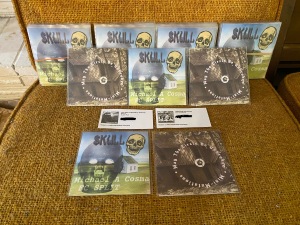 SKULL / May The Circle Be Unbroken Split Release by Michael A. Cosma & Mini-Mutations
SKULL / May The Circle Be Unbroken Split Release by Michael A. Cosma & Mini-MutationsEC Split 04 Digital Release by Hal McGee.
WTBC 0025. CD Release, limited to 50, numbered copies, hand made/cut/folded and duplicated in The Lava Lamp Lounge.
Experimental Horror, and a Halloween Novelty Treat, all available from the wonderful minds encased within the skulls of Michael A. Cosma & Austin Rich, both members of the notorious Electronic Cottage, run by Hal McGee. Hal devised an incredible series of Split Digital Releases, where he paired artists to create a sixty minute audio release. In installment four, things get spooky.
Perfect for putting on the porch as Fall Sets In and The Ghouls are roaming about, or for quiet contemplation with you and a select friend you wish to frighten to death. This disc is constructed to work well using the repeat feature, where you could play the entire thing, end of end, over and over, to evoke the perfect atmosphere for waking the dead.
Michael A. Cosma pulls us through his vision of a dark portion of the skeleton, with songs that demand attention while offering moments of exquisite terror. Then, join Mini-Mutations for a suite of new compositions, all a soundtrack to a story eerily familiar, and yet, wholly unique, too.

Each CD comes with two BONUS download codes, offering listeners a chance to enjoy our previous Halloween releases, too:
The Ways of Ghosts: A Halloween spoken word album by Austin Rich that is currently out of print on CD! Featured are Ghost Stories written by Ambrose Bierce, with a few other stories that also evoke a certain mood perfect for the holiday season.
Hallowtide Harmonies: A collection of live performances by Mini-Mutations, all designed to fit the mood and atmosphere of this time of year. All of these were recorded during the 2018 west coast tour with Mark Hosler, and haven’t been performed again since.
Also included is a digital ‘Zine, collecting a variety of Halloween essays written by Austin Rich.
The songs on this disc are only available digitally over at the Electronic Cottage, but if you want this limited CD, it can be yours for the low-low cost of $5.00, which includes shipping.
Prepare for the holiday season, the only way you know how: with new, Experimental Horror by Michael A. Cosma & Mini-Mutations!

As I consider places where the stuff I make will live in the future, and as I negotiate over 20 years of internet traffic and websites, there are some problems that you just can’t overcome. Lost domains that have been taken over by someone else, multiple places to find various works, and as everything becomes further spread out, some services have died, other’s have changed, and some URLs are embarrassing to forward to folks, when you’re trying to look “professional.”
So, we’ll give this a shot. There’s a menu above; you should be able to find the various places I hang out up there. This will be where the old “ACRONYM” site used to be; not only did that idea become unwieldy, but the site has been plundered. We’ll see how the import goes.
More importantly, we’re going to try and move on. There’s stuff to do, and we don’t have time to fuck about. So this will be where you can find the things I do, easily, in one location. And I’m gonna do my best to keep it simple. Too many choices is etc. cliché and so on.
This will absolutely change over time. Hopefully we can both be cool with that.
I love you. I miss you. Let’s hang out in the comments, and on a call, sometime soon.
 Here’s what I did today: tore down my office tables and gear entirely, and built a little home studio.
Here’s what I did today: tore down my office tables and gear entirely, and built a little home studio.
I’ve certainly worked in / broadcast from worse locations, so meet the new Lava Lamp Lounge – Studio A. Since I’m not doing any live shows for a while, and since my own “home studio” is essentially any flat surface I set up on to record, I decided to use those turntables that kiisu gave me, and make this my home for the foreseeable future. (And: beyond?)
The iPad can be traded out for any other 1/8” jack device. I can also have a cord to swap out devices that need RCA and 1/4” jacks, too. I have a mic-stand / microphone that I can fly in, to use for situations like that. Tapes, CDs, records and digital… right now, I can play almost anything, and I even have that 16 Speed turntable and a reel to reel player I can hook up, if need be. (As I’ve said before: I dare someone to record a song on a format I can’t play.) It’s not ideal, certainly, and I don’t have real monitors or a real studio mixer. But it works, and I can swivel my chair around, stand up, and it’s there, ready to go.
This will be where all future radio and podcasts are created and recorded, and it is also the same setup I use to perform live, with extra gear I usually can’t bring to shows. (Two turntables is just too much for the stage, given the space it all takes up.) So I can probably stream live, too.
I haven’t figured out how to get the streaming sound quality to be as good as the recordings, and I think I might need some more sophisticated cameras / mixers / etc to really pull that off. (Possibly a second computer to manage taking the signal from the mix and putting it through to the streaming camera.) I’m pretty sure I can take calls and / or Skype too, but its not as easy as, “I hear the phone ring and I push a button and the caller is on the air.” I would probably have to hot-swap a couple of items to make it work, and I’m not sure I could mix music behind the call very easily, like I can do at a pro studio. I will be able to add delay or reverb, which will be fun.
It’s a start. I may try some broadcasting later, just to see how it works in practice. For now, you will have to settle for “room sound” on the stream when I do, until I can figure out how the pros do it.
(Also: anyone sitting on any old radio / studio gear that they need to part with? I could certainly use an actual studio board, or something a little beefier than my tiny six channel Behringer. Anyone wanna donate anything to the new studio?)
Hopefully this will help me get through feeling crazy for… however long this winds up being.
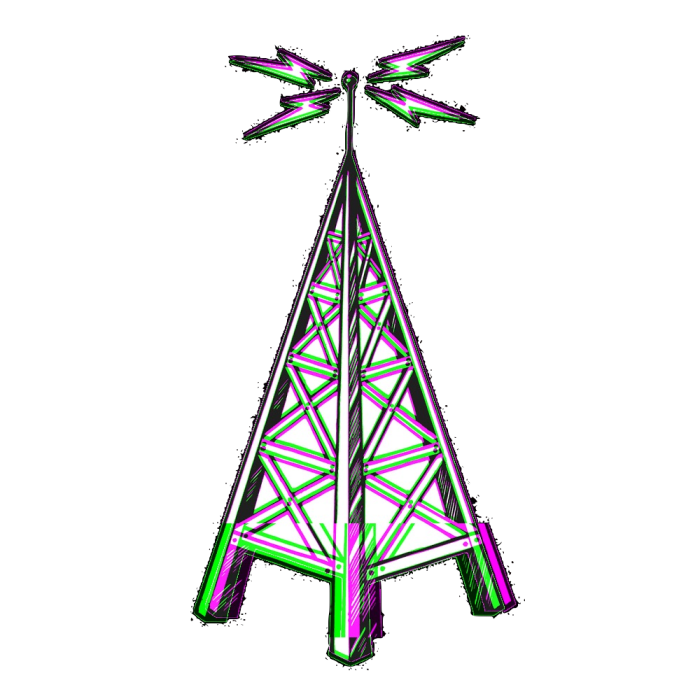 Artists and friends: Where are we with streaming services and delivering your work to fans? I have only ever used FB streaming, but it is decidedly “one-way,” and they get cranky about copyright. (Ditto for IG, but at least there you can have two-way interaction fairly easily. Can you add more than one person on IG, I wonder?)
Artists and friends: Where are we with streaming services and delivering your work to fans? I have only ever used FB streaming, but it is decidedly “one-way,” and they get cranky about copyright. (Ditto for IG, but at least there you can have two-way interaction fairly easily. Can you add more than one person on IG, I wonder?)
I use Skype for straight conversations, and I have only ever used it for recording / playback, never for a live show. It seems like it might work, but I’m not sure Skype is ideal for a streaming / broadcasting service.
Marla used Zoom the other day, but it sounds like someone needs to either pay for the service, or have credits of some kind, to use it. But that allows any number of users to all interact, and I imagine there are other’s that don’t cost.
What I’m looking for: a free two-way (at least) service that I can use to send video / audio to any number of people easily (and publicly). I would also like to be able to “add” callers / viewers to the stream, and receive / capture the incoming audio so I can mix it into the show.
Preferably, I’m looking for a software / computer solution, and not a phone app, but I’ll be curious what anyone uses, and for what, regardless of the tech.
I’m almost to the point where my office is clean / re-designed, and I want to start broadcasting as soon as I am able. I have turntables, tape decks, and CD players (in addition to a number of digital options), so I feel like this would be a good time to get into regular broadcasts again. What are people using?
Just imagine all the amazing life-lessons and self-reflective epiphanies we are obstinately NOT learning as we all collectively stare into the abyss?
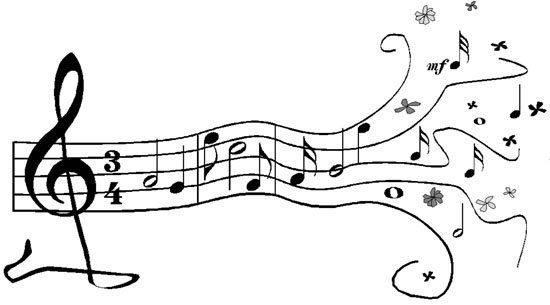 I have a lot of unreasonable musical opinions. “I can’t stand arias. All country music after 1975 is crap. Shellac is good.” We’re all guilty of it, and we all say the most extreme inane untrue bullshit, partially informed by taste, and largely informed by how we FEEL at the moment.
I have a lot of unreasonable musical opinions. “I can’t stand arias. All country music after 1975 is crap. Shellac is good.” We’re all guilty of it, and we all say the most extreme inane untrue bullshit, partially informed by taste, and largely informed by how we FEEL at the moment.
What kind of unreasonable music opinions do you have?
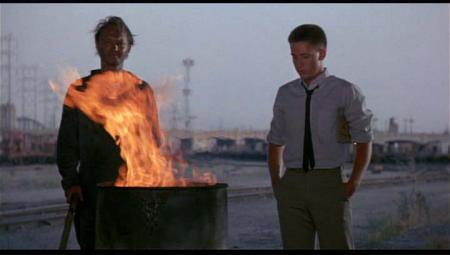
“Miller: A lot of people don’t realize what’s really going on. They view life as a bunch of unconnected incidences and things. They don’t realize that there’s this, like, lattice of coincidence that lays on top of everything. Give you an example, show you what I mean. Suppose you thinking about a plate of shrimp. Suddenly, somebody says, like, plate, or shrimp, or plate of shrimp. Out of the blue, no explanation. No point looking for one, either. It’s all part of the cosmic unconsciousness.
Otto: You eat a lot of acid, Miller? Back in the hippie days?
Miller: I’ll give you another example. You know the way everybody’s into weirdness right now. Books in the supermarkets about Bermuda triangles, UFOs, how the Mayans invented television. That sort of thing.
Otto: I don’t read them books.
Miller: Well, the way I see it, it’s exactly the same. There ain’t no difference between a flying saucer and a time machine. People get so hung up on specifics. They miss out on seeing the whole thing. Take South America, for example. In South America, thousands of people go missing every year. Nobody knows where they go. They just, like, disappear. But if you think about it for a minute, you realize something. There had to be a time when there were no people. Right?
Otto: Yeah. I guess.
Miller: Well where did all these people come from? Huh? I’ll tell you where. The future. Where did all these people disappear to? Huh?
Otto: The past?
Miller: That’s right! And how’d they get there?
Otto: The fuck do I know?
Miller: Flying. Saucers. Which are really? Yeah you got it: Time machines. I think a lot about this kind of stuff. I do my best thinking on the bus. That’s how come I don’t drive, see.
Otto: You don’t even know how to drive.
Miller: I don’t want to know, I don’t want to learn. See? The more you drive, the less intelligent you are.”
 Danced and DJed on Instagram with Holiday Special for an hour.
Danced and DJed on Instagram with Holiday Special for an hour.
And called into The Sound of Tomorrow, just to say, “Hi!”
Apparently, Instagram can’t abide copyright infringement, so I guess there’s no evidence.
But I got a hell of a lot of steps in, that’s for sure.
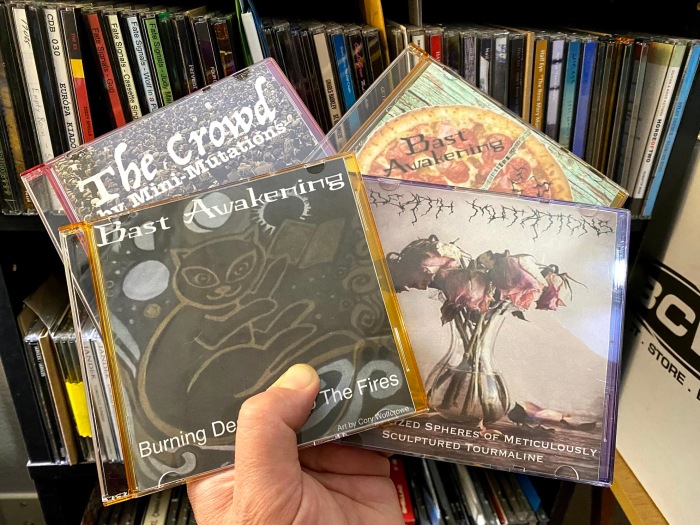 It’s a new release for the spring, with new music from all your favorite Experimental Artists.
It’s a new release for the spring, with new music from all your favorite Experimental Artists.
Three new tunes by Bast Awakening! (Ellen & Chris)
A new jam by DEATH MUTATIONS. (Chris & Myself)
…and…?
Over an hour of new music, and it can only be yours, easily, if you want it. Not available for download (yet), if you must have this, you’ll also need a CD Player.
Hand made music! Discs assembled and duplicated, with covers cut / folded / stapled by hand! Limited to 50 copies! Reversible covers allow you too present this disc in four different ways!
It’s the WTBC Three-Way Split! Get yours today!
This common bit of wisdom from my early days as a young gammer has been on my mind a lot lately – “Health Is A Team Resource” – and I’m surprised that someone else hasn’t already made a meme.
This was, of course, advanced thinking to a lot of gamers. So many are focused on just themselves, and so they don’t consider the health of others. Often, these kinds of characters don’t last long. They don’t know how to act as a group, and so they often die under embarrassing circumstances. Largely because they didn’t put the group over their own desires.
Here’s my take on a meme for our time. I have a feeling someone else could probably do something a little more concise, but at least the sentiment is there.
The Ides of March was upon us, and rather than cower in fear – which seems to have been what we should have done – The Olsen Twins Ghostlight Ensemble convened for a Sunday morning recording session that just so happened to tickle our fancy. Hopefully, you enjoy this one, too.
This arrangement includes: Scott Eave (Guitar, Woodwinds), Kevin Van Walk (Drums) & Austin Rich (Ronald’s Luggage / Electronics / Synths).
The Lava Lamp Lounge has been a nice room to host a number of folks, and this particular arrangement is very nice. It sounds good, and I think we play well in this space. And this might be the primary way you hear us from now on, so we’ll continue to iron on the way we present these to you. Maybe we can improve the camera stuff in the future? Hard to say.
Perhaps you can pick up this recording, and help keep us in new strings and cables? It’s really our primary expense, and we want to keep bringing this to you, somehow.
 I’m assembling packages / mail to go out. If you ordered a t-shirt, a zine, or are in any of the music exchange groups, and you are expecting something, it should be in the mail by the end of the day.
I’m assembling packages / mail to go out. If you ordered a t-shirt, a zine, or are in any of the music exchange groups, and you are expecting something, it should be in the mail by the end of the day.
Did I overlook you? Do you want some mail art? Or, even, just a letter in the mail? I’m not sure if we should worry about costs at this time. Let’s just make sure the people who want something in the mail are getting it.
I’m happy to send you something. No one needs to suffer from the “no mail” blues.
A lot has changed in a few days.
I hope I can change enough myself to keep up.
I’m considering hosting some organized streaming events, to give us something to do with this technology we all have in our pockets.
It would probably have a host who organizes the event and manages a calendar of who is doing what when. The host would DJ and introduce the performers, tell people where the next stream is and how to find the music to purchase, etc. And then you could have performers log on throughout the show, and do their thing.
If nothing else, it would incentivize a lot of us to clean our offices or practice spaces.
When I discovered punk rock in the early ’90’s, one of the things we talked about was how we were living in the apocalypse already, and the rest of the world hasn’t yet caught up. (Cathead even had a song about it, of which this is the best recording.) Most subculture seems to have been “hip” to the notion that all of THIS <waves hands around our civilization> could just <snaps fingers>, and then we would have to live with what it’s like when people stop being nice and start being… well, untethered to cultural references, anyway.
So, there is a tiny part of me — a very, very small part, I should underline — that feels like I’ve seen this coming for 20 years, at least. The writing was on the wall when The Ramen City Kid and I realized that Eugene was no longer viable, and as we looked around, all of our options were… bad. The punk in me always knew that all of this was temporary, even the rock and roll paradise that Portland seemed to be when I got there.
Anyway, in light of this crisis — this very real, very bad, and very-likely-to-have-LONG-TERM-consequences-that-we-have-not-really-fully-thought-through crisis — there is a part of me that keeps thinking, “Well, how is this different from how punks and weirdos have always seen the world?” We’ve been catastrophizing everything for decades, screaming at walls and coloring our hair as brightly as possible, to try and wake all of you up into looking past what you expect to see.
It’s like, the rest of the world needed this many catastrophes and crises to happen before they finally see the world the way punks do.

Sometimes, I want to put everything on hold and just do nothing for a few days. But the moment I sit down to take a break, I just start working instead.
If only I knew how to relax.
And something thinking.
I watched a movie with Marla that we both knew pretty well. On the whole, it was pretty casual.
I spent the day making merch. It’s looking good. You want one? Message me. There’s a limited quantity, and I want the people who will like this to get it. It’s a three-way split CD, Bast Awakening (Ellen & Chirs), DEATH MUTATIONS (Chris & Myself) and Mini-Mutations. All the primary work is done. All that was left was the printing, disc duplicating, folding, and assembling.
And, of course, thinking about how I want things to look, and where I want things to be, in the future.
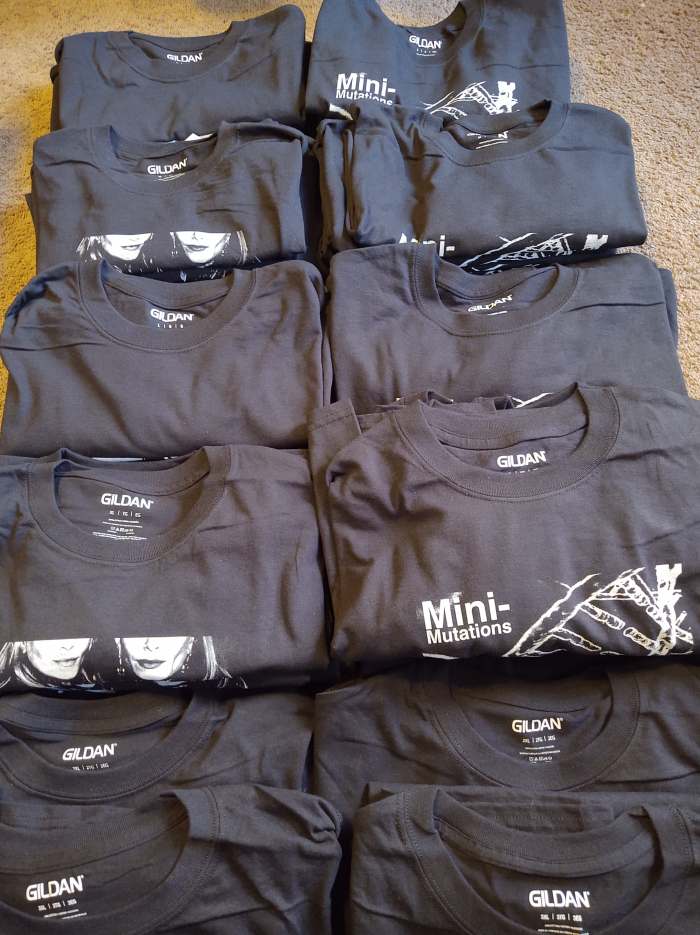 T-Shirts Are Now Available For A Limited Time Only!
T-Shirts Are Now Available For A Limited Time Only!
Mini-Mutations Shirts
(Limited Quantities! S, M, L, XL or 3XL Still Available!)
The Olsen Twins Ghostlight Ensemble Shirts
(Limited Quantities! S, M, L, XL, 2XL or 3XL Still Available!)
100% Cotton. $20 Each. Until they are gone.
* * * * * *
In the 27 Years that I’ve been making ’zines and playing in bands, there have been painfully few t-shirts that were ever available to the public. So, it is with no small amount of fanfare that we are offering, for a limited time, a selection of copy- and trademark infringing shirts by Mini-Mutations and The Olsen Twins Ghostlight Ensemble, for the low-low price of $20 apiece. ($25 shipped.)

When these are sold out, there won’t be anymore. If we make more shirts in the future, they will not look like this. And who knows if that will happen again, to be honest? I’ve never sold shirts, so this is a bit of a gamble. And, there’s a limited quantity, too, to add another wrinkle to this puzzle.
These shirts are screen printed by hand, by our lovely friend Sarah Kindl, on 100% Cotton black shirts, in a fetching monochromatic arrangement that looks good on anyone, and shows your support for the kind of music you would like to discuss at parties. (And, in the case of the Twins shirts, will ensure a long conversation about the reference that will be lost on many in this day and age; the perfect gift for the aging hipster with a strange sense of humor!)
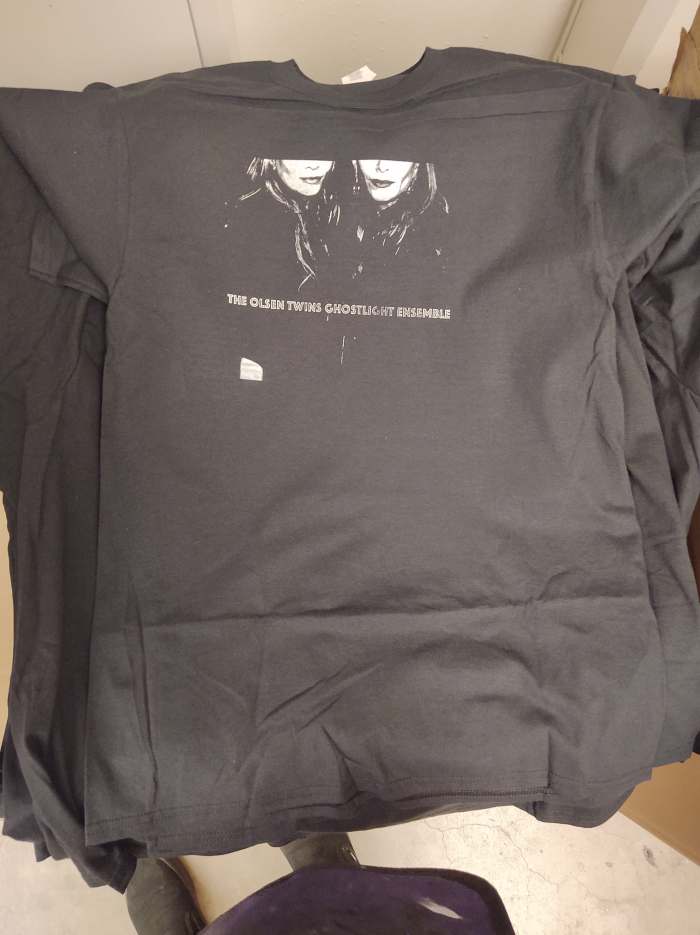 These will be available to buy at the end of February / Beginning of March. HOWEVER, for fans who cannot live without, you can pre-order these NOW, to ensure that you will have the shirt you want.
These will be available to buy at the end of February / Beginning of March. HOWEVER, for fans who cannot live without, you can pre-order these NOW, to ensure that you will have the shirt you want.
I’ll be straight up: these shirts look great, I think you are gonna like them too, but there aren’t that many. If this is a success, then there might be more in the future… but not like these. Right now, this is a test. I believe in these. I think they are in the spirit of both projects, and I want these to get into the hands of people who like that stuff I do, like these designs, and: like t-shirts.
Considering all of those factors, I am recommending you should reserve your shirt today. It’ll secure your shirt when they arrive, and it’ll help me weigh the possibilities of doing this again at some point in the future.
To make a reservation: e-mail austinrich@gmail.com with the subject line, “RESERVE MY T-SHIRT.” In the body of your e-mail, please specify the shirt you want; which project, and which size.
ACRONYM, Inc. T-Shirts, Now Available.
Until They Are Gone.
(You can always get the current listening information for our programs on their respective websites: Mid-Valley Mutations and WTBC Radio In Beautiful Anywhere, Anywhen!)
******
When I first started in radio in 1998, there were often scheduling changes that you just couldn’t announce to anyone short of calling them directly, or through putting up a flier. I used to advertise scheduling changes in my zine back then, and often, listeners didn’t really notice the change. The way radio works — both then and now — is that the LISTENER is choosing to turn on the radio when THEY want to listen. If I happen to be on the air, then that’s a lucky break for me. I’ll have to let the listener decide how they feel about the matter on their own.
I relentlessly taped my show, on cassettes, and I offered edited copies of the show in my zine. I never sold one. When I got the technology to transfer tapes to CD, I digitized my shows, and offered them on CD. Again, never sold one. It wasn’t until the technology existed to post full radio recordings online — certainly a 2004 and later innovation for me — that there was any demand for my show in a form other than the original broadcast, and while I’m glad I recorded my shows for the sake of keeping an archive, in a lot of ways, those recordings are for me alone.
Anymore, what people seem to want from my show are two separate and different things by two different groups of people:
The first group, they want a live, real-time radio-listening experience, that they can either tune in for or stream as it is happening. And this group of people is usually different than the group that wants a timely podcast episode to appear in a dependable (and regular) podcast feed. This change was almost immediate; I began to hear from two different kinds of listeners after I launched the podcast feed for my show in 2004, thanks to KPSU having adopted the technology for all their programs back then. And, for the most part, the live show and the podcast are the same; the latter is a recording of the former. I’m really just producing one show, and it’s being distributed in two different ways. It’s sort of like old school syndication, but I don’t have to deal with mailing CDs out to anyone. They can just subscribe digitally and enjoy.
All of that is a long way of saying that, since 1998, the distribution model for my radio show has changed so many times that I can’t even keep track of everything, save for the spare announcements I make about it on old episodes of my program. So announcing changes are nothing new, and, in fact, can help bring the show to new people at a time new listeners would appreciate jumping on.
With all of that in mind, let me introduce you to the NEW broadcasting schedule that we will be working with, for the foreseeable future, and give you a small glimpse into what the next for radio broadcasts will contain.
2. This Is Now
Here’s when you can hear the show, now, primarily:
We are happy to return to the airwaves of KLFM.org in beautiful Split, Croatia! We have been syndicated on KLFM before, and we love working with them. So, beginning TOMORROW, you can hear our show on their station again.
WEDNESDAYS: 3 PM – 5 PM PST (12 AM – 3 AM CET): You can listen to our show live!
This is an interesting time of day, as it is the end of the work day for people who work in offices on the West Coast, it is an early evening listen on the US East Coast, and is late night fare in Europe. (It’s EARLY morning fair for half of Asia, and wake-up / breakfast listening for the rest.) So, hopefully, people who enjoy experimental radio in those parts of the world will enjoy this program, humbly coming to you from Salem Oregon, by way of Croatia.
As to not spoil those who want to tune in live and hear something new, the podcast will not drop until 3 PM PST. So, if you are the kind of person who listens to podcasts as they are released, you’ll hear it in tandem with the Live Listeners on KLFM. Or, you can enjoy it at your leisure, whenever.
There is, however, a need for me to set aside a time to produce the show. And, as some people have become interested in this element of the show, there will be a special time, set aside, for true believers to enjoy the program before anyone else does, via a live streams on social media. We’re still in the beginning phases of testing this, and making sure that we can do this in a sustainable and manageable way. But I will be recording the shows at a scheduled time anyway, so I might as well right? Join me at:
SUNDAY MORNING, 8 AM to 10 AM PST on Social Media for a live streaming version of the show.
Since these streams are not for everyone, and require a certain amount of dedication to enjoy, they will be for those who want to really be a part of the show. I’m hoping to get interactive phone and Skype boxes added to the studio, so that people can get in on the old “Audience Participation” element of how I used to do radio. (Seldom used, but often mentioned when I was live.) However, that will require getting some new gear, which may take a while, so don’t be surprised if the show sounds a little “canned” for a while. Until we can get the new gear, we’ll do our best to deliver a low-tech version of the show that you can interact with in real-time, and someday, we’ll try to deliver a higher quality version.
Another point of order on scheduling: We will be producing a radio show every week, but if you tune in every week, you will hear two different programs: “Mid-Valley Mutations” on one week, and “WTBC Radio” on the other week. Both shows will be heard on KLFM.org during the aforementioned time-slot, but will be available in their own podcast feeds.
This gets at a problem that I’ve mentioned before: I love doing more than one radio show, and I have many ideas for many kinds of radio shows I want to do. But doing two weekly shows is a bit much for one person to handle, especially for someone who doesn’t get paid to do any of this. So, by changing the release schedule, and doing the “every other week” dance like this, I’m able to produce both shows, at a rate I can manage, and keep the quality at the same level it’s been at previously, which is important to me. So hopefully you don’t notice the shows dropping in quality, only in how often they come out.
One final concern: KMUZ. I started “Mid-Valley Mutations” on KMUZ, in spite of the program having roots that go back to 1998. The new direction and name for my 20 year old show was a sort of a re-christening, as I attempted to pursue a vision that felt important to me. Out of the show that I grew at KMUZ, I developed Mini-Mutations, my musical act that has become another creative outlet that I value, and KMZU became a place where I could try and find my voice in a radio world that has many who say very little. KMUZ never censored the program, and never told me to change anything. They encouraged me to make the show I wanted. KMUZ made “Mid-Valley Mutations” possible, and as “Mid-Valley Mutations” moves on to continue finding itself, this is not because of any problem or issue with the place that helped grow us. In fact, I am developing a new program with them right now, which should be announced very soon. But recently I realized that “Mid-Valley Mutations” needed to grow a little more in order to become what it has always wanted to be, and that might need a place where I can go long or short if I need to , a place where the language restrictions might not be as tight, and a place where I can REALLY get experimental without fear of alienating the listener base that KMUZ has so carefully grown. So, this isn’t a parting of ways with animosity, or any negativity at all. I’m excited to find out how my new KMUZ show goes over. But “Mid-Valley Mutations” has gotten some wanderlust, and it needs to roam free in a way that KLFM is only happy to allow. I think, if I was to try and pursue these changes at KMUZ, it would really ruin the mood for everyone.
3. And What About Then?
With all of that said, here’s a tentative calendar of upcoming shows, for the listener who might want to get the feel for the every-other-week low-down, and who might be curious about the next couple of guests on WTBC. It’s exciting to not only have a schedule, but to have carved out blocks of time where I can get my radio done, and not feel like it’s always a rush.
Questions? Suggestions? You know who to call…
05 February: MVM #180
12 February: WTBC: Scot Jenerik
19 February: MVM #181
26 February: WTBC: Jeremy Hight
04 March: MVM #182
11 March: WTBC
18 March: MVM #183
25 March: WTBC
And so on…
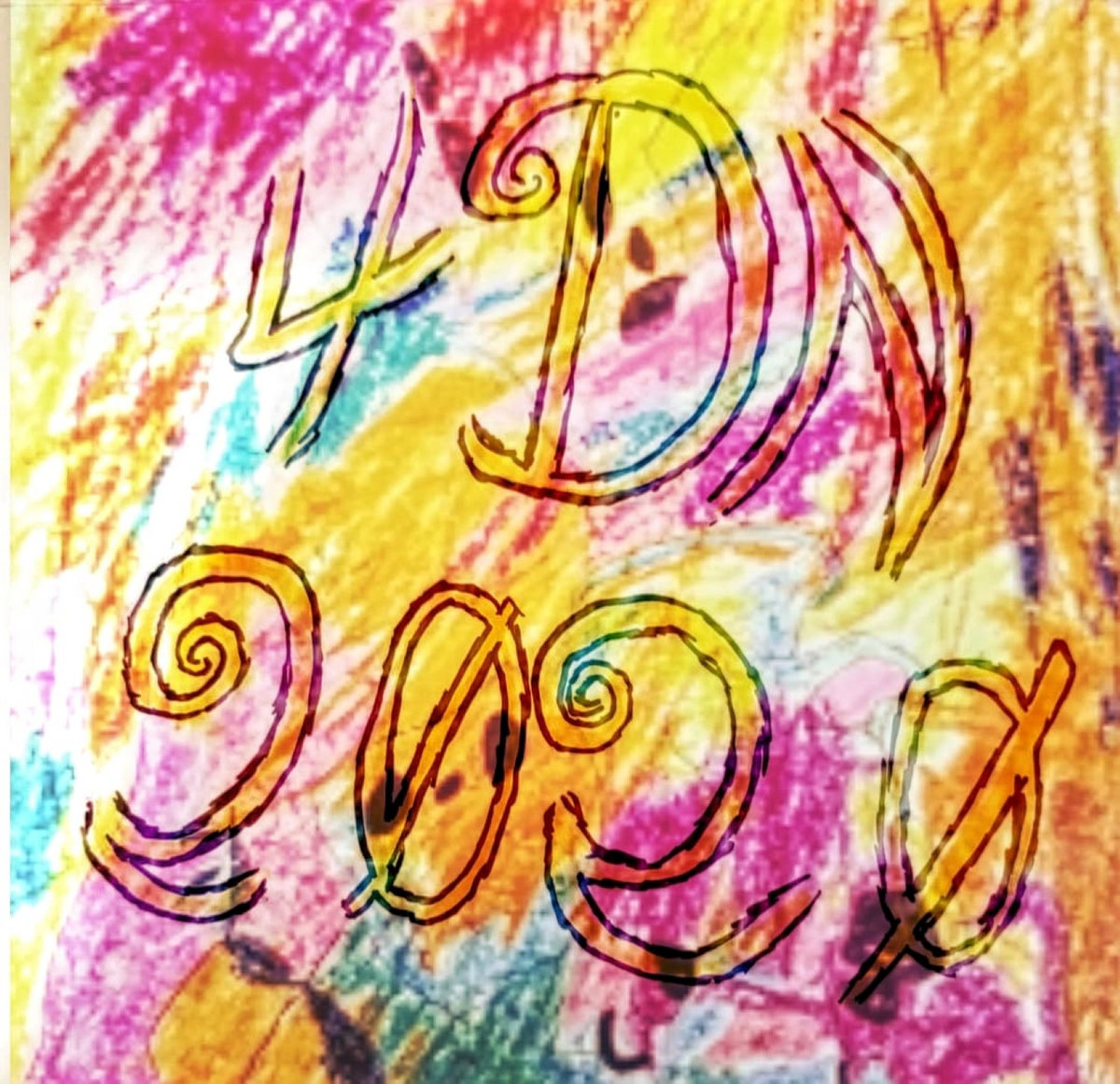
Four Dimensional Nightmare – 4DN 2020 (Self-Released)
Reviewing the last decade of Four Dimensional Nightmare releases offers a wonderful glimpse, and incredible insight, into what they have accomplished on this most recent release, 4DN 2020. And even that narrow window into the career or this artist probably omits some of the more impressive, and compelling, work. But that does us no good if we are looking for an entry point into this album. To suggest that we should examine the scope and sweep of their career to fully understand what this album is about is akin to saying, “You need to see 23 movies before this one will make sense.”
Consider it this way: if you’ve been following their carrer for any length of time, then this album continues themes and tropes that you’ve been picking up on for a while, and certainly is rewarding in that respect.
But that doesn’t do a new listener much good, does it? To say that 4DN is continuing to explore places they hinted at in previous releases is not a decent map for someone about to enter into the kind of darkness predicted by track 5, a beat-driven track almost unlike anything else you’ve heard on a Nightmarish release like this. Layered over the industrial rhythms and strange dance jams are these synth explorations that beg for scrutiny and consideration, and that doesn’t even address the ebb-and-flow soundscape that eerily weaves through the various performances, almost hinting at a Haunted House. This is a dense track, not exactly a great entry point if you were hoping to be eased into this artist, but is perfect for getting to know the mind of Four Dimensional Nightmare.
“Beta Tonic” shakes with a low-end pulse that really caused my head to turn, another track I love, but I’m not sure if it is the way “into” the oeuvre of this artist. Certainly, you are better off trying to catch one of their rare performances, as that, I think, better lets you get a sense of where this stuff is coming from, and perhaps, how you can get in synch. But “Beta Tonic” builds in a way that feels like something new, and I was excited to let it have it’s way with me.
It’s with repeated listens that this album really shines. The hallmark of any Four Dimensional Nightmare album is certainly density. There are layers and layers on any given song on any given album, and there is a weight to a 4DN track that seems heavy with multiple, nuanced performances. You need to re-listen to really get a sense of what’s going on.
What feels new this time around is there is a clarity to the layering, either through careful production or higher quality facilities, that gives you a chance to focus on the different synth lines as they dance around each other. This is a great record for leaving in your car, so you have to return to it over and over again, without needing to change anything. Each time through, something else sticks out, and these bits that catch your attention give you something new to dig into.
The production seems unmistakably first class, and to my ear, this is a major evolution. It’s no wonder Four Dimensional Nightmare makes regular appearances on Mike Watt’s program, as this album illustrates the strengths and boons that are the hidden gems on every 4DN release.
Certainly, the nerdiness is worn on the sleeve of this group, and that is probably never more apparent than on the opening track, “Pi,” which contains some of the first lyrics I’ve heard on a release is years. This comes with the territory; someone playing around with this many synths for this long is bound to get wrapped up in some of the more science-informed subjects, as time goes on. But there are also moments of pure joy and frenzy, like on “Beta BonZyard,” where the ferocity of the Nightmare comes into sharp focus, only to have moments of almost beautiful sounds come forward out of the burbling chaos.
If anything, this is the work of someone who has been at it for a while, and this release not only highlights the expertise with which Four Dimensional Nightmare produces new work, but the repeated listenability of a record that is as experimental as the genre actually suggests.

Four Dimensional Nightmare – 4DN 2020 (Kill Pop Tarts)*
Reviewing the last decade of Four Dimensional Nightmare releases offers a wonderful glimpse, and incredible insight, into what they have accomplished on this most recent release, 4DN 2020. And even that narrow window into the career or this artist probably omits some of the more impressive, and compelling, work. But that does us no good if we are looking for an entry point into this album. To suggest that we should examine the scope and sweep of their career to fully understand what this album is about is akin to saying, “You need to see 23 movies before this one will make sense.”
Consider it this way: if you’ve been following their carrer for any length of time, then this album continues themes and tropes that you’ve been picking up on for a while, and certainly is rewarding in that respect.
But that doesn’t do a new listener much good, does it? To say that 4DN is continuing to explore places they hinted at in previous releases is not a decent map for someone about to enter into the kind of darkness predicted by track 5, a beat-driven track almost unlike anything else you’ve heard on a Nightmarish release like this. Layered over the industrial rhythms and strange dance jams are these synth explorations that beg for scrutiny and consideration, and that doesn’t even address the ebb-and-flow soundscape that eerily weaves through the various performances, almost hinting at a Haunted House. This is a dense track, not exactly a great entry point if you were hoping to be eased into this artist, but is perfect for getting to know the mind of Four Dimensional Nightmare.
“Beta Tonic” shakes with a low-end pulse that really caused my head to turn, another track I love, but I’m not sure if it is the way “into” the oeuvre of this artist. Certainly, you are better off trying to catch one of their rare performances, as that, I think, better lets you get a sense of where this stuff is coming from, and perhaps, how you can get in synch. But “Beta Tonic” builds in a way that feels like something new, and I was excited to let it have it’s way with me.
It’s with repeated listens that this album really shines. The hallmark of any Four Dimensional Nightmare album is certainly density. There are layers and layers on any given song on any given album, and there is a weight to a 4DN track that seems heavy with multiple, nuanced performances. You need to re-listen to really get a sense of what’s going on.
What feels new this time around is there is a clarity to the layering, either through careful production or higher quality facilities, that gives you a chance to focus on the different synth lines as they dance around each other. This is a great record for leaving in your car, so you have to return to it over and over again, without needing to change anything. Each time through, something else sticks out, and these bits that catch your attention give you something new to dig into.
The production seems unmistakably first class, and to my ear, this is a major evolution. It’s no wonder Four Dimensional Nightmare makes regular appearances on Mike Watt’s program, as this album illustrates the strengths and boons that are the hidden gems on every 4DN release.
Certainly, the nerdiness is worn on the sleeve of this group, and that is probably never more apparent than on the opening track, “Pi,” which contains some of the first lyrics I’ve heard on a release is years. This comes with the territory; someone playing around with this many synths for this long is bound to get wrapped up in some of the more science-informed subjects, as time goes on. But there are also moments of pure joy and frenzy, like on “Beta BonZyard,” where the ferocity of the Nightmare comes into sharp focus, only to have moments of almost beautiful sounds come forward out of the burbling chaos.
If anything, this is the work of someone who has been at it for a while, and this release not only highlights the expertise with which Four Dimensional Nightmare produces new work, but the repeated listenability of a record that is as experimental as the genre actually suggests.
* When I firsts reviewed this album, it was self-released. Now, Four Dimensional Nightmare has moved to Kill Pop Tarts.
All of these Christmas song challenges reminds me of how I managed to go all of 1999 without hearing, “1999,” by Prince. Which is still a pretty big accomplishment, in my mind.


We’re just getting started. DJ Marshmallow is tearing it up now, and you should get down here! Halloween with Major Hex, Sex Park & DJ Marshmellow at Graveyard Bar is off to a great start!
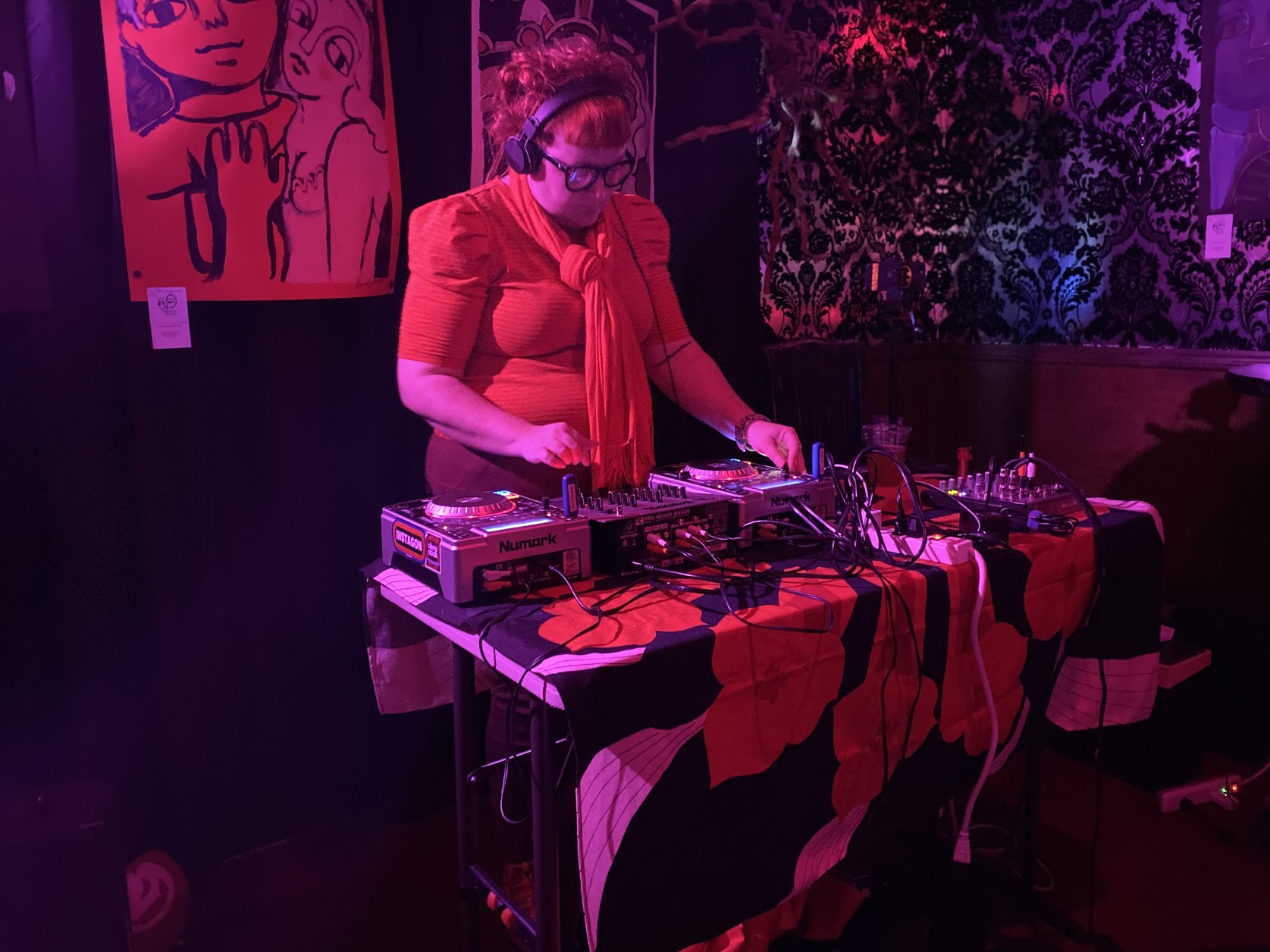
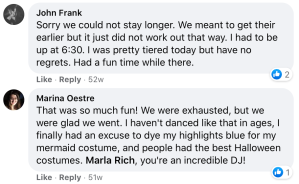
A simple Ghostbuster getting ready for work while his Rajneeshee wife stays home. (1984, colorized.)
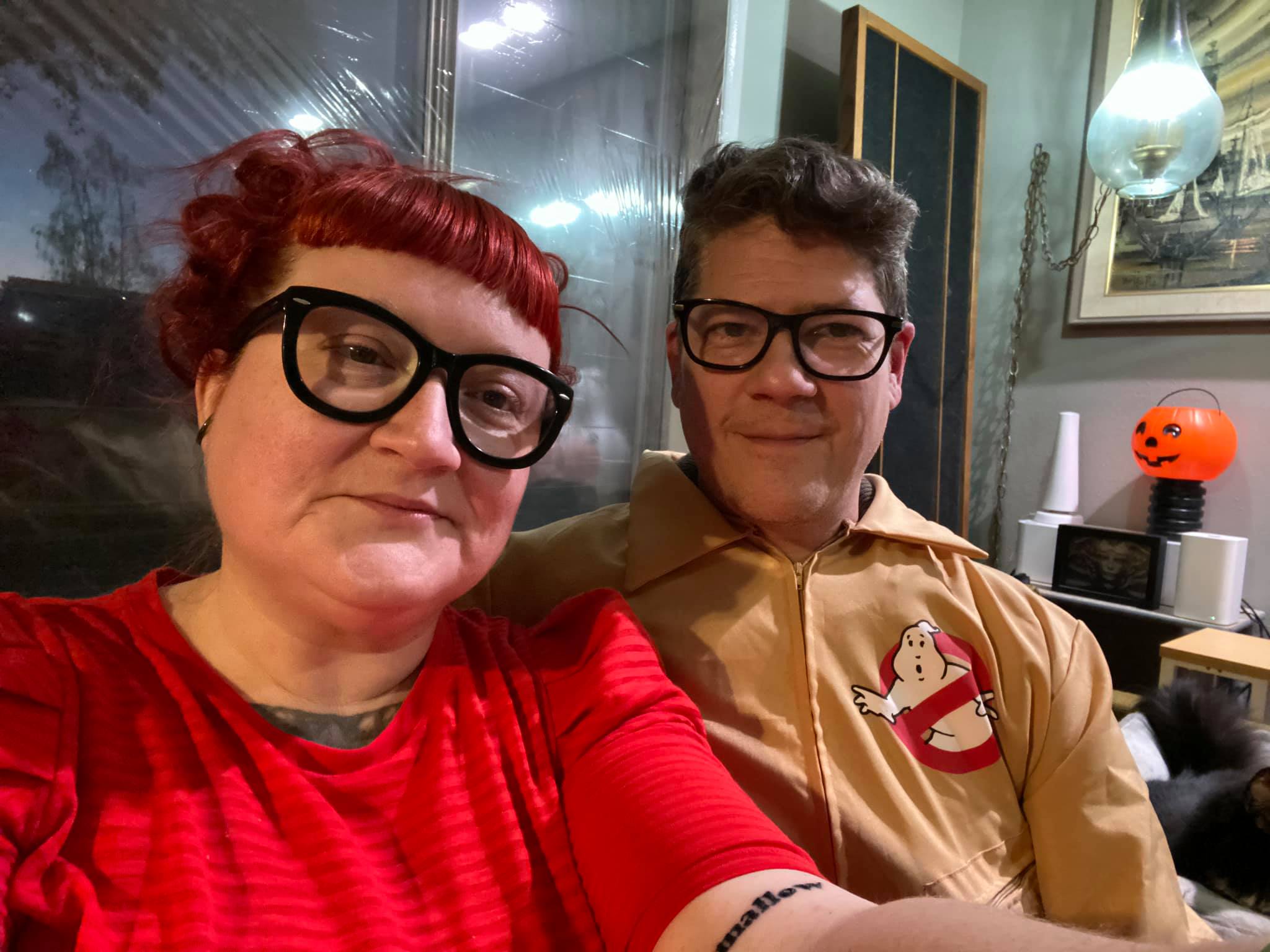
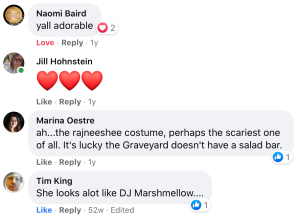
First treaters: 6:22.
![]()
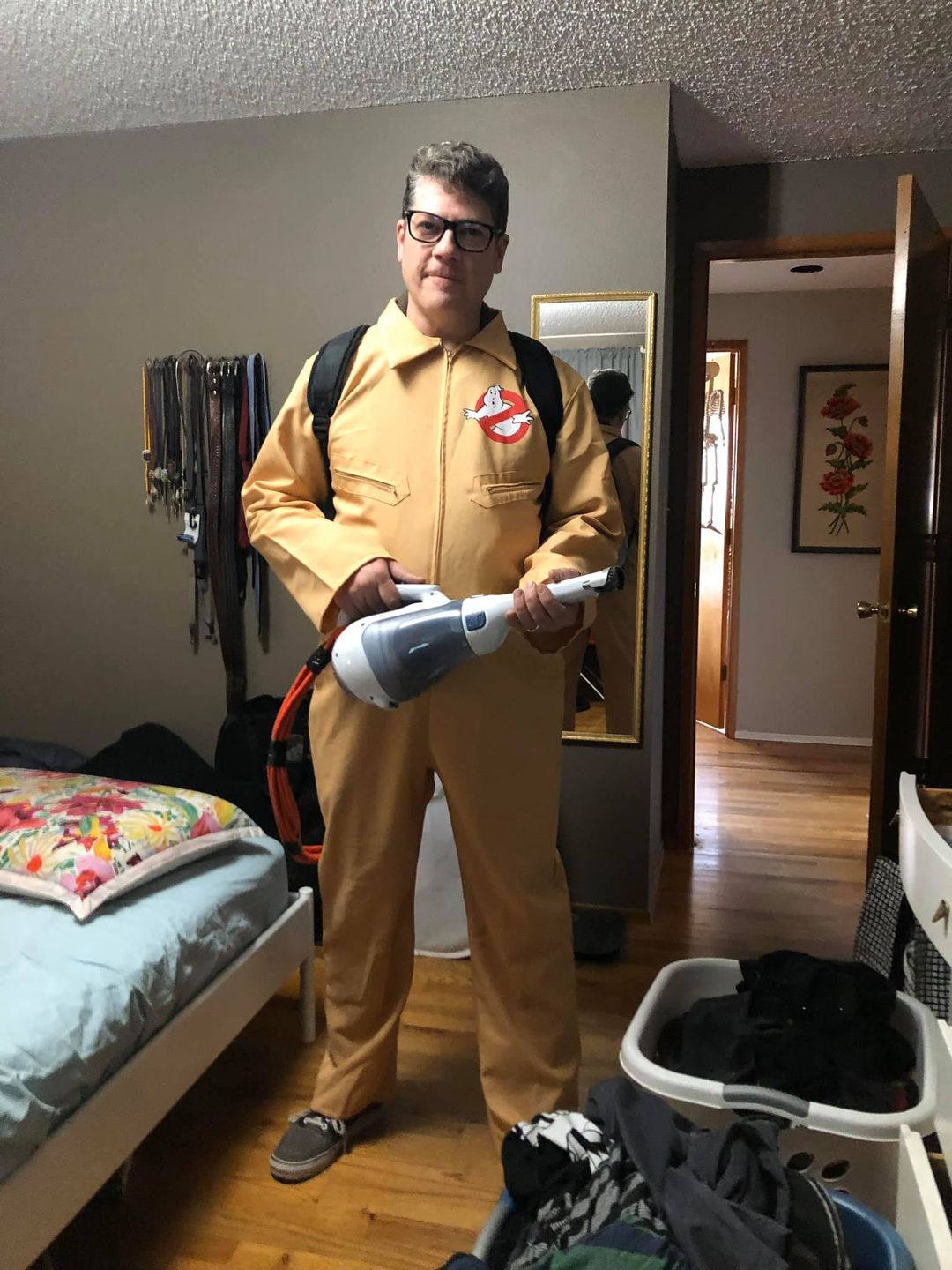

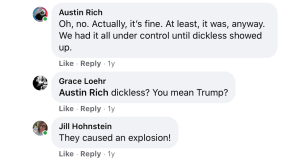

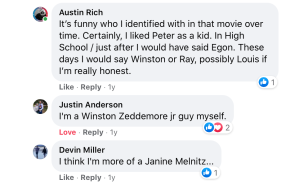

Happening now!


My new familiar, the spider.
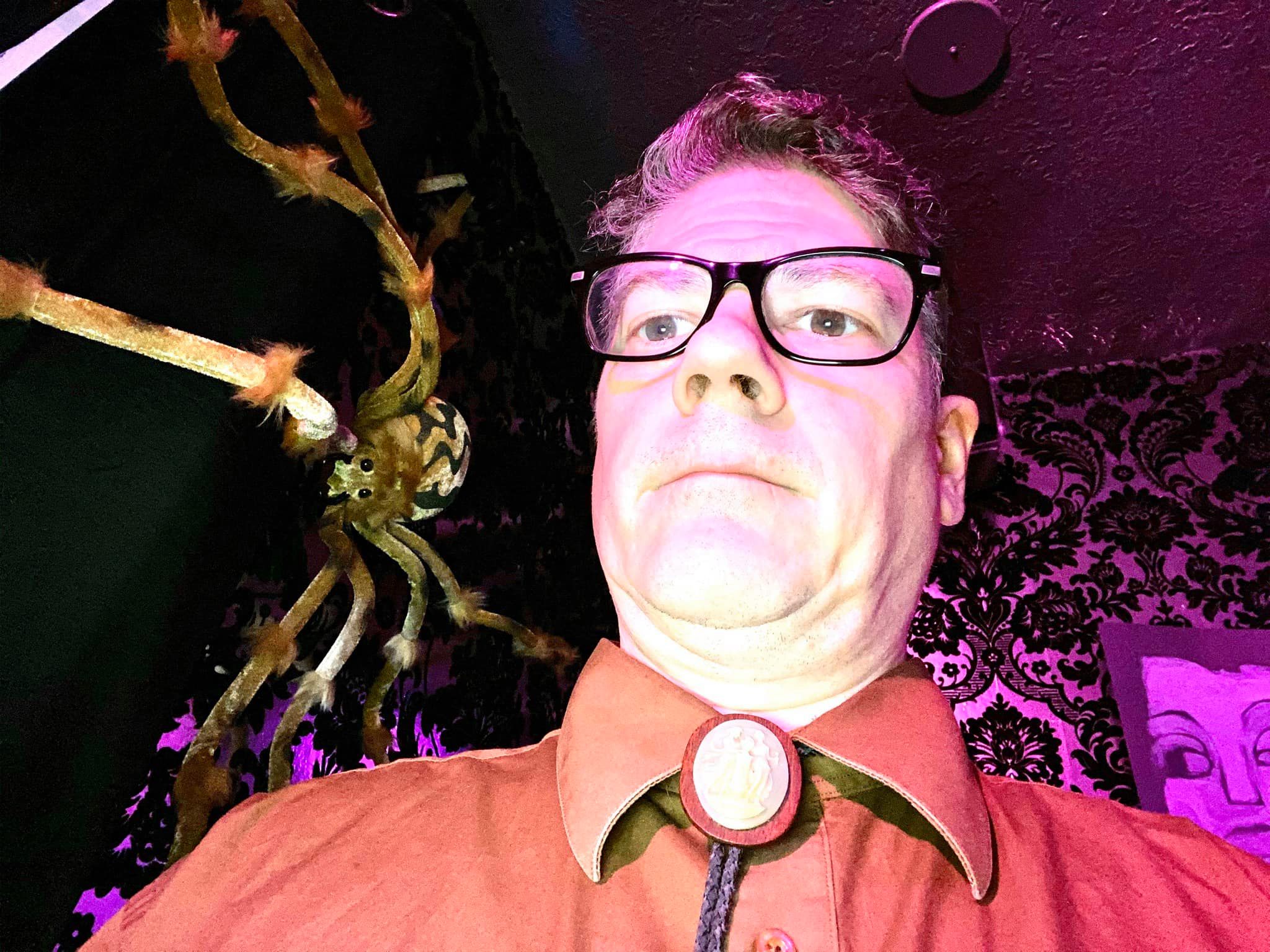

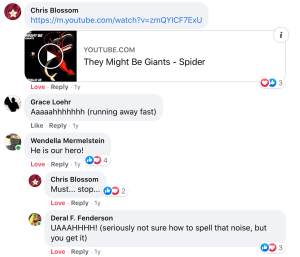

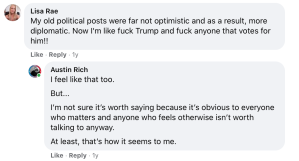
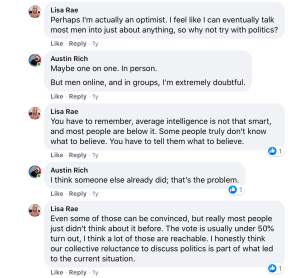
Tonight, at the Graveyard Bar: two excellent acts are coming through, and a new act that I’m playing in is opening up the show. Black Noise Orchestra is brand new, so be gentle. Sweeping dark guitars & ambient drones fir heavy dark vibes. You should check it out. A little something different, and I think you’ll dig it.

I did my first I-5 solo trip today. 30 miles is longer than I thought it would be.


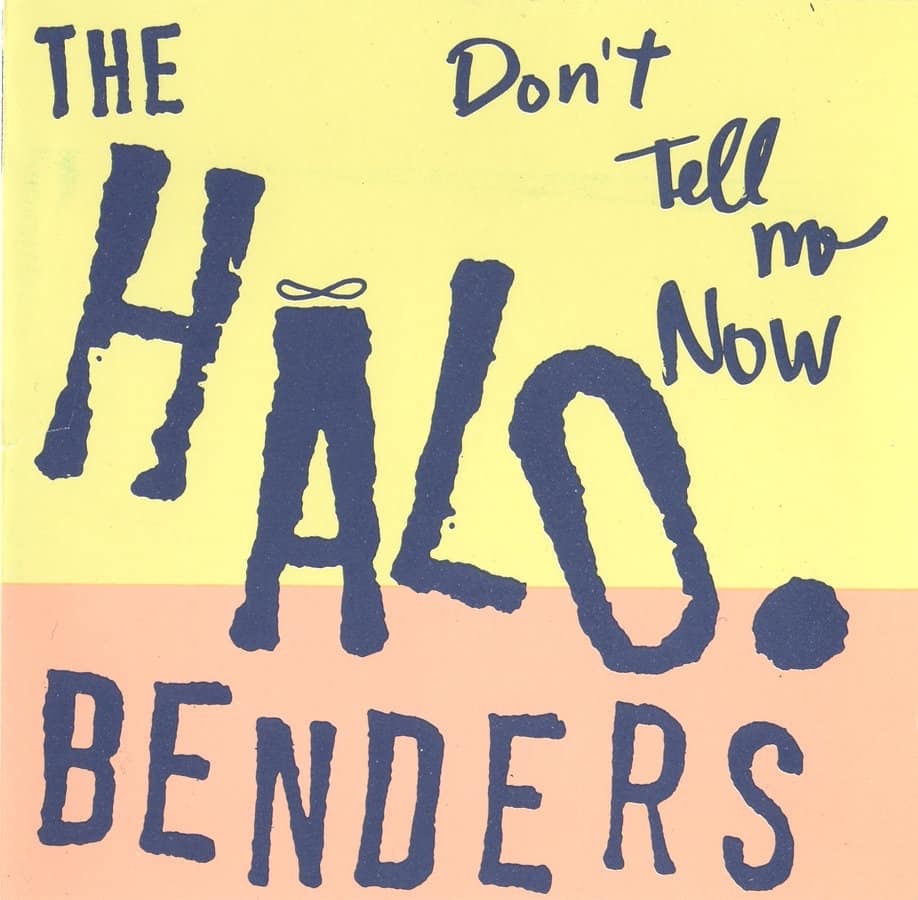


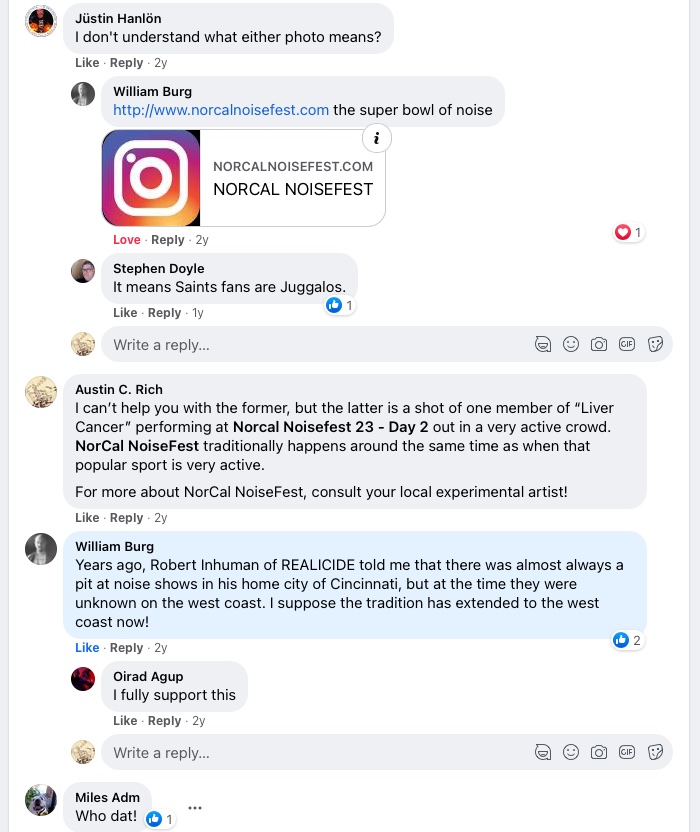
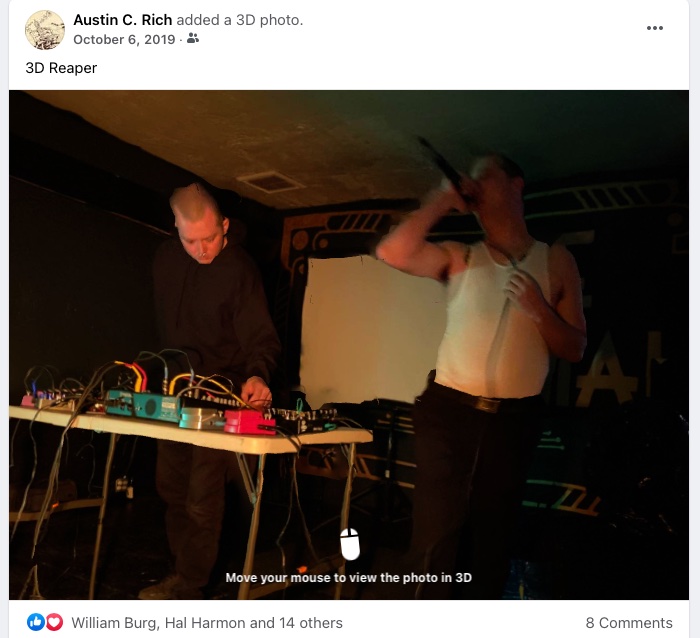



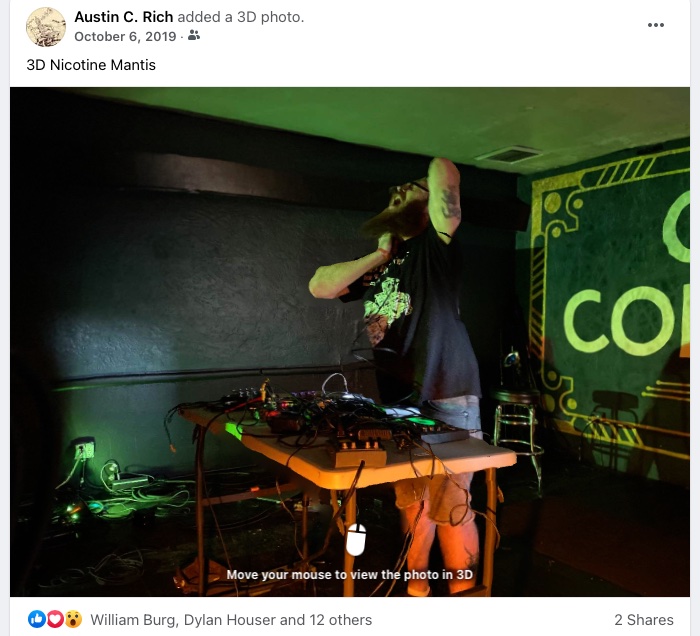
I guess I should get my day started.

I’ve been experimenting with my “reactions” here on FB, hoping to add a little more ooomph to my interactions. Mostly, this has taken the form of using the “Love” reaction more than just the “Like.”
I’m not sure why; it just started to happen, and as it was happening, I was thinking, “yes, a like is not enough for some of these, and I do mean it more emphatically than a simple thumbs up, so…” But I’m not entirely sure what motivated it. I just started feeling like the people I interact with needed more, and that I want to be a source of not just liking cool things, but loving them.
I’m not sure if it’s working, or if it has any impact. But with hindsight, it feels important. Perhaps I just want you all to know that my bitter facade is full of an aching heart who wants to know I’m thinking of you.
Maybe I should just come over and say it in person?


“Drama is exactly like farting: no one wants to be around your drama, but they certainly don’t mind their own.”
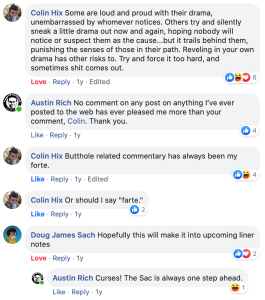
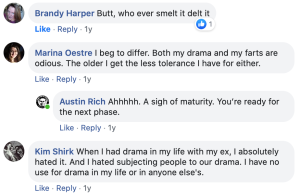
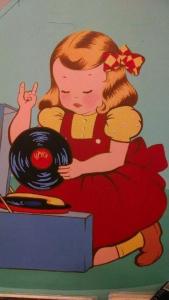
![]()
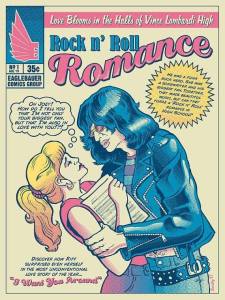
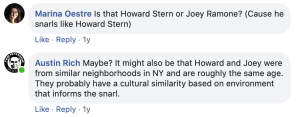
Adding to my Speed Pigs collection.


I guess Christmas is closer than I think. I should start shopping.

Speed Pigs, Girl Drink Drunks & The Buttfrenchers absolutely destroyed tonight at the Graveyard Bar. Holy shit, what a show! I can’t believe we have both Speed Pigs and Buttfrenchers as local acts. Salem is pretty fuckin’ dope.
Also: great seeing Timothy, Mickey, Joshua, Obadiah & Kat too! You can tell it’s a killer show by who turns up.
Graveyard is killing it lately! Hell yeah!



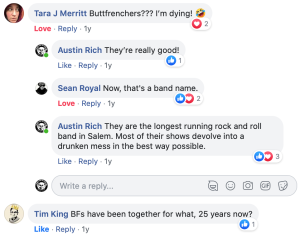
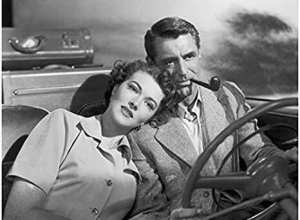 Yesterday I got into a car and drove, by myself, for the first time in my life. After years of being scared of driving, I’m now a licensed driver.
Yesterday I got into a car and drove, by myself, for the first time in my life. After years of being scared of driving, I’m now a licensed driver.
I’m not sure the full impact has hit me. I didn’t drive anywhere particularly strange, and I’m not good at it yet. But I can do it, no one honks at me, and I get there eventually. So, that’s the important part, right?
There’s a part of me that wishes I was having some sort of Springsteen-esque epiphany about how my loins and my wanderlust were somehow hopelessly entwined and I needed a hemi in New Jersey to sort that out. But it is hard to muster that feeling when you’re looking for parking and missing your turns constantly.
Errands hardly capture the teenage ego-unleashed-in-four-wheeled-fury! There is certainly more Mr. Roger’s in my driving style than there is Blues Brothers, and while I appreciate the incredible opportunities driving will now afford me, another part of me sees that 99 times out of 100 I’ll be making emergency runs to the store for coffee than I will be exploring my freedom as I search to, “ride eternal, shiny and chrome.”
And this is part of the problem: I’m not a car guy. I never was. My entire relationship with cars is from popular culture, and as I drive I can’t help but feel like Xander in, “The Zeppo,” where, in a desperate search for identity, he posits the notion that, well, maybe he’s a car guy? (Later, of course, he is not really seen driving again in the show.)
Not that I need to be a car guy to drive. But I can already predict the dollar signs in the eyes of any mechanic I visit, as they can tell within moments that I spent my time troubleshooting radio gear and arguing about Slint records rather than learning about car engines.
Nevertheless, I did get a twinge of excitement the moment I decided to add an unscheduled stop to my errands. The idea of being alone, without anyone knowing where I was, to go about my day and to see where I wind up and to be able to just go without any holdups. That does sound a little appealing.
I have spent my whole life as a passenger. Dependent on public transportation for commuting, and walking for everything else. Travel is hard, going out is not exactly easy, and I’m always the one who needs to spend far more time planning the trip because I need to make arrangements. My wife… has been tolerant, for someone who has done all of the driving for almost a decade. I know she is going to be excited to never need to pick me up from a show at 2 AM again as long as we are married.
Just the idea that I don’t have to ever beg for a ride home again is mentally exciting in a way that “autonomy” doesn’t fully capture. What does the future hold? Who can say?
So, I’m trying to be practical, yet positive, about what this really means.
And: I’m ready to drive!
I’m not sure I’m ready for a 12-Hour epic road trip at the end of which we all play a show and party all night.
But I am totally ready to meet up and offer you a ride, this time.
Because I probably owe you, and I really want to see where you’ll take me.
And less blah blah blah.
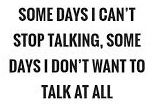 But perhaps that is the problem.
But perhaps that is the problem.
You’re free! Put your phone down and run!


If I believed in any kind of faith, you can be sure it would be more like a cross between Hellboy and The Odyssey and a lot less like the current options.
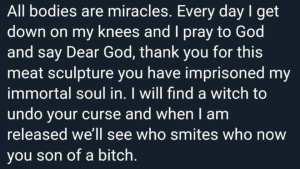


Come on down to the Re-bar Seattle for an excellent show!
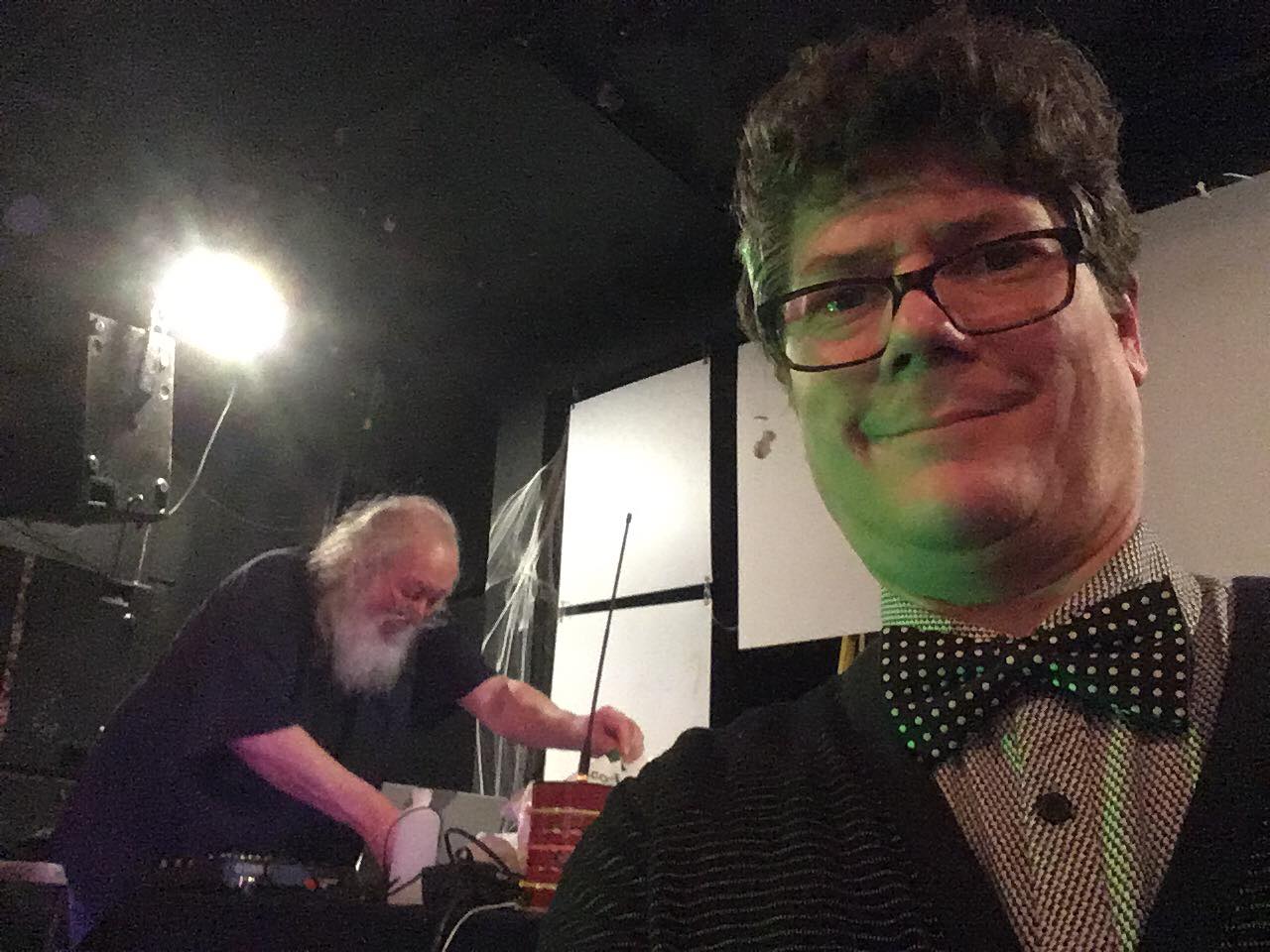


Getting ready to party tonight.
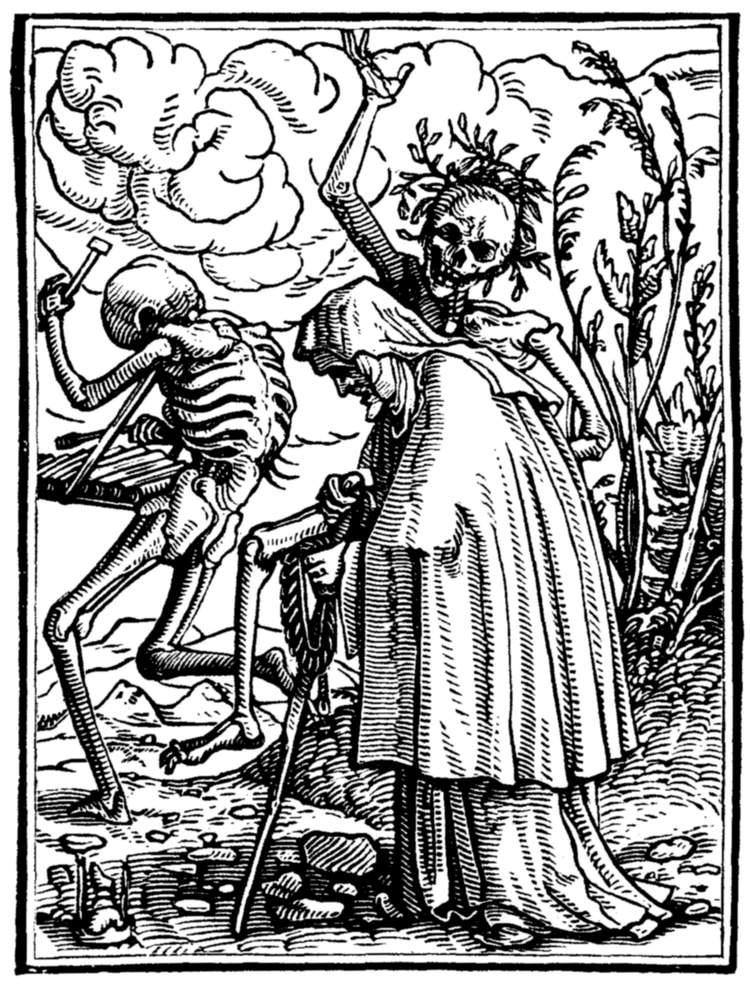
![]()

Did you hear? A black cat saw a jack-o-lantern’s candle, so we get two more weeks of Halloween.

Doing last minute prep for this show tonight. I’m not gonna lie; this tour has been an incredible experience, and it has all been building to this show, on such an excellent day, too! Buddy Runyan is kicking things off, then Mini-Mutations, Mark Hosler, and a closing set by Monster Planet. This will be THE party to attend tonight, and you will not want to miss this show. I assume I’ll see you there?

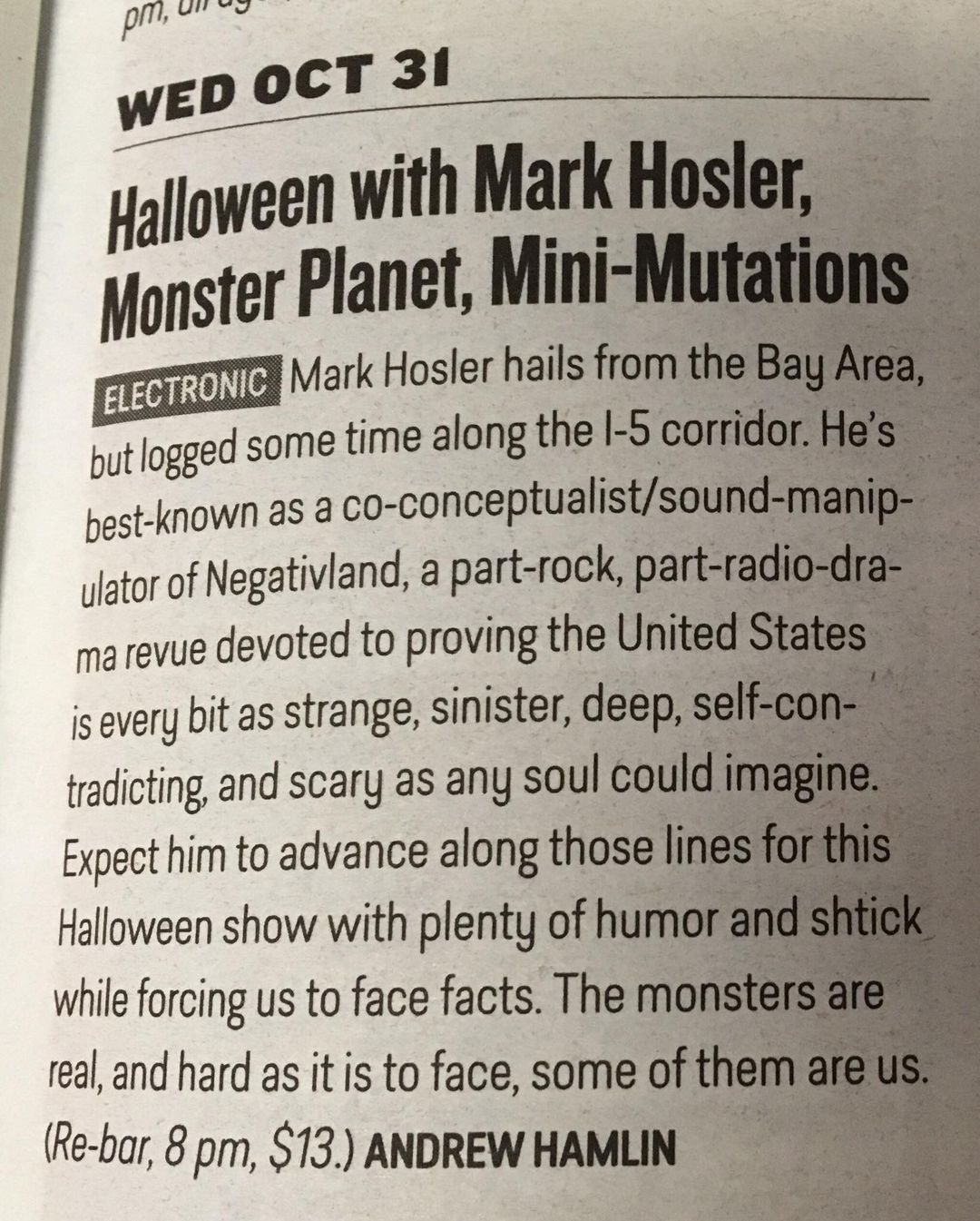
Sometimes everything is

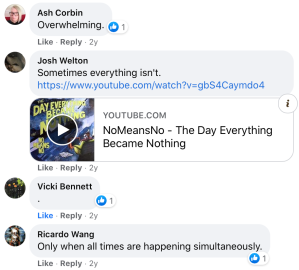

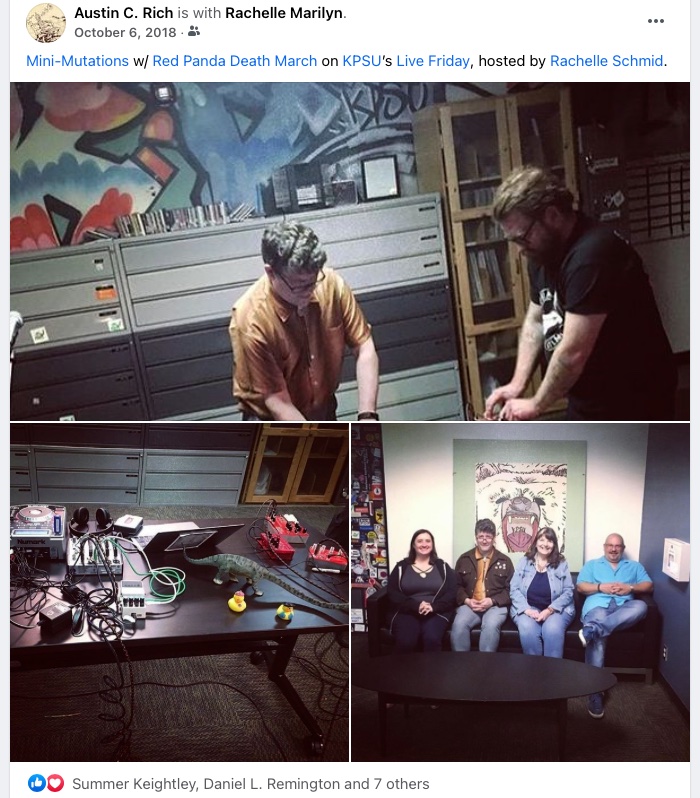
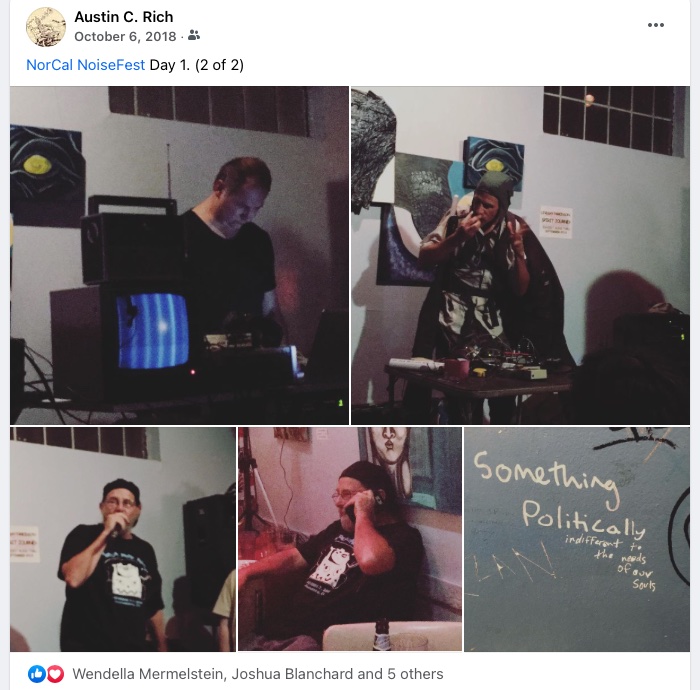

Tune in to kmuz.org, or 88.5 & 100.7 FM.
The stories of Philip Bradbury & Raymond K. Dick are mashed up as we offer music and a live performance by Mini-Mutations, with plenty of sci-fi goodies.
Mid-Valley Mutations, 10 PM, sharp.
Now we offer the most ubiquitous piece of music merch that every band must have: buttons! Known as both pinbacks or badges depending on your favorite regionalism, these are locally made by Button Arcade. There are five different mutations to choose from, and they look beautiful on the accessory of your choice, and not just grandpa’s jacket. At $2 these are the quintessential way to signal to the world that you have already been mutated.
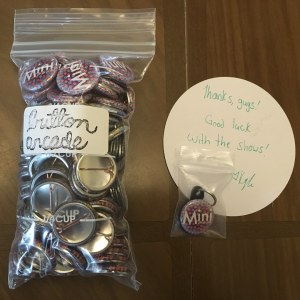
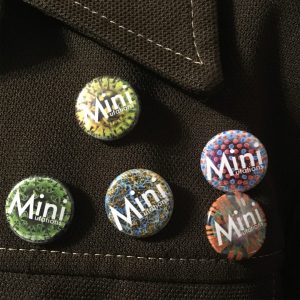

![]()
Tonight, I offer a Raymond K. Dick / Phillip Bradbury mash-up. It’s The End of All Things. Tune in.
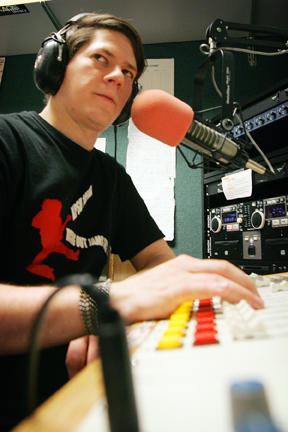
The Beginning
(Originally broadcast on 15 April 1998 on KWVA.)
This was my first ever radio broadcast. 4 A.M. – 7 A.M. on KWVA. What follows is a recreation, based on playlists, recordings, and memories from that evening. This is an approximation of what it was like to listen to my show in those days.
Here’s the backstory: I have been obsessed since I was 10, when I got my own radio / cassette combo, and a box of tapes to go with it. (Plus a couple blank tapes.) Staying up, past my bedtime, listening to radio dramas (not called “Old Time Radio” among fans) and classic rock DJs as my pre-adolescent mind tried to wrap itself around all the things I was hearing. It stuck with me, as I started calling KZEL to request songs and chat with the DJ, my mom already working in that field herself. It was KZEL that broke grunge to me, my friends at school how suggested KRVM, and as alternative began to find it’s way to the sleepy town of Cottage Grove, I found myself wanting to break out of the confines, and find the world I was hearing through the radio.
Pump Up The Volume is sort of the nail in the coffin, isn’t it? Suggesting a winder world of radio and music that is not what you once thought it was. When I finally did burst out of Cottage Grove for Eugene, KWVA was the station we all huddled around, and you would hear it all over town, blasting out of coffee shops and front porch freak-outs. It was almost as instructive as the tapes Colin & kiisu would make for me, and this inevitably led to the Colin Mix tape that featured Negativland heavily. I connected with them, and copied my roommates’ albums immediately, to find that I loved this group. As I dug into them more, I had heard tale that they did a radio show, which sort of blew my mind. A band, that does a radio show? I love radio! I need to heard this!
By the time I was staying with Little Jon, I had not only come into recordings (through CDs and tapes friends would mail me), but our mutual friend Shane With No Last Name starting a morning mix show on KWVA. All of these vectors sort of coalesced, and I obsessively taped Shane’s show (and a lot of KWVA), anticipating each new entry into his “9 AM Slayer” segment, and getting to know the station in general.
I immediately filled out an application to become a DJ, and submitted it, only to wait for some time, not hearing a peep. I was a little discouraged, as it seemed like it had been so easy for Shane to get his show. I must have done something wrong. At the time I was still making ‘zines, so I focused my energy into that, until one day, several months later, when I was in the area and dropped into the station. I asked about my application, and there it was, in a pile of “to be read” applications. None of the staff had actually seen it yet. I hadn’t done anything wrong, and nothing sinister was afoot. The first rule of radio was learned: if you keep showing up, you’ll eventually get on the air.
It wasn’t long before I got a call back, and was asked to start out in the “beginner” slot. This is the dreaded 4 AM to 6 AM airtime (with a 3 AM to 3:30 AM “arrival” time). I took it, because I was 23 and full of energy and what was I gonna do with my time, anyway? This was the ’90’s, and everything was cheap. I was working part time jobs and living with roommates. Of course I’ll leave the bar, pick up some records, cruise on down to the radio station and DJ for a couple hours. What else am I going to do?
And so, on April 15th, 1998 (a Wednesday), I waltzed into the KWVA studio at 3 AM, and began a tradition that has now lasted me 20 years. Fortunately, these days, I don’t go in at 3 AM anymore.
 In the time since I’ve been on at a number of stations here in Oregon, and 14 years ago we began podcasting, which has changed the game considerably. I’ve moved, changed the name, hosted up to three or four shows at once, and for years and years on end, hosted a weekly live band, too. (I’ve recorded somewhere around 300 radio performances in that time.) And if we roll the clock back to include the ‘zines and bands I’ve been in, and the live shows at venues I’ve put on too, and we’ve got 25 years of this nonsense I’ve been making, trying to carve out my own version of art in that time.
In the time since I’ve been on at a number of stations here in Oregon, and 14 years ago we began podcasting, which has changed the game considerably. I’ve moved, changed the name, hosted up to three or four shows at once, and for years and years on end, hosted a weekly live band, too. (I’ve recorded somewhere around 300 radio performances in that time.) And if we roll the clock back to include the ‘zines and bands I’ve been in, and the live shows at venues I’ve put on too, and we’ve got 25 years of this nonsense I’ve been making, trying to carve out my own version of art in that time.
It’s a lot to process. But I’m entirely grateful for this career that I’ve managed to sort out for myself. Being on the radio for 20 years has not only given me a chance to figure out who I am and what I want, but has given me a creative outlet that really feels comfortable. When I set out to make a new radio show, it feels as exciting as it was to show up to KWVA 20 years ago, and have the station manager look me up and down, and say, “Okay, when I leave at four, you’re on. You’ve got the place to yourself. Don’t screw it up.”
Hopefully, I haven’t. Making radio has been incredibly rewarding, and I’ve met incredible people in that 20 years, who have all contributed to making this show possible, week after week. When I get discouraged, I return to radio. When I’m happy, I can say it in a show. Before I had this outlet I would make tapes, obsessively, sending them out to friends, trying to perfect the mix. While I keep redefining what that mix “is” as I get older, I have to say I’m fairly happy with the shows I’ve made over the years. It reflects who I am, and how I’ve changed. While the show that I pitched to KWVA – an Over The Edge clone – was not the show I ended up making, as the years progressed and as my tastes changed and evolved (and as I moved from station to station), the show I originally pitched became the show I do now, and you can hear that 20 year evolution if you’ve been along for the ride.
But that isn’t to say that my show wasn’t more conventional at times. I used to do an all 60’s Rock show. For a spell it was strictly punk. I went through a phase of just playing everything at once and hoping for the best, and then a full pre-planned and pre-produced phase, that sometimes felt that way, too. For years it was just live bands, and I even did a brief stint doing only progressive rock. My show is difficult to pin down because I don’t really want it to be any one thing, restricting it to a format of which I can then grow tired. But as the years wore on it was clear that I was gravitating more and more to something that was obviously influenced by Over The Edge, even though it did not start that way.
On April 15th, I was more than a little drunk, and the station manager actually left before it was officially 4 AM. (She had been called in suddenly to cover for the 2 AM – 4 AM gent, who suddenly didn’t show up.) And to make matters worse, the DJ after me didn’t show up either, so the Programming Director came in and relieved me. Most likely I was actually on from 3:45 to 6:50 (or something like that), but I didn’t keep track of thing then as precisely as I do now. (A phrase which could probably go on my tombstone.)
The show had the incredibly unwieldy name of The Church of Blasphuphmus (Not Jesus) Hour, and up until 2013, some variant of that name was the one I used, on the air, no less. I got a few complaints about the “anti-religious” sentiment, but very little, considering how long I kept the name around. Since then, the name has changed a few times, but Mid-Valley Mutations seems to suit best the nonsense I’ve created, and feels like a good roadmap, too. While the old name was informed by the religion kiisu & Colin made up (and I willingly began to join in on), I can’t help but acknowledge all that the SubGenius did for me, and for them, in giving us ideas, too.
Through the miracle of tape and digital archiving, there is actually a recording of my first broadcast. The recording that follows is a re-creation of it that I made, using the surviving tapes, playlists, and guesswork as to what was popular then, and in particular, what I remember hearing / playing on KWVA in those days. (So, the re-creation is only as good as that.) In those days, it wasn’t as practical for me to record and keep all the tapes necessary to archive my entire show, and I played a fair amount of music that I already owned in other formats. So when archiving my KWVA shows, I would cut out the songs I owned elsewhere, and just keep the other bits. I rarely saved commercials, and I regularly lost huge sections of shows. (Near the end of my KWVA run, I just stopped taping entirely, and have still not yet found the supposed recording I made of my “last” KWVA show, before I moved to Portland.)
Suffice it to say, the recording here is a pretty good reproduction of what my show was like back then, but also, is like a journal entry from that day, from that year, that I can look back on. Because I’ve recorded so many of them, and because there are plenty of specific places and dates associated with all of them, the really do act as a way I can “listen” to my own story, and get a sense of who I was and what I’ve become in 20 years. This first show is not “great,” but it is a nice slice of nostalgia, and it shows the potential of what was to come.
I’ll be including occasional other selections from the archives to bring out some of my favorite moments from my radio years. I’ve done a few shows that I think are very indicative of the fun I’ve gotten to have on the radio over the years, and I want to share those moments with you now that I’ve had a couple of decades to reflect on them.
Most importantly, thank you. Without an audience, there is no art. And without you, the listener, there is no show.
Be seeing you.
* * * * * *
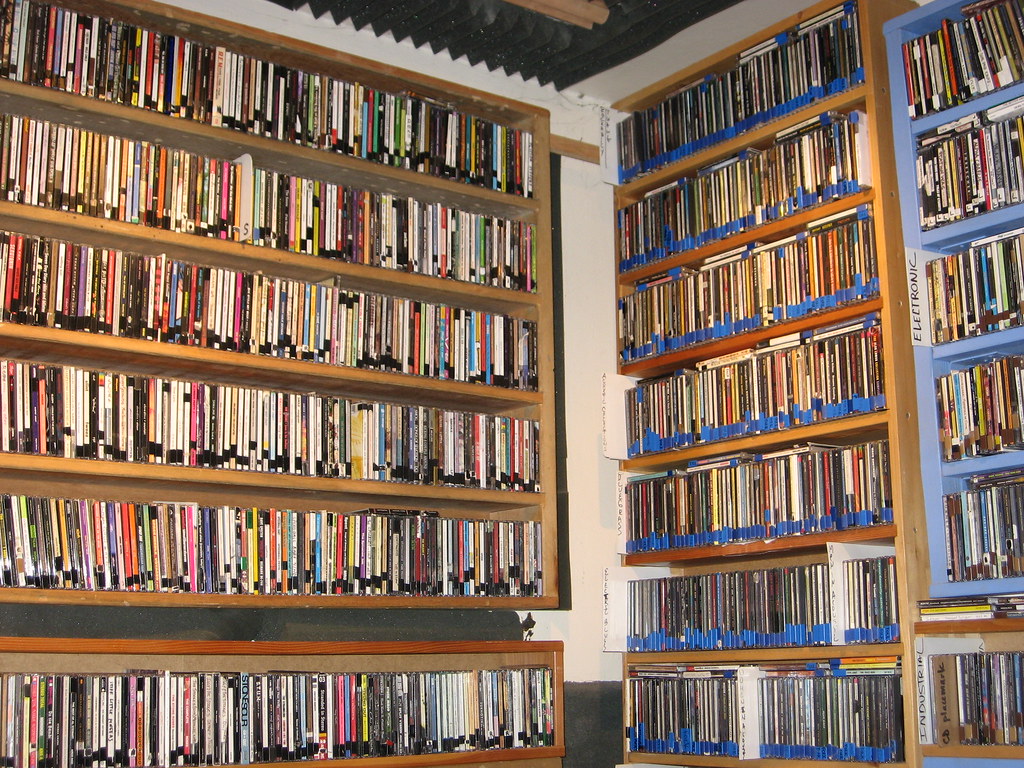
The Beginning
HOUR 1
01.) Strychnine * Strychnine * Born to Loose * Industrial Strength Records
02.) Millionaire * ?? * ?? * ??
03.) Teenagers From Mars * Misfits * Collection * Caroline Records
04.) Christine * The Con Men * Live In-Studio * KWVA Radio
05.) Dicks Hate The Police * The Dicks * 1980-1986 * Alternative Tentacles Records
06.) Stereo Phasing Test / Television * Man… Or Astro-Man? * Experiment Zero * Touch & Go Records
07.) Cramp Stomp * The Cramps * Big Beat from Badsville * Epitaph Records
08.) Selector Pt. 2 * Dub Narcotic Sound System
09.) Buenos Tardes Amigos * Ween
10.) Fade In / Fade Out * Red Aunts
11.) Forest Fire * Dead Kennedys * Plastic Surgery Disasters * Alternative Tentacles Records
12.) BluBlud * KARP
13.) KWVA In-Studio Performance * The Outclass
14.) My Novel * Oswald 5-0
15.) Let’s Go Away * The Wipers
16.) Neat Neat Neat * The Damned * Damned Damned Damned * Stiff Records
17.) Justification * Against All Authority
18.) Streamline Yr Skull * New Bomb Turks
HOUR 2
19.) Embryodead (Aghast View Remix) * :wampscut:
20.) Shaved Women * Crass
21.) Praying Hands * Devo
22.) Caught In My Eye * Germs
23.) Smokin’ Banana Peels * Dead Milkmen
24.) Hexenzsene * Unwound
25.) Metanoia * King Missile
26.) The Way Of The World * Flipper
27.) Happy Hero * Negativland * Dispepsi * Seeland Records
28.) Kill All The White Man (Live) * NOFX * I Heard They Suck Live!! * Fat Wreck Chords
29.) Germfree Adolescents * X-Ray Spex
30.) Universal Corner * X
31.) Hustler * Blatz
32.) Gargoyle Waiting * …And You Will Know Us By The Trail Of Dead
33.) Persistent Vision * Rites of Spring
34.) Whirling Hall Of Knives * Butthole Surfers
35.) Treat Me Right * The Con Men * Live In-Studio * KWVA Radio
HOUR 3
36.) Titanium Expose * Sonic Youth * Goo * DGC Records
37.) Birthday Sandwhich * godheadSilo
38.) Theme * Los Mex Pistols * Unreleased Radio Promo Tape
39.) Runnin’ Through My Bones * Tight Bros. From Way Back When
40.) Ain’t No Woman Gonna Make A George Jones Outta Me * Daniel Johnston *
41.) This Is Radio Clash * The Clash * The Story of The Clash, Volume I * Epic Records
42.) Egg Raid On Mojo * Beastie Boys
43.) Excuse Me, But Pardon My French * Unwound * The Future of What * Kill Rock Stars Records
44.) Balalaika Gap * Camper Van Beethoven
45.) Born To Do Dishes * The Queers
46.) Sidewalk Warrior * Screeching Weasle
45.) Jello Biafra * Wesley Willis
46.) Hangin’ Tough * New Kids On The Block * Hangin’ Tough * Columbia Records
47.) False Start * Bikini Kill
48.) In My Mind * Crimpshrine
49.) Kasimir S. Pulaski Day * Big Black
04.) Tennessee Stud * Jimmie Driftwood * The Wilderness Road * RCA / Victor Records
To complement our show Friday, which was heavy with my interview with Wobbly. We didn’t get time to play selections of his music, strangely. So, this mini-mutation features music from Wobbly’s career, focusing on stuff we mentioned during the interview. And: stay tuned to the very end, for a short sample of his as-yet-unreleased new record, Monitress. Happy Sunday.
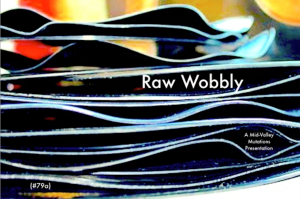
Happy Happy.
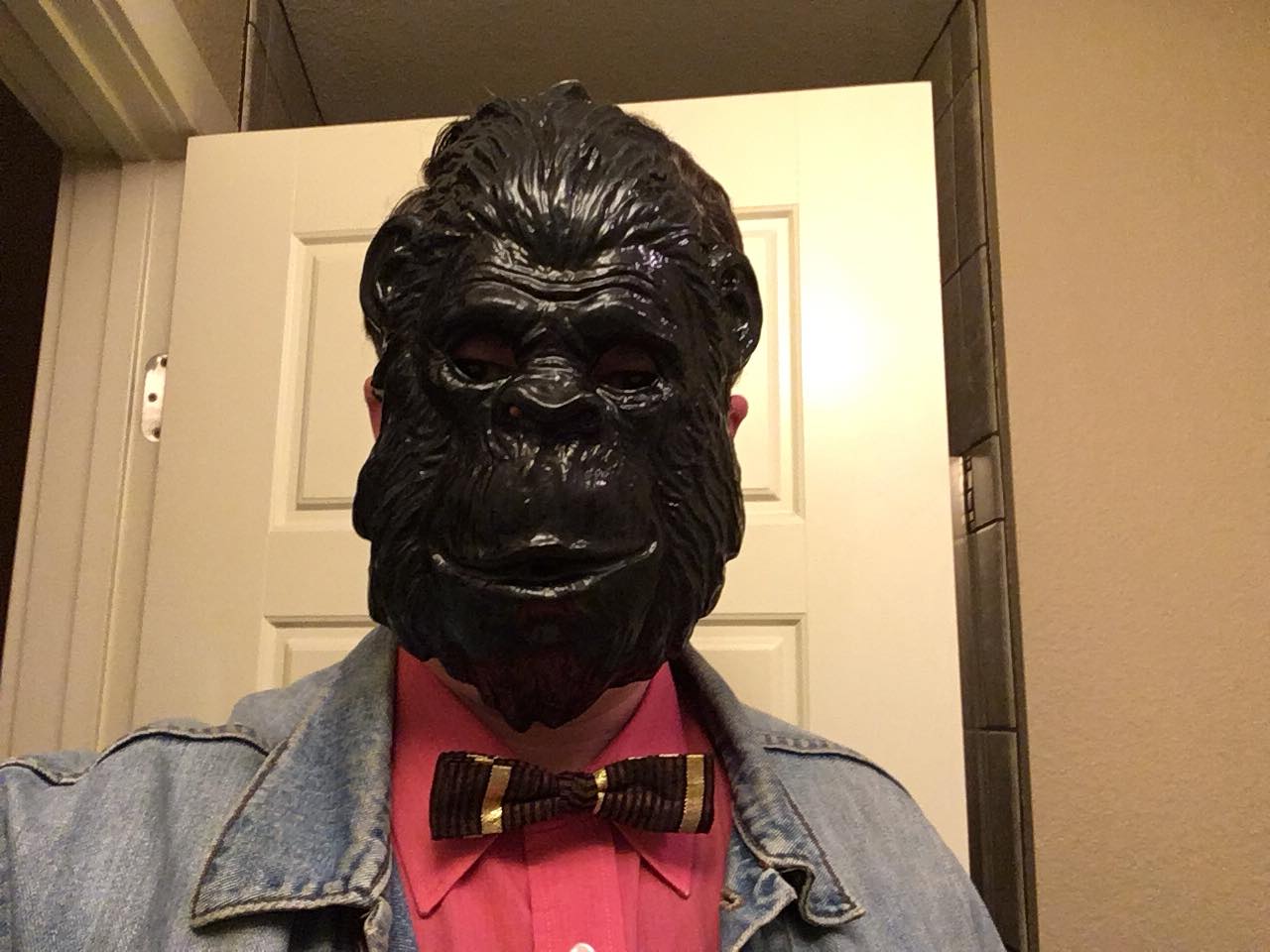
Join us!
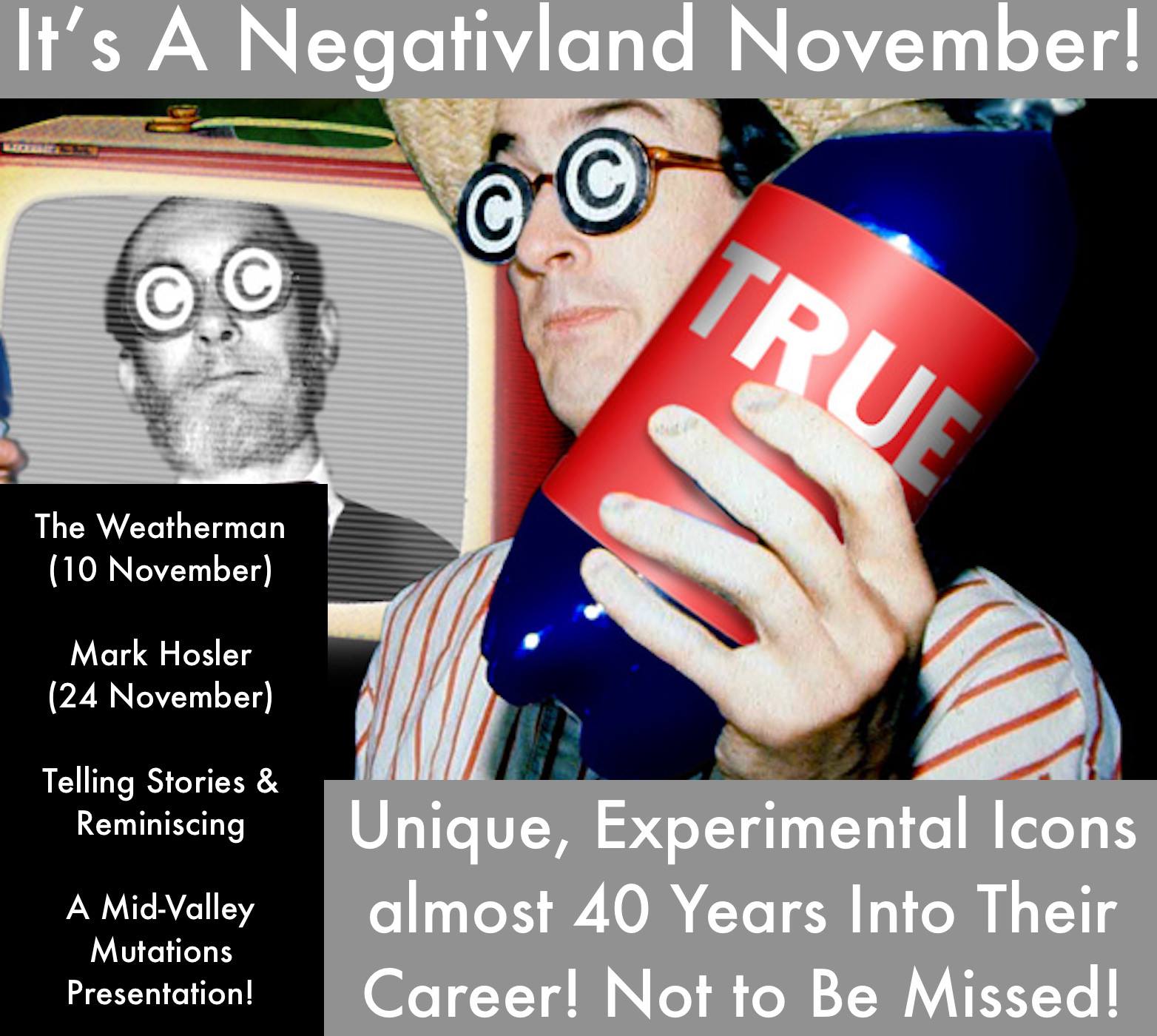
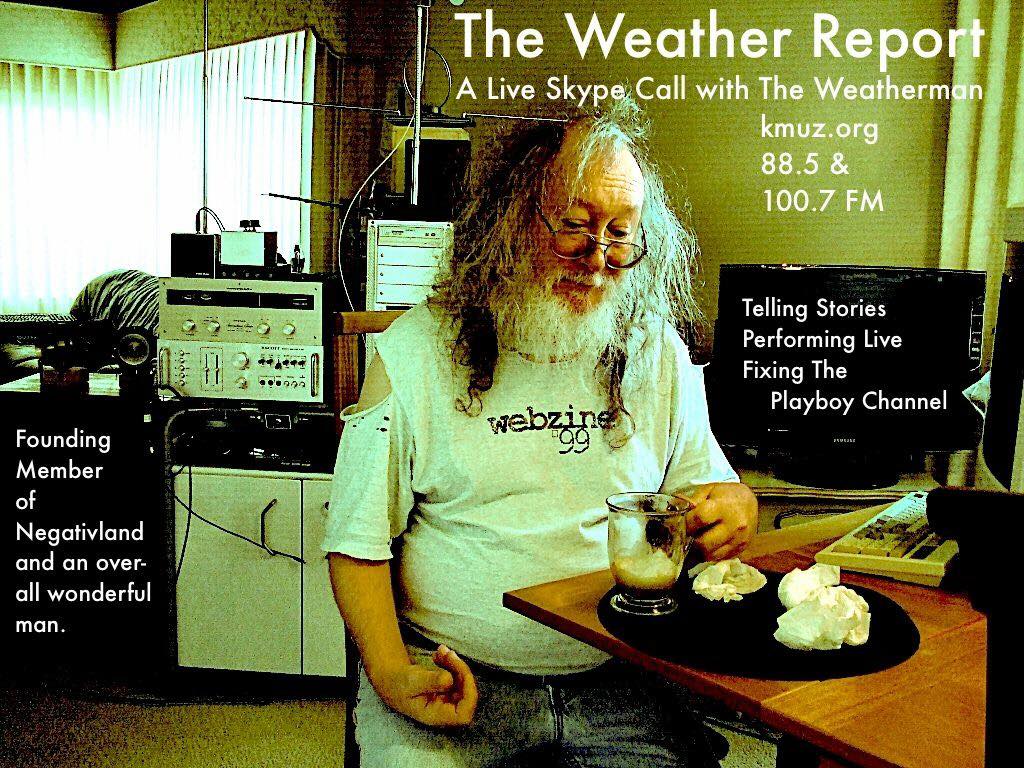
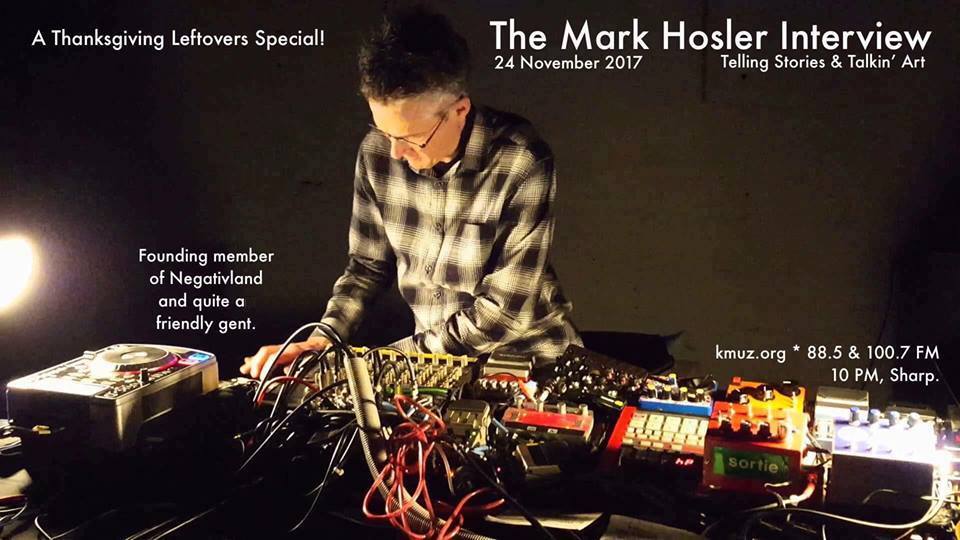





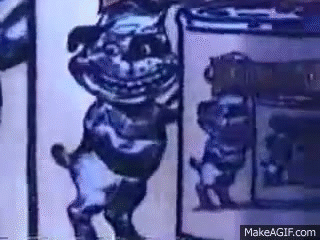

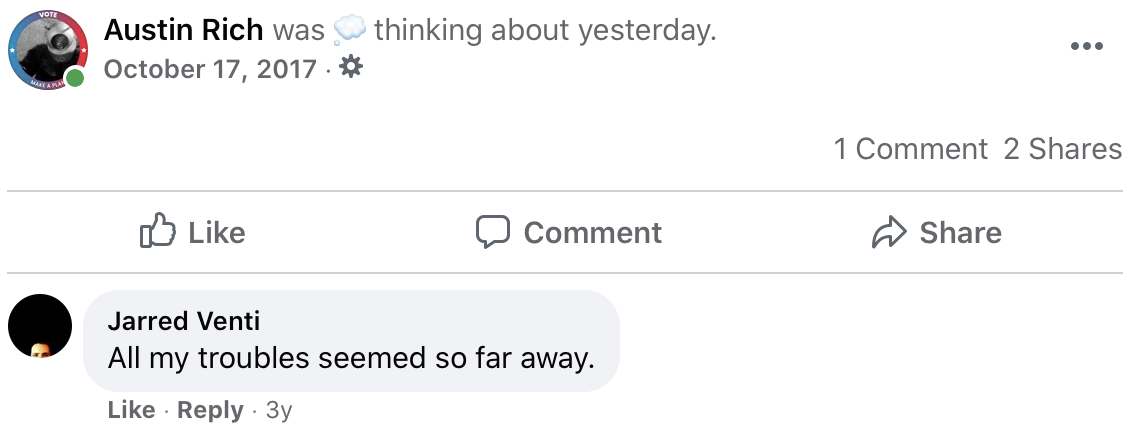
Ivanka Is A Punk Rocker is the band now opening for Obama’s Selfie.
In my mind, this was a lot further away… but it’s this weekend! Noise Therapy, with Justin Smith, Herd William, devils/club, Talc & Rock Forming Minerals. I’ll be doing a shortened, live version of my radio show, Mid-Valley Mutations, with a crew of great experimental artists. And we’re playing at an art gallery, too. Come on down. You won’t be sorry.

Who do I know in Las Vegas?
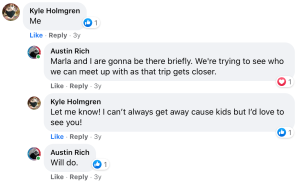





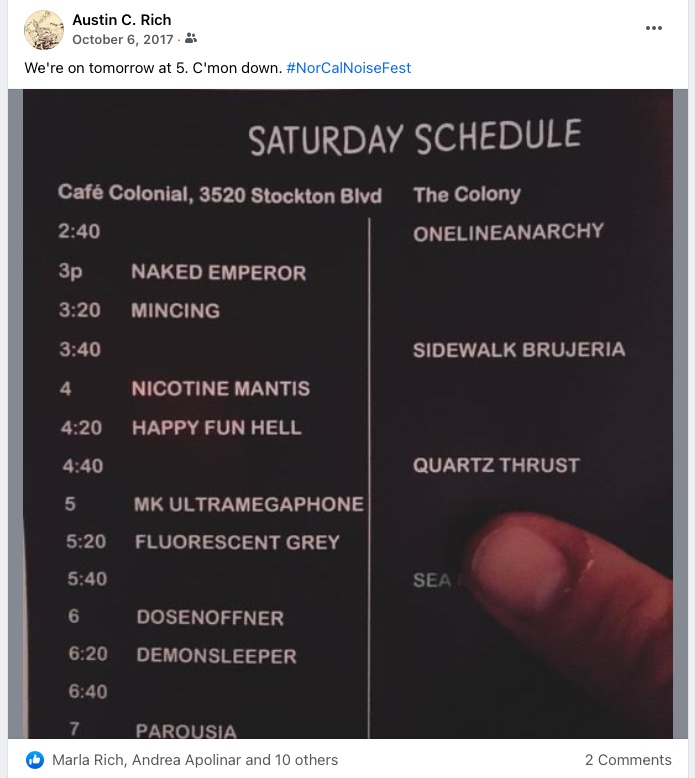

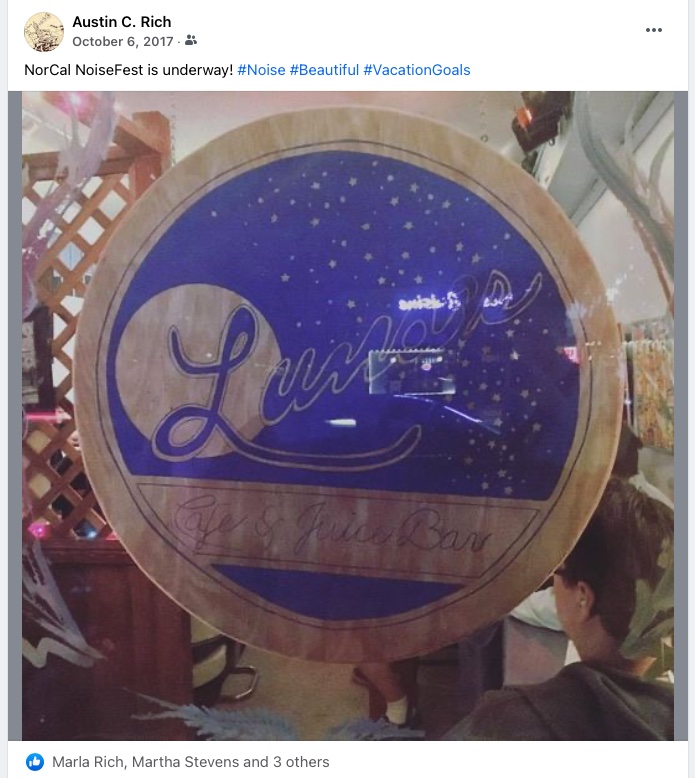
Urban rainbow.


My first batch of salsa. Not 100% from scratch, but aside one can of green chilies I threw in, it was close. #LearningToCook

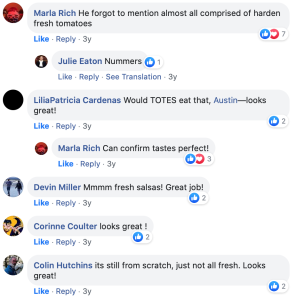
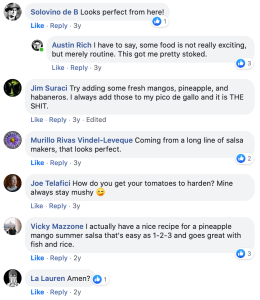
What Do I Really Like?
It’s strange that this is a difficult question to answer, for any reason that I could possibly present. There are some things that are easy – eating, sex, sloth – but when we get into the realm of the intellectual, this question becomes very complicated, very quickly. There are a number of things I like, or have liked, or have gone through the motions of liking. But as I get older I start to see the world around in a Fight Club sort of sense, where the things I own have an incredible amount of agency over me. Perhaps the things I own make it easier to build a nest, to fill it with comfort, and spend my days enjoying myself in every imaginable way. But the larger question – What Do I Really Like? – seems embedded with a more philosophic approach. There must be some rationale, even if it is silly. And, as the answers come to me less readily, I start to wonder if maybe I never really liked those things in the past.
There are three primary components to the things that seem to own me these days: books, comics and LPs. All three, as an interest, can be traced back to my mother, really. Growing up, she ran a store that she started – a.k.a. Used Books & Records – and I not only spent a lot of time there, but worked at (and ran) the shop occasionally as part of my set of first jobs. In this shop she sold books, comics & LPs (among other things). I had never really enjoyed reading when I was much younger, and music was always my mom’s domain, something that I enjoyed, but through her listening to it around me. But spending time in this store really engaged a new part of my mind that had previously been spent internalizing a rich fantasy world, largely pieced together from things I’d borrowed from TV & Movies.
At the time, my friend Devin has noticed the comics when he came in, and even bought a few. It turned out he had a modest collection of titles he’d picked up over the years, and gave me a run down of the stuff he enjoyed. There were several he followed, but Green Lantern stuck out for me. My mom had many in her shop, so I began to have my pay in trade for comics, and began clearing out the shop’s collection of different things that appealed to my sense of awe.
 Very quickly, I became a Green Lantern devotee. I remember the first issue I picked up – #90 – was a story about a predecessor to Green Lantern awoke, having been unconscious for years, along with a villain this old GL had to capture. At this time, the book co-stared Green Arrow, a wise-cracking anarchist who often depended on Green Lantern to actually deliver the goods, as a bow & arrow didn’t work well in space. In this book, I found a take on Sci Fi I had never seen before, that blended with super-hero storytelling, in a way I had never seen before. And, all this stuff about Guardians, other races and aliens, and Green Lantern’s secret identity. It was a lot for a kid like me to digest. Because there was no Inter-Web-A-Tron or instant access to all information at all times back in those days, the best bet for a kid like me was to save every penny so I could pick up back issues and fill in the gaps, and imagine.
Very quickly, I became a Green Lantern devotee. I remember the first issue I picked up – #90 – was a story about a predecessor to Green Lantern awoke, having been unconscious for years, along with a villain this old GL had to capture. At this time, the book co-stared Green Arrow, a wise-cracking anarchist who often depended on Green Lantern to actually deliver the goods, as a bow & arrow didn’t work well in space. In this book, I found a take on Sci Fi I had never seen before, that blended with super-hero storytelling, in a way I had never seen before. And, all this stuff about Guardians, other races and aliens, and Green Lantern’s secret identity. It was a lot for a kid like me to digest. Because there was no Inter-Web-A-Tron or instant access to all information at all times back in those days, the best bet for a kid like me was to save every penny so I could pick up back issues and fill in the gaps, and imagine.
Comics collecting allowed me a chance to let my already fertile imagination to run wild, and Green Lantern in particular seemed so unlike everything else in the world of comics, that I quickly became the biggest evangelist for the book. It seemed like the ultimate power-fantasy: through sheer willpower, you can force things into being, that will then do your bidding. And you can apply this power to anything you can imagine: flying, punching, creating complex technology or blunt instruments, etc. This force-of-will angle really speaks to a teenager, who seems to only have willpower in a world full of rules and restrictions and guidelines and misunderstandings. How many problems would be solved with a Green Lantern ring?
Of course, modern comics are sophisticated, so once you go down the Green Lantern collecting rabbit hole, you quickly find yourself inside the DC Universe, where all their comics take place. This means that through cross-overs and event publishing, soon enough all the books you are reading just to follow Green Lantern’s adventures encompass a number of other books that you never intended to start reading. This has only intensified even more as years have gone on, and anymore it is very difficult to just pick up Green Lantern every month without missing 7/8ths of the story because you’re not reading the other books he crosses over into every month. (But that’s another story.)
At my peak, in early 1990’s dollars, I was spending about $100 a month on comics, to stay current on my new books, and to pick up back-issues I was on the hunt for. Of course, this habit ended in 1992, when I was thrown out of my house by my mom, and had to live on my own. Before long, the painful reality of paying my bills kept my comics collecting in check. In the years since, I have occasionally picked up something here, and something there. Every so often, I go on a huge binge, and buy a bunch of stuff. But the money always reigns it back in, and then I have to cut back. At this point, I have about a thousand books, and quite a few I have never read. I could only re-read the books I have now, and would still have a great time without having to get anything new.
But my tastes have changed tremendously, too. I don’t read Green Lantern anymore, save for the occasional thing here and there. And my favorite character is probably Hellboy, or Swamp Thing. (Again, for different reasons.) And, of course, I’m less interested in DC Comics, unless it is from the 70’s, or older. But that desire to look through boxes of old comics. To read one now and then. And to experience a good story for the first time. Those are feelings I think I will always enjoy.
There’s only so many dank places you can hide out in before someone comes looking for you, and when they do, it’s often bad news. But I had managed to go on a bit of a tear recently, and was avoiding a short detox because I wasn’t ready to think about what was really going on. When you try to make a list of everything that’s been happening recently, all too quickly it gets out of hand. Sometimes, the drink in front of you is much easier to sort out.
Or, for that matter, the night life that goes on in any given town. This is, after all, America, or at least what’s left of it, and as long as there is a song to be heard, I remain powerful, and ready to take on the world. Having already undertaken this quixotic life thus far, it made little sense for me to try and ignore these kinds of opportunities when they arose. The booze was one thing, for sure. But you got booze in these night clubs, with music and girls and dancing and magic. If you drive around long enough with the windows rolled down you can feel the bass intermix with the smell of the moon and smoke on the horizon.
The bass begins to become more distinct as I turn the wheel of my car. The other instruments begin to come into the mix as I use my turn signals, my head spinning as I try to pinpoint the location. Like an sudden rendezvous, the tension builds almost suddenly as I realize I’m getting incredibly close, but then one final turn of the wheel and the song kicks into high gear, the neon and the leather and the hair and the smoke and the glasses filled with high powered alcohol and a band on stage kicking out the jams. I could feel both my libido and my mana pulsing, as energy crackled along my arms.
I rolled a cigarette and infused it with some of the bridge of the song, and thumbed my phone for a second until I was able to sort out where I was and what was going on. The Fixin’ To bar. Stiff drinks, deep fried and down home menu, with a thick layer of hipsters and aging rockers who show up for the Patio Shows, where a band and thirty friends can enjoy an evening. Swarming around the joint were every manner of woman, dolled up and beautiful. Rock music was best used to fuel glamour magic, and I cast a few change of outfit spells before I decided to keep my usual square coat and hat. My usual ruffled bow ties and earnest middle-agedness often made me stick out like a sore thumb, but it never stopped me from enjoying a nice string of evenings where I could chat up pretty girls, get bombed on bourbon, and watch some local band kick out the jams before everyone crawled home.
It certainly beat the hell out of dealing with what had happened.
I knew enough people that it was inevitable I could keep the party going all night, and I had enough folding money to ignore things for as long as my body could take. I drove recklessly, using magic to “sober me up,” chasing the next party, the next DJ, the next show, skipping the all-ages crap in search of some bar where I can hunker down and try to wet both of my whistles. But I never managed more than a few indiscreet rendezvous that were more sloppy than satisfying, and in my state, it was probably for the best that most of my texts and calls were ignored. I had thrown myself at the mercy of rock and roll, and it was a convenient way to ignore pretty much every, health and hygiene included.
After nearly a week of this kind of behavior I was in pretty deep, running a number of spells to act as outboard memory as I invented new ways of reaching alcoholic bliss, I found myself at some experimental dance night at Plew’s, when the girl I was offering to split a joint with was in fact Suzanne, someone I’d been intentionally avoiding so much so that I had inadvertently convinced myself she was someone else, and masked her magically when she first walked in. I’d rather not repeat our short but blunt conversation out of respect for whatever dignity I might have been able to hold onto after I performed a light-show outburst of spells and weirdness that was so powered by the one-man-band’s electronic music that the entire place was in awe. No amount of fighting with Suzanne could dissuade the owner from trying to work out a deal for future shows with me, nor did it stop Suzanne from convincing everyone that they needed to load me into her car so she could drive me back to the Record Store.
I applaud her for these efforts, because I intentionally don’t deal with myself when I that drunk, and Suzanne was not only brave enough to get me into the office, and up to my bedroom, but also finally took me up on the joint just so she could calm me down enough to stop having magical outbursts, and start thinking about things rationally. After I made the worst pass at a woman I have ever made, she put me to bed, cleaned my room, hid all the alcohol and pot, and turned on some sleepy drone music that had me out like a light in minutes.
I had wholly inappropriate dreams about every woman I knew and woke up twice in the middle of the night to relieve myself from them. The next few days were spent eating Thai food, binge watching TV, and feeling incredibly guilty. The text-message fallout – not just from Suzanne, but from the other men and women that I’d run into in the last week – was enough of a deterrent to avoid asking where Suzanne had hidden everything, so much so that I didn’t even look. Instead, an OG Dr. Who marathon coupled with the Pok Pok recipe book keep me busy as I reflected on what I had done.
After a few days of that, I decided to take a shower, put real clothes on, and get back to work.
The Legend of Billie Jean was not a movie I expected to be familiar with when my wife first recommended we watch it a few years ago, and as it is among her favorite films, I didn’t see the harm in giving it a shot. What I found out what that, very quickly, I did remember the film, but only in pieces, like in a dream. It should go without saying that I later realized that this was also a favorite movie of my younger sister when she was a kid, that I had absorbed the film largely through osmosis. I don’t remember sitting down to watch it intentionally at any point, but having seeing in twice in recent years, I now understand why it was – to my young mind – forgettable, but seems to be permanently etched into the minds of all women of a certain age.
The summer of 1985 was an interesting time in popular culture. Punk, New Wave, Power Pop & Rock music were all mixing together, and film was starting to depict these pockets of America that were infected by all of this new artistic input. Like the Rock and Roll scares of previous generations, “youth culture” was now something that was genuinely being paraded as a “threat” on the news, and small instances of kids gone wrong were blown out of proportion. A number of movies tried to address different issues that were affecting teenagers at the time, and for every Heathers that was poking fun at teenage suicide, there were plenty of John Hughes movies to paint a “quainter” version of the scourge of America.
In the end, though, the typical kinds of problems that Hollywood has suffered from crop up time and time again, even when exploring the fringes of teenage rebellion: where are all the women at? There are so few teenage films that pass the Bechdel Test that it is embarrassing, and while you have a few ensemble casts where there are both male and female characters, it is shocking to find how rarely the women are cast as anything but potential girlfriends for the boys, who are at the center of the story. This problem is both embarrassing and counter-intuitive to another trope that you see in almost all movies about teenagers: the younger, not-yet-sexually-active sister who DOES embody all the same characteristics as the males: outgoing, in charge, doesn’t let people boss her around, etc. The general thrust of most teen films is that young girls act like boys, until they “mature” and become objects for the boys. Aside from taking your glasses off and shaking out your librarian hair, there are few other roles you can take on in movies about teen.
It would be a little ridiculous to suggest that The Legend of Billie Jean is a feminist tract, and there are a number of problems with this movie that cause it to fall apart under too much scrutiny. But I’m not sure that plot hole exploration or rigorous third wave feminist theory application is going to explain by my younger sister and my wife – and, let’s face it, most women who grew up with this film – love this movie so much. I think, very simply, that the movie sets up an experience that a lot of women can relate to, and then pays it off in the most satisfying way at the very end.
Sure, I’ll probably drop a spoiler or two as I go, but perhaps the biggest one is that this movie was a bit of a flop, and not the first (or last) for director Mathew Robbins, either. (Although Dragonslayer managed to gain a cult following that was separate from the following Billie Jean has.) But it did well enough in the theater to help making Pat Benatar’s “Invincible” a hit, and it turned Billy Idol’s “Rebel Yell” – at the time, a year old song that had failed to chart – into a charting song as well, aided largely by MTV playing the hell out of the songs. But as a summer film, it was very quickly forgotten, and as artists began to tighten the rules about distributing their music in films, home distribution dried up. It made it to cable, and some rental stores got a limited number of VHS copies, but for many years it was unavailable, and only in the last few has it be legally available in a digital form. (Our copy is a burned DVD from 2006, won on eBay by my lovely wife. The transfer is an SD Fullscreen transfer, and looks TERRIBLE on a good TV.)
Of course, all of this is in keeping the The Legend of Billie Jean. The movie itself starts in the smallest way possible: a brother and sister from a trailer park find themselves the victims of an obnoxious kid, who destroys the brother’s scooter (and beats the kid up in the process). With the help of two addition friends from the park – a younger girl named Putter and another friend who has borrowed the family car – go on a quest to get compensated for the trashed scooter, and to get their names cleared after the father of the obnoxious kid tries to exploit and extort the sister, Billie Jean. After a series of adventures that continues to escalate the stakes of the film, it ends in a confrontation between Billie Jean and the sleazy dad, where most of the state of Texas turn up to watch her humiliate him, and then burn down most of his business.
And this guy deserved it, too. In the course of this movie he belittles his own son and Billie Jean, tries to pay her for sex, tries to force her to have sex with him, exploits her name and image for money after she becomes a media sensation, and with the full knowledge that his son is guilty, refused to pay for the replacement scooter, or to apologize for any action he did during the film. And, yes, loosing a business is hard, but he is rich, and will recover, while Billie Jean and her brother have to leave Texas forever, to restart their lives elsewhere, because Texas was so awful to them. (The moral of the story: you can’t change Texas, so just leave.)
When I moved to Eugene I knew about Punk Rock in an abstract sense. My mom had let me listen to a Sex Pistols album, and Alex Otto had played for me the Dead Milkmen and The Clash, so I felt like I knew what the music sounded like. But my experience of it was so limited as to be pretty funny. I listened to Uncle Tupelo and They Might Be Giants. I had been a fanatical Dr. Demento devotee, and my first two concerts were Robert Palmer (on November 8th, 1988 at the Hult Center in Eugene, Oregon) and Bon Jovi (on May 8th, 1989 at the Memorial Colosseum, at which they were filming the “Lay Your Hands On Me” video). My tastes – thanks to my parents – skewed hard rock, but my sensibility was so comedy driven that I was more “Weird Al” than Jello Biafra.
While I was in High School (1989 – 1993), “Alternative” music broke in America in a big way. My mom had cable in those days, and the used books / comics / records shop that she ran started to see a slight shift in the music that was coming in. But the lens through which I experienced all of this was through magazines: Rolling Stone and Spin, and the obsessively-watched MTV, itself going through a revolution at the time, too. Alternative Nation and Headbanger’s Ball were both setting the blueprint for what was to come, and this nascent media empire nurtured “Smells Like Teen Spirit” to the point nearly all DJs were confused. You would hear Juliana Hatfield’s “Spin The Bottle” side by side with “Psalm 69” by Ministry, and it was all being jump-cut with a hundred other ideas and images along the way. Everyone was desperately looking for the next “thing” that would be bigger than Nevermind, and in that search the most dada RIYL game was being played, with bands like Blind Lemon & Collective Soul having brief but uninspired careers that seemed even smaller scale that flash-in-the-pan.
Amidst the media stew that was being turned over around me this word – punk – bubbled beneath the surface of culture. I had missed it (and then some) with a 1975 birthday, and by the time I was 14, bad country music and hair metal dominated the world in my universe. But with this “Alternative” media blitz that was ushered in by Saint Cobain, hillbillies in rural Oregon were turning away from Classic Rock radio to this “heavier” sound. In a way, it was like putting a converter on foreign voltage, so you could “step down” the intensity of punk rock, and instead make it acceptable for widespread use in middle america. It is safe to say that in my family, we found have continued to listen to Hair Metal and hard rock, and that I probably would have become a KISS fan, eventually get into Van Halen, and follow that particular path as a teenager. (Think a milder version of the kids in River’s Edge.) Without Alternative, how would I have ever heard of Black Flag?
With hindsight, it is difficult to explain how secluded small town life was in a pre-Inter-Web-A-Tron world. I really had no concept of “college rock” or the pre-Alternative world of indie comics, ‘zines & records that was happening, and in some cases, within my own state. There was nowhere in Cottage Grove that carried small publications, and I didn’t know about KRVM (or KWVA) to even try and tune in to hear this other music. We had cable, but I was only able to watch during the day, and didn’t even know about these other shows that were on, late at night. The breakdown in communication was extreme, and while Rolling Stone gave me some context, they didn’t cover a lot of “indie” music until after Alternative broke. In many ways, I WAS the indie press in Cottage Grove, and I didn’t have access to anything stronger than what I heard on the radio. Living in Cottage Grove was like living on the moon; you were as far away from Seattle as you were from New York or LA. By the time anything cool came that way, it had already been everywhere else.
Alternative not only leveled the playing field, but it became the synthesis of all of this work the independent underground had been doing since the rock and roll revolution of the late ’50’s. Being “subversive” and “against the mainstream” was finally cool and acceptable in a way that it hadn’t been since Elvis Presley made rock and roll okay with housewives and teenagers. Alternative was finally an outlet were the maligned and ignored trends and undercurrents that were already dominating subcultures throughout America could find their way into every corner of this country in a way that Punk & Post-Punk had failed to do so, and as much of this movement was lumped in with “grunge” at the time,” it failed to encompass all the kinds of music that was reaching larger audiences. It was clear to me then the origins of Pearl Jam & Nirvana – two drastically different bands that were lumped in together often – might have been drawing from the same source material. But from where I was from, all of this history was absolutely inaccessible. It was take years before I would be able to put the puzzle together.
Once the Alternative Bubble broke, my interests went everywhere, and soon I was obsessing over every new band that appeared on MTV. New music seemed great at first. But as I read interviews and started to understand that there was a world of music that came before that I was unfamiliar with, a new interest began to come to my mind: what music inspired this? It was a question I couldn’t quite answer at first, but I knew that Aerosmith and Led Zeppelin were not the only reference points that new bands were riffing on. This word punk seemed to be the cypher, the way to uncovering some of this trail that had been blazed before. But how to find it in Cottage Grove? Where? How?
I’m not usually conspiratorial, or even that paranoid generally, but there is a certain kind of eerie “shadow government” kind of aura to President’s Day in my mind. The degradation of what it was – Washington’s Birthday, a holiday that the US began celebrating in 1879 – into what it is now – a way to offer sales and deals and a chance to have employees dressed as Uncle Sam – speaks to a kind of symbol-squashing that is far too pervasive in mash-up culture. The President, a position of authority, held by so few Americans in our 200 plus history, now reduced to caricatures of these important figures, reduced to xerox-copy level interpretations of what the idea of leadership actually could be.
It is funny how these things come about. I am not a particularly philanthropic person, and I usually don’t offer to take care of people. I’ve never pursued hospitality or babysitting as a pastime, and I never suggested – even for a moment – that this was a career I would follow, or take an interest to consider. These things never happen according to any plan, for sure.
I’ve had my share of weird jobs, for sure. Cleaning and feeding birds at a aviary. Bookstore management. Teaching college freshmen. Goat farm hand. Band manager. There are some jobs that are certainly memorable. But taking care of people was never something I had done before. I am slightly solipsistic by nature, and I have a hard time dealing with bodily fluids or anything slightly gory. The human fleshiness of our mundane existence has always been something I’d rather forget, and it’s own ironic tediousness and ultimate pointlessness is a comedy that I’d prefer to enjoy through narrative, rather than experience.
Still, when I first met George, I knew there was enough common ground that we could at least get along. I had no idea that I would be taking care of him someday; in fact, he was merely my girlfriend’s grandfather, someone I didn’t think I would see that often when we first shook hands. Even when she became my live-in partner, and eventually my wife, I imagined that I would see George only at holidays and family gatherings, and that our interactions would be short, but friendly.
Time passed, and the world around us changed in a number of ways. The details are somewhat un-interesting, and as they are of a personal family nature, will remain undisclosed, too. But George’s condition went downhill, and soon the pacemaker and his pre-diabetic nature was adding up to a host of daily pills, and an attitude that seemed to be in decline. Being 89 has a toll on someone, and he was never a health-conscious person to begin with. His interest in playing cards all day long and sitting in a chair when possible caught up with him, and his years of military service and working for the State of Oregon couldn’t erase the damage of neglect and age.
We hemmed and hawed and tried to ignore the matter, but it became clear after he fell a few times, and then wound up in the hospital after his lung collapsed, that if he was going to continue at all, he would need someone to take care of him. His balance was so bad that he already needed a walker, and if he was going to get the physical exercise he needed and the assistance with preparing food, he needed someone to be there with him at all times. He could barely operate his inhaler he had to take at least twice a day, and while the house he was living in was just fine, there were enough challenges to everyday life that it made sense to make sure those challenges didn’t aggravate him any further.
The timing was quite strange, actually. While I had grown accustomed to avoiding the word “unemployed” to describe my own state of being, when pressed I had to admit it was uncanny in its accuracy. Within my close family, this condition led to a lot chores and odd-jobs getting put on my plate in an effort to exploit my particular circumstances. I’m not usually prone to delusions of grandeur, but I found the joke funny enough to entertain myself, and preferred to explain that I was a freelance writer and radio producer. While absolutely true, this statement tended to betray how much time I spent cleaning the house, and how early I started pouring my own cocktails, I also spend as much time writing and editing audio, too. It wasn’t that I was on the couch burning Js and catching up on Adventure Time. Far from it; I managed to keep myself fairly busy with job applications and daily routines like cooking and baking, not to mention leaning on my freelance arrangements to draw the occasional $50 check when all other hope seemed lost. It wasn’t an awful way to spend your days, and I actually quite enjoyed it, but it was also very difficult to create the impression that I was so busy that when family really needed my help, it was expected I would take time out to wait for a package to show up, or spend hours on-hold while we sorted out some billing mix-up.
I’m not sure how the idea came up at first, but when it was suggested that I could be George’s daytime caregiver I immediately said yes without thinking about it. I had been secretly preparing for this eventuality when it had become clear that he was not doing well, actually; when I still had a desk job that I loathed with all my heart, I would remember the weekends where I was talking to George about his time in the Philippines, and I imagined that I just wanted to spend my time listening to him. Being new to town, he was sort of the only other person I knew, and the time I hung out with him became absolutely more interesting than anything I did at work. While I was not in denial about what I would be doing, no amount of human waste and brushes with death could be as bad as the bullshit of office life.
Very quickly the arrangement of my job and duties were made. I would show up at about 7 AM and stay until the afternoon, Monday – Thursday. (Friday I would do a half-day, and would remain “on call” or “as needed” on the weekends.) In addition to making sure he ate, and keeping the house clean the house, I would also work with the Home Care Nurse to make sure I understand his medical and physical needs, considering his condition. After getting a full run-down of his medications, I also developed a exercise routine for him that was achievable for an out-of-shape octogenarian with a heart condition. There were other occasional chores, like baking bread, doing yardwork, wrestling with the garbage and recycling, and chatting with George about everything, to keep him engaged and entertained. We sometimes watch TV, but for the most part he doesn’t follow it anymore, and when asked, would rather have it turned off.
George lives with his daughter, who has been his primary care for the last 10 years. She is in her 50s, and is my mother-in-law, too. While she’s only a bit younger than my other mother, there are enough similarities to claim they have a shared generational experience at the very least, while being different enough to not have that creepy feeling when someone gives you a “mom” vibe. While she is my mother-in-law, she doesn’t treat me like a “son,” and that tends to make things go more smoothly, for sure. She doesn’t work either, but keeps herself fairly busy in a given day, with shopping and crochet and reading. For her, taking care of George was easy when he could get around on his own, drive a car, remember to take his own pills, and could cook for himself. But in the last 10 years, she has seen him become more and more dependent on someone to be there for him, and anymore it is too much for her to handle and do the shopping, and do the cleaning, and have a life of her own. I’m sure it wasn’t easy for her to admit that she needed help, but when she did, she made it very easy for me to want to help.
Like many people his age, George is stubborn and set in his ways. He essentially lives to have another cup of coffee anymore, and while he is on decaf – and now by doctor’s request, should drink as little as possible – I fix him coffee more often than anything else. His meals are very simple: he can usually have anything he has an appetite for, provided it has low salt and low sugar. I fix him a lot of oatmeal and bran cereal for breakfast, leftovers for lunch, and some sort of meal that I help his daughter prepare for dinner. One thing that has not diminished over the years is his appetite. He will eat anything, and always finishes his plate. Outside of going back and forth between his bedroom and his chair, he also visits the kitchen and the two bathrooms as well, but doesn’t do much else.
We also have some of the same conversations every day. Part of the problem with George is that he is not at all forthcoming with anything about himself. While he will occasionally contribute to a conversation, he is very much of an age where it was impertinent to talk about yourself, and clearly comes from a long line of people who preferred to put up with minor inconveniences so that he isn’t a burden on anyone. And this is easy enough for him to think he needs to continue with, too; unfortunately at his age, he tends to forget how old his actually is. So I usually have to go through a series of questions with him. “How are you feeling? Is there any unusual pain that you’re experiencing? How’s your foot? How’s your hand? Do you need a pair reliever?” By way of example: over two days I kept asking him how he felt, and his response was, “I feel like my head is in a fog.” I tried to get him to elaborate, but he couldn’t say any more. “Do you have a headache?” “Not really, no.” “Does your scalp hurt?” “Of course not.” “What do you mean, fog?” “You know… what’s the word… it’s in a fog.” By the end of the second day I was finally able to get him to say, “Well, you know when you feel pressure in your head? Like your nose is stuffed up?” Ahhhhhhhh. I have a decongestant right here, George. Let me get it.
There are a few consistent problems that we are regularly combatting. Because of various problems he is suffering from, his left hand and his left leg have a tendency to swell. As it was explained to me, fluid is pooling up because he is not very active. So, whenever possible, we need to elevate his arm, and when he naps or sleeps, elevate his feet. Improving his hygiene was a challenge, too; showers were difficult for him, and even when they were successful, exhausted him for the rest of the day. So a professional started showing up once a week to get him in and out of the shower without a fall. And, while this is embarrassing – and I do not mean to take away any of his dignity with this – he does have a consistent problem with wetting the bed and shitting himself. However, I have chosen to see that as a boon; one negative health sign is when he stops being regular, and at least for now, he has absolutely no problem with that.
The biggest challenge I faced in the early days of taking care of George was cleaning his room. Soon after I started coming over I realized that George’s daughter hadn’t been in to clean his room in ages. Part of this was out of practical problems; while we has napping and sleeping was a bad time, and between feeding him and helping him with anything else, there was often little time to get in there before he wanted to take a nap again. Combine that with the other daily chores she was handling, and it was easy enough for anything in George’s room to be forgotten once he closed the door. So when I began to poke around and find the dust and filth building up in the corners, I realized I had to undertake the task of diverting a river into his room.
As explained by the Home Care professional, as people age the tend to sluff off more dead skin that the average person, which creates more dander and dust that normal. That, combined with the detritus of being an old person with terrible memory – led to tissues and paper towels soaked in who-knows what kind of fluid accumulating in various corners of his room. And, as the professional said, it was important to clean this often, as dander can lead to lung infections if you breath it too often. So each time I would try to get in there and clean, all I saw was George’s DNA floating suspended in every corner of that room.
directed by Austin Rich. Music by MKUltramegaphone.
Here are some videos I show the other night as part of the show at the Fifty Pub & Grub on 9 February 2017.
Playlist Includes:
Enjoy.
How do you feel productive when you’re not doing anything at all?
This notion of feeling accomplished, of wanting to do things, has always haunted me. Even as a young child, I would talk about things I was going to do “someday.” I had this idea that I would make movie props, that I would assemble the perfect room (from a photo on a Christmas card I got from my grandmother once), and made lists of things that I wanted to do (and, for some reason, never got done). I remember, vividly, a list of 100 things I wanted to do before I died. The list is gone; the impulse has not.
In High School and just after, this manifested itself in a creative impulse, to write and make ‘zines. I arbitrarily picked “writer” out of thin air one day when asked about what I wanted to be, and have since pursued it in a manner that could best be described using “haphazard” and “slipshod.” But the only way I knew to do this was to keep trying, and each new scheme seemed to materialize in the real world when I would say, “I can’t, I have stuff to do,” when my friends would ask if I wanted to do something that evening, also a habit I keep to this day. Either by habit or by some innate feeling from earlier, I now carry with me this feeling of needing to be doing something else, somewhere else, at most times during the day. I have trained myself so completely that sitting down I am often paralyzed by six other things I should be doing instead of sitting, and in some cases, ways to do those tasks while seated. Even lying in bed feels like something that I should try and multi-task.
Put another way: even when I’m doing exactly what I’m supposed to be doing – or, the void forfend, what I want to be doing – I still feel like I need to be doing something else. While my Honeymoon was amazing, and I did some of the greatest things of my life with the person I wanted to be with the most, the whole time a nagging sense of what I was not doing seemed omni-present, as if I could easily get up and do that thing at any given moment. But these “things” I want to do, this “stuff” that I feel such a compulsion toward. “Clean Basement,” “Sort old files,” and “delete cruft” all seem a little hard to do at The Grand Canyon. And yet, they nag, the persist, and the overwhelm.
Part of what makes self-help appealing is the notion that you can change yourself by reading a book. And, you can; just not the way we want it to. When we read a book, we incorporate the ideas and thoughts into our daily narrative, at least during the period we spend reading the book. When we finish, we either forget the story or remember it fondly, and how often we remember it becomes how important the book was to us. But when it comes to the idea of self-help, we want the book to have a less subtle effect. We are hoping that the mechanical act of reading is like inputing ourselves into the machine of the book, and that when it spits us out the other side, we will somehow be changed into the kind of person the book wants us to be. No self-help book – not even Zen and The Art of Motorcycle Maintenance – is that good.
I spent my teen years booking at a bookstore, spent six years working in a Barnes & Noble, and then six additional years at college, getting my degree. I have grown up around books, and my family has always been avid readers. (Or, at least, were; computers have sort of changed all of us.) So I have seen the power that these books can have on someone. But when I have read these kinds of books, I have found them to be incredibly lacking. I usually feel as if my problems are not being addressed, that there is letting room for my kind of thinking in their view, or worse, that the steps to get from my kind of thinking to theirs were not clearly outlined. How was I to have the same kind of epiphany as they did? It seemed as impossible as climbing Kilimanjaro. How? Where do you begin?
Trying to implement Getting Things Done is interesting, because at the core is not a lot of mumbo jumbo, and even the system is almost secondary to the idea at the center: you need to be very honest with yourself about what you will actually end up doing, and discard the rest. And in this case, being “honest” is the hardest part; you need to be brutally honest. Case in point: I have had to look at my daily reminders, and ask myself why I have each of them, and even worse, why I consistently ignore them, or mark them completed when I haven’t. I have daily reminders for things I do three times a week, on a good week. At what point do I look at myself and say, “I need to re-think this; clearly something is wrong.”
And, to make matters worse, even the system – something that David Allen encourages you to change to fit your needs – contains something to learn from. Each section of it creates a mini-metaphor about reflection and revisiting assumptions you haven’t questioned, to the point that you begin to wonder about what parts to skim and what parts to digest. While not strictly a Self-Help book, GTD is very much presenting as one in many ways. But, like all self-help books, it will not change you unless you want to be changed.
I have boxes in my basement, left over from my childhood. Stuff taking up space, cluttering my life. Every year I say I’m going to get rid of them, and I don’t. GTD will never solve this problem for me until I really want to get rid of them, and it is that problem, that concern, that is really at the heart of my frustration with the book. Because, again, the book isn’t the problem; I am.
To say that discovering Merlin Mann’s podcast Back To Work was a revelation to me both undersells the value of what I got out of listening, and oversells the pedestal upon which I already put Merlin Mann’s online persona, in some ways an entirely separate subject. True, it is through Merlin that I discovered John Siracusa’s work, and while I covered some of this story over there, this time I’m on an entirely other tangent, one about tangents, one about a shared past, and one about learning to believe in myself. I think I share some embarrassing jokes about how poorly behaved I used to be, too, so you can at least tune in for those.
Like many people in America, I had a job that did not require any brainpower, took place in a cubical (and later, a “quad” with three other “teammates”), involved the use of dedication to “knowledge work” performed digitally on an out-of-date computer, all with the management allowance that we could listen to whatever we wanted while we did our work. It was, in many ways, the only benefit the job offered, and as I quickly found myself caught up on every podcast I have ever cared about, I began to find large periods of the day filled with free time that I wanted to fill with something interesting, lest the horror of the drudgery of this job I hated would become too apparent.
I was, in fact, miserable at that job. But this was nothing new. I have hated most jobs, and I have never felt the kind of loyalty that most employers seem to be look for in staff that they want to pay a living wage to. I have explored much of the shitty-job market that is available to people without a college degree: factory work, fast food, janitorial, musician, columnist, computer IT, production engineer, library staff, retail, teaching, farm hand, radio personality, aviary assistant, office detective, etc. All of it felt like I was being punished for some past sin of which I was very guilty. I couldn’t stand the rote dependence on arbitrary systems and middlemen to get something done that could be handled so much better in other ways, and I am still astonished at the pittance we receive for the lion’s share of work that keeps our world functional.
I had attended too many meetings, been a part of too many office chess games, have listened to far too many people have their personalities ground down to a nub, and found myself becoming a person I hated being every day when I would go to work. I assumed – wrongly – that a degree would open doors that could take me to a new class of mediocre jobs, but I soon found that aside from a small bump in pay that barely covers the cost of living increases we’re constantly besieged by, even this six year odyssey toward academic enlightenment was only ever held against me as being too much or not enough to meet the requirements of the job I was looking into. Most of the time, I spent all my off hours dreading going back, exploited every sick day I could on those mornings when I was about to cry at the thought of going in, and miserably scanned job listings as all of the same things came up again and again and again.
I have never done well with jobs. And this ennui about my direction in life and my need to add new podcasts to help fill the void overlapped with the 5by5 Network that was always popping up on my phone as a “recommendation” based on the kinds of other shows I also enjoyed. The name ticked some part of my brain that I enjoyed, and I felt like I had even heard a recommendation, or saw a link once? Hard to say. I added several shows, including Back To Work, described as a productivity and creativity talk show. I (nominally) consider myself to be an artist – or, at least, an aspiring one – and felt maybe the trick to my own work was to start looking at it like work, so I could be more productive. Having listened to enough NPR, I have surely overheard even stories about successful people who approach their creative lives in a very disciplined way, and my hope was that I could organize my creative work in a way so I could exert a little bit of effort to make it look like I was more productive that I really was.
Up until that point, I really looked at my creative life as a disorganized mess, with little regard to making it easily accessible or available were anyone to want to check it out. I would make something, I would hand them out to people directly, talk about it a little bit on my blog (occasionally – when I remembered to do so), and then move on. It was sort of the ephemeral nature of radio and ‘zines. They are, ultimately, disposable and temporary in nature, fixed in time. But if I was ever going to live the dream of making these creative works sustainable – somehow – I would need to start getting a little more serious about it. If I just had some advice – some simple tricks I could use to be more productive – maybe my work would be better, because I was making more.
I fully anticipated listening to Back To Work as being a way to get some hands on, in-the-moment advice on how I can simply apply that one tid-bit and see it have a ripple effect through my creative work. A sort of magic bullet, that once fired would see results that I could really use to my benefit. I would listen with a pad of paper next to my desk at work, waiting for a chance to capture something amazing.
I was not at all prepared for what Back To Work actually was.
Admittedly, I did not exactly love it after the first episode. I find this is common for media with which I become very interested. I can’t even remember where I jumped in; probably with the then-current show, something from late 2013 or early 2014, maybe? But in going back through the old episodes – largely in reverse order, humorously – I started to figure out the rhythm of the show, and really came to appreciate both the wit and wisdom of Dan Benjamin, but the wickedly funny Merlin Mann, who play off of each other very well.
Describing what Back To Work actually is sort of requires a brief overview of You Look Nice Today, a show that is so good that the rare and amazing moments when they do – randomly – post a show after having been dormant for over a year – you are pretty stoked to suddenly see a new episodes materialize out of nowhere. In this show, Merlin, Scott Simpson and lonelysandwhich produce a fairly impressive satire of the kinds of douchy business and office conversations that we’ve all come to loathe. The genius of the show is in the editing; each episode relies on the razor-sharp jokes that are made possible when you consider the digital nature or recorded Skype calls. And it makes sense; the show was largely born out of their Twitter exchanges, where people would tracked this sort of thing had been entertained by all three of them piling on each other with 140 barbs that breathtaking in how note-perfect they ring in this age of “everyone’s a comedian.”
You Look Nice Today is a show that, even if largely dormant, works perfect as a document, and probably will for years to come. It is a kind of comedy – like the work of Kasper Hauser – that will stand the test of time, but was born out of and is a part of The Inter-Web-A-Tron. You Look Nice Today needs to live as a podcast; it doesn’t fly any other way. I know that they do live performances, but the pacing of the editing, the Title Sequences by John Hodgman, the music that is used throughout, it is all of a piece that highlights and exploits the best of how a podcast works as a medium, and allows these three personalities to deliver not only the best joke for the show at hand, but the best meta-joke to complement it, and the joke about not having a joke, and another about how all of that wasn’t a joke, it was real, guys. You Look Nice Today seems so much of the language of podcasts that there is a chicken or the egg quality to it, and certainly the way people produce new shows is influenced by some of the tone they set.
Part of this is owed to the way that Merlin Mann plays a very deadpan office meathead go toe to toe with anyone who wants to spew management bullshit-isms until nearly all meaning is drained from the sentence in the most hilarious way. The character of Merlin Mann is that of a beleaguered office specialist, a person who has been hired to run a project he knows nothing about, and instead chooses to shuck and jive with tech world and office jargon that barely makes sense, even to those who know half the references. And – like most tech-world hipsters who are always looking for the next trend to blog about – Merlin interlaces his nonsense with ’80’s and ’90’s indie-rock references, a boatload of Marvel Comics references, mangled malapropisms, 50 shades of “huh” that he punctuates his sentences with, and sprinkled with an incessant request for everyone to watch The Wire over and over and over again. You Look Nice Today was a stomping ground for Merlin’s hipster’s hipster character to run while, delivering hilarious null-set constructions that perfectly reflecting the bullshit that tech world folks are all uncomfortably familiar with.
It is probably worth mentioning that I understand, intellectually, that this is a character Merlin is adept at playing. Like John Cleese, Merlin has figured out a way to wear the discomfort of being and outsider in a world of intellectual one-ups-man-ship and let that character unfurl in a variety of ways, to create a comedy persona that – and I should emphasize this – is not Merlin Mann, the guy who goes home to his family at night. Like Cleese, Merlin can play this character perfectly, from having lived and worked in that world, and having been a part of it since the very early days. Merlin’s early web presence when the Inter-Web-A-Tron was still only the playground of a handful of nerds is well documented, and he – along with a handful of other early nerds – became the people that set the tone for the way media and the web would work together. Merlin developed a personality that was informed by self-help and nerdy pursuits, but very clearly drew a line in the sand between his personal life and his “online” one. For him, the web is his stage, and with each iteration of the outlet he chooses to use, he finds a way to make it uniquely his own.
To tell the story of Back To Work, I have to mention Dan Benjamin, founder of the 5by5 Podcast Network. Dan is another one of those old-school tech-nerd guys, and after having tried his hand at office work, realized that his real passion was radio and video. In 2009 he began the 5by5 Network, a place were the people who had been a part of the original web media landscape could develop podcasts that suited the kinds of geeky topics that listeners were looking for. By 2009, the world of podcasts was still largely undeveloped. You Look Nice was around very early, and there were some people getting involved, but networks were still something unheard of, and many people were looking to get discovered in podcasts so they could move on to something else. Unlike Dan, they weren’t thinking about the long-term picture.
Dan began assembling a slew of personalities and shows that featured a number of people who were already a part of the tech media world in some form or another, and Dan even interviewed Merlin early on in an effort to get Merlin to join forces with him. Merlin held off at first, as he was already quite busy with his own projects. (Merlin performs seminars for businesses to help motivate staff and improve morale.) But when a particularly lame presentation came to an end, he made a decision on the flight home to launch Back To Work, a new outlet for the more playful side of Merlin to find a home. You Look Nice Today was on a hiatus, and the time seemed right.
Over the last year, Mid-Valley Mutations has evolved from a mere idea to a flourishing weekly radio program that features music and live performances you cannot (and will not) hear via other venues. To that end, the program has featured a number of artists from all over Oregon, to highlight some of the incredible experimental acts that are right here in our own back yard, even if you don’t see them play very often. Until now, that is.
To help further the cause, Mid-Valley Mutations is launching a monthly live showcase in conjunction with The Space Concert Club, to give you a chance to actually see these acts, in person. Sunday Service will happen the last Sunday of every month, and offers a wide range of experimental artists that cover every kind of music: electronic, post-punk, noise, deconstructed folk, home-brewed and circuit-bent gear, and everything in-between. “Experimental” can mean almost anything, and our hope is that we can offer small slices of this world, every month.
While the phrase “experimental” can conjure up wild (and often inaccessible) performances, Sunday Service will offer intimate shows with performers who are dedicated to their craft, create art that is personal and meaningful, and would like to share this work with the world around them. While the music may be atypical, the intent is not to be obtuse or difficult. These showcases are presented to feature the beauty and joy in creating music, and the freedom that comes with following your muse, where ever that might be. Sunday Service will not just feature music, but will offer a chance to meet these performers, and find out more about what they do in person. These shows will be curated, organized and hosted by Mid-Valley Mutations mastermind Austin Rich
Our first gathering is March 26th, with the incomparable Guyve headlining the show, playing their first Salem gig in their 24 years as a group. And in April, join us for a rare performance by traveler and recording artist Eric Hausmann, who has called Portland, Ipoh Malaysia and Pittsburgh his home in recent years, . The spring and summer are full of surprises too, and we can’t wait to announce them once they are final.
Sunday Service Showcases are Free to the public, and are 21+. The Space offers a full bar, vegan menu, and a positive, inviting atmosphere for discerning and excellent guests.
Join us for Sunday Service: A Mutation Showcase every month to hear the best in experimental artists you can’t hear anywhere else.
We’ve been waiting for you. Join us.
WTBC Getting Into The Act. It’s ACRONYMs all the way down…
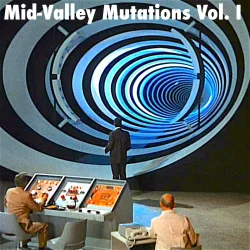 As many of you have probably heard, Bandcamp is donating 100% of their proceeds this Friday to the ACLU, which makes spending money on music that much easier to do. Additionally, KMUZ’s Pledge Drive is very soon, and with that in mind, 100% of the money I make on these same purchases will go to KMUZ’s Drive. Two great causes supported by your single purchase.
As many of you have probably heard, Bandcamp is donating 100% of their proceeds this Friday to the ACLU, which makes spending money on music that much easier to do. Additionally, KMUZ’s Pledge Drive is very soon, and with that in mind, 100% of the money I make on these same purchases will go to KMUZ’s Drive. Two great causes supported by your single purchase.
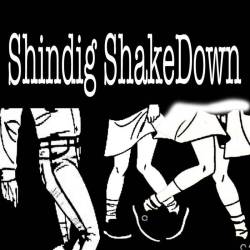 You can get the entire bundle of all 21 of our releases at a discount for $16.25. Or, you can pick and choose what you’d like to purchase. Either way, there’s plenty of releases new and old that are worth investing in, and you can support both the ACLU and KMUZ, two acronyms that do a lot of good for our community.
You can get the entire bundle of all 21 of our releases at a discount for $16.25. Or, you can pick and choose what you’d like to purchase. Either way, there’s plenty of releases new and old that are worth investing in, and you can support both the ACLU and KMUZ, two acronyms that do a lot of good for our community.
We all love music, and we all love supporting good causes. Here’s a way to do both.
It’s astounding how quickly I was able to normalize taking care of an 89 year old man. His name was George, and he was raised in a bar and served in the Navy during WWII. As a younger man he loved to drink, and he married a firebrand who has long since passed, but still filled him with joy and happiness, even at 89. He fathered a number of children, and when he retired chose to sit on his ass and do nothing. And that nothing has only come back to bite him in the same ass plenty of times in the years since.
When I got to know him, a pacemaker was keeping him going, and while there were plenty of dietary restrictions and pills that made up most of his meals, the family referred to him as The Energizer Bunny, and in the five years I had known him previously, this was not the first time it was believed he was on the way out. He is not suffering from the kind of memory loss I’ve witnessed before, but he has trouble remembering what’s going on, the right word for the thing he is trying to talk about, and there are long and uncomfortable pauses in his conversations, punctuated by coughs and other mysterious sounds.
I am but a 40 year old man, and while I have hemmed and hawed about age in the past, spending time with George makes me rethink comments I’ve made in the past. I have some gray hairs, I’m not a spry or in shape as I once was, and my memory has been eroded by years of alcohol and drugs. But I’m alert. I can make it to appoints, and I can do physical labor if I want. (I usually don’t.) I don’t have any illnesses, and I’m not impaired in any way. In many ways, I’m absurdly young, and so naive about what the future holds that I was not entirely prepared for what I would learn about myself.
George and I get along pretty well because, in spite of our age range, we have a lot in common. We both lived in Oakridge at one point. My dad worked for the railroad, and George worked building and fixing roads. We were both born in California, and moved to Oregon later. We are both a little old-fashioned, and I wear bow ties and sweaters and say please and thank you. I like old movies and TV, and we both love the music of Spike Jones. But George reminds me a lot of my family, too. Poor. Well meaning. Having worked his whole life, only to find himself trying to make sense of this future that barely resembles what he remembers from his youth.
We mostly watch TV together, and while his coffee was long ago traded out for a brown colored decaf that is warmed up and sort of resembles coffee, he will still drink it, all day long, and fall right asleep in his chair after a cup. It’s hard to get him to take to water that way, even when I have to use my stern voice. He seems to enjoy westerns, but he doesn’t really seem to care anymore what’s on. His daughter – my wife’s mother – watches a lot of news and sports, and I think he’s a little tired of the incessant prattle of the television. I understand; I’m not much of a TV guy myself, and if I had my druthers I would just turn it off. But I feel the need to fill the space between us, and I let it go, a cushion between us when I don’t know what to say.
The best part about hanging out with George is that he does not give a fuck anymore. Not that he did much before. But it is only amplified now. Once night I decided to turn on Cosmos (something to watch, ya know?), and asked him if he minded. He stood up, and I asked if he needed something. He said, “No, I’m fine. I just want to stand up for a bit.” I said okay and looked back at the TV. Without warning, George drops his bands and his drawers in front of the television, then scratches himself. He sits back down. It suddenly occurs to him that I saw this, and he looks at me. We lock eyes. He shrugs, then looks down and starts pulling them back up. Of course, he needs to stand up again to do this right.
But the entire time I kept thinking, “no matter how bad the itch, no matter who was in my house, I would still go to the bathroom to scratch like that.” I wondered how many years it would take me to get like that, how frail I would have to be before leaving the room to scratch just doesn’t seem worth it.
The first time I had to peel off his socks and confront his swollen feet, is fairly vivid in my memory. The hospital gave me a stack of papers that I keep telling my wife I will read. But she has already read through them, and has gone out of the way to fill up the pill box and made notes about all the instructions we have to follow. So I knew where to turn for guidance. But then I get a text: “take gel patches off of gpas feet when he goes toned.” Then a follow-up message: “To bed” Apparently, one of the side effects of his recent hospital visit was that his feet have been swelling. So this bandages were somehow helping with that treatment. Of course, we are supposed to tell him to keep his feet up, so the swelling will go down. But how is he supposed to remember? So we have to remind him, constantly. It is hard not to sound mean, repeating it so often.
So he had these gel patches, supposedly to help with the swelling.
You’re Not ‘Cool’ Until You Are ‘Bread Baker Cool’
I have come to find that you rarely impress anyone with your bread-making skills, unless you are the best in your area. While his reputation might be safe among the butcher and the candle-stick-maker, you don’t often hear about the glamorous life of the man who gets up at 3 AM so that the first loaves are hot and fresh by 5 for the public to buy from a counter-girl that smiles and can count change back.
Regardless, the role of a baker is not only essential to much of modern life, but as people who are gluten-intolerant have discovered very recently, many of the most delicious things in this world are made using baking. I, myself, have a soft spot for the substance, and have often found bread and a few complementary items a preferable meal to most everything that passes for one in some places. Since we consume a fair amount in my home, it made sense to work out how to bake bread myself, given my recent success with Granola and my general desire to lower my overall costs by any means necessary.
I Sort Of Have A History With This.
This is not the first time I’ve tried to make bread. In 2007 / 2008 I roomed with a gentleman named Marcus, and he was not only an artist and skilled in the kitchen, but taught me a lot about music I’d never heard of, and what I have ultimately come to call a Basic Bread recipe (and most of the Inter-Web-A-Tron seems to agree, too). In those days, we got into a pretty good habit of working together on dinner, where he would make the meal, I would make the bread, and together we would eat like kings, or at least long enough to watch a Nova Documentary.
But what became a habit with him quickly fell to the wayside when we parted as roommates, and while I made occasional loaves from time to time afterward, I never returned to the habit the way I did while I lived with him. (He moved back to California to pursue his work as an artist, and I moved in with an old roommate who had recently bought a house.)
The Phoenix Loaf.
My wife and I discovered that we had a couple packages of store-bought yeast on hand a while back, and she mentioned that her KitchenAid had a dough-hook, which was the catalyst for me to give it a shot again. Since then I have made four batches of bread, only two of which were successful. The good news about the ones that worked out is that they are great, and I learned a lot from each of the mistakes I made. And, of the two that did not work out, only one loaf was not even worth trying to eat; the other was fine if you cut the crust off.
I would say that at this stage, I have the process down, and everything is on track for me getting better and better at it with time and repetition. Now is when I need to start fine-tuning the process, and more importantly, keep practicing as much as possible. Making bread is variable, and getting to know your stove, your ingredients, and your equipment can change the game entirely. My only hope is that some of my mistakes are instructive, as well.
To begin with, it might be useful to get a handle on the recipie. This is Basic Bread, and as such only requires three ingredients: water, flour & yeast. I add a bit of salt and sugar for taste, but in the past have made bread using only those three ingredients. As far a I can tell, everything else you add is just to tweak the flavor, but if I am wrong, please let me know. Most online online recipes mention salt, but also point out that adding too much salt could ruin a loaf (preventing the yeast and flour from doing their thing). These experiments I’m describing here involve me adding a Tablespoon of each to the dough.
1 Packet of Yeast
2 Cups Warm Water.
4+ Cups Flour
1 T Salt
1 T Sugar
-ish, I should add. You’ll get to know what needs to change as you practice. The first rule of thumb is that you will want to add about twice as much flour as you do water. (You can up-scale your dough batches accordingly from there.) If you are buying yeast in packets from the store, then you’ll want to use about two cups of water and about four cups of flour. It could be that you’ll need more than four cups of flour, which you’ll work out as the dough is kneaded. You might need a little less, too. I have found that I need to get comfortable with things being a little different each time I try.
I should point out that basic bread is perfect for beginners because the results are immediate and you will know right away if you need to do something different. Even if you have no style, charm, finesse, or make no effort whatsoever, if you mix those items together in a bowl and mix them long enough, you will get dough. But as you’ll find, balancing the way you mix these items, and how they get them to react to each other, is at the core of bread making, so the more you practice these things, the better your bread will be. But it’s nice to get something the first time, as it really gives you and incentive to want to keep with the practice. You will easily get loaves just trying. Getting ones you want to eat everyday will take work.
Here’s The Process You’ll Want To Follow, Basically.
In a bowl, add two cups of warm water, and a packet of yeast. Let the two react for about 20 minutes. Then add two cups of the flour to the water mixture, and begin mixing. You can mix with a fork or a mixer, if you have one. As you are mixing, add the flour in half-cup increments until you have something that is of a dough-like consistency. You will want to keep adding until the dough looks smooth, and is only vaguely tacky to the touch.
 I should ad that it can feel as if you are mixing and adding an endless amount of flour when you are in the thick of mixing it, but trust me, this is normal the first several times you make dough. You’ll think you’ve been working forever, and you still have a lot more work to go. Just keep mixing. This is where having a mixer with a dough hook comes in very handy. In the old days I mixed by hand. The KitchenAid has made my baking experience so much simpler.
I should ad that it can feel as if you are mixing and adding an endless amount of flour when you are in the thick of mixing it, but trust me, this is normal the first several times you make dough. You’ll think you’ve been working forever, and you still have a lot more work to go. Just keep mixing. This is where having a mixer with a dough hook comes in very handy. In the old days I mixed by hand. The KitchenAid has made my baking experience so much simpler.
 Once you have dough, you’ll want to knead it a bit more to get it as round as you can. Most of the work has been done in the mixer, but you still want to hand-knead it to get it all the way there. Once that’s done, put it in a bowl, cover it, and let it proof for an hour or two in a somewhat warm-ish place. Not hot, you don’t want it to bake. But if it is the winter, you’ll want to make sure you let it rise in a place that is not actively cold, at the very least.
Once you have dough, you’ll want to knead it a bit more to get it as round as you can. Most of the work has been done in the mixer, but you still want to hand-knead it to get it all the way there. Once that’s done, put it in a bowl, cover it, and let it proof for an hour or two in a somewhat warm-ish place. Not hot, you don’t want it to bake. But if it is the winter, you’ll want to make sure you let it rise in a place that is not actively cold, at the very least.
 After it’s proofed, you’ll want to punch the dough down, and knead it again for another 15 minutes. This is where you will be shaping it for the final form that you want it to take when you bake it. You can break it into several loaves, one big one, bread-bowls, etc.
After it’s proofed, you’ll want to punch the dough down, and knead it again for another 15 minutes. This is where you will be shaping it for the final form that you want it to take when you bake it. You can break it into several loaves, one big one, bread-bowls, etc.  Once you’ve shaped the loaves, let them proof for another 30 minutes, as you pre-heat the over. You’ve just given the dough some final punishment, so this final proof allows it to relax before baking.
Once you’ve shaped the loaves, let them proof for another 30 minutes, as you pre-heat the over. You’ve just given the dough some final punishment, so this final proof allows it to relax before baking.
Bake at 450 Degrees for about 45 minutes. If you are doing several smaller loaves, I would bake for 20 minutes, check, then add 10 minutes as needed (if at all). When you’re done, let them cool.
Tips
Kneading the dough takes more time and work than you think it does, and even then, you’ll probably want to keep kneading your dough more. I once asked Marcus if you could knead dough too much, and he never really gave me a straight answer, except to say that it wouldn’t hurt to keep kneading it more. I would be careful you don’t push that logic too far, but when it comes to kneading, you’ll want to do 45 minutes of continuous kneading (at least), and then continue as kneaded.
I would also avoid doing the whole ball of dough as one huge loaf. You can get away with that, and it would absolutely work. But I have found that smaller loaves – even three for the recipe I’ve described – has been more successful and, more importantly, toaster-friendly. Obviously, let the muse move through you when it comes to the way you shape your bread, but you will find that when you do this often, a certain size and shape will become consistently reliable.
Learning From My Mistakes.
I did everything technically right with my first loaf back on the backing horse, and pulled the loaf out 20 minutes early because the outer crust was brown already, and seemed hard to the outer “squeeze.” As it was late at night, I went to bed, woke up and found the center was still soft dough. I thought I could save it by re-baking it, but I only managed to further ruin the loaf.
What I learned here was to follow the instructions. For that recipe, it should go for at least 40 minutes, and maybe a further five just to be sure for the single-loaf. Under-baked will not do the job, and will just lead to ruined bread.
As for my second flop, I went too long in the proofing stage, then over-baked the three separate loaves by at least five minutes, giving them each a crust that was impenetrable. If the crust is removed it was fine, but even then, there was something about the bread that tasted “off.” The lesson here is don’t over proof your bread, and if you are doing several small loaves, monitor them a little closer in the oven near the end of their baking cycle.
I would end by saying that the shelf life is not as long as you think it might be. Yes, store it in a bread-box or some other storage device that keeps it cool and dry. But your best efforts will not give them the same kind of storage lifespan as something you buy in the store. The store-bought stuff is treated with all sorts of stuff to preserve the bread for ages. The stuff you just made will go bad in a week or two, and is absolutely best within a day or two of baking. So, don’t do like I did, and plan on eating something that you slice up to find is largely green on one side.
Conclusion
Baking bread, like almost all of the most enjoyable pastimes, is a sport of meditation, and requires the baker to really be in-tune with the environment and the way that you make that bread. The recipe is certainly a roadmap, and the guidelines will get you a loaf when all is said and done. But the thing about baking is that it is a game of getting better. You can achieve a better loaf through improvement, and that is done by getting to know your kitchen better, and getting to know the process intimately, through practice and research.
I have found that reading about other people, and their efforts to bake bread, has also been enlightening. I would never had added the sugar and salt if I hadn’t read about it, and while I still think the loaves need more improvement on the part of the baker first, the taste is more than just “bready” now, and that is a change.
Most importantly, really look at your process. Is there too much flour? Not enough kneading? (Usually the problem, early on.) As bread can be consumed quickly an needs to be made daily, this gives you a lot of opportunity to practice and get to know your process very well. Tweak and change little bits here and there, and find the combination of changes that lead to a loaf you really love.
Keep at it, and become comfortable with the work of the experience. Bread baking does require your concentration, and so it offers you a chance to get away from the computer, and everything else, and just be in the space you are in, doing one task. It’s a great opportunity to give yourself a chance to do something that does not require you to be engaged in any other way.
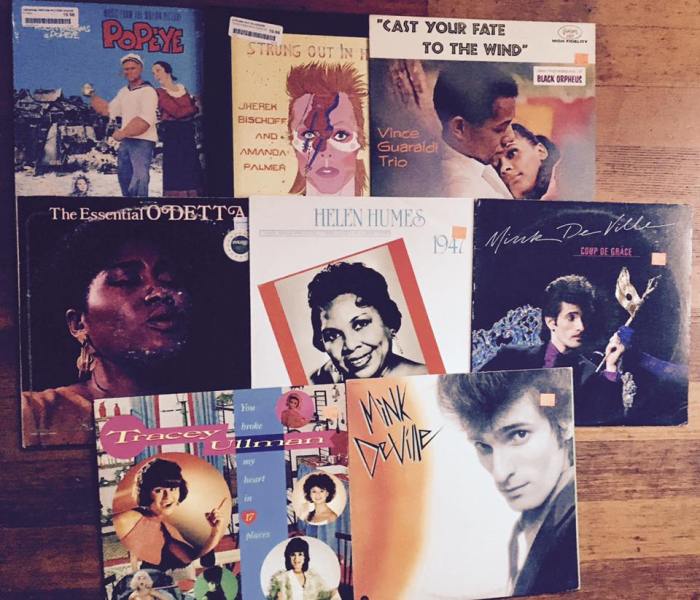 A Review of The 10 Albums Stolen From My Studio in 2016
A Review of The 10 Albums Stolen From My Studio in 2016
At about 8 PM on Christmas Day 2016, my home was broken into. My wife, cat and I were with family at the time, and most of the neighbors were, too. Even worse, we were in the process of moving. For a number of reasons that defy logic and explanation, we moved mostly on Christmas Eve. We had left some things to move after Christmas, and thought that we could leave our house unattended until we were done celebrating. But when we arrived at our old house on the 26th, we found that everything that wasn’t nailed down had been ransacked and overturned, while anything of actual value was loaded into a truck and moved.
Who would be suspicious? We were doing just that the day before.
To make matters worse, both my wife and I had offices in the old house. We were planning to continue working out of there until we had Internet service at our new place, which wouldn’t be connected until January 4th. This means that in addition to our bicycles and lawnmower, they got our laptops, my desktop and studio recording gear, my wife’s collection of purses and her winter coat, and a stack of the last records I had not moved yet. In total, it was about $6000 worth of stuff that was stolen. Someone’s Christmas present to themselves, probably snorted before the week was out.
One of the hardest things to do (at first) was come to terms with what was stolen. It was hard to remember, at first. With each new corner turned, we found something else that was gone, something else that they took. And we still haven’t unpacked from the move. Who knows what else we’ll find missing, when all is said and done, when we can no longer use that as an excuse. How do you look for things that are missing? How do you notice what isn’t there?
While we are not quite over what had happened, the immediate shock has faded. And we’ve come to accept what is gone, in a way. But when I think about what we lost, the thing that is most frustrating is the pile of records they stole. It was an assortment of recently heard and recently acquired stuff, plus a few things that had not been filed when it came time to pack. I had less than 20 records in that pile, maybe more, maybe less. I was gonna use some for my radio show, but on the whole it was just stuff I was looking forward to, things on my mind just before the break-in.
This isn’t a complete list, nor is it the most valuable or the most precious. These are just the things I remember that were in that pile, and stuff I wish I still had. Much of this stuff came from Dimple Records, a place I visited just before we began to pack. (Thanks Dad & Mernie!) It seems important to Eulogize these albums. It’s likely they never found a home, never got sold, and wound up in some dumpster somewhere. They deserve a proper burial, a goodbye to music that will go unappreciated.
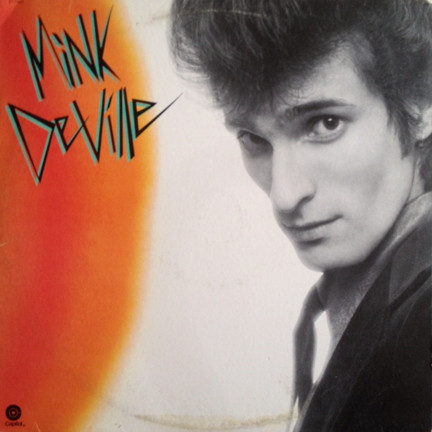 10.) Mink Deville & Coup de Grâce.
10.) Mink Deville & Coup de Grâce.
I really only knew “Spanish Stroll” by Mink DeVille, but for a steal, I decided to check them out. My wife and I listened to these, and we actually enjoyed them a lot. I was really looking forward to enjoying them, too. Now some junky probably threw them away when it turned out that they weren’t particularly valuable.
I picked this up based mostly on her reputation. Odetta is a legend, and while I wasn’t familiar, I was looking forward to learning more. This is probably typical for her career. Overlooked and ignored, Odetta is tossed around by people who could not care, and when in the hands of a fan, is never given a chance to be appreciated. Poor Odetta. You didn’t deserve this, at all.
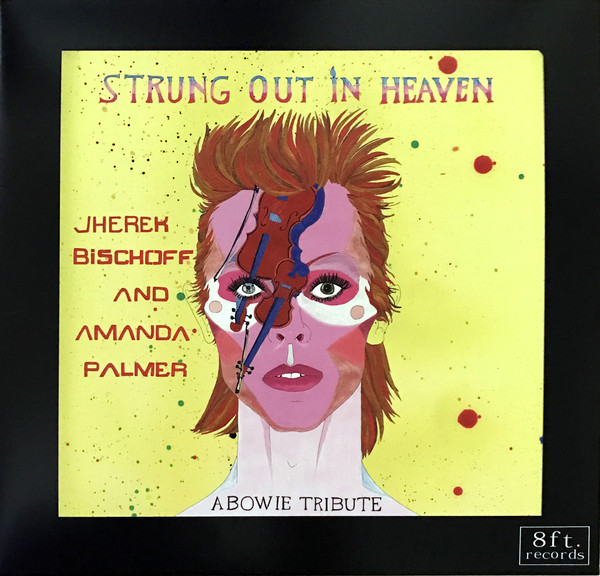 8.) Strung Out In Heaven – Amanda Palmer’s Prince / David Bowie Covers
8.) Strung Out In Heaven – Amanda Palmer’s Prince / David Bowie Covers
Here’s the real tragedy: we had gone to the record store day sale, not only to get some stuff for me, but for my wife. She specifically wanted this, and we got it, excited to support the cause, and hear the tracks that were getting a lot of play because of the recent losses to the music world. These assholes don’t realize how much the music world is suffering. Instead, they want a quick score, and even though I can hear this album anywhere online at any time, that is not the point. This one was completely unopened. Pristine. And now, completely destroyed, ruined by nameless assholes who will never care.
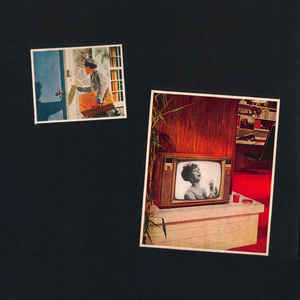 7.) Negativland
7.) Negativland
In the year 2000 I heard that my favorite band – Negativland – was running low on vinyl copies of their albums, and that they would be selling CDs after the LPs sold out. I immediately ordered a copy of their first album, and got a nice hand-written letter back. The album came with a custom made cover, a collage assembled by the band members. I ordered another, but by then the LPs were gone, and got CDs for their remaining albums. I loved that album, and listened to it often. It sounds good anywhere, anytime, and I just wish the junkies had taken the time to listen, and get to know the album. It is well worth it, no matter what your interests are.
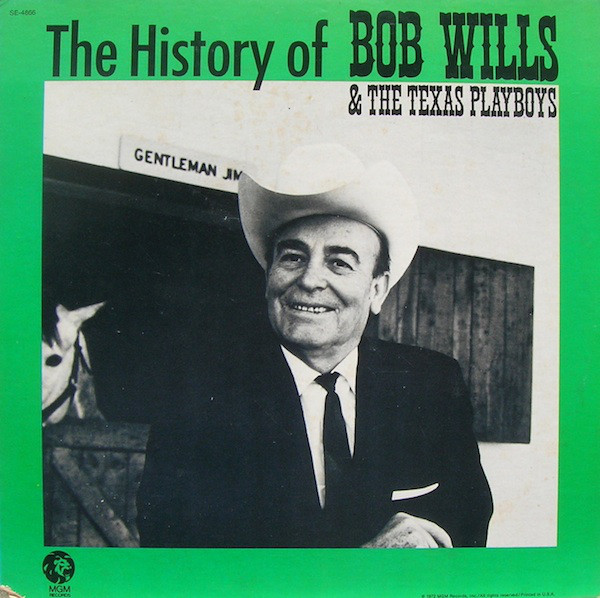 6.) The History of Bob Wills & The Texas Playboys
6.) The History of Bob Wills & The Texas Playboys
Bob Wills is great, but there isn’t anything special about this record. It is older than me, and it has a lot of hits. But I love it mostly because it belonged to my Grandmother, who has passed. You will never love that album as much as I loved her. What dicks.
I already have an original copy of this record, but I decided to pick up the Record Store Day reissue because there is no other movie that can make me cry faster than Popeye, and the soundtrack is no exception. I’m not as mad about this, because I’m sure even the bonus tracks are easy enough to find. But this was unopened. And, to be honest, this is probably the most personal attack of the bunch. You don’t care about these songs like I do, like my family does. How dare you. That record is too good to be treated like that.
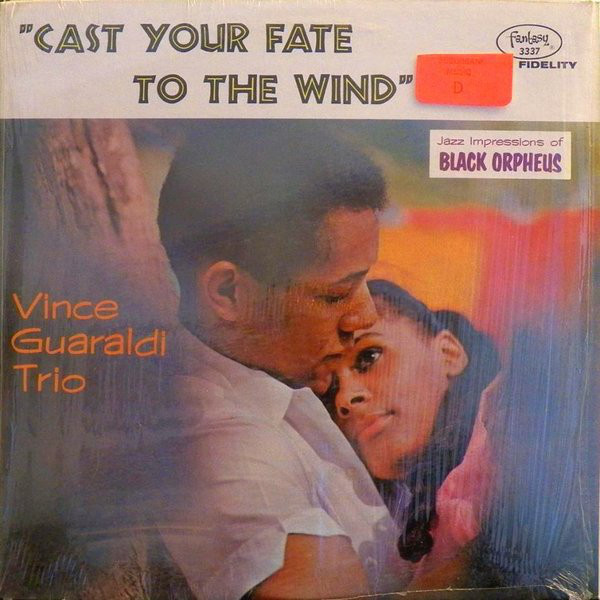 4.) Cast Your Fate To The Wind by The Vince Guaraldi Trio
4.) Cast Your Fate To The Wind by The Vince Guaraldi Trio
I’m trying to imagine these junkies putting this album on. Do they know who Vince Guaraldi is? Could they connect with the music of Black Orpheus? What would they get out of it? Would they enjoy it? Do they understand the journey into the underworld that they have taken? Would I have enjoyed this album? Do I enjoy the irony? Who can say…
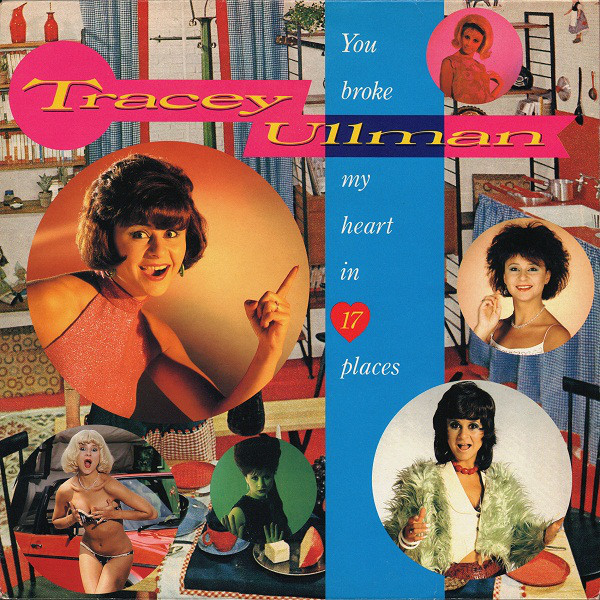 3.) You Broke My Heart In 17 Places by Tracey Ulman.
3.) You Broke My Heart In 17 Places by Tracey Ulman.
They probably broke this album in 17 pieces.
I took a chance on this record because of the price and because it seemed like a good bet that it was good. And it probably is, but that’s not the point. I had entirely forgotten I’d bought this album until I saw a picture of it that I’d taken, just after I purchased it. Part of me feels bad; I didn’t even remember that it was gone. That’s awful of me. How many albums do I have that I neglect in some way, that needs attention that I can’t even remember? The dangers of collecting? Perhaps. But I would have at least given this album a chance. And they never would have.
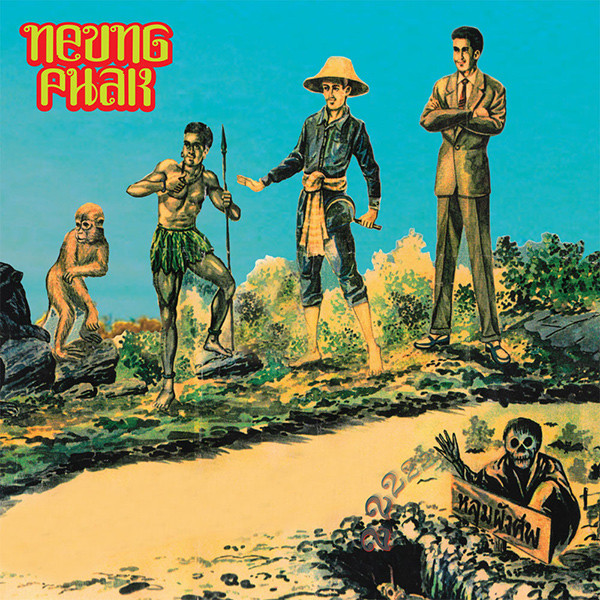 1.) 2 by Neung Phak
1.) 2 by Neung Phak
Probably the rarest and least-known of the bunch, this is most likely out of print, and not something you would find in Salem, at least not very easily. I bought this record from Mark Gergis, when I saw his band Porest play in Portland. This was one of two US performances for this artist, and I traveled out of town with a friend at night to see this show. Mark, who had never met me, was really nice, and had no idea how much this night meant to me, had no idea how much I was looking forward to hearing this album. He didn’t have to be nice to me. Who was I to him? And yet, I never got to hear this album before it was ripped off. Mark, who heard about this, send me a digital copy, and for that I am eternally thankful. But what did they see in this album? In any of these albums, for that matter?
* * * * * *
There were more. There will be more. Forever this event will haunt me. Every sound is a window breaking, every movement someone stealing our stuff. Who knows if this will go away? Who knows if I will get over these being stolen from me. I can only say that there is a part of me that wishes they would listen. That they sat down, and by the end, found something meaningful in those albums.
Because I sure did.
I Thought These Movies Were No Longer For Me
To be fair, I was never so much a Star Wars fanatic as to put myself anywhere close to the kind of contenders that currently exist for superfan. But as kids, we had Star Wars sheets, and I spent a lot of time playing in the yard with my siblings, running around shooting blasters and using sabers as part of the never-ending mash-up of games we played involving The Cat From Outer Space, Inner-Space, Indiana Jones, and just about any other movie that caught our fancy growing up. But even though I was not a superfan, even though no part of me screamed, “THIS IS MY LIFE,” it was so much a part of my life that I always felt that it was there, somewhere in the back, guiding me. Really, more than Star Wars, it was Harrison Ford’s characters that I really looked up to.
Between the Star Wars and Indiana Jones movies, it is safe to say that Harrison Ford was essentially my second father. It isn’t that my own father was absent per se, but through a number of circumstances that involved his work-life, and my subsequent adolescence, we just didn’t see a lot of each other. Not that I particularly thought of Harrison Ford as a person in the world that could, theoretically, even BE my father. He was just some actor. But counting up all the hours spent watching him and seeing him act as an adult seemed to imprint onto me this feeling that, perhaps, he was someone that I should probably watch a little closely, and see if I could learn anything from him.
Not that he ever portrayed or oozed any amount of fatherliness. He was the guy that you would go on adventures with, and most likely, would lead you into trouble. And for some reason, my own father didn’t bring me on his adventures, so at least I got to see Ford’s. I knew that my own father worked for the railroad, and that he also went hunting & fishing, but I could only imagine what this was code for, and I could only dream about what relic he was uncovering, and what space ship he was piloting. The world of Indiana Jones felt closer to me growing up – especially since Indy had already traveled with a kid, Short Round – and since my real father did not take me to every derailment he was sent out to clean up (where I imagined him lifting the trains up himself, asking for guidance as he set them back on the tracks), while he was gone, I could at least follow Han Solo to the end of the Universe several times over. All before my father could get home from work.
In 1981 I was six years old, and my parents took all four of us (my brothers and sister) in a station wagon to see Raiders Of The Lost Ark at a local drive in. This was ideal for any family in the early ’80s, offering a chance for my parents to sneak off and get stoned outside while we were mesmerized by the speaker delivering the sound of the movie. While I was absolutely horror-struck by the melting nazis at the end (a nightmare that stuck with me for years), the rest of the film sparked in me a deep love of Indiana Jones, and I spent hours in our yard being chased by boulders and running through the woods, studying “archeology,” wanting to be just like him. When I finally got a denim jacket, I tried my hardest to get it to look “brown” like this (I threw dust and dirt all over it), and I begged my parents for a hat like his. It so subsumed my imagination that to this day the music and feeling that movie fills me with can bring instant tears of nostalgia and joy, and I found myself more excited about the ride at Disneyland than just about any other amusement part experience I can ever remember.
I don’t really remember a time when I hadn’t seen Star Wars. With hindsight, it is likely that I only ever heard about Star Wars in those days, and might not have actually seen it. (I was two when it came out in theaters, and in the late ’70’s it was unlikely my parents had a VCR, or that it was on TV.) More to the point, most kids have a spotty memory when they’re that young. For all I know, I was in the theater for all of it and just can’t piece it together. I have a vague memory of being watched one night when my parents when to see a movie without us and I feel like it might have been Star Wars (only because I also think I remember them talking about it), but even that might not be a real memory. In school, Star Wars was all any self-respecting kid could talk about, and so while I may not have seen it personally, I already had cultural knowledge of it on a fairly intimate basis by the time Empire Strikes Back came out, and was all anyone could talk about on the playground. And yet, I did not see it in the theater, to my knowledge.
No, what sticks out for me is that I saw both Empire Strikes Back and Return of The Jedi on consecutive days in the summer of 1983, when I was visiting my cousins with my family. It started like this: my cousins had a VCR in the house, had rented Empire, bought a bunch of candy, and with our two families crammed into their outfitted den (to accommodate the large crowd), we huddled around what could not have been more than a 15″ Standard Definition screen and watched in awe. By the time the lights were turned off and the crawl began, I felt like I knew everything I needed to know – weather through memory or social osmosis – and it absolutely flooded into me. I was excited, disgusted, scared, and sad, all at once, and while the end brought me to tears (WHAT ABOUT HAN SOLO!), I was comforted by my parents that everything was going to be alright.
This, of course, was all preparation, because the following day we were going to see Return of The Jedi in the theater. While the exact memories of these experiences are largely lost – I mostly remember impressions and what I was told about that day: being happy, playing Star Wars with all my cousins afterward – I try to imagine what my eight year old mind must have thought having seen those two movies in such close proximity of each other, at age eight, no less. My imagination must have been overwhelmed with new ideas and characters to incorporate into my fantasy world, and while I certainly remember loving it, I had no idea then how many times I would actually see these films in the years to come.
While I have heard many people talk about what they find to be their own personal favorite film, with a clear head and having seen them all, I decided very early that I loved the first film the most. Star Wars – what is now referred to as “Episode IV” or “A New Hope,” but in those days, it was just Star Wars – had a quality to it that felt like a story from my childhood, and perhaps having seen it the least and having such a social memory of it made me like it more. Much like Tom Sawyer or Lord of The Rings, the first film felt like like established literary canon, a part of the vernacular that every kid my age spoke. I have contended that, before Clerks came out, very few people would point to Empire as their favorite, and that it was Kevin Smith’s commentary on why Empire is the superior film that has put that one in the lead as the better movie. But having met a number of people who love it unconditionally, I’ve come to realize my opinion is in the minority. Regardless, all three films were incredible, and while my heard was with the first film, I never turned down seeing the others if I could.
Like many people in those days, when VCRs became affordable (and rental stores popped up everywhere, even in small towns), it was worth it to make sure you had one in the house when HBO was offering a free weekend, or when another family would loan you a bunch of stuff so you could copy their films, and among our many collected tapes as I was a youth (with at least two other boring films crammed on the tape with it) was a recording of Temple of Doom, made shortly after it had hit cable channel. (The turn-over for films in those days was pretty quick on HBO, so we must have had that recording by early ’85, the year after it was released in theaters.) I must have watched that movie hundreds of times, knew every line of dialog, and could cite Indiana Jones knowledge with the best of them.
It wasn’t long before our families got copies of the Star Wars movies too. And, of course, in 1989 I was in the theater watching Last Crusade with all the other teens, and finding that while the cynicism of a then-14 year old was pretty strong, the music and the mania that was Indiana Jones could still instantly fill me with excitement, no matter what age I happened to be. The end puzzles of that film became a whole new game I tried to act out in the woods by myself.
My parents were just as excitable as we were, and periodically between the ages of 8 and 18, we would get together and watch them as a group or in small sub-divisions, depending on who was game. While we never managed to get a copy of Raiders or Last Crusade in the house, we still managed to seen them regularly (on TV, rented, or at a friends house), and by the time I was thrown out of the house just before I had graduated from High School, I had seen those six movies hundreds of times. Often on tapes that were poorly dubbed from television, at the worst resolution, and on the smallest screens. And we never cared in the slightest. We would watch them at any time, in any form, for the music, for the action, for the dialog we’d memorized, but mostly because they were so goddamned much fun.
It isn’t that I haven’t come to appreciate Harrison Ford for his other work, but I am hard-pressed to name many other movies of his that I’ve seen, and more to the point, none of them are as good (in my mind) as these six films. It isn’t that he is a bad actor, though he is totally willing to turn in a so-so performance just because he feels like it. But when I see him in other roles, all I see is Han Solo and Indiana Jones wearing some other costume, looking longingly out the window, wishing they were running around hunting for treasure, on the run, fighting nazis or stormtroopers. Not only do the performances in these films capture the imagination, but they offer a unity of form and function that has the same artistic tone throughout all six movies, largely because of this shared character trope given life through the John Williams score that is ultimately hummable and breathtaking to listen to, all at once. The serialized nature, the comic sense of humor, and the feeling that you get to come along while these amazing events unfold, these six films felt so connected in my mind growing up, and probably always will, no matter how old I get.
Han Solo and Indiana Jones are essentially the same character in different costumes when you get right down to it, and while the environment and character motivations are slightly different, both are con artists, even among their friends. Both are incredibly smart and suave. Both are swash-buckling, willing to do whatever it takes to make it out of a situation that seems and appears to be absolutely impossible. And they both have their own immediately identifiable costumes, unmistakable even in profile, and yet feel similar in some way. They’re both quippy, they’re both funny, they both mutter jokes to themselves even when no other on-screen characters are there to hear it, and they both share with the audience their charm and sophistication in a way that makes you feel like you are there with him, acting as his side-kick, following his lead, a part of the action, too. You get to see Han and Indy when they are at their best, their worst, their most exciting, their most beat up and bruised, their most romantic, and they still let you tag along. In many ways, I knew more about Harrison Ford’s characters on screen than I do about my own father, or anyone else in my family, for that matter.
The irony, of course, is that I don’t know if I actually took any of Han/Indy’s lessons to heart after I left the house and lived on my own. During that period of my life, I only had an ancient copy of the first Star Wars film on VHS, and the country mouse behavior of Luke and the overall innocence of everyone in that film was closer to how I really felt about life, and I bore no resemblance to my hero in the films. First, I displayed no confidence around women of any kind. I did not take chances, I was not athletic, showed no skill in school or in academic settings, struggled with puzzles and riddles, could not lie or con way way out of being wrapped in toilet paper, and had none of the ruggedness that he oozed in every scene. I could barely bring myself to dress with any amount of style or ruggedness, and I could not pull of the laconic turn of phrase like him. My slow-witted, introverted & nerdy confusion about life outside of fiction only made me awkward and confused most of the time, as if I was always itching to pick up some power converters at Toschi Station. I was easily excitable, and would tip my hand so often that anyone and everyone around me knew exactly what was on my mind. I had no arch-rivals, and the few fights I had been in not only illustrated my clumsiness – I could barely even climb a tree without falling out and getting hurt – but resembled so little of what Han Solo or Indiana Jones were actually like as to be comical if I were to ever claim publicly that they were my idols.
As I got older, this idea of manliness and masculinity seemed entirely formed more by Ford’s characters than by any of the other men in my own life. Divorce can often create this kind of confusion in kids (especially when it happens when the kids are old enough to be looking for father figures), but in my case the post-divorce world was entirely devoid of men. I was the only one; my mom and her girlfriend took care of their three girls, while I was the one being asked to kill spiders and take out the garbage. The only men in my life that I could even speak with any amount of authority about were Ford’s characters, and like many sons who look up to their father-figures, I was unlike him in many ways that made me feel inadequate. The kind of “put-together messiness” that is at the center of those two characters was something that I chased after in my own fashion for years, but never succeeded in capturing. (I gave up and started wearing bow ties and sweaters after a while.) I thought I could use the lessons I’d seen in the films to aid me in my life as a young adult. When I pursued women I tried to imagine Han Solo wooing Leia, or Indy & Marion together. But none of my jokes landed, I was never adventures and confident enough to make an impression, and more importantly, my gawky and ineloquent manner illustrated how unimpressive I was as a young man.
Even my sense of writing was inspired by him as I fumbled with pen and paper. My male characters were some version of a smart adventurer who might have had some dirty dealings in the past. I tried to shape the dialog as if it had come from Ford’s mouth. There were never any paladins or virtuous men in my fiction. It was all well-meaning rogues that I would put down on paper, loved by everyone, reflecting what I wished I was, and wished I could be.
Living on my own as an adult naturally caused me to find and seek out other interests, but I kept a copy of the the first film on VHS for years, something I still have to this day. For a long time, it was one of the few movies I actually owned, along with Evil Dead II, Negativland’s “No Other Possibility” tape, and Almost Famous. But by then, the charm and allure of continued Star Wars-ery felt a little crass, and exploitative. I worked at a B. Dalton in a mall for many years, during the time leading up to the prequels, and then continued to work for them as the merchandising blitz hit a threshold that was hard to fully take in. As I understand it, the franchise has held at that rate for some time, and Disney has only made it crazier.
A Word About The Prequels, Now That I Mention It.
I never developed a relationship with any of the movies made as prequels or since then, not like the one I already had with the first six films. When word first came out that the original Star Wars film would be in theaters (remastered, and with cleaned-up effects), I was interested for a hot second. But after seeing what they did to Star Wars when I finally saw it, I decided to hang on to my VHS for the time being. The advertising and tie ins were, of course, leading to the prequels, and what I saw really put me off the “Episode I” idea at first. I let it sit for a while when it was in the theater initially. In early 2000, when a friend of mine was in town for a bit after being at school in the UK and he hadn’t seen the movie, we agreed to make an afternoon of it. What sticks out the most was the puzzled conversation in the car on the way home, as we tried to make sense of what we’d just seen.
As I worked my way through what was going on in this new movie, a few things became apparent over the next few weeks. First off, the film was entirely forgettable. Where I remember endlessly quoting of the older movies, this movie felt inarticulate and dry, with stale lines delivered by semi-lifeless actors who didn’t seem to want to be there in the first place. It wasn’t long before I couldn’t remember what happened at all, and for the most part I can only really tell you that I remember meaningless speeches, pointless fight scenes, and characters that were almost, but not quite, entirely unlike the ones I remembered.
But, more importantly, what I realized was that Star Wars was no longer for me. As much as I had loved those movies growing up, in the late ’90’s / early 00’s the movies are being presented in a different light, and to a different crowd. The re-edits, cartoony CG, the bad acting, and the emphasis on explaining things where there didn’t need to be any explanations made these movies pointless, compared to the adventure laden, funny and poetic tone the original three had taken. The prequels were a overwrought slog through a kind of pomp and circumstance that were largely joyless, and left me feeling ostracized as a viewer, uninterested in what the story might have been.
Or, rather, I should say prequel, because I have only ever seen Episode I. I never bothered seeing the other movies when they came out because I had already made up my mind, and with each new film I just saw and ad for COMMERCIALISM, and felt gross when the idea of watching them came up. Even when a girlfriend of mine in the early 2000’s insisted I watch Episode II & III with her on DVD, I balked for quite some time. When I finally began to watch the second film, I was confused and annoyed almost immediately, and gave up soon thereafter. (Perhaps I watched them while drinking and sorting comics, the memory is fuzzy.) It was talking with her that made me realize not only that these movies were very much not for me, but that our relationship did not have much gas in the tank, either. (It didn’t, sadly.)
This feeling of being left out continued in the summer of 2008, I went on a date with the girl I was seeing at that time to watch the then-new Indiana Jones & The Kingdom of The Crystal Skull, hoping to recapture some of the joy of those early movies. While the experience was not terrible, per se, it made me realize that the “not for me” quality was still there, and still present. There were parts that I liked, much that felt indifferent about, and some that was just plain bad, from any perspective. (I was initially going to write about the film for this blog back then, but gave up and wrote two lists of things I liked and things I hated, and much of the lists repeated.) In fact, the experience sort of put me off revisiting any older movies from my childhood for a long time. In many ways, I felt left out, and didn’t want to return to that feeling if I could avoid it. Growing up, these movies were always about inclusion, but everything made since I’d been on my own seemed to be exactly the opposite. There were hundreds of other movies to watch if I was bored. Why should I rewatch something when there was so much out there that was new?
It never occurred to me that Han/Indy was a father proxy until pretty recently, though. Having hit 40, I have become overly sentimental about everything for some reason, and the slightest pang of nostalgia or the sweetest and kindest moment in a film brings me to tears instantly as I think of my wife and the things that are important to me. (If there is a scene with a man and woman talking about how the feel about each other, I am in tears before the scene is over.) So it is not hard for me to start going to maudlin places when it comes to stories I love. But a conversation I heard on The Incomparable podcast really struck me, when John Siracusa mistakenly called Han Solo by the name Indy, and threw away a comment about how they were basically the same person who raised him anyway. I didn’t exactly consider what he had meant by that at the time, but that point only came home to roost when my wife and and I watched Temple of Doom recently. Not only was this a movie that I clearly remember watching nearly every day for years, but there had recently been a nearly 15 year gap since my last viewing, and my life has changed dramatically in that time. The effects of college, broken relationships, heartache and epiphanies, and the years to sit and ponder and let things stew and fester, have changed me considerably, and I came out the other side of the last 15 years with a wife, a degree, and an analytical perspective that I did not have the last time I sat down to a classic Indiana Jones movie.
What stands out from watching it – with Siracusa’s comments in mind – is the Indy / Short Round relationship, and how endearing it is. Indy cares so much for that kid, and Short Round wants to be just like Indy so bad that he follows Indy everywhere, trying to act like him, talk like him, play cards like him. This relationship pays off in the film, because it is only Short Round that can undo Indy’s brainwashing by reminding his father figure that he loves him. You can see that their arc completed when Indy and Short Round are fighting in parallel near the end, and they are now exact reflections of each other, throwing punches in unison, overcoming their own hardships in nearly the exact same way. When they look at each other afterward, it is so obvious that they are stand-ins for each other’s missing child / missing father, I broke down sobbing in front of my wife as we were watching it.
This is probably so easy to explain that you have already jumped to the conclusion already: Short Round was my proxy as a kid, and yet now (as an adult), I am seeing their relationship in a very different way, and not just through the eyes of a longing child. I wanted to be like Ford’s characters, and failed as an adult. Short Round, to some degree, has succeeded where I could not. This certainly gets at any number of underlying issues that could easily be probed if I wanted to lay bare my own psyche for further psychiatric inspection, but I imagine that this experience is probably not that much different form other middle-aged men like me who grew up largely without fathers. At least, I am certainly not the only Indiana Jones fan who was raised on these movies and looking up to Harrison Ford’s characters.
The Indy / Short Round relationship is only sadder if you look at it from a narrative point of view, too. Temple of Doom chronologically takes place before the other films, and Short Round is nowhere to be seen in any of them. Short Round, having grown up and reached the same kind of status as his mentor, clearly goes on with his life, to find a path that leads him to his own future and life without Dr. Jones. In many ways, their relationship is over when the film ends, and the father/son bond they solidified seems to have disappeared, the true tragedy and loss of these films. (Yes, continuity nerds, there are “official” sources that say that Short Round has a life outside of this film, where he goes to school and becomes a professor like Indy. But we never see it in the films. And even still, this would suggest that Short Round has completed his transformation into following in his father’s footsteps, at the cost of no longer getting to go out on the adventure anymore.)
History is a funny thing, in that the events of the past only make sense in hindsight, and seen against what is happening now. It didn’t take long to break the Inter-Web when Disney announced they had bought the rights to Star Wars, and were making six new films over the next several years, the first of which was in 2015. It seemed like some weird future news headline from Back To The Future II, and felt very out-of-place to me. But the writing had been on the wall for years. Lucasfilm was stagnating, and Disney was knocking it out of the park with the acquisition of Marvel. There were enough hot young directors out there that would bring home the money with the right financing and script, and Disney could afford to keep working until they get it right. It was this odd moment where there were two possible futures: one good, and one terrifying. And it all hinged on Episode VII being worth a damn.
This is, of course, a long way of saying that I am still not sure what to make of the events in The Force Awakens (and I will try to talk about this as spoiler-free as possible, but I suspect that everyone at this point knows what happened). It was clear, long ago, that Ford had an uneasy relationship with Han Solo, and the idea that he would come back – even if for only one movie – seemed like part of the package deal when it was announced. It seems very clear that no matter what the actual outcome of the film happened to be, this would be the last time we see Han Solo, and even the trailer seemed to be hinting at that. I knew that this would probably suggest that I would have to process this loss at some point. While I did not watch those movies as obsessively as an adult as I did when I was younger, I would check in with them now and then, and certainly found them a part of my life in a way that I didn’t full understand until I reached middle age.
I am not usually the kind of person who cares about this sort of thing, and to be honest, until I walked out of seeing The Force Awakens the other day, I hadn’t read a word about any of it. Because until I saw it on the screen, I couldn’t have cared less, to be honest. I was firmly convinced that it would be okay at best, that Han Solo would be leaving the franchise, and that so much was riding on it that there was no way it could be any good. I had paid so little attention to it that my mind was firmly focused on Guardians Of The Galaxy 2 as the sci-fi film I wanted to hold out for in the theater. I simply had no interest. Even when it started to seem as if it might be good, when the cast and director was announced, I balked. Reports were coming in that people liked it. The script was supposed to be exciting. The other actors all looked cool. Could this, even for a moment, capture the excellence of those early films?
And, of course, there was the other problem to contend with: my own nostalgia. I am ridiculously prone to thinking about the past, and the lens through which I view those movies – the lens through which we all view them, I think – is so coated in that fuzzy Cybil Shepherd soft-focus filter that I don’t think I’m a good judge of what a good job might look like in a Star Wars movie. It was easy enough to dismiss the prequels because they were so badly made, and that is the consensus argument, even for the people who say they love them. But would I be able to view a Star Wars movie and understand it on its own terms, without being over judgey about the way they portray Chewbacca, or heaven forfend, Han Solo?
In a lot of ways, it was easier to forgive the new Star Trek movies, also by the same director. Star Trek has had endless iterations, and hundreds of hours of material, compared to Star Wars. In my mind, even if I had hated the new Star Trek movies, they didn’t diminish anything about the originals, which were all still there (un-tainted or edited, I might add). We were fortunate enough to have some pretty good movies with the Star Trek reboot, so there was nothing to get too upset about in the end. But this was different. There was one chance to get it right with this series, and there was so much at stake emotionally that it seemed like a huge leap of faith to even buy a ticket for it.
But that trailer. Seeing Han & Chewie at the end. It HAD to be good, how could it not? And even the sense that this would be the end for Ford, that he would bow out gracefully and move on, made this one a little special. We needed some closure. We needed a way to look at the past with a new perspective, to pull off one last crazy adventure, and relive that experience again if we were ever going to feel The Force flow through us again. We needed it as a culture. We needed a good Star Wars movie like we needed to eat healthy and exercise more. Our social well being depended on it.
I can’t (and won’t) spoil the film. Most likely you’ve seen it anyway, and how excellent that it was a good film, too. Not just a good film, but a good Star Wars film, something exciting and funny and beautiful and tense and sad and wonderful all at once, with cute moments and scary moments and everything I wanted, and things I didn’t know I needed, too. And, as we obvious from the interviews and the trailer and from Ford himself, Han Solo isn’t coming back, or rather, Ford’s Solo isn’t. The character will persist, played by other actors for sure, but at 73 he not only looks tired, but like a tired father, who has raised countless children on screen, and isn’t quite sure how much more oohmph he has left in him. He doesn’t need to be running around, trying to be a con man one more time, and his character makes that point, too. He shouldn’t be doing this stuff. But, as usual, Han is running away from something, and fatherhood seems to be at the top of the list.
Our feelings and emotions are so complicated and entwined with the places we have been and the things that we have done, that it is no wonder that we struggle – often several times a day – to keep them under control. My family’s break-up, my parent’s divorce, and the subsequent hardships of being estranged from both halves, trying to find a place where I belonged and where I fit in, coming to terms with the mistakes of the past, these things are so complicated and have so many vectors that it is difficult to pinpoint where one feeling comes from, and why thing x fills me with this emotion, while thing y fills me with that. I can’t be the only one. And yet, when I make the same comment as John Siracusa – about Harrison Ford essentially being my father – I’m shocked that there isn’t more agreement from the people around me. I know countless women and men who are in love with Ford’s characters, and perhaps this experience or sensation is limited only to boys who have absent father’s in their lives.
There is a part of me that wants to use this narrative as a way of spelling things out, of providing specific personal examples that will get at the heart of what I’m saying. I don’t want my parents to sound awful; they did what they could, with what they had, and they tried to make it work for as long as possible, not just for the sake of their children, but for themselves as well. But as much as I want to go into detail, this story isn’t about them, and it isn’t about painting them to be heroes or whathaveyou. They are people, they have lives and stories and feelings too, and the incredible thing about growing up is that you realize that they are as frail and confused and baffled by the world around us as I was when I was a child.
Harrison Ford never wanted to be my father, and I never asked him to be, either. By chance or fate, our lives have come to have a bond that I can’t break, even if all my time as a drunk 20 and 30 year old tried to ignore at parties and in bars with girls. I looked up to him in a way that I have never looked up to anyone else, and I followed those first six movies with such academic closeness that my DNA will have Ford-like imprints on it if anyone wants to run the tests. Sure, Ford wasn’t the greatest father. He was absent a lot too, only there for certain kinds of exciting adventures, then gone again for years at a time. Surely, our relationship will always be one that I remember, and one that I can recapture at times when one of those films happens to be on.
But even writing about him this way is making me weepy, as I wrestle with both middle age and him as a part of my life. Perhaps there is something here that offers insight into why I don’t have children, and why I have never been comfortable with any kind of parental role in anyone’s life. But it is always why father and son stories absolutely slay me, too. It is so hard for father’s to talk to their sons in a way that isn’t coded, or meant as practical advice. And it is nearly impossible for sons to have that same conversation about the roles we plan in each other’s lives, because we have a hard time seeing our father’s as the frail human people that they are first, and as a responsible adult second.
Indiana Jones, of course, has a fifth installment in the works, and all the media news is pointing to Ford being involved. This is a little scary, for sure, not only because of the last attempt being so mediocre, but with Ford as old as he is, the Indiana Jones I love might not even be in the film at all. (The idea of “old” Indy, as seen in The Young Indiana Jones Chronicles, fills me with a little bit of dread and a lot of horror.) And, like our relationships with family, they move on, even if you haven’t. I will always have fond memories of the years where Ford’s characters raised me, and I can even recapture some of those feelings when I re-watch the films. And, I’m very happy that Star Wars is finally good again.
But, for a while anyway, I’m going to be mourning the loss of a father. A
I Thought These Movies Were No Longer For Me
To be fair, I was never so much a Star Wars fanatic as to put myself anywhere close to the kind of contenders that currently exist for superfan. But we had Star Wars sheets growing up, and I spent a lot of time playing in the yard with my siblings, running around shooting blasters and using sabers as part of the never-ending mash-up of games we played involving The Cat From Outer Space, Inner-Space, Indiana Jones, and just about any other movie that caught our fancy growing up.
We had toys and we knew the VHS copies we had very well. I don’t ever remember a time when I hadn’t seen Star Wars, but I have a very vivid memory of seeing Empire Strikes Back on video at my Cousin’s house with both of our families, in preparation to see Return Of The Jedi in the theater, as it had just come out. Once we had the VHS collection, we would just re-watch it endlessly, often in large, marathon-sittings around the holidays. While I have heard many people talk about what they find to be their own personal favorite, I have always loved the first film the most. Star Wars – what is now referred to as “Episode IV” or “A New Hope,” but in those days, it was just Star Wars – had a quality to it that felt like a story from my childhood, much like Tom Sawyer or Lord of The Rings. This felt like established canon, a part of the vernacular that every kid my age spoke.
While I always enjoyed the movies, High School and living on my own caused me to find and seek out other interests, but I kept a copy of the the first film on VHS for years, something I still have to this very day. For a long time, it was one of the few movies I actually owned, along with Evil Dead II, Negativland’s “No Other Possibility” tape, and Almost Famous. But by then, the charm and allure of continued Star Wars-ery felt a little crass, and exploitative. I worked at a B. Dalton in a mall for many years, during the peak years leading up to the prequels, and then continued to work for them as the merchandising blitz hit a threshold that was hard to fully take in. As I understand it, the franchise has held at that rate for some time, and Disney has only made it crazier.
A Word About The Prequels, Now That I Mention It.
I was interested in the re-touched versions of the movies for a little while, but after seeing what they did to Star Wars, I decided to hang on to my VHS for the time being. But the advertising and tie ins really put me off the “Episode I” idea at first, and I let it sit for a while when it was in the theater initially. Then, a friend of mine was in town for a bit from being at school in the UK, and he hadn’t seen the movie either. We agreed to make an afternoon of it, and what sticks out the most was the puzzled conversation in the car on the way home, as we tried to make sense of what we’d just seen.
As I puzzled through what was going on in this new movie, a few things became apparent over the next few weeks. First off, the movie was entirely forgettable. Where I remember endlessly quoting the older movies, this movie felt forced and dry, with stale lines delivered by lifeless actors who didn’t seem to want to be there. It wasn’t long before I couldn’t remember what happened, and all I could really tell you is that when I could remember, I hadn’t liked it.
But, more importantly, what I realized was that Star Wars was no longer for me. As much as I had loved those movies growing up, these days (the late ’90’s / early 00’s) the movies are being presented in a different light. The re-edits, cartoony CG, the bad acting, and the emphasis on explaining things where there didn’t need to be any explanations made these movies pointless, compared to the adventure laden, funny and poetic tone the original three had always taken. The prequels were a overwrought slog through a kind of pomp and circumstance that were largely joyless, and left me feeling ostracized as a viewer.
Or, rather, I should say prequel, because I have only ever seen Episode I. I never bothered seeing the other movies when they came out, and even when a girlfriend of mine insisted I watch Episode II & III with her on DVD, I balked, began the second film, was confused and annoyed almost immediately, and gave up. It was talking with her that made me realize not only that these movies were very much not for me, but that our relationship did not have much gas in the tank, either. (It didn’t, sadly.)
Time Passes
History is a funny thing, in that the events of the past only make sense in hindsight, and seen against what is happening now. It didn’t take long to break the Inter-Web when Disney announced they had bought the rights to Star Wars, and were making six new films over the next several years, the first of which was in 2015. It seemed like some weird future news headline from Back To The Future II and felt very out-of-place. But the writing had been on the wall for years. Lucasfilm was stagnating, and Disney was knocking it out of the park with the acquisition of Marvel. There were enough hot young directors out there that would bring home the money with the right financing and script, and Disney could afford to keep working until they get it right. It was this odd moment where there were two possible futures: one good, and one terrifying. And it all hinged on Episode VII being worth a damn.
I am not usually the kind of person who cares about this sort of thing, and to be honest, until I walked out of seeing The Force Awakens the other day, I hadn’t read a word about any of it. Because until I saw it on the screen, I couldn’t have cared less. I was firmly convinced that it would be okay at best, and had paid so little attention to it that my mind was firmly focused on Guardians Of The Galaxy 2 as the sci-fi film I had on my mind. For the longest time I had no interest. Even when it started to seem as if it might be good, when the cast and director was announced, I balked. Could this even, for a moment, capture the excellence of those early films?
And, of course, there was the other problem to contend with: my own nostalgia. I am ridiculously nostalgia-prone, and the lens through which I view those movies – the lens through which we all view them, I think – is so coated in that fuzzy filter, that I don’t think I’m a good judge of what a good job might look like. It was easy enough to dismiss the prequels because they were examples of bad filmmaking, and that is the consensus argument, now. But would I be able to view a Star Wars movie and understand it on its own terms, without being over judgey about the way they portray Chewbacca?
In a lot of ways, it was easier to forgive the new Star Trek movies, also by the same director. Star Trek has had endless iterations, and hundreds of hours of material, compared to Star Wars. In my mind, even if I had hated the new Star Trek movies, they didn’t diminish anything about the originals, which were all still there. We were fortunate enough to have some pretty good movies, so there was nothing to get too upset about. But with Star Trek, I also didn’t feel betrayed. I had bailed on the new series (post Next Generation) when the shows were still great, and never got to see Voyager and Enterprise go downhill. But I still felt burned by how bad it got. I know that all of these franchises are designed to be money making machines but there was something about the way those prequels were sold that just felt wrong, and I was gonna be damned if that was gonna happen, and the movie was gonna be bad again, too.
Really, Was It Even Possible For Me To Get Excited About This Stuff Again?
The excitement I felt as a kid when a new Indiana Jones movie came out is something that I have not felt, and not in that same way, very many times as an adult. While I loved movies and TV as a kid, I went through the same malaise we all went through in the ’90’s, as irony and anger began to sweep my generation. We had been betrayed by everything, and had turned to junk-culture that could no longer let us down as a way of dealing with it all. I turned my attentions toward LPs and comics, and rarely looked back. But, over the years, a handful of things caught my attention.
Transmetropolitan isn’t just an obscenity laced Sci-Fi depiction of Hunter S. Thompson designed to appeal to a ’90’s aesthetic.
It’s a Comic Book about Comic Books, too.
For some of us, we were younger men, once. Angry, frustrated, hormonal, embodying a high-octane version of a Rocket From The Tombs tune. We would read Bukowski and we drank whiskey in bars and we walked around aimlessly at night as if we could walk forever, in any direction, until life (capital L) hit us in the face. We would swap drug stories and leered at pretty girls and watched Bogart movies and read Fear & Loathing periodically to remind ourselves of the good times, as you often found yourself in meaningless intellectual pursuits to help pass the endless gulfs of time that besieged us each and every day.
We kept journals in those days. Drunken, sprawling, bawling journals. Don’t let anyone try and tell you otherwise.
As a younger man, you are capable of great cynicism, great misery, great exaggeration, great obscenity, and even great solipsism, with the practice 21 to 35 offers. You think in distracted, overstimulated fits & spurts. Every idea burns with the newness of unfiltered pornography. You imagine more and more horrible things as you test the limits of your own depravity, or at least what you think you can stomach. Younger men are pretty sure there is no god, the are pretty sure their family has abandoned them, and to prove all of this, they test the limits of those notions, of language, or fashion and sexuality, trying to figure out what you can get away with, and what you’ll let yourself get away with. In your wildest imagination, boundaries – all boundaries – seem arbitrary, and defined only by the slightest hint of recognition that you happened to cross it, intentionally or otherwise.
It is from this place that Warren Ellis & Darick Robertson have taken up residence, so they can stew in the juices of youthful anger and incensed outrage in only the way that a young person who has taken up pen and paper can. But, unlike a 20 something male with a xerox machine and a ‘zine they shove into the hands of his increasingly-annoyed-friends to read later, Ellis & Robertson focused that energy into the creation of Spider Jerusalem, a proxy for their unchallenged Id’s. To deliver a character like this with the kind of venom of a gonzo journalist was no small thing, and together they made a handful of overly ’90’s choices in assembling Spider’s universe. Sci-Fi alone could fly almost anywhere, and Hunter’s attitude toward politics was certainly becoming known to the general public more at that period. But to cram the two into a comic book world seemed insane, and could potentially muddy the message that either genre could convey in the medium. The only more iconic ’90’s choice they could have made would to be creating the book from the stage of Lollapalooza during a Porno For Pyro’s set.
For a smidgen of context: the ’90’s are the Gen-Xers ’60’s, and many of us want to claim that our drugs were better for you, and more powerful back then, and that our music was louder and more rebellious, and that, no matter how much you might disagree, our ideals were not temporary, but will stand the test of time, and we were not a… hey, why are you no longer listening to me and my tired, flaccid, invalid, 30-years-too-late rhetoric? As technology ramped up and politics entered our homes and lives through new media outlets, lefty ideals finally began to colonize popular culture through rock music, films and comic books, all wrapped up with a touring concert festival vibe that ran through our culture from 1986 until 1997. Our popular culture, so we thought, was so unique and generational that we failed to grasp the irony of how exactly the same-as-it-ever-was.
For businesses, generation trends like this always go over well, and as publishers realized that they could make a ton with a little branding, trade paperback collections of comics – “Graphic Novels” to the Barnes & Noble crowd – became the way many people were exposed to characters and stories. Books that didn’t have a chance to succeed in single issues suddenly had a life outside of direct market magazine sales on newsstands and in Comics Shops. Comics as a “hip” medium spread like wildfire to bookstores across the country in these new collections, and the same people that had reached for the Beats and Thompson twenty years earlier were now reaching for books by Alan Moore, Neil Gaiman & Grant Morrison, each of them depicting a sort of drug-fueled, rock star lifestyle that these UK Comics artists were bringing to the boring, super-hero dominated world that the last 20 years had delivered.
It was into this stew of cultural and social upheaval that Transmetropolitan hit the American consciousness, a book that really gained an audience only when it began to get collected into trades. As these were being viewed as “sophisticated reading” by those who were trying to make a buck off of youth culture, the upshot was that an experiment in comics narrative went on for nearly 70 issues, unprecedented for a story as weird & obscene, distributed by one of the big three publishers, no less (DC, natch).
 Learning to Love The “F” Word (Comes with Accepting The “R” Word, Too).
Learning to Love The “F” Word (Comes with Accepting The “R” Word, Too).
There is an abrasiveness to the way Ellis & Robertson intentionally present Spider’s world, and it is not meant to win you over, if that’s what you’re hoping for. The last line to this first story arc in Transmetropolitan is, “I’m Spider Jerusalem, and Fuck all of you! Ha!” And as Spider looks at you, face bloody and beaten into a grotesquerie that is hard to stomach, he smiles, and it is easy to imagine that that he’s shouting this all directly at you, that you are specifically the person he is asking to “fuck off.”
And, in a way, he is.
Nothing is easy, sanitary, or in most cases, comfortable in this universe that we’re presented with, the least of which is the perspective of the main character. Together, Ellis & Robertson have envisioned much of what has actually happened to our world in the decade plus since Transmetropolitan stopped publishing, and if we keep moving at this clip, we’re on track for some of the grimmer parts of their projected future, too. Humanity, as these two see it, is still driven by the basest or impulses, barely able to look above the rim of their Ids at any given moment. The grimness is only overshadowed by the vulgar cleverness of this pair working together. They have found exactly the right balance of all ego/no filter, and have tailored the explicitness into 24 page “rage-poems” (the opposite of tone poems) about everything that is wrong, everywhere. This was the ’90’s zeitgeist – a generational criticism of the situation we found ourselves in – presented as a 4 Color Print comic.
Both Ellis & Robertson had careers before Transmetropolitan, but they met working for an indie company, and immediately gelled as creators. Ellis had this idea kicking around for a few years, and Darick seemed like he got it instantly. (A Sci-Fi Hunter Thompson who must keep the political goons in check.) Over the next couple of years they discussed and scripted Back On The Street, a three issue mini-series that introduced the character. When we meet Spider at the beginning, something feels fully formed about him, even from that primitive point in the early narrative. This might come from the years this character had been knocked about as the artists discussed him, but as I will get into later, I think it was Ellis & Robertson’s role as writers that may have more to do with it.
As a self-contained story, Back On The Street achieves a number of things. It sets up the potential series that Transmetropolitan could become: Spider returns to The City, get’s a job writing for a paper, and uses his column as a means to fight the wrongs of modern life. It also offers a B Plot: Spider is motivated to do this, largely because if he finishes his two contracted books, he can check out of modern life entirely and get back to his cabin, “up a goddamn mountain,” where he would prefer to be. All the while, there are layers upon layers of sci-fi gags and tropes in the background of every scene, which are usually themselves commentary on both everything and nothing.
And then, there’s Spider himself, the upraised middle finger of our story.
Spider barely qualifies as an anti-hero, in that there is no purer motivation for him except to get back to isolation and seclusion. His dedication to self-pleasure through drugs and alcohol, his preference for independence, his abusiveness to everyone around him at all times, and his over-use of rape imagery in his language (which, if I’m perfectly honest, makes me uncomfortable every time it’s used) makes Spider questionable as someone to identify with at best, and morally reprehensible at worst. He is an outsider in every sense, bound to no word or honor that the rest of the world accepts or acknowledges. Coming to The City seems like more of an attempt to give the system one good solid kick in the nuts before he can disappear completely than it is an attempt to resolve any kind of owed debt to his publisher. He is hardly a contestant for a 70 issue run of stories about his life, and is yet another barrier to entry that makes it hard to recommend the series who has anything close to a “delicate” sensibility.
So, if it is such an abomination to most pallets, why on earth write anything about it? Isn’t this a “you either like it or you don’t” kind of binary? Isn’t this Fight Club, or Lost all over again? What more could there possibly be to say about a series so foul and difficult to get into? To start with: the sense of humor. If you like your comedy like you enjoy your coffee, Transmetropolitan delivers in this category in spades. Granted, you have to be on-board with every permutation of filthy language, including the over use of words like Cunt and Rape and Fuck and every imaginable (and colorful) modifier. Ellis & Robertson take to profanity like Peter Capaldi in The Thick Of It, and not just in language, but in visual and narrative depiction, too. They love a good ribald joke, and to them, the funnier the filth, the better. So, a crude-oil-choking-animals-stuck-in-plastic-rings-black sense of humor is a huge part of the interest for most readers. But to me, even the jokes cover the more interesting bits.
 Let’s Get This Out Of The Way (Here There Be Spoilers)
Let’s Get This Out Of The Way (Here There Be Spoilers)
To discuss Transmetropolitan with any more granularity requires spoilers, so I’ll just jump to the somewhat meaningless climax and get it over with: Spider types – in real time, mind you – a column so powerful that he stops an in-progress riot.
I shit you not; even in a Sci-Fi context, it is the primary definition of deus ex machina. (Let’s see me “write” my way out of this one!) But the plot in this particular story – like some of the best gonzo journalism – is more atmospheric than essential to what’s really going on. It’s the tone, the conviction, the character study, the word painting, of putting your faith in something that is A Good Cause in spite of your worst personality traits, the TRUTH (or whatever) at any cost… it’s putting on the page some flavor of honesty in whatever form you can, be it journalistic or comic-book-ic. Robertson & Ellis both loose the story in one hamfisted detail or another along the way. And with Back On The Street, they shoot the moon on the first try, which is admirable AND foolhardy.
And, to me, that is the point, too.
In the course of Back On The Street, we find out that Spider has sequestered himself “up a god damn mountain” in a rural part of the world, living with little communication for the last five years, lost in a drunken, drug-fueled solitude that he’s been quite enjoying, selfishly. He is coaxed out of this reverie because he still owes an ex-publisher two books. Spider returns to The City, where he obtains a columnist gig immediately based on his reputation, and his first story is following up on an old friend, Fred Christ, who leads the Transiet Movement. (These are people who are transitioning from human to alien.) Fred incites two of his people to start a riot to get some press about the way the transients are being oppressed. Spider covers the story live, forcing the cops (who are engaging in the riot) to stand down. During the riot, Fred is found to be a fraud, rapist and pedophile, and Spider is beaten by the cops outside his own home to teach him a lesson about getting in the way of real power. Spider joyously rises up from the ground in the last scene, laughing triumphantly, happy to be back on the job in The Glorious City.
Roll credits.
As a story, it’s not bad, and it was clearly enough for the publisher to get the ball rolling, and give Ellis & Robinson a series. (It was just as likely that the series would forever be remembered for the three-issue run, too.) But when you get to the next collected volume of comics in the series, you realize it it isn’t even the greatest Transmetropolitan story, let along a great beginning to a series that changes and evolved over time. More than anything, Back On The Street reads like a foul-mouthed, pro-drug diatribe, a manifesto with plot holes and idiosyncratic views on government and politics that is somewhere between a comic series and Police Evidence.
However, when the series began to get collected in trades, we know that Spider became a bit of a phenomena all over. Clearly, this book spoke to an audience that was being rewarded for looked for further meaning in the series, and it’s clear there is something else going on here than just a string of comic book profanity. Ellis & Robertson are pointing their sci-fi barbed ideas directly at the current American Dream, and their commentary has only become more relevant as time has gone on, but was on the minds of everyone in the ’90’s. The representation of journalism as a narcotic-inspired sprint from interview to interview, only so the publisher can participate in some devolved version of political discourse – in spite of what’s happening in a city overrun by vandalism, poverty and inequality – even at this far-future date of 2015 seems eerily on point for what is now almost a 30 year old series. Throw other hot topics that are not even the main subject of the story – issues of trans culture, cult leaders, police brutality, and invasive species – and you’ve only sort of scratched the surface of what Transmetropolitan is all about, on one level.
Nobody comes out of Back On The Street looking good. Spider stops the riot, but is beaten for the effort. The trans movement gets press, but their spokesperson is revealed to be a sex-crazed pedophile who joined the movement to get tail and make money. The police are clearly on the take, and easily manipulated, but this only makes them even more dangerous than originally intended. Even Royce (Spider’s editor) goes from ‘doing Spider a solid’ to milking his popularity and brand as a way to make a lot of money. As mentioned above, the book makes it hard to like the story through obscenity and other prickly presentations, and so if there is an appeal to the book, it must come from Spider’s personality. Or rather, his resemblance to Hunter Thompson in behavior. It is from this angle that the character – and the series – starts to come into intellectual focus.
 Transmetropolitan is best summarized as a Sci-Fi depiction of a Hunter-like character in an undisclosed amount of time in the nearish future, and this has been the back-cover-blurb short-hand for what the series is about since its inception. It is a summary that Ellis & Robertson have tried to shake, doggedly. Still, it is a decent enough jumping on point if you are trying to find a way to pick up this series, and if you are not on board with that basic concept at first, it is likely nothing can attract someone who is wondering if they’ll like the book. Admittedly, people may like Spider for the ways that he is different than Hunter: Spider is much more jovial, and seems to be having fun as a journalist, and seems to enjoy the physical benefits of the surreal insanity of this future world, unlike Thompson, who seemed to despise modernity in all its forms. It seems that, rather than to use Hunter as a direct inspiration for our protagonist, they have inverted his archetype to distance Spider from this part of Hunter’s character.
Transmetropolitan is best summarized as a Sci-Fi depiction of a Hunter-like character in an undisclosed amount of time in the nearish future, and this has been the back-cover-blurb short-hand for what the series is about since its inception. It is a summary that Ellis & Robertson have tried to shake, doggedly. Still, it is a decent enough jumping on point if you are trying to find a way to pick up this series, and if you are not on board with that basic concept at first, it is likely nothing can attract someone who is wondering if they’ll like the book. Admittedly, people may like Spider for the ways that he is different than Hunter: Spider is much more jovial, and seems to be having fun as a journalist, and seems to enjoy the physical benefits of the surreal insanity of this future world, unlike Thompson, who seemed to despise modernity in all its forms. It seems that, rather than to use Hunter as a direct inspiration for our protagonist, they have inverted his archetype to distance Spider from this part of Hunter’s character.
This blurring of reality and fiction seems to be much closer to the goal Ellis and Robertson have with this book. Spider Jerusalem. Hunter Thompson. Their names are structurally similar, and even some of the physicality in Spider’s appearance is obviously meant to evoke the comparison between the two characters. But their personas are just different enough to create cognitive dissonance. Ellis & Robertson are giving us all the cues to expect a Hunter analogue, and deliver to us instead a much more exaggerated (and “comically” humorous) version of that expectation. As with all mysteries, Hunter is the McGuffin, but the the key to the mystery is still in the actual depiction of Spider. Just not in the way you think.
I Will Not Let This Devolve Into A Discussion Of Shade The Changing Man: Coming From Meta
The late ’90’s found a number of new styles, genres and authors rising to prominence as post-Grunge culture searched for their respective literary voices. The book that most resembles Transmetropolitan in form is The Invisibles by Grant Morsrison, which predates Transmetropolitan by a few years, yet they did run concurrently for a quite a while.  King Mob – the lead character of The Invisibles – is a dead ringer for not only Grant Morrison, but for Spider Jerusalem, coincidentally. (And, note the similarity in the form of their names, too.) This makes perfect sense in meta-narrative way. Spider’s look before moving to The City is a dead ringer for another, even older British author, Alan Moore. Through this meta-lens we can start to understand what Ellis & Robertson were driving at with this layered and obtuse story.
King Mob – the lead character of The Invisibles – is a dead ringer for not only Grant Morrison, but for Spider Jerusalem, coincidentally. (And, note the similarity in the form of their names, too.) This makes perfect sense in meta-narrative way. Spider’s look before moving to The City is a dead ringer for another, even older British author, Alan Moore. Through this meta-lens we can start to understand what Ellis & Robertson were driving at with this layered and obtuse story.

 It goes without saying that Moore’s work on Swamp Thing & Watchmen (and, to an extent, his other DC work in the ’80’s) laid the groundwork for the ’90’s influx of UK talent. His reputation was equally legendary for his intelligent comics stories and his dedication to sex magic. His shamanistic appearance and tendency to incorporate poetry and blank verse as part of his narrative structure – and his larger use of literary collage as a well for inspiration – made him one of the first true auteurs of comics narrative writing. Many of his most well-known pieces of work were built upon his interest in borrowing characters, plot elements, genre conventions and song lyrics, all to assemble these parts into a dramatic story that was highly critical of power and government. The quality of the writing was of an intellectual caliber that exceeded what was prevalent in, say, the people who scripted, “Justice League,” to pick something at random. When you looked at the typical superhero fare of the era side-by-side with Moore’s work, it was hard to argue that he was anything less than inspired.
It goes without saying that Moore’s work on Swamp Thing & Watchmen (and, to an extent, his other DC work in the ’80’s) laid the groundwork for the ’90’s influx of UK talent. His reputation was equally legendary for his intelligent comics stories and his dedication to sex magic. His shamanistic appearance and tendency to incorporate poetry and blank verse as part of his narrative structure – and his larger use of literary collage as a well for inspiration – made him one of the first true auteurs of comics narrative writing. Many of his most well-known pieces of work were built upon his interest in borrowing characters, plot elements, genre conventions and song lyrics, all to assemble these parts into a dramatic story that was highly critical of power and government. The quality of the writing was of an intellectual caliber that exceeded what was prevalent in, say, the people who scripted, “Justice League,” to pick something at random. When you looked at the typical superhero fare of the era side-by-side with Moore’s work, it was hard to argue that he was anything less than inspired.
Morrison – a much more ’90’s figure in the world of comics – is not only a sort of namesake descendant of Moore (Moore-son), but to chart his own territory, took a different approach to the comics world through drugs and meta-text, placing his own overlay onto Moore’s framework for creating the perfect post-modern comics statement. Morrison’s stories also tended to have borrowed elements, but his characters were from comics own history, and are often aware of their own fictional qualities. Some of Morrison’s characters refer to themselves as “fiction suits” due to their physical similarity to Morrison himself, and these characters often make efforts to contact either the author or the reader directly, as the story demands. The Invisibles deconstructs spy narratives to the point of visual dissonance, and his runs on Doom Patrol and Animal Man defied both continuity and company policy in favor of post-modern jokes, and the search for the ‘creator / narrator.’ Morrison’s own theology seemed equally centered around hallucinogens in those days, but there is always an element of self-discovery and identity exploration at the core of his books. Trans lifestyles, government illogic, the inter-connectedness of all things all tend to work in concert with each other to create a non-linear, but impressive story.
Armed with this knowledge, the introduction of Spider’s character in Back On The Street suddenly carries with it a little more weight with it. As this bombastic and clearly educated character is up on the mountain, he leads a hermetic and drug-hazed lifestyle entirely focused on the self. Spider grows hair (that is usually eliminated by a normal shower in modern life). His attitude toward fans and the outside word is shoot-first, and his desire to have any public association with the work he’s done is nonexistent. However, his frustration with the world of publishing and modern life is not so strong that his book deal can’t draw him back to The City. The allure of writing a book on anything he chooses (once he writes the one about politics) awakens within him the need to pursue unfinished business. Each time Alan Moore agrees to work on a new book, it is not hard to imagine a similar phone call to the one Spider has at the beginning of Back On The Street.
Spider’s transformation into a Grant Morrison figure is made possible through the character of Royce, the managing editor of the paper. The role of editors in the world of comics plays a similar role to that of print journalism: take the writer’s material and massage it until it is ready for public consumption. Every book and major character at a comics publisher has an editor, and their role in making sure stories and titles get to the printer on time is not only necessary, but essential to coordinator with all the other writers and editors at a publisher. The shape of the final product, and the way we see the author that we read, is often the work of an editor.
Not to put too fine a point on it, but it might be worth it to include photos of Darrick & Warren to the images of Royce as depicted in Transmetropolitan. It is truly uncanny, and absolutely an intentional move. More directly a dead writer for Darrick (but also sharing a few of Ellis’ own visual cues), Royce is the filter through which the public is exposed to Spider Jerusalem. Royce keeps Spider’s ego – in its purest form – from reaching the audience, just like Stuart Moore at Helix Comics is the filter between the public and Warren & Darick’s raw vision for who Spider could truly be. (Stuart is referred to in the credits as “whorehopper,” a reference to the editor that holds Spider’s two-book contract, further blurring the fiction / reality border.) In just the drawings used to represent the main characters in the story, Transmetropolitan presents itself as pure metatext through using well-known comics writers to play out the drama. Once Transmetropolitan is read with a meta-text slant, the series really begins to reveal itself as something very masterful.
5: transitions.
Spider’s transition from an Alan Moore analog to a Grant Morrison analog is clearly meant to be seen as a cultural shift from one “older” paradigm to a younger, fresher one. Spider is moving from a purely creative position of integrity-in-art (Moore) to a position that must play the game, and learn to enjoy doing it (Morrision). On the mountain, Spider is merely a man, living alone, immersed in chemical abuse and the slow and steady detachment from the world around him in an almost spiritual pursuit of oblivion. Spider then traverses from the mountain to The City, where he is not only “plugged into” The City (as his devices come to life in the car as he gets closer, and can finally get a “signal”), but does so out of an obligation on the part of the writer to live near to where the publisher operates (a common practice in the old days of comics). But rather than work directly on his two-book contract, he instead starts an entirely new project with Royce, using the logic that he income from this new gig could help finance his work on the other contract that is due. (This is like the logic of using methadone to kick heroin.)
While we never see what Spider does on the mountain, its sounds as if he spent a lot of time in an altered state of mind, detached from the world. But when he comes to The City, he wants intelligence drugs, and the benefits of modern technology, to keep him focused on on point. His chemical intake shifts from oblivion to participation. Where Moore had become difficult to deal with, Morrison has become more and more dedicated to playing the game, a move that paid off in the long run. The style of dress is dramatically different, too. Spider wears old, worn and heavy clothes on the mountain, covering every inch of his body. It is somewhat funny, then, when Spider goes to his shitty apartment in The City, takes a “shower,” and it thus, baptized in light! He is reborn, now looking like Grant Morrison where he wears sleek, all-black “minimalist” clothes, where his form is easily revealed. Even his transition from the Mountain to The City is preceded by him blowing up the last remaining point of human contact he had before, and driving drunk into The City in a shitty car, barely acknowledging that he should be concerned about his behavior because he is ready to play the game.
The “two books” detail is interesting. Spider owes The Whorehopper a book about politics, and another of Spider’s choosing. This should be easy to Spider, who is not only a political journalist, but a prolific (and very famous) writer. But clearly this was difficult, so much so that he took the advance on this contract and retreated from society for five years to avoid writing either of these books, instead reading “Confederacy of Dunces” and “Fear And Loathing” over and over again. Spider has some sort of writer’s block, to a degree that is more severe than most. He not only can’t write, he is disillusioned with writing as a form of communication that can successfully change the world in a positive way. This problem is so pervasive that Spider can’t even muscle his way through a book on politics to get to the real gem, a book on any subject of his choosing. This can be seen as a metaphor for the book you have to do in comics to get a creator-owned deal, a common path for young writers, but also how things had worked out for both Ellis & Robertson, where Transmetropolitan was their “second” book.
6: Confusion between Referrer and Referent
The add to the ambiance of the world of Transmetropolitan, there is more than a bit of interplay between written bits that inhabit the world of Spider Jerusalem, and provide an additional level of commentary and meta-text to the book. The bar that Spider hangs out at is called “Bastard’s” (where they serve “Moore” beer). The rocket is branded “Eat Me,” and Spider’s license plate is alternately seen reading “Spider” and “Spyder.” The City is called City, and you can buy Exclaim Magazine! everywhere. Cop cars and taxi’s are easily identifiable, as their license plates read “Police” or “Taxi,” and the local paper is called “The Word,” and books are titled “Blah.” Signco produces all the signs in The City. The most popular brand of cigarettes are called “Stress Managers,” and all buildings are outfitted with AirCo brand air conditioners. Spider wears boots branded “Stomp,” and one man drinks a “Fuck You” brand liquor, straight from a bottle. The local strip club is called “Bazooms,” and you can get money from their “Cash” brand ATM. In a nod to Repo Man, beer is “A Can of Swill.” Computers tell you what they’re doing by printing “On” or “Recording” on their screens, and stairs are labeled with the place they lead to on their signs.
This language is difficult to classify in Transmet. They are not graffiti, not sounds effects, not dialog, and most likely, not meant to be “real.” Rather, these are all tiny jabs and barbs, little commentaries on how linguistic or world has become, but also to emphasize the symbolic nature of the item itself, in a medium already prone to meta-text. A police car with the license plate “Police” is too exaggerated and on the nose for most comics. But this book is trying to blur the line between reality and fiction anyway, and it makes sense that the world would just use these kinds of shorthands to continue that slide. Spider’s own view of the universe seems to be permeating the images we see, so much so that his reductionist perspective, he’s fleeting commentary, and his disdain are all captured in these kinds of uses of text.
7: The Message Behind The Meaning
Ellis & Robinson are fairly casual when it comes to referring to the social, political and ecological problems that plague Spider’s universe. In many ways, the problems are largely irrelevant, and only occasionally push their way into the narrative forefront. However, what is unique about these references is that, in the hands of most other Sci-Fi authors, the entire story would be subsumed in these secondary (and tertiary) references that liter the story in Transmetropolitan. There seems to be little to no control over guns, as they are everywhere, used liberally, and with seemingly no consequences. (Spider has a rocket launcher and grenades that are used often.) Traffic is not only a continuing problem in the future, but there are actual standstill days where people like Spider just get up, abandon their cars, and walk. Advertising is ubiquitous and on every surface imaginable, in every size, blocking any and all skylines The City every used to have. Geckos are an invasive species that has become an incredible problem in The City, so much so that mutant feral cats have been genetically altered to hunt and eat only Geckos. Every home is equipped with a “Godti” maker, that can materialize our every need. The only problem is the machines often get hooked on drugs.
Glossed over quickly in the first three issues: Trans Culture, Drug Abuse, Ghettos of the Future, Cult Leaders, Rape, Child Abuse, Cameras Invading Every Last Privacy, Age Restrictions In Bars Lowered to 17, Ridiculous Future Fashion, Police Brutality, Bar Codes Replacing a Stripper’s Nipples, Journalistic Integrity vs. Journalistic Terrorism, and the continuing slide of human apathy. And all of this – and more that I missed, I’m sure – are crammed into three issues. The denseness of what is happening in every panel of Spider’s world is directly connected to his hatred of life in The City. He curses the moment all of his “devices” activate as he gets closer to The City, and he becomes a distracted and ferocious driver. The sound of The City makes him question his return, and speaks to the tangle of issues that Spider can’t completely engage when he is forced to face them head-on.
These is clearest when Spider meets up with his soon-to-be editor, Royce. When they are together, they yell and scream and smoke and swear for most of the interaction, but when Royce corners Spider – Editor to Writer – and asks why Spider left, and while he points a gun at Royce’s forehead, says, “The fans, Royce. The fans and the noise and the bullshit and… I couldn’t get at the truth anymore,” to which Spider puts down the gun, for one brief second, absolutely vulnerable.
This is the most precise interpretation of the creative process I’ve ever seen portrayed in comics: you’re manic creative side violently rebelling against the organized editor only because you’re insecure about how honest your work actually is. It is really the only time you see Spider emote earnestly, and only when he’s concerned about being a fraud. It not only offers another dimension to his character, but also seems to be a bit of a plea on the part of the authors: we’re going to strip things down, bare, in an effort to be as honest as possible. But to do so, we’re going to have to make light of some social issues. We’re gonna use course language. But this is all metaphor, a way to analyze the creative process, creatively. Let me take my guard down for a moment, and maybe we can go on a journey together?
Spider and Royce and a fascinating relationship. Royce begins every conversation with, “Where’s my fucking column?” in spite of the fact that it is only two hours after he hired Spider to write for him. Of course, Ellis & Robinson can’t resist a bathroom joke if they can help it, so at this point in the story, Spider is on Jumpstart, and has taken to keeping the phone in the toilet bowl (since he doesn’t use the bowl anyway, and since this location reflects how he feels about the phone, since only Royce can call him anyway). Spider furthers by asking his adopted gecko-eating cat to piss on the receiver in lieu (hold for laugh) of a proper hang up. The scene is played for laughs, but this is just after Spider has cleaned himself up, and is looking for a story to write. Spider is constipated in more ways than one, and in spite of trying, he has yet to write a single word.
8:
In yet another turn of inappropriate humor, Ellis and Robinson decided that the climax of Back On The Street happens on the roof of a strip club, while strippers watch Spider – ahem – pull off a live story while he watches a riot. It makes sense that Spider feels at home at a strip club, as he sees his own work as prostitituion, and finds no problem with that lifestyle for anyone. The metaphor continues as Royce watches Spider’s live-feed coverage of the riot, and Royce’s eyes glaze over, as if he’s watching porn. Royce immediately monetizes what Spider is doing on the live-feed, pimping out Spider’s words like anyone else does.
But what makes this scene incredible – and appropriate to our discussion at hand – is the way in which Spider is depicted in the panels where he is “live blogging.” Spider’s face contorts into every possible facial expression: joy, anger, bemusement, epiphany, sweaty-clenched teeth, half-closed eyes as smoke snorts out his nose, so into the moment that he is barely aware that the riot has “climaxed,” and shut itself down, while he is still pounding away on the keyboard, lost in the moment of textual release. Afterward, exhausted and with a sad-but-spent expression, he passes out in the open hand of a hooker. Or, at least, the sign outside the strip-club designed to look like one. As the police leave the scene of the riot, Spider remarks that, “they’re pulling right out.” More telling, the stripper refers to Spider as “fuckhead.” He’s not having actual sex. He’s fucking “in the head.”
Bedroom humor aside, the point is made that Spider walks past all four strippers (who don’t seem to do much for him), and is much more turned on by his relationship to the written word. To him, it is the drug, the thing that gives him a mainline jolt, and fills him with horror and humor and joy and desire. In this section, we are given the whole of Spider’s Id in all of its playful, graphic, privileged wonder. In a lot of ways, what is printed here is irrelevant, and I went through it a few times for pull-outs or lines I could use to sway my position. But, ironically, they only paint a picture of Spider, not the event at hand. The “live blogging” plays a role in the plot, to be sure. (The police leave because of it.) But what is blogged is lost, and instead what is revealed is that Spider’s only joy, his only release in this world is writing what he sees around him, as honestly and as directly as possible, and only then will he feel any respite from the nagging problems of everyday life.
This, of course, is at the center of the Ellis – Robinson thrust of Transmetropolitan. The meta-text and inside-comics-baseball structure of the story – and the way in which every moment can be pulled apart for a layered commentary on writing, and specifically Sci-Fi-gonzo journalism – is a mission statement from the creators to offer up a perfect cross-section of what the book will be about for the next 67 issues. Ellis and Robinson are interested in the struggles of The Writer. The work they produce. The relevance they serve. And what about Comics? Can it get political? Can it be “gonzo”? Ellis and Robinson want to get as close to the metal as possible, and this means taking their stories through multi-layered bathroom and masturbation jokes, by turning environmental shortcomings into one-off jokes. They want the writer to be the main character, to focus on his problems and difficulties. Who hasn’t felt, at that moment of creation, like the smoking and snorting Spider from the climax of Back On The Street? Only, later, to realize you’re just a guy, drunk and watching the world, and trying hard to reflect into text how you feel about it.
9:
It is easy to sell short Transmetropolitan for the shortcomings. It is very ’90’s, in style and presentation, and while Spider seems righteous, he can wear on your nerves, absolutely. But to dwell on Spider as a character sort of misses the point. This is a study in writing – about what writing can do, where it can go, and what it can tell us. This is a study in form, both comics and journalism, contextualized through the tropes and ideas of Sci-Fi. This is an attempt to see if this kind of writing can be done, and to break it down as the series progresses. Spider is, in many ways, secondary, because at the center of Transmetropolitan is a love-letter to pitfalls of the creative process, and that is the greatest strength of this book.
The humor, the art, and the large upraised middle finger to all expectations and conventions are merely icing on the cake.
Spider lives on the 1600 block,
Ridiculous. You peeps are the best.
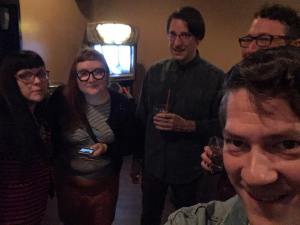
An underrated classic.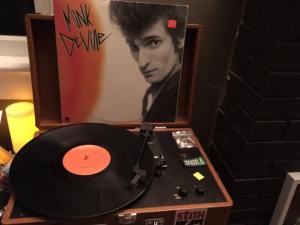
Wait… is Barcelona fake? I’m confused.

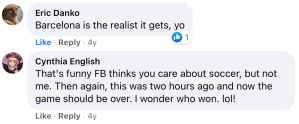
Are you ready for a Four Dimensional Nightmare, LIVE! Over 30 minutes of live electronic music on Mid-Valley Mutations, and plenty of other rare and unreleased music by this unusual Northwest Artist. Available for stream or download. Enjoy!
Four Dimensional Nightmare, LIVE! (#28)

 I first heard about NANOWRIMO in 2004, and in 2005 I decided that I was going to compete. While I didn’t do it every year, it wasn’t until 2015 that I actually completed the expressed goal of writing 50,000 words toward one story in 30 days. Let’s process that for a moment. 10 years. Usually, when I fail at something for 10 years, I just stop trying entirely. I guess that’s what Writing does to you; you become an addict, constantly looking for the next rush.
I first heard about NANOWRIMO in 2004, and in 2005 I decided that I was going to compete. While I didn’t do it every year, it wasn’t until 2015 that I actually completed the expressed goal of writing 50,000 words toward one story in 30 days. Let’s process that for a moment. 10 years. Usually, when I fail at something for 10 years, I just stop trying entirely. I guess that’s what Writing does to you; you become an addict, constantly looking for the next rush.
It is true that I have always loved writing personally, and that I usually opt to do that if I can. But NANOWRIMO is a bigger challenge than writing a ‘zine, and much more demanding than knocking out a short story on the weekends, when there’s not much else going on and there’s no deadline. For all of those wannabe writers who love to talk about the craft and how they are in love with the written word, there is something about having to produce that much material in that short a period of time, that really forces you to work close to the metal. There are no do-overs. On December 1st, you do a total word count, and hope that you got there with all that blubber you added at the last second.
In 2015, I had a number of factors working for me, and I started very strong with my novel, with the very-high expectation of writing 2000 words a day. This worked great at first, but between technical challenges, a computer crash, and majorly loosing steam half-way through, I missed several days, where I couldn’t write a single word. I caught up quickly, and when I limped across the finish line with a few days left to spare, I just quit completely, and didn’t write anything those last few days, in spite of trying. While I technically finished, I felt a little lame about the way I finished, especially since I did this publicly; not only were chunks of the book being serialized on this very blog, but I was allowing people to read the Google Doc where the story lived at any time, and published that link all over. (It might even still be available, buried somewhere in the avalanche of other stuff that’s online.) Anyway, there was something about the public nature of the project last year that really made me feel bad about the way it ended. I should have finished a little more gracefully, but so it goes.
I approached the process of writing a story like this very differently last year, too. In the past, I would start at word one on page one, and would try to build the story from there. It was sort of painstaking, as a friend of mine used to say, the “Ice Skating” approach to writing. (Get it right in the first pass, and that’s it.) If you don’t know what the next word is, well, you wait until you do. And you hope that inspiration will guide you. For my 2015 attempt, unlike all previous efforts at writing, I spent the first couple of days assembling a detailed outline. All of these outline words counted toward the total 50,000, and as the month progressed, I would highlight a couple of words from the outline, and flesh it out into the scene that was described.
On the whole, it worked, and it allowed me to do something that I’d never done before: write something out-of-sequence. Humorously enough, I almost never did. Usually, I would look at the outline and work on the next section. When I got stuck, I went back a couple of times to flesh out spots that seemed weak in hindsight. But I rarely went forward. I just had no idea how to do that.
For 2016, I more or less forgot that NANOWRIMO was coming, and really only decided to do it at the last minute. There are a number of personal factors that informed this, but when it looked like I had time on November 1st, and an idea occurred to me, I ran with it.
Like last time, I decided to start with an outline. Like last time, I set a goal of 2000 words a day. And like last year – and in previous years – I ran with a detective story, too.
But, when it came to the actual writing and day-to-day aspect of it, this year felt very different. There was a sort of confidence up front that I didn’t remember from last year. Having completed it before, it now seemed manageable. Like I’ve heard many people say about honing any skill, once they achieve something once, they know it is possible. Doing it again is just a formality. So even on days when I didn’t hit my goal, or even didn’t write anything, it never felt desperate. I’d already had the worst happen to me: complete computer crash in the middle of a novel. And in the end, we recovered. It wasn’t even mildly awful. If that’s the worst that can happen, then what did I have to fear this year?
Another first for me this time was that I wrote things well out of order. This was quite practical at first; sometimes, I just didn’t know how to flesh out a scene, and it made sense to write some bantering dialog. For a good part of the beginning, I wrote a ton of backstory, so I would have some reference material to inform the main plot. It wasn’t until I’d spent almost five or six days on the backstory that key plot points started to come together in my mind. Writing out of order also helped me realize that there were huge sections of my outline that were unnecessary when I reviewed everything, and now sections of the story have these weird dead-end sections that sort of go nowhere, because I realized that set-up was no longer necessary.
In fact, when I review the results of this year’s efforts, it is largely unreadable on December 1st, and this is very different from previous attempts. I will not be serializing this anytime soon, and I’m not sharing the link, either. But, there is a the seed of a story in there, somewhere. I could imagine, given a long enough timeline, that I could whip this into shape. But for now, the idea of returning to this monstrosity just seems inhumane. It is a huge, sprawling, messy and largely nonsensical detective yarn, and even by that standard, would be hard to enjoy, offers little closure, and is not a good example of what I can at my best.
To make matters worse, I actually got a writing gig in November of this year, which meant that I had to crank our three non-fiction stories during the bulk of NANOWRIMO. Not only did I have to put the brakes on my “novel” to do my newly-acquired job, but it sort of took over a lot of my brain-space, too. You don’t realize how many processes are working in the background to come up with words, that it is only when you need to split that time across two project that you realize how exhausting that process is. You are just wiped out. In this respect, and in this respect alone, I cheated; the work I had to write for this new job was added to the total word count for November writing. While I did come up with an in-story reason for this, and I don’t feel guilty in the slightest for doing it, I do feel like I need to mention this caveat. I absolutely wrote a ton in November. But not all of it was strictly for this novel. (But, you never know, considering one of the characters is a journalist / zine writer, it fits, right?)
Another difference this year was location; I wrote this novel in a number of places throughout the month. It’s sort of hard not to, what with the holidays and etc. But technology makes stuff like this so incredibly easy, and by using a Google Doc, I never lost a word, no matter where I was writing. However, this didn’t prevent me from experiencing writer’s block. When I was not in my two primary writing environments – the office or my home – it was so much more difficult to put my butt in the chair and start churning out words, that there were many days I wrote nothing. Never had the environmental factor become so apparent to me, and now I had evidence to back it up. I write better in my natural environments.
Because I missed a lot of days this year, even my 2000 words a day goal couldn’t cover for the days I wrote nothing. This led to something I had never done before, and turned out to the most exhausting thing I’ve ever done while writing: churning out 4000 words a day, or more, in order to catch up near the end. On no less than six occasions I wrote well over 2000 words, and three of those were in the 4000+ range. (One day was nearly 7000 words, even.) Those six days were… terrible. There’s just no way to sugar coat it. Not only did the words get worse as the day progressed, but those were tiring days. To my knowledge, I’ve never written that much in one day before, and to think that I did it this year still seems insane. I should know better. While I finished the projected goal by the end of the month, there were a few days where I felt physically exhausted, just from coming up with words.
On the whole, I had a great time this year, because I feel like I learned a lot of practical lessons about writing that, while perhaps obvious, are things I need to continue to keep in mind to continue this journey of becoming a writer. Never have I felt that there was so much to learn, and at the same time, never have I felt I have made such progress. While I’ve tried to condense this into a handful of tips to close out this reflection, I should preface this by saying that it has taken me 20 years of writing and 10 years of failing at NANOWRIMO to make these realizations about myself. While useful to me now, please don’t assume this is across-the-board advice that will work for everyone. Just a few observations about how I work when I’m writing.
Hopefully, this will help you find what works for you.
10 Writing Tips Learned From NANOWRIMO 2016
1.) It’s About Words; Nothing More. There is a time for making every sentence unique, making every simile perfect, and having continuity between the entire body of work. This is not that time. Just write. A lot. Let the words flow. Let your sentences be clunky. Let it all out. Much later, you can fix anything you don’t like. But for now, just get words down. Lots and lots of words.
2.) Set Very High Goals. To beat NANOWRIMO, you need to write at least 1667 words a day. Write 2000 a day. If you can, write even more. Over-shooting the goal early, when you’re just getting started and you’re excited, can save you when you have trouble later, and you need a cushion – for whatever reason. If you can write for a week straight hitting that higher goal, you’ll have plenty of wiggle room when Thanksgiving hits and you are too full to write.
3.) You Are Over-Thinking It. Usually, anyway. All of the best moments of my story are unplanned, and all the parts I want to save in future revisions are the things that I just threw in suddenly, without thinking about it. When I would agonize over something, it would get worse and worse, and the more I would work on it to get it “just right,” the more time I wasted not-writing, because I was “thinking.” You will have plenty of time to think about the story when it is done, and you can revise the hell out of it later. But right now, stop thinking. Start writing.
4.) Stop Being Precious. This is something we could all work on. In the end, this writing is not important. There is nothing special or unique about your ability to sit down and write for hours a day, except that it speaks to your privilege, in that you are able to do that. It isn’t true that you write better in one take, or when drunk, or whatever it is that you think makes you a better writer. What makes you a better writer is to write, a lot, and to take it as read that you will be revising it all in the future. What you write isn’t a perfect snowflake the first try. This is just a mess of words that could be something in the future, if you let it. But it can’t be anything if you aren’t able to just sit down and start writing. Stop making excuses. If you are a writer, then, by all means, write.
5.) Location, Location, Location. It has been said by people more well spoken than I, so I will merely repeat: it is worth it to spend some time creating an environment you want to write in BEFORE you have to start writing. My office and home are perfectly established places, where I can work and feel good about it. Unless you thrive in places that are unfamiliar to you, I suggest making sure you have a few places ready that are comfortable, inviting, and induce as much positive energy as you can muster. You will need it.
6.) Start Early, Work Late. If you can, start writing in the morning. Write as much as you can, and keep adding to that number as the day progresses. If you can, write as late into the day as you can. Every minute you are not writing are words that you can’t get back, so the sooner you start, the sooner you will get done.
7.) Track Your Numbers As You Go. Spend some time creating a document where you can track your progress, so you can see how much you have written, and how much more you have to go. I found that using a Spreadsheet offers the largest number of ways you can manipulate your data, and you can fine-tune it to give you exactly the kind of information you are looking for. Obviously you want the grand total, but I like being able to look at the work finished each day, and how much I have to write each remaining day to hit the goal. I recommend learning the key commands that offer your total word count, so you don’t have to use menus or look it up each time. Seeing your progress in real time can help motivate you to stay on top of your goals, and keep working when you are running out of steam.
8.) Learn To Accept Failure Early, And Often. There will be days when you just don’t write well. There will be days you don’t hit the goal. You might not even finish at the end of the month. Or, you might, but your story will be crap. Going into NANOWRIMO is ultimately an experience in coping with failure, because even if you finish, the story you have written will not be the breakthrough success that will make you a star. Most likely, you spent a lot of time on something that you will not be compensated for, in any way. That is fine. Like accepting criticism, or having to accept what you can’t do, writing is not always something you will succeed at, even if you are good. Learn to sit with that. Find a way to feel okay with it, and move on. You will need to if you want to hit 50,000.
9.) Take Breaks. It seems strange, but when you are in the zone, and you are writing well, the last thing you want to do is take a break. But after even an hour, writing can wear you out, and if you are hungry, or distracted, or tired, it will be harder and harder to write. Take as many breaks as you need, go for a walk, or whatever. You will find even a few minutes away will not only help you feel like you can write longer, but will often give you new ideas that don’t come to you while you are actively writing. Breaks are like the rest in a musical performance; learn to value them as much as the parts where you are writing at full steam.
10.) Get Ready For Post-Novel Depression. This sounds silly, but I absolutely get depressed when I finish a project. Nothing dramatic or even dangerous, but completing something is almost like giving birth. Afterward, you feel like you’ve lost something. And you have, in a way; a huge story has been created from words you put down. All of that is out of your head, and while it can be relieving to get things out, it can also make you feel a little empty, in a way. Fortunately, NANOWRIMO ends with the holiday season in full swing, and hopefully there’s enough going on to help give you some focus and purpose as you cope. (Or, conversely, this is the most depressing time of the year for you, and you might need some help staying upbeat as you enter it.) Either way, get ready for it. This is just a sign that you need to recharge your creative batteries, and do some non-writing things for a while. You’ve put in a lot of work in a short period of time. If you want to be able to do it again someday, you’ll need to give yourself the recovery necessary to get back to full strength. In the meantime, I suggest picking a new TV Show, letting yourself gain a few pounds, and re-doubling your efforts to spend time with friends (or, if you aren’t depressed by the holidays, with your family). Not only is it the right time of year for it, but you’ll find recovery is so much better with people you care about.
There is a long history of you and your friends piling into a car and driving well into the night in order to catch a show that is not coming to your home town. While the traveling performer is a very old trope in our world, it is only with the advent of national radio – where audiences could get to know artists before they ever made it to the town they play in – that listeners were in a position to know what a show might be like before they went. Of course, by then the lines of communication were open so you could promote shows like this, and suddenly, all the pieces were in place to develop a culture where not only space could prevent you from seeing something you want, provided you could get there in time.
A much more modern tradition revolves around the weekend after Thanksgiving. As people are visiting family and friends for that holiday, they are usually casting around for something to do on the days leading back to that Monday, when you return to work. Bars fill up and, if you’re lucky, a few bands will tune up in the corner to help pass the time. The folks at Turn! Turn! Turn! certainly had that in mind this year, and to that end, a select handful of us found ourselves huddled around a brand new stage as we took in one of these shows, bolstered by booze and food and a sense that, for whatever reason, this was what we wanted to be doing instead of standing around the kitchen as we cast around for the last few things we’ll be saying to each other before we go home tomorrow.
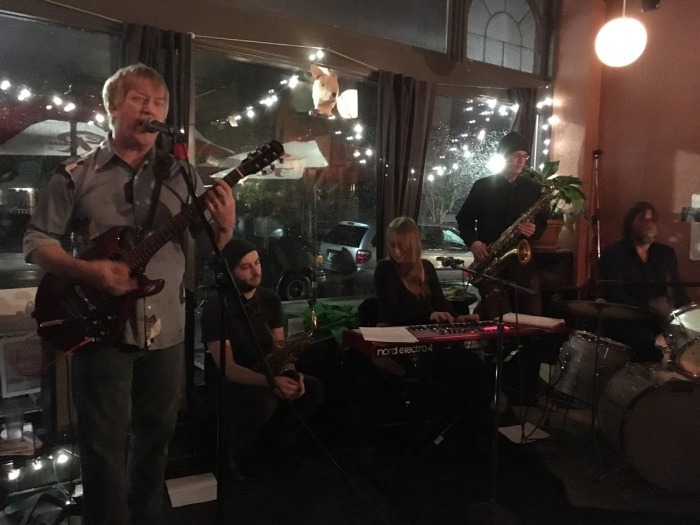 White Shark Shivers started the show, an ensemble born out of various Thinking Feller’s Union Local 282 projects, with a large horn section and two guitar players, delivering something that had some of the same spirit as that long lost band, while creating a much more specific tone and mood that is not only more appropriate for a gloomy, raining evening, but felt in line with the current national mood. While this seems to be an extension of Mark Davies’ 1994 solo project The White Shark – and the set certainly included some of those songs amid some covers and originals – this seemed like a new ensemble made up of old friends that is capable of so much more. If we can’t have the Feller’s back, White Shark Shivers is absolutely the next best thing.
White Shark Shivers started the show, an ensemble born out of various Thinking Feller’s Union Local 282 projects, with a large horn section and two guitar players, delivering something that had some of the same spirit as that long lost band, while creating a much more specific tone and mood that is not only more appropriate for a gloomy, raining evening, but felt in line with the current national mood. While this seems to be an extension of Mark Davies’ 1994 solo project The White Shark – and the set certainly included some of those songs amid some covers and originals – this seemed like a new ensemble made up of old friends that is capable of so much more. If we can’t have the Feller’s back, White Shark Shivers is absolutely the next best thing.
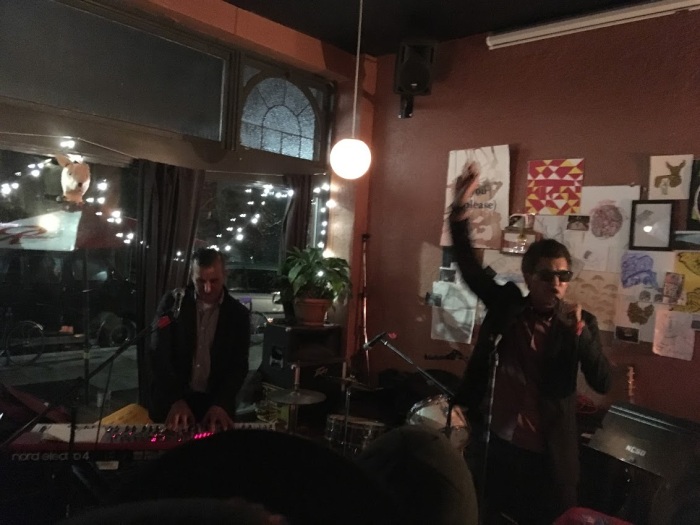 Compared to the crowd on stage for the first act, Porest’s two members was certainly an interesting juxtaposition, to say the least. Having not played in the US for almost 10 years, this was one of two shows that were happening on this continent, and when you listen to some of the songs Porest is known for, it actually makes sense. While mining some of the collage / experimental territory that Negativland loves to explore, Porest takes their political tone and runs wild with it, intermixing comedy and collage with deconstructive lyrics that might explain why Mark Gergis has been living outside of the country in recent years. “Soapbox Cutter” is a scathing indictment of US policy and politics, delivered from his “karaoke soapbox” that so conveniently is the form of his stage show, “Diplomat Smile” continues to explore these themes, in a way that pre-saged the recent election, and yet seems to be commenting upon it, too. “Keep fighting the fight,” seems even more ironic, and yet hopeful, when delivered to a crowd of dancing, happy fans. Mix this with some on-stage destruction, comedy, and slick dance moves that accompany a song against smoking, and it was most certainly worth it to catch this rare artist in his natural environment.
Compared to the crowd on stage for the first act, Porest’s two members was certainly an interesting juxtaposition, to say the least. Having not played in the US for almost 10 years, this was one of two shows that were happening on this continent, and when you listen to some of the songs Porest is known for, it actually makes sense. While mining some of the collage / experimental territory that Negativland loves to explore, Porest takes their political tone and runs wild with it, intermixing comedy and collage with deconstructive lyrics that might explain why Mark Gergis has been living outside of the country in recent years. “Soapbox Cutter” is a scathing indictment of US policy and politics, delivered from his “karaoke soapbox” that so conveniently is the form of his stage show, “Diplomat Smile” continues to explore these themes, in a way that pre-saged the recent election, and yet seems to be commenting upon it, too. “Keep fighting the fight,” seems even more ironic, and yet hopeful, when delivered to a crowd of dancing, happy fans. Mix this with some on-stage destruction, comedy, and slick dance moves that accompany a song against smoking, and it was most certainly worth it to catch this rare artist in his natural environment.
 To close the show, Sir Richard Bishop of The Sun City Girls took the stage, and amid protests that we’d already seen the best, and that he was far too wasted to play well, he continued to deliver acoustic originals and covers that felt celebratory in a way we all desperately needed. While his improvisational sonic explorations are always contemplative, he wasn’t beneath throwing in a few jokey covers like “Fly By Night” and an incredibly earnest version of “If I Only Had A Brain.” We swayed, we rocked, we laughed and we cajoled, but it was mostly because we didn’t want it to end. We still had an hour drive home ahead of us, and the liquor soaked joy and pot-tinged celebrations seemed to be just starting as Richard insisted that we had already gotten our money’s worth.
To close the show, Sir Richard Bishop of The Sun City Girls took the stage, and amid protests that we’d already seen the best, and that he was far too wasted to play well, he continued to deliver acoustic originals and covers that felt celebratory in a way we all desperately needed. While his improvisational sonic explorations are always contemplative, he wasn’t beneath throwing in a few jokey covers like “Fly By Night” and an incredibly earnest version of “If I Only Had A Brain.” We swayed, we rocked, we laughed and we cajoled, but it was mostly because we didn’t want it to end. We still had an hour drive home ahead of us, and the liquor soaked joy and pot-tinged celebrations seemed to be just starting as Richard insisted that we had already gotten our money’s worth.
But as we blasted back down I-5 to return home, it seemed the perfect endcap to an incredible evening. If seeing them, as Richard insisted, was about getting our money’s worth, then he’s being incredibly disingenuous. Porest didn’t come to this country just to play for a small crowd in Portland for the money, and it seems odd that Mark Davies would assemble a group like his because there was certainly money in it. Rather, this was another one of his jokes. When it comes to shows like this, none of us are getting together in a small club because it is “worth it.” Rather, we’re coming for the comradery, we’re coming to get away from our families for a few minutes and enjoy ourselves. We’re looking for something else in the night, in the rain, in the darkness, in this November at the end of a year that has beaten us down, insulted us, degraded us, and made us feel like there is no hope.
We’re looking, for a few hours, for some music. And, fortunately, we found it.
A new publication, with a new story.
And a pseudo-sequel to our previous endeavor.
Film & music reviews.
A chapter from the latest Dexter Roland yarn.
Photography by Austin Rich.
All in monochromatic glory, available physically, or digitally.
Our first run of both digital and print editions come with our previous effort, free.
Free, or you can make a donation in the amount of your choice to austinrich@gmail.com, via PayPal.
Dot Too. Something New.
First treaters: 6:13.
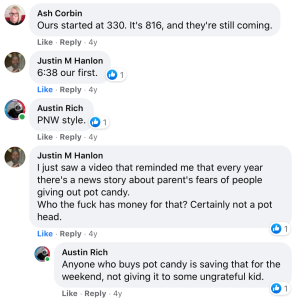




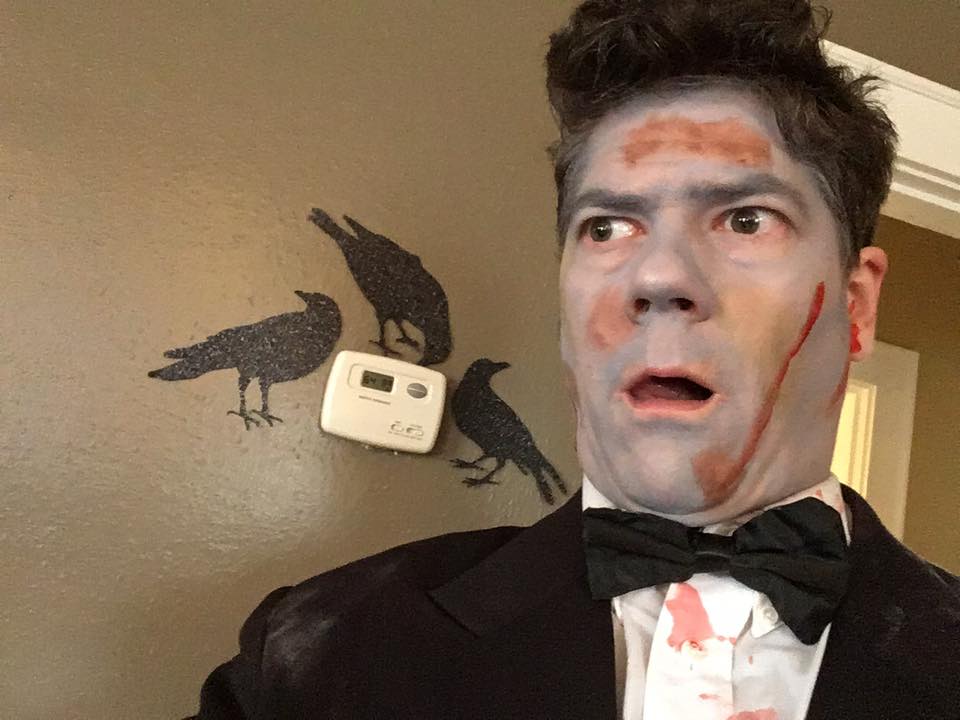
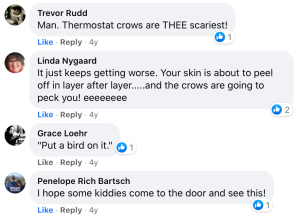
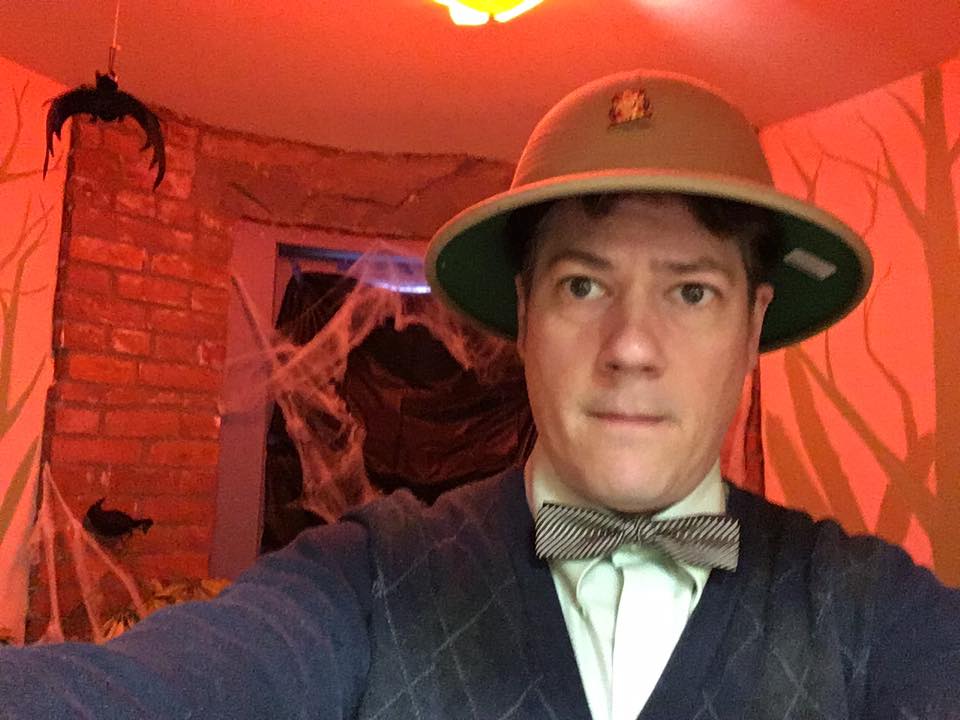


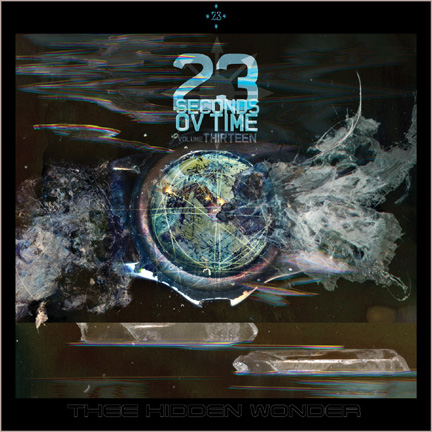 I am thrilled and honored to have a piece I made be included on this incredible compilation, 23 Seconds ov Time – Volume 13.
I am thrilled and honored to have a piece I made be included on this incredible compilation, 23 Seconds ov Time – Volume 13.
I appear on the 16th track, and my piece is called “Rocket Summer.” Mid-Valley Mutations fans may recognize the sample from The Martian Chronicles episode, but repurposed differently for this song.
There’s some choice experimental artists among the 53 who contributed to this collection, including friend of the show Uneasy Chairs, who kicks off this comp, and Blue Sabbath Black Cheer, who are incredible. I’m very pleased that they used my submission and I’m very proud to be included with so many other great artists.
The album is free, and if you like experimental music, this is a must have.
And there are 12 other volumes available, too. Collect them all.
 We have been doing our best to provide as much quality entertainment as possible on the shoe-string budget that is best suited to these modern times, and with that in mind, we have completely updated our Bandcamp.com Store with new and exciting releases that are of interest to you.
We have been doing our best to provide as much quality entertainment as possible on the shoe-string budget that is best suited to these modern times, and with that in mind, we have completely updated our Bandcamp.com Store with new and exciting releases that are of interest to you.
In the period before I began at KMUZ, I was doing a show on an Internet station, Wanting To Be Cool In Beautiful Anywhere, Anywhen. While they became a very comforting home to me and my work when I was not on broadcast radio, in the time since they have become dedicated to documenting the work we’re doing, and capturing some of the performances that happen on our program.
To that end, there are now downloadable versions of the live performances and interviews we have had on Mid-Valley Mutations, where you can enjoy bespoke digital albums of each act, without the clutter of the rest of the broadcast that you have come to know and love. The albums contain full performances by the artist we’ve had on the show, and in a few cases, material you haven’t yet heard!
The collaboration between myself and devilsclub entitled “Beware of Tomorrow!”
Two complete live sets by Guyve, including a lot of material that could not fit into the hour long show!
The Digital FM Split Tape! (Featuring live performances by Entresol & Entrail, including 15 minutes of music between the two of them that did not air during the boradcast!)
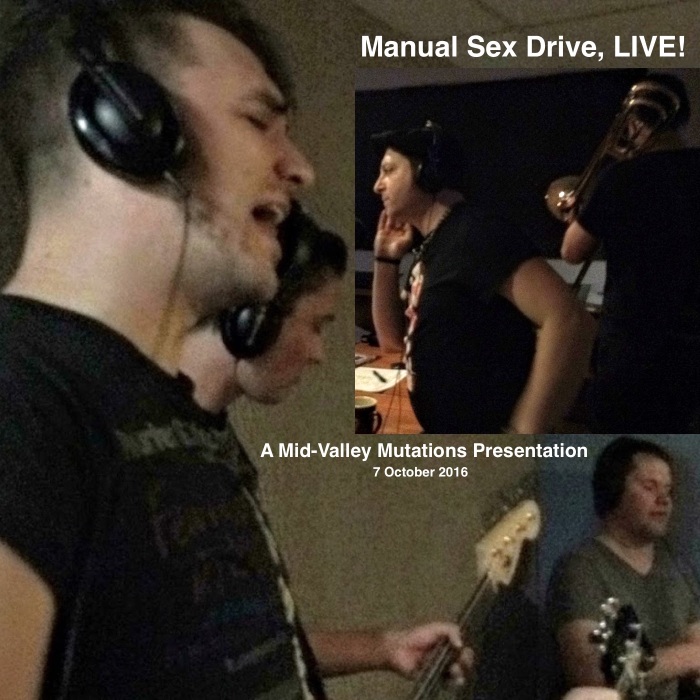 A nearly 51 minute performance by Portland Improvisational Mavericks, Fiasco!
A nearly 51 minute performance by Portland Improvisational Mavericks, Fiasco!
And a manic, Pledge Drive Performance by Manual Sex Drive.
All of these albums are free to enjoy and download, for the time being. This is your chance to pick up a ton of excellent recordings that are unique to Mid-Valley Mutations. However, if you are so inclined, please make a donation for all of this excellent entertainment. Any purchases you do make will go to supporting KMUZ, and keeping that station on the air.
In addition to these, you can also pick up Interviews, which contains 13 different interviews with artists who have been on the program. These are extended conversations with musicians about the work of creativity and music in the 21st Century, and offer a chance to get to know the people we play on the program. You will not hear these conversations anywhere else, and it’s just another way we like to give back to the listeners at home.
There are also a number of other audio treasures over there, so poke around and see if you find something you like. We hope that you won’t be sorry.




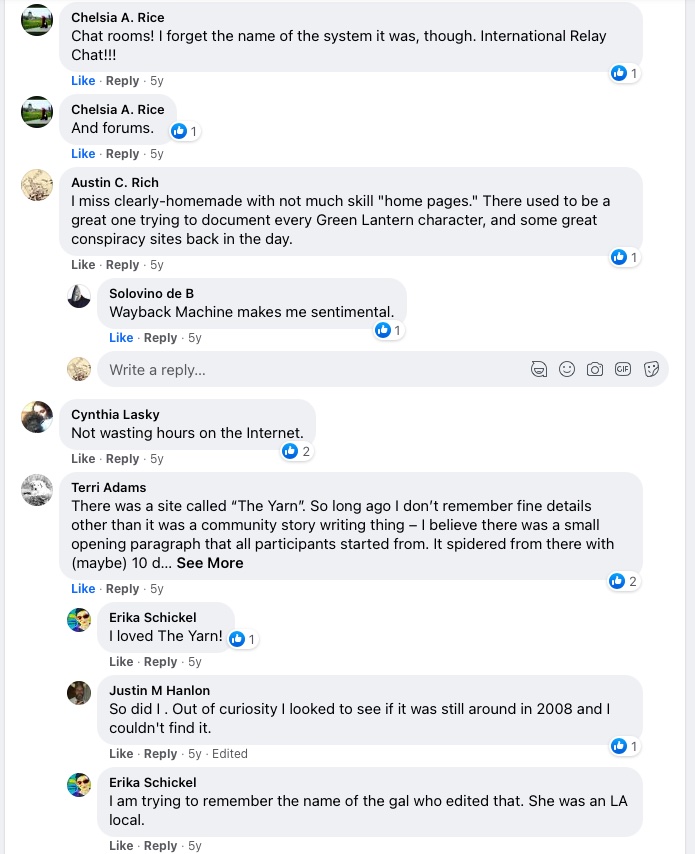

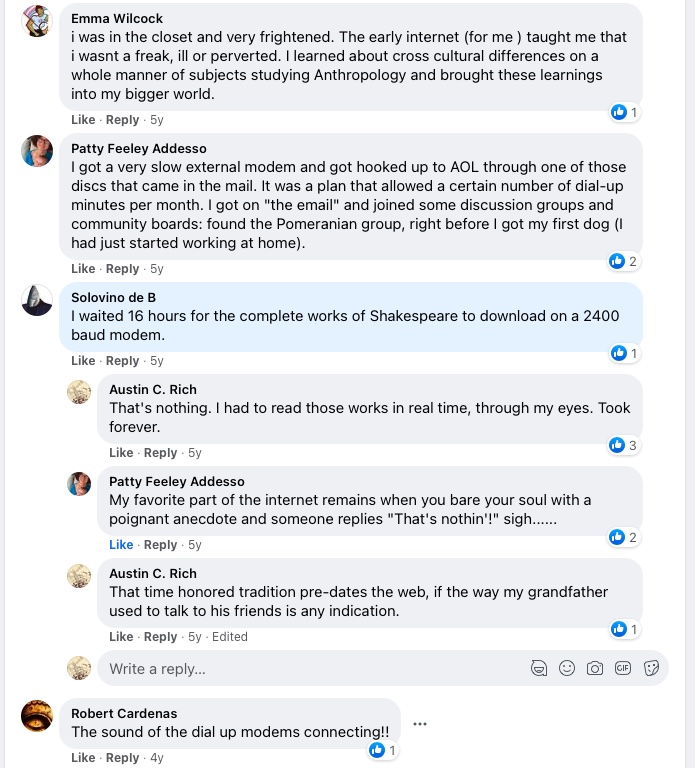
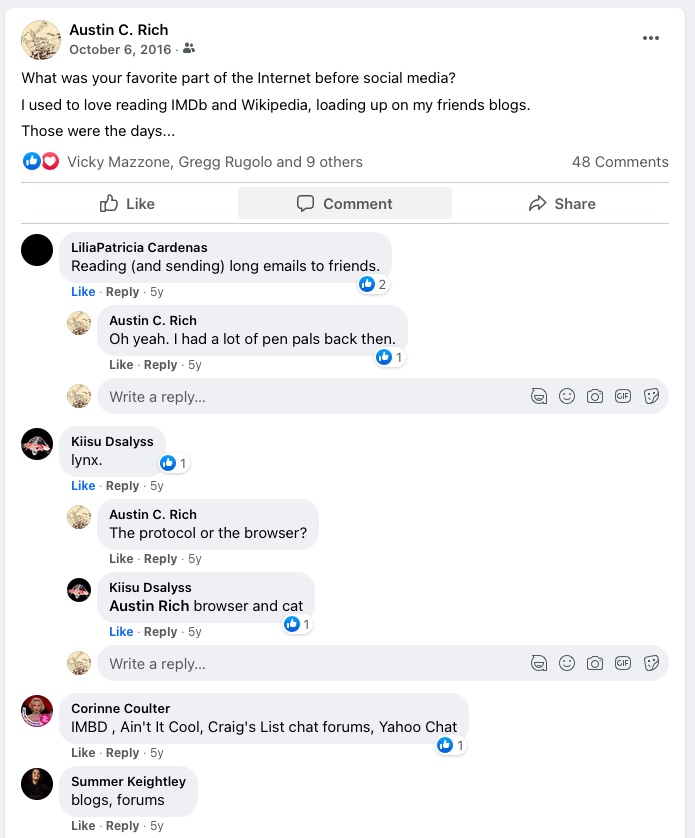


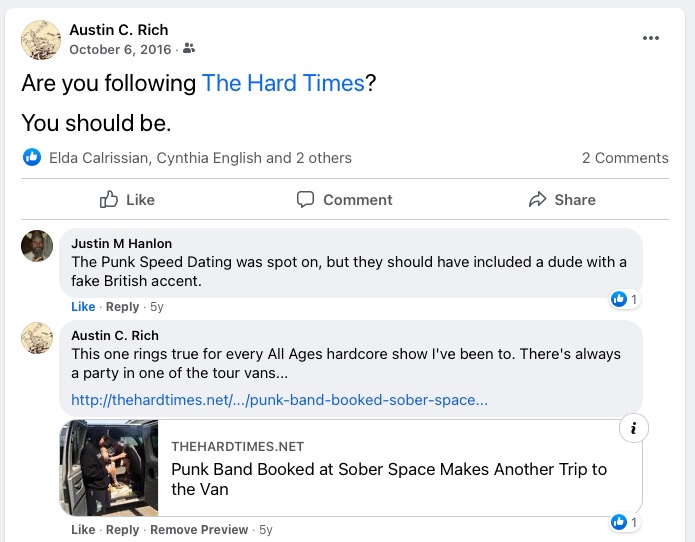
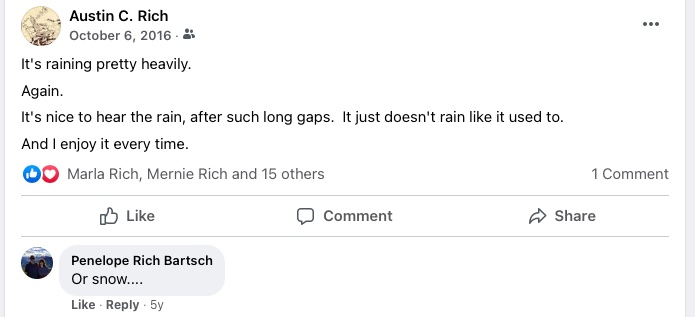
 While not the production it was last year, I wanted to quickly mention that we are celebrating Halloween the old fashioned way, and yes, that involves your podcast feed.
While not the production it was last year, I wanted to quickly mention that we are celebrating Halloween the old fashioned way, and yes, that involves your podcast feed.
Mid-Valley Mutations is offering bonus episodes on Mondays and Wednesdays of October, for a total of 13 Holiday podcasts. Four of these shows will air on KMUZ, as the shows do normally. (10 PM, Friday nights.) But there are nine gems, hand picked from our 13 years of producing Halloween Radio. This is a chance to hear the many permutations our program has perpetrated, and gives you ample bonus material for that impending holiday party.
You can find all of our holiday entertainment using this handy link: midvalleymutations.com/category/halloween-spook-tacular
Or by enjoying the podcast feed, available in all your local podcatchers of choice.
Happy Holidays, from us, and Mid-Valley Mutations.
Be Seeing You.
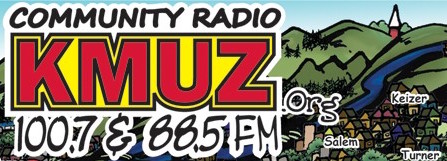 #thankful4KMUZ: Here’s How You Can Show It
#thankful4KMUZ: Here’s How You Can Show It
KMUZ, like many radio stations depends on listener contributions to continue generate excellent programming. When you make a donation to our station, you are showing how #thankful4KMUZ you actually are, by contributing to a cause that is now been on the air for five years. You can make a donation by going to kmuz.org and following the PayPal links, or by calling 503-990-6601 starting tomorrow – October 1st – and pledging your support to our station – all the way to October 7th.
As part of our usual Pledge Drive, anyone who donates $50 will receive a black KMUZ Mug. Drink coffee in style, and show your support for your favorite community radio station.
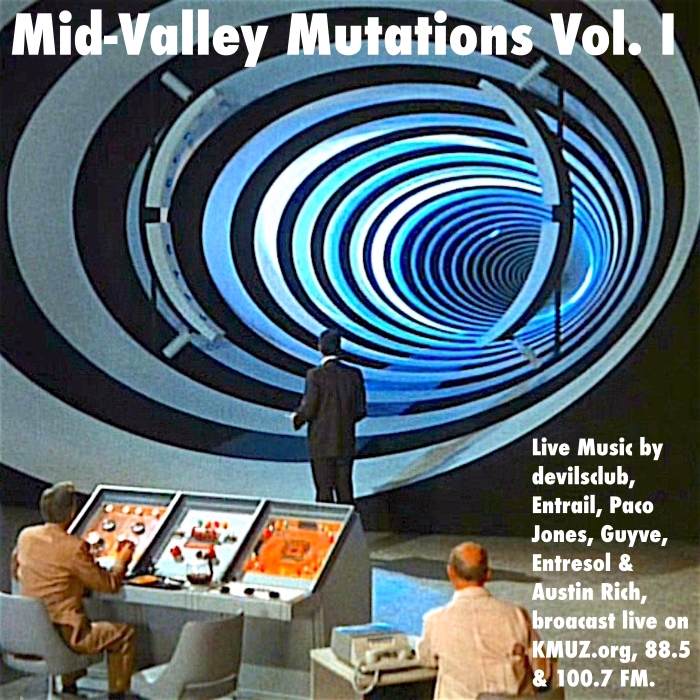 For listeners of Mid-Valley Mutations, we like to sweeten the deal. For anyone who makes a donation of any amount to KMUZ, we will give them a digital copy of our new album, Mid-Valley Mutations Vol. 1. This is a collection of some of the live moments from our program since May of this year. This includes live performances by Paco Jones, devils/club, Guyve, Entresol, Entrail & Fiasco, a fine gathering of artists that have all contributed to this program. And all you have to do is make any kind of donation you KMUZ you can afford. I will e-mail you your digital album as a thank you gift for listening to the show.
For listeners of Mid-Valley Mutations, we like to sweeten the deal. For anyone who makes a donation of any amount to KMUZ, we will give them a digital copy of our new album, Mid-Valley Mutations Vol. 1. This is a collection of some of the live moments from our program since May of this year. This includes live performances by Paco Jones, devils/club, Guyve, Entresol, Entrail & Fiasco, a fine gathering of artists that have all contributed to this program. And all you have to do is make any kind of donation you KMUZ you can afford. I will e-mail you your digital album as a thank you gift for listening to the show.
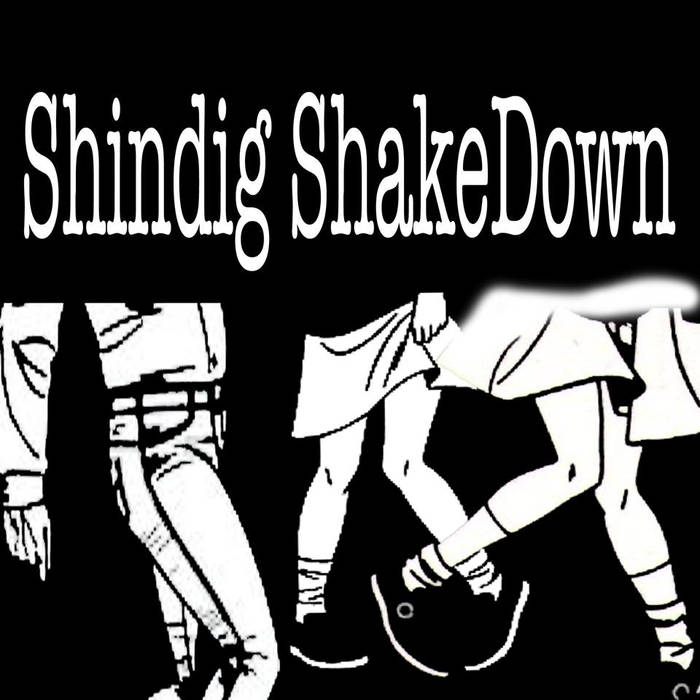 For contributions of $25 or more, you will get to choose from one of three gifts, curtesy of Personal Archives, No Part Of It & WTBC: Wanting To Be Cool In Beautiful Anywhere, Anywhen, including albums by Thollem, Bob Bucko Jr., Sex Funeral, Illusion of Safety, Arvo Zylo / Dental Work and physical copies of The Shindig Shakedown, a gift that was largely available at Austin’s 40th Birthday Party.
For contributions of $25 or more, you will get to choose from one of three gifts, curtesy of Personal Archives, No Part Of It & WTBC: Wanting To Be Cool In Beautiful Anywhere, Anywhen, including albums by Thollem, Bob Bucko Jr., Sex Funeral, Illusion of Safety, Arvo Zylo / Dental Work and physical copies of The Shindig Shakedown, a gift that was largely available at Austin’s 40th Birthday Party.
For a contribution of $35 or more, you will get a vinyl copy of the Blood Rhythms Assembly LP, with a hand-made cover. There is a limited number of this LP, so please make your contribution soon.
I could go on and on about how important these Pledge Drives are, so let me just say a few more words. Without listener donations, KMUZ may have trouble paying the rent in the future. We would not only loose all the great shows, but the physical space we use to make all of this happen. This is why we need your money. Radio is loose ground every day, and for us to have made it five years is quite impressive. But to make it much longer, we’ll need money, and we’ll need your support.
If everyone who listens to my program were to contribute even $5, that would be enough to keep Mid-Valley Mutations and KMUZ on the air. Let’s hope that we can raise that much – and more. Make your donation now, and mention that you would like to support Mid-Valley Mutations (and which perk you are interested in). Let’s make radio in the mid-valley powerful again.
Thunder.
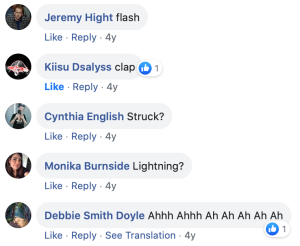
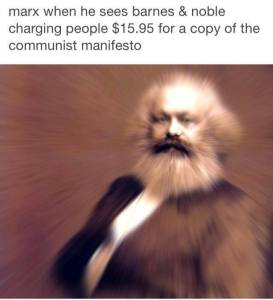
Happy happy, Joe Telafici.

If I told you what my emotional state was would you hold it against me?
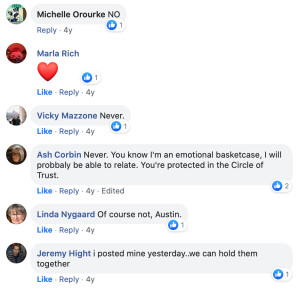
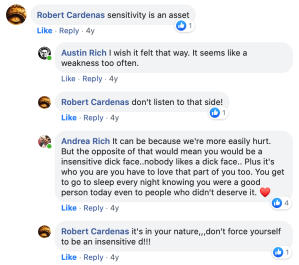

Three fictional characters?
I am fictional, to the core.
That’s like asking anything. Don’t you already expect an answer?
For your entertainment: a selections of videos that I shot while I was in Eugene, OR last weekend, from three different groups playing over two days. Six videos, from Jason’s Campfire Punk, The Nervous & /root_DIR.
Enjoy
 There is no amount of technology or improvement in our culture or way of life that can erase how helpless and meaningless everything seems when we get sick. There are moments, when we are awake at two AM, delirious, confused, feeling gross and insane, and your mind travels down a repetitive loop of nonsense that is both impossible to focus on and your entire reality – moments like that, where you suddenly remember how debilitating even the smallest illnesses can be, and how when someone says they aren’t feeling well, what, exactly, that can mean.
There is no amount of technology or improvement in our culture or way of life that can erase how helpless and meaningless everything seems when we get sick. There are moments, when we are awake at two AM, delirious, confused, feeling gross and insane, and your mind travels down a repetitive loop of nonsense that is both impossible to focus on and your entire reality – moments like that, where you suddenly remember how debilitating even the smallest illnesses can be, and how when someone says they aren’t feeling well, what, exactly, that can mean.
I felt it coming on Saturday morning, and while I wasn’t exactly sure at first, by the time we had decided what we wanted to do that day and were out in the world doing it, I was sure that the rest of my day would be awful. We finished our errands, got home, and I went to bed, and have failed to get sleep ever since. I’m sure I have dozed off for an hour or so, but nothing truly restful, or substantive. I’ve spent a fair amount of time in the bathroom – and I will not give any detail as to why – and while I am often hungry, everything I put in my body does not seem to enjoy the experience. But, if I had to say anything is really the worst part of all of this, it is not being able to sleep.
I am so bad at taking care of myself anyway that it is not at all surprising when I do get sick, but the fact I don’t spend more time sick is either a testament to the human body, or my own genetic mutation thereof. But as I get older I have started to realize that all my terrible habits and non-considerations of things that are fairly worrisome should probably be reversed if I don’t want to experience an untimely departure. Our days are numbered as it is, and it would be embarrassing if there were something I could do to keep that end day at bay, and I did nothing.
Of course I don’t think about these kinds of things except when I am sick, or not feeling well, or some other aspect of health comes knocking on my door. Our minds are incredible tools, and allow us the ability to enjoy amazing leisure activities. But it is terrible at reinforcing good habits, or breaking bad ones and forming new ones, too. This largely has to do with how easy it is to find (and enjoy) things that are fun, and in doing so, ignore all things that we don’t think of that way. You’ve probably heard this elsewhere, but the key is to “gamify” your own health in a way you enjoy.
But, of course, doing that is fairly difficult, too. We are creatures of habit, and if you have any bad ones in particular, then you know how tough it is to change. I smoked for years and years, so much so that I had to quit several times before I was able to fully give up cigarettes. (And even that still hasn’t caused me to fully give up wanting to smoke.) I took me a long time to give up drinking every day, and as I give up one bad habit, I see a huge foundation of others beneath me that I still need to give up, too. How much self improvement is safe to undertake at any one time?
It is weird when you have to start guessing about what will and will not be good for you as you try to heal yourself. Will this stay down if I eat it? How far away from a toilet should I lie down? Should I just take some aspirin, or a sleep aid, or should I just let nature run its ugly course? And, is it okay to have just one cigarette, or glass of wine, too?
I think I’m on the other side of this particular illness, but the thing that was driving me crazy this time – and it is a concern I have struggled with my whole life – is not being able to sleep. Since High School I have struggled with this, and while for many years I could blame staying up late and ingesting too much coffee / cigarettes / drugs / whatever as the primary culprit, even at this advanced middle age, where many of these things have been given up, I still suffer from not sleeping well. Of course, this is largely because I’ve come to find that there is a bottomless well of sleep hygiene tactics that I should be employing if I really want to get to the bottom of all of this. There is only room for improvement, but you will never get there entirely.
It won’t be long before this is in my rear view mirror. My wife will be well again, and we’ll be back to our routine, and even the clean-up will be done. It won’t take much, even. By Friday the house will be clean, and we can joke about the gross parts, and make fun of those around us who are still suffering, the way family does when they genuinely love you, but want you to be in as much pain as they were, just so you understand what they went through, too.
Of course now that I can see the light at the end of the tunnel, part of me wonders if getting sick and being reminded of our frailties is all part of the plan. Perhaps we benefit from knowing we’re very close to being almost entirely incapacitated by a small germ, or some dishes we didn’t clean. What kind of lesson does this weakness teach us? Can we gain any kind of insight into ourselves, or our life, or the lives of those around us from the few moments we spend, hunched over a toilet, willing to say almost anything if it means we will feel better?
 Do we ever really know ourselves? Is it possible that we will surprise ourselves, up to the very end, only to have our expiring notion be something along the lines of, “I never imagined.”
Do we ever really know ourselves? Is it possible that we will surprise ourselves, up to the very end, only to have our expiring notion be something along the lines of, “I never imagined.”
Because you can’t. You won’t. You shouldn’t. To really consider the variable I’s that you inhabit throughout your years is just too much to handle at any one moment. We coalesce around a version of who we are saying we are, and project backwards and forwards in an effort to create continuity, and we are lucky to have this tool – language – that comes built in with narrativity, all used as a means of describing ourselves. So much is stacked against us that we have to consider the self with a three-act narrative arc.
But the thing that is not discussed – this notion of identity, or being and self – are not described by a narrative arc. More appropriately, there is a stuttering, stammering quality to the way identity is truly expressed. Every moment we are reforming who I is, and who I will be in the next iteration, each time drawing on the versioned elements of our personas that stretch forward and backward in time. There are so many things about ourselves that are difficult and complex to keep in our own consciousnesses, that in many ways it is easier to grab onto cliches and uniforms to help create visual and mental shortcuts.
I look at the me of today, and I wonder if I would be recognizable to any other me that I’ve identified with. I don’t know what I thought my future would be like, and it is not something that I necessarily spent a lot of time concerning myself about when I was younger. The work I wanted to do was more clearly defined, but the “me” that I thought about when the future occurred to me was once so ill-defined that in many ways I didn’t exist. There was always a name attached to a novel, but who that name was supposed to represent was never clear to me. I can only imagine what this ghostlike perception of self has led to as time has marched on.
I haven’t turned into a horrible person, or at least, I don’t think I have. I can be difficult and neurotic and hard on myself, but I don’t think I’m particularly awful. But I can see the compromises that this me doesn’t feel bad about, but I may have once taken issue with. At 19, there are certainly things I never imagined I would ever do, in spite of not having a vivid impression of this future life I might live. The problem with tomorrow is that it comes so quickly that you often don’t realize that you are there, and have even moved on to the thing after that, and that, and that, and that.
Firmly in middle age, it isn’t that hard to find where things went wrong. It is the natural state of the middle aged man to find fault with everything – himself especially – and I can very easily look at the man I have been and lay out a dissertation on the missteps and failed calculations. But this blurring of identity – this realization that we have dynamic mes that shift and chance from day to day – suggests that this person I remember is someone else completely.
A past me. A me that cared deeply about keeping everything, a me that smoked cigarettes with a passion. A me that worked for six years in a bookstore, who considered the hobby of “musician” to be an occupation at one point, in spite of the fact that it was anything but. This person loved punk rock and chasing women and thinking deep thoughts and being self-righteous about half-formed bullshit.
An uneducated me. An awkward me. A scared and lonely me.
It isn’t that I have become someone I would hate. Rather, it is that I wish I could be friends with who I once was, because he seems like someone I could relate to.
The path I’ve chosen is fine. There are no great opportunities that I was offered that I virulently turned down. If anything there were things I pursued that I soon realized I was never suited for, and I was better off, in the end, never becoming the person I briefly imagined I might have been.
The problem I have now is that I want so badly to find out who the person I am, now, actually is. I can only look in the mirror so many times before the image looks foreign again. We are, if anything, defined by what we do, and waiting for inspiration and pacing back and forth is not exactly something I want to be known for.
Nostalgia is powerful, and the me I once was has an allure and a charm that I am often very attracted to. Who doesn’t want to believe that something you can’t have again was secretly better than anything you can have now? At least that way, you never have to worry about happiness again.
But, just suppose, we had to be happy now. Is is possible? Could we find something in the present that isn’t backward or forward looking, but is content with the me of the present? And, does my own future now look so ill-defined, so amorphous and dim?
More importantly, how will I reflect on this, years from now, when the person I’ve become looks back, and wonders, “What the fuck is this guys thinking?”
Or, perhaps, all of this is another mental exercise, a way of framing identity in an altogether different way, so I can continue to avoid addressing the underlying issue that is at the heart of all of this, the question that really wakes me up in the middle of the night, that sends me to the keyboard so I can hammer out something else, this urge that makes me anxious and confused most of the time:
Why is it so hard to be happy?
 I am reminded of a comment made about (or, possibly, by?) Sarah Vowel, on the subject of They Might Be Giants, and how they had such a vast back catalog that there was a song for every occasion, that could be used in any episode of This American Life. I’m sure, at this point, I’ve mangled the memory so badly that I’m quite a ways off my mark, but suffice it to say I often feel that there is a similar relationship to holidays and my own radio output. Over what has almost been 20 years I’ve been on the radio a lot, and sooner or later, I will come across a situation where we have an appropriate show for this time of year. And, for Valentine’s Day, this is no exception.
I am reminded of a comment made about (or, possibly, by?) Sarah Vowel, on the subject of They Might Be Giants, and how they had such a vast back catalog that there was a song for every occasion, that could be used in any episode of This American Life. I’m sure, at this point, I’ve mangled the memory so badly that I’m quite a ways off my mark, but suffice it to say I often feel that there is a similar relationship to holidays and my own radio output. Over what has almost been 20 years I’ve been on the radio a lot, and sooner or later, I will come across a situation where we have an appropriate show for this time of year. And, for Valentine’s Day, this is no exception.
If you subscribe to our VD Feed – you’ll have to manually paste this one into your podcatcher of choice – you can check out a slew of old Valentine’s Days shows, going back to 2006. This includes a handful of What’s This Called? episodes, and all of the old Blasphuphmus Radio holiday jams, too. This will give you a chance to listen back to all the romantic radio you can fill your device with, and woo the radio nerd of your choosing.
In these fast paced times, you might be asking for a recommendation, on the off chance that you only have time for a small slice of the many offerings available. If that is the case, then I would recommend that you pick either one of the two shows I have selected below, depending on your interests:
1.) The Future of Love. In this Sci-Fi audio essay, I explore the story of Lulu, a spaceship that has some designs on one of the occupants of its very own hull. This is largely built around an episode of the X-Minus One radio program from the 1950s, and some other experimental / jazz music that speaks to the theme of the show.
2.) Isosceles Diego’s Valentine’s Day Special. In this episode from 2007, my old roommate Isosceles Diego – who first guested on the show in 1998 – drops by the show to deliver his favorite songs from around the world to help put us int he holiday spirit. There is a lot of really great music by artists that you’ve probably never heard before – save for the brief excursion into ’90’s Olympia Indie Rock – and a ton of Eastern Block Rock.
There’s other great shows mixed in with those links, and I do suggest that you check them out. While I never really enjoyed Valentine’s Day the way other’s have, I did some pretty decent radio here and there, and that is something of which I am proud. Hopefully you can dig it, too.
Enjoy!
Cartoons
 Most likely this interest stems from the well known (and well loved) Chuck Jones cartoon, Duck Amuck, where it becomes very clear as the cartoon progresses (spoilers for people who haven’t seen a cartoon from 1953) that Daffy is being tortured by the artist illustrating his cartoon. The antagonistic relationship continues until the very end, where it is finally revealed that the cartoonist is none other than… (spoilers for the spoilers)… Bugs Bunny himself. (An almost Lost-ian ending, if I ever saw one.)
Most likely this interest stems from the well known (and well loved) Chuck Jones cartoon, Duck Amuck, where it becomes very clear as the cartoon progresses (spoilers for people who haven’t seen a cartoon from 1953) that Daffy is being tortured by the artist illustrating his cartoon. The antagonistic relationship continues until the very end, where it is finally revealed that the cartoonist is none other than… (spoilers for the spoilers)… Bugs Bunny himself. (An almost Lost-ian ending, if I ever saw one.)
This cartoon was so unlike anything else I had seen as a child that I couldn’t believe it, and I tried to imagine some huge force outside of me that was dictating the world in which I lived, changing it on me randomly. (As a child raised by what you could ostensibly call atheist parents, I had no idea that most people were living in a world where this was true for them.) And while Chuck Jones might have introduced me to this world, when I sat down to study the animated oeuvre every Saturday, I started to realize that there were other guys who tackled similar subjects, but in other ways.
 Bob Clampett‘s Porky In Wackyland is a tour de force of animated spectacle, with plenty of moments where the characters are just crazy enough to address the audience (a schtick he would deploy as needed in many of his cartoons). Tex Avery was also very good at throwing in gags that revealed the cartoon was being played in a theater where characters from the audience would stand up to offer advice or help. Avery loved to break other aspects of the fourth wall whenever he could, and used these gags as much as any other. As an avid cartoon fan, there were no other shows that did anything like this, and part of the genius of the Warner Bros. animated world was that, unlike Disney or other production companies, there was a manic insanity that was shared by the creators and the audience that you did not get from, say, a Pluto cartoon. (As cute and inoffensive as they might have been.)
Bob Clampett‘s Porky In Wackyland is a tour de force of animated spectacle, with plenty of moments where the characters are just crazy enough to address the audience (a schtick he would deploy as needed in many of his cartoons). Tex Avery was also very good at throwing in gags that revealed the cartoon was being played in a theater where characters from the audience would stand up to offer advice or help. Avery loved to break other aspects of the fourth wall whenever he could, and used these gags as much as any other. As an avid cartoon fan, there were no other shows that did anything like this, and part of the genius of the Warner Bros. animated world was that, unlike Disney or other production companies, there was a manic insanity that was shared by the creators and the audience that you did not get from, say, a Pluto cartoon. (As cute and inoffensive as they might have been.)
Over the years I have come to realize that the golden era of Looney Tunes & Merrie Melodies were head and shoulder’s above the competition, and Happy Harmonies, Color Rhapsodies and even Disney’s own Silly Symphony’s could compete with the overall form of the Warner Bros. work. The insanity and the brilliance of their shorts so completely synthesized “cartoon” as a visual format, and their sense of satire and caricature was leaps and bounds above the others. And I largely point to their sense of metatext – of being able to jarringly draw attention to the artifice of the work at hand – that made them far superior. They made jokes with tongue planted and cemented into cheek, and they felt that their own medium not only set them apart, but could be exploited to take audiences into places that other animation studios just couldn’t be bothered to visit.
Comics
It isn’t that I believed a child of the ’80’s could have been the first person to consider the meta-textual qualities of the media around him, and certainly I would have been a fool to consider that this kind of interplay didn’t exist in other mediums, either. But I was shocked when I would mention that it was these moments that I longed for, it was the instant Yosemite Sam turned to me and made a comment that took us both out of the story for a second, that I thought were the funniest moments. I didn’t have a name for it then, and most of my friends and family seemed to thing those scenes were usually boring. (This is like when you meet people who don’t like Holodeck episodes of Star Trek: TNG, or who found the mythology episodes of X-Files to be boring.)
The underlying idea that the artist and the audience could wink at each other and share a joke or a moment between only the two of them was very clearly a powerful tool, considering how much it affected me as a kid. Seeing the edges and peering through the reality that seeped through was always my favorite part of anything I saw around me, and it began to be the way in which I would look at TV and film, too. But I also noticed how it did not seem to have the same kind of effect of other. When most people were confronted with a meta-joke, they frown and shake their head. It just isn’t for them, no matter how funny the joke might be.
 When I discovered comics as a teen, I was immediately attracted to the “funnier” and more comedy-inflected writing styles that was big business in the late ’80’s. DC was having a field day with style, largely influenced by Keith Giffen and his series, Ambush Bug. A lead character that is aware he is in the DC Universe, and plays with dead (or forgotten) bits of continuity that blew my mind as a 13 years old kid, (who, at the time, hadn’t been lucky enough to find Steve Gerber‘s work yet, who Giffen seems influenced by). Again, I seemed to be in the minority, but I would scan the racks at comics stores, looking for something that scratched that itch at a time when most comics had gotten very dark and “serious.” This led me to finding Giffen’s run on Justice League, which is not only one of the funniest comics produced in the late ’80’s / early ’90’s, but to this day stands as a source for much of my sense of humor, if not references and jokes that no one else around me seems to get.
When I discovered comics as a teen, I was immediately attracted to the “funnier” and more comedy-inflected writing styles that was big business in the late ’80’s. DC was having a field day with style, largely influenced by Keith Giffen and his series, Ambush Bug. A lead character that is aware he is in the DC Universe, and plays with dead (or forgotten) bits of continuity that blew my mind as a 13 years old kid, (who, at the time, hadn’t been lucky enough to find Steve Gerber‘s work yet, who Giffen seems influenced by). Again, I seemed to be in the minority, but I would scan the racks at comics stores, looking for something that scratched that itch at a time when most comics had gotten very dark and “serious.” This led me to finding Giffen’s run on Justice League, which is not only one of the funniest comics produced in the late ’80’s / early ’90’s, but to this day stands as a source for much of my sense of humor, if not references and jokes that no one else around me seems to get.
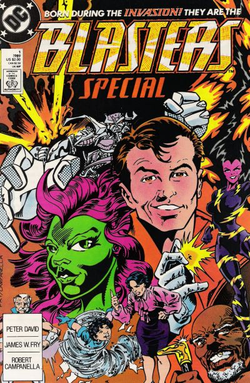 And then, there was The Blasters. Where do you even begin with trying to tell that backstory? In the late ’80’s, Giffen had been given a number of books to work on as one of DC’s rising stars, and with his Justice League book a hit, he was allowed to expand his influence to a number of titles. This also led to him getting to write 1989’s annual all-company cross-over Invasion! Giffen used this end product as a way to cause his various Sci-Fi / outer space story lines hinted at in Omega Men, Justice League International, and Legion of Super-Heroes to converge in this company-wide event. DC’s goal (like it is for any event like this) was to launch some new titles, shake up some old titles, clean house elsewhere in the universe, and move some of the action that is usually contained entirely on Earth into outer space, thus opening up the DC Universe so that the word “universe” was actually on point these days. This was Giffen’s attempt to not only ape Marvel’s Cosmic titles that were doing very well over there (with stuff like Guardians of The Galaxy and Silver Surfer selling like gangbusters), but to try and do a modern version of Kirby’s Fourth World books from the ’70’s.
And then, there was The Blasters. Where do you even begin with trying to tell that backstory? In the late ’80’s, Giffen had been given a number of books to work on as one of DC’s rising stars, and with his Justice League book a hit, he was allowed to expand his influence to a number of titles. This also led to him getting to write 1989’s annual all-company cross-over Invasion! Giffen used this end product as a way to cause his various Sci-Fi / outer space story lines hinted at in Omega Men, Justice League International, and Legion of Super-Heroes to converge in this company-wide event. DC’s goal (like it is for any event like this) was to launch some new titles, shake up some old titles, clean house elsewhere in the universe, and move some of the action that is usually contained entirely on Earth into outer space, thus opening up the DC Universe so that the word “universe” was actually on point these days. This was Giffen’s attempt to not only ape Marvel’s Cosmic titles that were doing very well over there (with stuff like Guardians of The Galaxy and Silver Surfer selling like gangbusters), but to try and do a modern version of Kirby’s Fourth World books from the ’70’s.
It also helped that in the old Justice League comics, there was a tendency to have to fight off an alien menace every other issue, and the one thing that “dark” and “modern” comics of the late ’80’s had been lacking was a good alien invasion. And with any good war story, you needed a band of mercenaries. To this end, Giffen organized a group of new and old characters to work as the catalyst for the Invasion! storyline. This group was loosely known as The Blasters for an actually terrifying reason (their powers all emerged when aliens lined them up and fired upon them, scaring the team senseless and causing their metagenes to activate).
In the wake of the Invasion! series, DC took chances on several new titles, one of which was a one-shot featuring this new team, to see if it might be a book they could add to their publishing roster. Being a Giffen property not only meant that the book had to be funny, but helmed by someone who got Giffen’s take on comics. He not only picked the team to write and draw it (Peter David and James Fry), but set the tone for the book with the comedy and meta-text that followed his particular interests. It also so happened that Peter and James like to produce the same kind of stuff, too.
Since almost none of you have even heard of this title, I’ll spoil everything now and save you the trouble of Lycos-ing or tracking down this story: there has been only one Blasters comic book published since 1989, a special release in the Spring of that year (that was panned by critics and very quickly forgotten). The story, typical of Peter David’s writing, is a mish-mash of Sci-Fi references (largely from Hitchhiker’s Guide To The Galaxy… yes, vogons appear in this comic), and meta-textual references and gags where the captions for the book are destroyed and flown through by various space ships. (The lead character, Snapper Carr – have fun with that particular comics k-hole – finds out what to do next in the story by glancing at the panels that are ahead of him.) If I haven’t done a good enough job of describing what The Blasters is like to read, just imagine something that was written for nerds, and narrow the focus so incredibly that within their own ranks, only a small sub-set will find it up their alley. No matter how much I raved, and no matter who I loaned that book to, it always came back, largely unread, with a comment like, “I tried, but it just isn’t my thing.”
Film
I have often wondered why I heard this phrase so often when I tried to get at my interest in this subject. “It just isn’t my thing.” It seemed like such a ripe area for reflection and narrative complexity to my young mind, and yet it was the element in every story I read that others seemed to skip over. The thing I learned from Warner Bros. cartoons growing up is that, unlike most schlock that is played straight and is absolutely saccharine with predicability and well-worn stories – ahem, Disney, coff coff – you can often get bigger reactions from something if it is unlike everything else around it. Even at a young age, television brought home the idea that there are basically two kinds of stories, and they are each the reverse side of the other. (Summarizing Jorge Borges, one is “A stranger came to town,” and the other, “Someone went off on a long journey.”) Repetition absolutely bred familiarity with me, and the welcome intrusion of characters and references that pointed to the artificiality of this repetition became the attractive element that I looked for in art and culture.
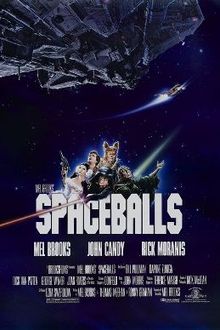 Let me pause my own story a brief moment to say a few words about Spaceballs, a film that spent many years on my list of favorite movies, and my very favorite by Mel Brooks (until I became more familiar with his other work as a teen and twenty-something years later). While all of his films use metatext as a platform to layer joke after joke (see, for instance, the last third of Blazing Saddles), Spaceballs was very close to home for me. I loved sci-fi (and Star Wars, of course), I loved comedy, and they had packaged both with a huge swath of self-awareness that I had not seen in a film before. This movie had my sense of humor written all over it, so much so that there is a sort of chicken-or-the-egg quality regarding which came first. If you had to distill an aspect of that film that moved me, pulled me aside and said, “kid, this is for you,” then I would have to point to Rick Moranis turning to the camera asking if, “Everybody got that?” It went so directly to the core of my being as a kid that it still works on me, even as an adult, and I am sure I quote this movie accidentally without realizing I am. It is possible, if one were so inclined, to make a Bowfinger-style recreation of Spaceballs without my knowledge, provided you followed me around long enough and waited for the appropriate scenes to play out.
Let me pause my own story a brief moment to say a few words about Spaceballs, a film that spent many years on my list of favorite movies, and my very favorite by Mel Brooks (until I became more familiar with his other work as a teen and twenty-something years later). While all of his films use metatext as a platform to layer joke after joke (see, for instance, the last third of Blazing Saddles), Spaceballs was very close to home for me. I loved sci-fi (and Star Wars, of course), I loved comedy, and they had packaged both with a huge swath of self-awareness that I had not seen in a film before. This movie had my sense of humor written all over it, so much so that there is a sort of chicken-or-the-egg quality regarding which came first. If you had to distill an aspect of that film that moved me, pulled me aside and said, “kid, this is for you,” then I would have to point to Rick Moranis turning to the camera asking if, “Everybody got that?” It went so directly to the core of my being as a kid that it still works on me, even as an adult, and I am sure I quote this movie accidentally without realizing I am. It is possible, if one were so inclined, to make a Bowfinger-style recreation of Spaceballs without my knowledge, provided you followed me around long enough and waited for the appropriate scenes to play out.
As I got older and discovered a love of writing, my stories became full of characters that were my own in-narrative proxys. (A Grant Morrison kind of move before I even knew who he was. In fact, reading The Invisibles was painful for me only because periodically I would yell out, “That was my idea!” a problem that would recur when I started watching Lost.) As my big literary influence in those days were comics, and to another degree the DC Heroes Roleplaying Game that I’d gotten for Christmas one year, most of my early writing is littered with a thinly-veiled versions of myself in some sort of elaborate conceit or costume that made me into a superhero. I am fortunate enough that most of this material is still in either a hand-written form, or on typing paper (predating my first computer), and therefore I can’t share these stories with you as easily. (You’re welcome.) Suffice it to say, my Hitchcockian cameos in my own text began very early, and has continued ever since.
‘Zines
 My first foray into my own fiction began with a story I wrote in High School, and was serialized in my zine A.C.R.O.N.Y.M., which was made and distributed between 1994 and 1995. In issue #2, the first installment of naaaaaahhhhghahahhk!!!!!!!! (oR, tHE rEALLY wEIRD sTORY tHAT i cAN’T rEMEMBER wHAT tHE tITLE iS) sees print, and I wish I could say nicer things about it considering I know the author fairly well. I made the decision to typeset the entire thing in what I called the “fIREHOSE” format, which made the story largely unreadable to most people save for myself and those with the highest constitutions when it comes to textual form.
My first foray into my own fiction began with a story I wrote in High School, and was serialized in my zine A.C.R.O.N.Y.M., which was made and distributed between 1994 and 1995. In issue #2, the first installment of naaaaaahhhhghahahhk!!!!!!!! (oR, tHE rEALLY wEIRD sTORY tHAT i cAN’T rEMEMBER wHAT tHE tITLE iS) sees print, and I wish I could say nicer things about it considering I know the author fairly well. I made the decision to typeset the entire thing in what I called the “fIREHOSE” format, which made the story largely unreadable to most people save for myself and those with the highest constitutions when it comes to textual form.
The idea itself was fairly bland: I had written the story my neighbors appeared in, but they find out, get worried, and I have to stop them from learning more, and eventually give up and crumple the story, destroying their universe. Corny, yes, but it illustrates where my mind was in High School. Super heroes appear in this story, and I fight them, even. Most of the writing groups I would attend in the early days had people hashing out their fantasy novels, creating cryptic and impenetrable poetry, or just wanted to turn their journals into creative prose so we could all experience their pain. I was looking to do something that was sort of in-between all of these things, and would read stories like naaaaaahhhhghahahhk!!!!!!!! to puzzled audiences who didn’t know what to think.
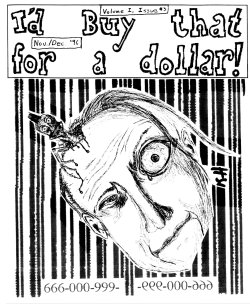 When I settled into Eugene properly after High School, and started to immerse myself in the ’90s culture that surrounded us, I became the center of my own writing again. Between 1996 and 2005, I wrote a ‘zine called I’d Buy That For A Dollar. While this occasionally contained fiction, the bulk of it was an outlet for my incredibly solipsistic and emo ponderings, where I made my best efforts to made sense of life as a lonely young man. While I will cop to have written it all – even the awful bits – with hindsight it is not only unseemly at times, but as my friend Cheryl once said to me, “this is a little too revealing.”
When I settled into Eugene properly after High School, and started to immerse myself in the ’90s culture that surrounded us, I became the center of my own writing again. Between 1996 and 2005, I wrote a ‘zine called I’d Buy That For A Dollar. While this occasionally contained fiction, the bulk of it was an outlet for my incredibly solipsistic and emo ponderings, where I made my best efforts to made sense of life as a lonely young man. While I will cop to have written it all – even the awful bits – with hindsight it is not only unseemly at times, but as my friend Cheryl once said to me, “this is a little too revealing.”
I don’t regret it, because it was so much a part of my psyche at the time that I needed to get that out of my head, even if it wasn’t exactly helping. When I read it back, I don’t know if I feel the same way about the events this person was writing about, even though I am sure we are the same person. Of course, it is easy to say that when almost 20 years separates the earliest issues from now, but I think I let my own misery drive my creative impulses a little too much then, and with hindsight, I wish I had let other motivations steer me toward other material.
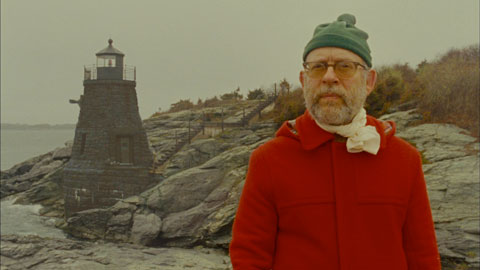 But even this reflectiveness was being shaped and molded by metatext. My roommate at the time, a tall linguist we called Sierra, introduced me to Flann O’Brien, an author who plays with the boundaries between literature and reality for fun and sport, in both his novels and his newspaper columns (which blur the line between journalism and fiction). Discovering Fight Club and Charlie Kaufman movies at this time did me no end of good when it came to plumbing the depths of this well. The Princess Bride was an obsession that started harmlessly enough when I saw it, but led to multiple re-readings and viewings where the genius therein was full revealed. And, let’s no forget re-reading Endgame over and over, which eventually led to a nice and comfortable interest in Rosencrantz & Guildenstern Are Dead, a film that not only rewards with multiple viewings, but might be the funniest thing that has ever been written.
But even this reflectiveness was being shaped and molded by metatext. My roommate at the time, a tall linguist we called Sierra, introduced me to Flann O’Brien, an author who plays with the boundaries between literature and reality for fun and sport, in both his novels and his newspaper columns (which blur the line between journalism and fiction). Discovering Fight Club and Charlie Kaufman movies at this time did me no end of good when it came to plumbing the depths of this well. The Princess Bride was an obsession that started harmlessly enough when I saw it, but led to multiple re-readings and viewings where the genius therein was full revealed. And, let’s no forget re-reading Endgame over and over, which eventually led to a nice and comfortable interest in Rosencrantz & Guildenstern Are Dead, a film that not only rewards with multiple viewings, but might be the funniest thing that has ever been written.
While I’d Buy That For A Dollar was far from metatext in intent, it became an ongoing story about my own life, and one that I recognized less and less as the years went on and I started changing and evolving, personally. Having been steeped in this world of reality and fiction blurring, my reality now read like fiction to me, not because the events hadn’t happened, but the lens through which I was seeing those same events was filtering for something entirely different. Already, even in offering context for this interest of mine, I have to relate to my own life and past through the narrative text I wrote, a breadcrumb trail that offers clues as to what was happening when, and where I have been, but in a form that seemed strange and unfamiliar to the adult I had become. Around 2005-ish this kind of personal writing migrated entirely to this blog – the one you’re reading now. I had been a character in this printed story that now seemed foreign and made up, and if my own life was going to sound that way anyway, then I should probably become comfortable with just making things up from the start in the first place.
 It isn’t that my life changed or that things shifted dramatically in 2005. I was going to college, yes, and outside of radio and writing fiction, my only other interest at the time was girls. But something more subtle was going on that only made sense to me years later. The “me” that I had been writing about for my whole life was gone. I was an adult, interested in different things, talking about life in a different way, and looking for something that I could get excited about that wasn’t informed by my childhood. In many ways, I had become a Sci-Fi trope, where I was living in the body of someone else, a body that carried memories of someone that seemed familiar to me, but also seemed unrelated to the life that I was living now. The 30 year old I found myself being then was not only confused by the life I had led before, but it felt like a life I would have lived differently, had I known how most of it would turn out.
It isn’t that my life changed or that things shifted dramatically in 2005. I was going to college, yes, and outside of radio and writing fiction, my only other interest at the time was girls. But something more subtle was going on that only made sense to me years later. The “me” that I had been writing about for my whole life was gone. I was an adult, interested in different things, talking about life in a different way, and looking for something that I could get excited about that wasn’t informed by my childhood. In many ways, I had become a Sci-Fi trope, where I was living in the body of someone else, a body that carried memories of someone that seemed familiar to me, but also seemed unrelated to the life that I was living now. The 30 year old I found myself being then was not only confused by the life I had led before, but it felt like a life I would have lived differently, had I known how most of it would turn out.
It was around 2005 that I started writing fiction again, much more of it than I had before. Short stories, yes, and very inspired by Borges and Calvino and Brautigan and Flann O’Brien, and some other material I’d absorbed through being on a college campus and having access to the larger world of ideas. And yet, in nearly all of these I insisted in making myself a character in the narrative, a gimmick that my influences were all very good at, true. But for me it seemed motivated by a different impulse. Since I had written the truth and it felt like fiction, inserting myself into fiction felt like a new way and defining truth for myself. Why did I see this other life as someone else’s, when it was clearly my own? Perhaps, if I wrote about another version of it enough, I could crack some of these puzzles that no amount of booze or girls or writing about it seemed to allow me to do.
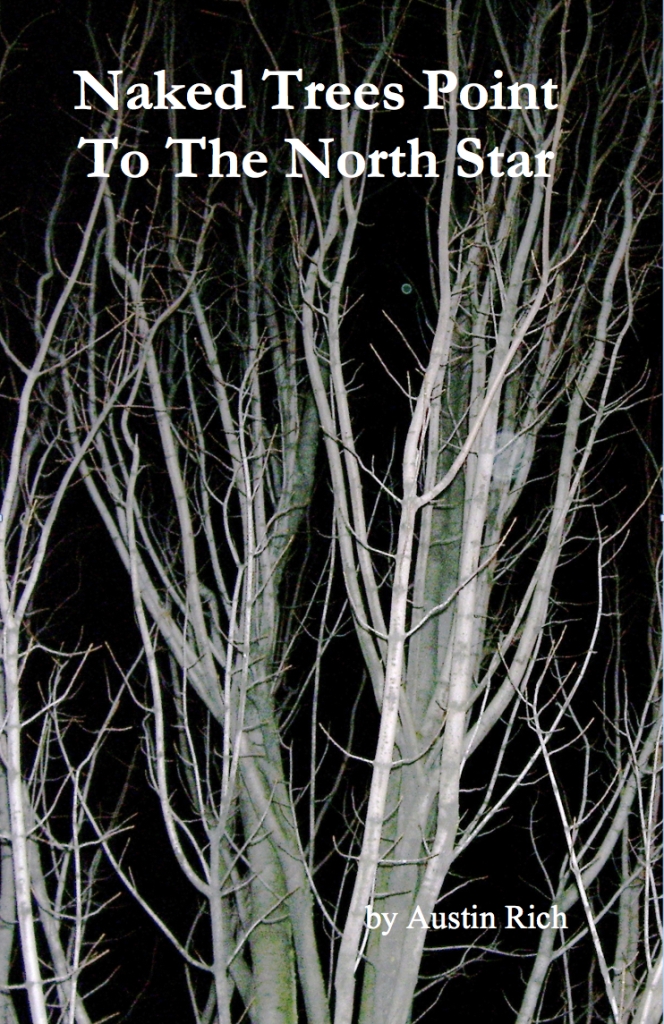 Most of my work since 2005 has been centered around amplifying the idea that I could live comfortably within the stories that I write. And, to be fair, these fictions have been quite enjoyable to try on and waltz around within. I made a 2008 collection of these stories, Naked Trees Point To The North Star, and to this day, it remains the best collection of my written work that I have been able to get in print, and has re-defined who I was, both to myself and to the people who read it. The idea had been gestating since those earliest days at PSU: DIY publications and ‘zines are the perfect form to create experimental pieces of prose, and I envisioned that Naked Trees would look and feel like a ‘zine, would have a personal / journal-like quality at times, but the entirety of the package was a work of fiction, written and made by a version of myself that is almost, but not at all remotely, like the me that had been writing previously.
Most of my work since 2005 has been centered around amplifying the idea that I could live comfortably within the stories that I write. And, to be fair, these fictions have been quite enjoyable to try on and waltz around within. I made a 2008 collection of these stories, Naked Trees Point To The North Star, and to this day, it remains the best collection of my written work that I have been able to get in print, and has re-defined who I was, both to myself and to the people who read it. The idea had been gestating since those earliest days at PSU: DIY publications and ‘zines are the perfect form to create experimental pieces of prose, and I envisioned that Naked Trees would look and feel like a ‘zine, would have a personal / journal-like quality at times, but the entirety of the package was a work of fiction, written and made by a version of myself that is almost, but not at all remotely, like the me that had been writing previously.
The reaction to this was, of course, mixed. Meta is just not for everyone, and while I felt that these stories really got at the heart of struggles that I was going through, I had a hard time talking about the work with anyone else, without resorting to the worst quality in every writer, making the statement, “So, did you ‘get it’?” While it remains the best written work I have produced in any format to date, and I have come to terms with how, in spite of my best efforts, it is more journalistic than fictional, in that it marked a serious shift in my own view of the universe. It was clear that once I imbued my text with any amount of reality from my world, the reality itself seemed further and further from the truth. After publishing that collection all I had left of my former live was this written collection and half-trusted memories to guide me. Something was about to give.
Reality
It isn’t that I decided to make my life reflect these vague and perplexing Sci-Fi and Fantasy tropes to add some spice or flavor to my own experiences. In observing my own interactions with the world – and the interactions of others – it is clear to me that you cannot capture the complexity of this existence, and the strangeness of the mundane, in anything but fantastic language and conceptual thinking. Is it possible to illustrate these kinds of experiences if you haven’t been through them yourself? You’re sharing some wine with some friends, and you’re quickly gobbling every snack you can, because of the night ahead of you.
Gathering everything you can imagine needing, you trundle en mass, passing fellow travelers and enemies, until you arrive at the bar. There is music and magic and libido and peacocking and every manner of horror and excitement on display, charging you, filling you with magic until you are casting conversational spells in every direction. You are filled with an experience you can barely explain, as your friends are performing and watching and drinking and fucking and exploring all manner of joy and pain in one dramatic and perplexing night. And, exhausted, wasted, with a kiss on your cheek and a song in your heart, you perform your last few tricks, produce a cigarette from somewhere, and zig zag through the alleys, to find yourself at home, the next day, perplexed and confused, but itching to do it all over again.
Is that not some sort of fantasy, full of the kind of strangeness and confusion that the best fiction fills us with as we turn pages? At what point does our own life contain a kind of importance that we choose to add it to the cannon, so we can romp through uncharted waters side-by-side with Odysseus? Are we all content to wallow in the banality of brushing our teeth and making lunch?
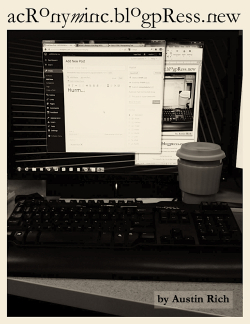 Three things happened in 2010 that had a huge effect on me. First, I finished college, a banality that I had put off for too long, and was only causing me to spin my tires and was getting in the way of my next phase in life. I moved in with a friend of mine (second thing), and when all of that was said and done, I had an experience that is difficult to explain, which I attempted to document in 2013’s acronyminc.blogpress.new.
Three things happened in 2010 that had a huge effect on me. First, I finished college, a banality that I had put off for too long, and was only causing me to spin my tires and was getting in the way of my next phase in life. I moved in with a friend of mine (second thing), and when all of that was said and done, I had an experience that is difficult to explain, which I attempted to document in 2013’s acronyminc.blogpress.new.
Essentially, I lost 10 years of my life, and in processing that event, realized that not only was I living in a future that made little sense to me, but that the memories I did have were absolutely those of someone else I no longer connected with. It wasn’t exactly a sudden experience, and it didn’t come on over-night. But the span of time between the Millennium turning over and my own academic leveling-up had become dreamlike, and waking up on the other side of it created a world for me that was now actually full of technology and behavior that was ten years ahead of who I felt I was. Without intending to, the world around me began to fully resemble something straight out of my own fiction, and now I was the character who was just enough aware to question what kind of Duck Amok world of which I was now a part.
The best part about living within your own fiction is that, on the whole, things tend to work out okay. In spite of being a temporal mess, covered in magic and confusion, I managed to meet someone who has become so central to my own life, and we have found a place we can call our own. My efforts to capture this reality I’ve been inhabiting and communicate it to others has become a steady routine, a rhythm that I can count on to keep me focused and aware of what may lie ahead. And you get to enjoy these efforts, too, which is no small thing, I imagine. And usually, the hardships we face are handled together, so that neither of us has to take on too much of the burden this world presents us with.
But this doesn’t ease the strangeness we encounter every day. We look at TV, and it barely resembles the things we remember knowing. These computers in our pockets are straight out of a novel I read as a kid, and the social changes our world has gone through not only seem unreal, but were absolutely unobtainable when I was a child. (Open homosexuality? Gluten free restaurants? Reality TV Politics? Legal weed?)
For better or for worse, this world reads as more fictional than anything I can have come up with, at any time in my life, and for that alone I will continue to define the borders of this made-up universe, flesh out the parts that I can see and understand, and hope that when I hand it over to you, trembling, nervous, that the things I see are like what John Nada’s sunglasses reveal, that, hopefully, you can look at it, take it for what it is, and remember that this can’t be any crazier than the religious world most everyone else lives in, too.
The only difference is: I know I made this one up, and I’m absolutely willing to admit it.
 For many years now I have been urging friends and family to donate to the radio station I happened to be volunteering at when I made that year’s particular request. And, it is easy enough to see this as yet another plea to add to the many I have made in the past. Combine this with NPR’s regular pledge drive’s, your kid’s trying to raise money for band, the homeless guy that hits you up for change, and you are pretty consistently being asked to donate money to something where you are not getting a nice tasty treat or some new gadget that you can play with.
For many years now I have been urging friends and family to donate to the radio station I happened to be volunteering at when I made that year’s particular request. And, it is easy enough to see this as yet another plea to add to the many I have made in the past. Combine this with NPR’s regular pledge drive’s, your kid’s trying to raise money for band, the homeless guy that hits you up for change, and you are pretty consistently being asked to donate money to something where you are not getting a nice tasty treat or some new gadget that you can play with.
I understand. You are strapped for cash, and we are thankful that you listen at all. For those of you who are not doing that well, financially, this message is not for you. We urge you to keep listening, and we promise to continue to deliver incredible programming the way we do normally. And, during Pledge Drive, you can expect even more great radio than normal. Everyone goes the extra mile to make great radio during the drive, and this is a great time to listen, no matter what.
But, for those of you with a little extra money, please, consider donating to KMUZ and keep Community Radio funded.
KMUZ’s Winter Pledge Drive is February 6th – 12th, and if you enjoy community radio made in the mid-valley here in Oregon, then we urgently need your help in keeping this station on the air. Not only do I volunteer in the office at KMUZ, but I’m a regular panelist on their Geekly Update program, that airs every Sunday at 2 PM, where we talk about nerdy topics and a host of other subjects that appeal to the nerd and geek in us all. KMUZ also offers a number of great music programs, as well as unique talk shows that you can’t find anywhere else.
Unlike most entertainment, community radio is entirely funded by listeners. No one pays us to come in and do this. No company is coming in every month to keep the lights on. We don’t have wealthy donors to help us stay in business. The only time we get any money is because people like you decide to offer your help directly and give us the financial support that keeps community radio going. There is no well of money beneath our station, and no celebrity philanthropist offering to make our dreams come true. Instead, we turn to the people who count on listening to community, and rely on us to give them shows that they can’t find anywhere else.
These days, between a Netflix subscription, the comic books you pick up weekly, the movie you see with your partner every so often, those expenses add up. We realize that even a small donation is asking a lot. But, consider putting us on your list of expenses, next to Gas and cable. Not only will you be keeping community radio up and running in an area that gets no other funding, but you will be making a difference to the lives of us, our listeners, and the very idea of community radio as a whole.
If supporting KMUZ Radio sounds like something you’d like to do, please consider following this link and make a donation. You can also call us at 503.990.6101 during the drive itself – February 6th – 12th – and support us directly in a way that means so much to those of us who give our time and energy to this kind of endeavor.
Radio has been an important part of my life, so much so that I’ve dedicated the better part of 20 years to it. If you have been touched by any of it, and would like to help out, then this is the way you can do it, now.
Please, donate to KMUZ, and keep Community Radio in the mid-valley on the air.
Do it!
 A Completely Subjective Discussion Of The Classic Rock Radio Format As Recollected By A Radio Nerd Who Did Some Online Research And Got Unnecessarily Nostalgic.
A Completely Subjective Discussion Of The Classic Rock Radio Format As Recollected By A Radio Nerd Who Did Some Online Research And Got Unnecessarily Nostalgic.
As a kid, my parents listened to what has come to be referred to as, “Classic Rock” in the radio world. Little did I know that, as I was growing up, this was a relatively new format on radio. I had no knowledge of the history of formats at the time, and couldn’t tell you the difference between AM and FM back then. All I knew was that my parents liked The Who and Led Zeppelin and Pink Floyd and stuff like that, and where we lived, the place to hear that kind of music all day, everyday, was on KZEL-FM, which you could hear just about everywhere in rural Oregon between 1980 and 2000, when I moved out of range of the station.
Not that I listened all the time. I started to loose interest around 1992, when I discovered music that was outside of my parents influence. To me, KZEL was the soundtrack to my childhood. My mom would record her favorite songs off of KZEL broadcasts, and it was the station our cars were always tuned to. Every time there was music on in the yard, or the stereo was blasting and wasn’t playing an LP, the sounds we heard were always KZEL. No other station would do. In fact, my mom won a listener contest when I was in High School, and she got to host a show with some of their DJs as part of the contest. (This led to her interest in, and eventual minor career in radio.) KZEL was where I learned to love listening radio, to ignore the songs and to listen for the DJs and the commercials and other produced bits. It was, through osmosis, my first radio station.
But it played music that, while clearly my parents music, did not speak to me personally. “Classic Rock” is an interesting format, because it was developed around the time that the “Oldies” format came to be (that is, Rock and Roll music from the early ’50s through the early ’60’s). “Classic Rock” itself mostly defined itself as being of music from the late ’60’s through to the early ’80’s, and even then, focused on big acts, well known songs, and music that fell into a particular “70’s Rock” vein. (I used to call it, “Music you can’t drive 55 to,” or, “Bob Seger’s Old Time Rock And Roll”.) “Classic Rock,” by definition, was trying to plant a flag in the ground, staking out the territory for a generation of radio listeners who felt that a very narrow range of sounds and styles spoke to their lifestyle and their interests, and by labeling it “classic” on the radio was stating – for the record – that these songs and bands would last for generations, and would define rock music for the future.
But none of this music really spoke to me as a kid who was 10 in 1985. While I came to know and even appreciate some of the music I heard, it always sounded as if it was out of place, out of time, and of someone else’s childhood. I didn’t understand the excesses of the ’70’s, and in my own childhood, with ’80’s pop culture and my TRS-80 feeding my brain, I didn’t understand the bong-rattling importance of Grand Funk Railroad. I never got to hear much current “popular” music in my house growing up, aside from my mom’s interest in ’80s hair metal and the occasional “new” B.B. King / Eric Clapton release. (And even those are extensions of “classic rock” motifs, that of partying and rocking and finding a good woman that will treat you right, etc.) We grew up with Classic Rock in our heads. Songs like “Smoke On The Water” accidentally became associated with my childhood, in spite of the fact that I was at least 20 years too young to have any idea what that song was about, why it was important, or who the band even was.
Let’s Get Some Of The History Out Of The Way.
The first Classic Rock station was, of course, born out of Cleveland in 1980. Radio had long since been dominant in Cleveland, and many big name DJs had made names for themselves there in the ’50’s and ’60’s, cementing on-air style and patter that was copied by other DJs across the nation. But the fork in the road really happened in the early 1960s, when FM Radio hit the airwaves, leaving the monophonic and “tinny” AM Radio sounding like some archaic dinosaur from the Antique Radio era being tuned in on a crystal set. Stations that had made their name on the AM found themselves competing with the improved fidelity and superior quality of FM, and many stations bought FM signals so they could simulcast their programs and stay competitive.
The FCC eventually mandated that FM stations couldn’t just re-air the same stuff that their AM counterparts were playing, to the distaste and frustration of radio station owners and programmers. This left American with a huge swath of FM stations that had 24 hours a day to fill with new shows and DJs, and being locked out of their tired old AM formats, they had to innovate, fast. In a rush to get programming on the air, DJs were given the chance to have “freeform” and “progressive” formats, something unheard of before 1964. A DJ could play anything, even songs that were not hits, if you can imagine it. The cut that takes up all of side b could finally be played on the radio, where old programming rules would forbid something that wasn’t a nice a peppy four minutes. Freeform and Progressive radio of the mid ’60’s was a place where DJs could really cut loose, and with the improved sound of FM, listeners could really appreciate the music on these records that DJs were playing. FM stations all over the country switched to this new format so they could keep on Rockin’ in the Freeform world.
Of course, station managers hated these changes in the cultural climate. Radio was a very good way to make money in the old days, and the way stations made money was to sell ads against a show that listeners loved. Station managers knew listeners loved the shows because of a consistent format, where the same set of personalities delivered the news at the same times, where hit songs were played in a more or less random order, and where every minute of every hour – including the ad that was being played – was micro-managed. Sure, certain DJs would attract more listeners than others as they became engaging personalities, but that was largely because the DJ was well known over time, or their time-slot was ideal (like, drive-time, or early evening commute.) Using the old way, station managers could guarantee that a show would be successful merely by packing their playlists with hits and guaranteed programming the sponsors could count on. Sooner or later, the advertisers would start calling if they wanted to be associated with a hit show.
The switch to FM and Freeform radio was the first huge fragmentation of the way money was made in the music industry, a kind of disruption that is on par with home cassette recording, or the iPod. Allowing DJs to do whatever they wanted made it difficult for stations for sell advertising they way they were used to it, and old-fashioned radio listeners found the new music that was popular on progressive radio stations to be too “wild” and “strange” for their tastes. (FM comes on the air in the early ’60’s, just in time for the British Invasion and the Garage Rock / psychedelic explosion that followed in its wake, of which DJs loved.) Genre was largely out the window on Freeform stations, yet another difficulty when trying to sell the station to advertisers. While this led to a host of non-commercial, listener-supported stations that enjoyed being contrary to conventional radio standards, Freeform became an f-word in the radio world, especially when it came to money, and when the naiveté of the ’60’s developed into the cynicism of the ’70’s, something had to change again.
First, radio stations lost money. A lot. Most of them cut expenses by laying off staff, reducing the size of their studios, and selling off late-night or early morning broadcasts to run syndicated programs, not as popular or well loved, but at least consistent enough to generate a little dependable revenue. When that wasn’t enough, stations switched to “Album-oriented rock” – or AOR, as it was known at the time. It was clear that rock music was changing yet again, now that singles were no longer the dominant form of music and bands were getting louder, heavier, and raunchier. As new technologies like computers began to take over marketing, Station managers and programmers became enamored with research-based approaches to what they would play on the air.
Taking cues from listener requests and the kinds of information they could gather in each region, stations began to make an effort to find out what music and artists were hits with their own specific listeners, and in some cases ignoring Top 40 trends. Stations began to create playlists and structure their broadcasts around albums that were getting the most traction with their regional audience, which could now be tracked in ways it had never been in the past. Whole albums were now allowed on station playlists, hence, the AOR name, and this generated a whole new generation of stations that each created a unique identity in the minds of listeners. Some stations played lots of Beatles. Some played a lot of Stones. No two stations curated the same kinds of playlists, and station rivalries in competitive regions were common, the way sports rivalries developed between fans.
Of course, a side effect of all these white station managers and white DJs polling their white audiences about the white artists that they loved the most created a huge backlash against the AOR format – now referred to by opponents as MOR: Middle Of the Road. As hard rock and psychedelic trends began to mellow out, you encountered a much “softer” kind of radio in the mid-’70’s, dominated by The Eagles & Fleetwood Mac clones, changing radio from the exciting and “loud” place it once was – hosting Summer of Love concerts and outdoor festivals – to a mellow, relaxing place where listeners could put it on in the afternoon and would barely notice the radio on. It became clear, as black artists were being excluded from any of this, that other kinds of formats were just around the corner.
R&B has always had a rocky relationship with radio before the ’60’s came around, and while Motown and Stax helped improve the image of black music in white America, rarely would a black artist break on the white charts. While some DJs would play black artists – often against station policies – smaller stations near large black populations where the places that played this kind of music, and sometimes, only in very large cities with diverse radio markets. But as Funk music crept into the national consciousness in the ’70’s, it became clear that there was a world of popular music that was largely being ignored by commercial radio, and culture clashes between the old-fashioned radio racism and the changing formats found black artists as pawns in the chess game of radio programming. Stations that were willing to incorporate “acceptable” funk acts that complemented their current sounds were often considered “edgy,” and gained younger audiences.
The ’80’s saw two big artists enter the popular culture that required radio to change. When Michael Jackson and Prince made it clear that the kind of institutional racism radio had been guilty of could no longer be tolerated, radio formats were revolutionized. AOR stations began to die off, as advertisers found the selections to be boring, and generated little business for them. R&B stations were loud and bombastic and fun, began to fill the musical and advertising void that radio had been lacking during the “mellow” years. What few stations were left that needed something new switched to either a talk or country format. (Both talk and country had existed before, of course, but in the ’80’s radio had fractured so much that these became viable format that could actually compete on a scale as big as anything else at the time.)
In the old days, radio had largely been created at the station level, and perhaps some stations would package one of their popular shows as syndicated content, that they could send that to other stations if they wanted to expand their own programming (in those days, the show was a scripted and recorded program). Networks eventually popped up, and these independent stations became associated with a larger network. For many stations, the network was just a different way to get syndicated content; they still created a number of local shows, but they ran some of the big-ticket shows from their parent company (either NBC, ABC, CBS, etc).
The ’80’s saw radio going national in a very big way, and other companies wanted to get into the act, too. New businesses would buy up as many stations as they could, and would generate new syndicated content on a huge scale, making radio sound uniform across the country, but through music formats rather than through specific syndicated shows. A company that excelled in one kind of music – soft rock, for example – would create a cookie cutter playlist format that they could teach to any station, and transfer this to the stations they bought up.
College Radio Stations took the country by storm in the ’80’s, clinging to the freeform idea in spite of the fact it had virtually disappeared nearly everywhere else. And with punk rock and DIY music beginning to build a network of their own, the college stations became the backbone for keeping that music alive in the public’s mind. NPR took of in a huge way in the ’80’s after getting improved funding and more national attention. When all was said and done, it seemed as if the old fashioned rock and roll radio that had been derailed by AOR might come to an end in the ’80’s, and for a while, “Old Time Rock And Roll” seemed out of place in the modern era.
Bringing It All Back.
WWWM 105.7 in the Cleveland was the first station that decided it was time to bring back “Classic Rock” music in early 1980, and that is the year that ’70’s nostalgia officially began. (Sorry Dick Vaughn.) Classic Rock as a format was fairly straightforward: use the lessons of Top 40 and research-based radio, but narrow the focus to albums and artists that encompass music that would appeal to people who had been in High School during the last years of the ’70’s, to some, when “the best” rock music was being made. At the times, this usually included music from the mid to late ’60’s through to the late ’70s, and pretty much nothing else. The emphasis on Rock and Roll of that era served a two-fold function: teenagers who lived through this music were now adults making radio-listening decisions, and this music spoke to nostalgia and adolescent desires that wasn’t being tapped into elsewhere. Secondly, the Classic Rock format was intentionally exclusive; there were no black artists included in this original incarnation of the format. There was no country. There was no talk. There was none of this modern college radio bullshit or that lame jazz crap you hear in cities, just loud guitars and a healthy disrespect for authority. Yes, Classic Rock comes from Cleveland, but it wasn’t that many years later that the format swept the country.
In the ’80s, for the most part, you could tune into a Classic Rock station almost anywhere in the US, and while you would think that the years Classic Rock covered could uncover a huge number of songs to play, usually listeners would hear the same 50 songs being rotated through all day, every day. This was, in many ways, the McDonald’s-ification of radio, where you could go anywhere and hear the same things you were used to hearing back home. This was great for people who traveled a lot, like truck drivers, but left little to the imagination if you wanted to hear a cut from side two, or a song that wasn’t necessarily a classic “hit” in your area. (For example: try finding a single Classic Rock station that will play anything from Led Zeppelin III. Unless that station is doing a “Zeppelin Weekend”, you will never hear any of those songs on the air.)
Need I drive the point home any more, Classic Rock was a coded form of racism on radio in an era that was supposed to be post-racism. It was a way for people who grew up in a sheltered white childhood to pretend that black artists and country music was not part of their musical landscape, and even the lack of news, sports or weather – save for occasional, 15 second updates near the top of the hour – makes a Classic Rock station a perfect way to isolate their listeners in a world that is not difficult or complicated. Here’s another rock song, another twofer-tuesday, another chance for the production manager to edit “I Love Rock And Roll” or “We Built This City” into their station ID. When you listen to Classic Rock, the passage of time is irrelevant.
Now, Let’s Tune In to 96.1 FM in Eugene, OR
This brings us around to the Classic Rock station in question – and the one of which I have the most first-hand knowledge – KZEL. The station that became KZEL was first known as KWFS, which went on the air by the end of the ’40’s. (There had been plenty of radio stations in Oregon going back to the ’20s, but there was a huge surge of new stations in the Eugene area just after WWII.) KWFS continued until the ’60’s, when an FM signal was launched at 96.1. (KWFS almost immediately abandoned AM in favor of the 96.1 signal.) However, the owners of KWFS found managing a station to be too much work, and sold the station in 1967. The new owners changed the call letters to KZEL, and the KWFS call letters were adopted by a new station in Wichita Falls, TX.
KZEL – in its new form – first hit the air that same year, but again, was a bit much to handle as the freeform format wars began to change the landscape of radio. The big competition in those days was Wolfman Jack, which you could hear almost anywhere in the US, and unless local stations got hip, kids would flip over to him at night. By 1971 KZEL changed hands (and formats) again, where the new owners were happy to adopt a progressive format to stay competitive with Wolfman. But the ’70s and early ’80s made it difficult for any station to turn a profit, and many advertisers pointed to the progressive format as part of the problem. (“We like some of the music you guys play, but not all the time.”) In danger of changing hands yet again, in the early ’80’s the station managers at KZEL began to take notice of the Classic Rock sounds coming out of Cleveland. Most of the KZEL staff already loved that kind of music anyway, so almost overnight, KZEL switched to “Oregon’s Classic Rock.”
By the time I was growing up and listening to the station with my parents in the ’80s, they were just like any other station you could hear anywhere that played “Classic Rock”: the same 50 songs, every day, every week, keeping listeners suspended in their High School and College days, just the way the late-Baby Boomers liked it. Of course, I had no understanding of this history, or how the radio I was listening to got to be the way it was. I was just some kid being raised by hippies, and this was the music we listened to in our house.
I received a cassette deck / radio with a built in microphone for my 10th Birthday in 1985, and using that I began recording my favorite songs from the radio onto tapes. Pretty soon I found myself more interested in the commercials, and I began editing together my own voice overs (impersonating my favorite DJs) with my own songs and commercials recorded from KZEL. There were nights when I would have the radio on, quietly in my room, letting the sounds wash over my childhood mind. I would surf stations often too, and listen for a while, but I would always return to 96.1, just like everyone else in my family.
As a regular listener, I started to get familiar with when the hosts would take calls and requests, and once I broke through that barrier, I became a regular on the air. Usually in the afternoon and evenings, and soon I was pretty proud of the fact that I could get my name on a show almost any time I wanted. (I would regularly ask the DJs to give birthday shoutouts to my friends and family, and if nothing else was going on, make a request for my song de jour that day.) Of course, radio stations are notorious for contests, and I was consistently able to win new tapes from these giveaways because I was quick on the phone, and knew their habits well. This is how I discovered Tesla (the band), .38 Special, both of the Use Your Illusion Guns ‘n’ Roses albums, and got my very own Led Zeppelin tapes. But I didn’t listen to the tapes as much as I thought I would, and why not? I could just turn on the radio.
I remember vividly the first time my mom drove me to the station, to pick up an album I had won. There was a well-known commercial for KZEL on TV, where the DJ was running through a maze of LPs to get the next record to the booth in time for the next song, and I absolutely believed that the station must be like that. My mom has thousands of LPs, so it made sense that they would have even more. But arriving at the front counter was a very disappointing experience. All these voices I was familiar with, reduced to flesh-and-blood bodies that were just like everyone else I knew, looking at this gawky kid, they sort of rolled their eyes. A cheap cardboard box was produced, and inside were a ton of cassettes, some mangled from typical radio station neglect. Even though I had specifically won the live Tesla album, the girl at the counter said, “Just take any one you want. There’s plenty in the back.” The fun and mystery of listening at home ruined by the bland reality of fluorescent lights and the work-a-day lives of these people who were just punching a clock. It was a revelation, in a way.
As the years wore on my relationship to this station changed. When I got to High School I started meeting people who listened to modern music, stuff I’d never heard on KZEL, ever, and this music was absolutely fascinating. But this was the early ’90’s, and I wasn’t the only one going through this identity crisis. I remember listening to KZEL one night when one of the DJs mentioned a band that everyone was talking about – Nirvana. The DJ was convinced the song couldn’t be as good as the hype, but decided to play “Smells Like Teen Spirit” anyway. I remember being non-plussed at the time, until I heard the song again, and later, saw the video. By the fourth time I’d heard it, I was hooked, and suddenly anything else KZEL played seemed tame and boring.
I won Nevermind on KZEL in a listener contest, but even when I showed up to get the album, I could tell that my time as a KZEL fan was limited. The girl at the counter laughed when I asked for it, and I could tell they didn’t like the album as much as I did. They would dabble a bit in new music in that year, but the Classic Rock format always dominated in the end. Sooner or later, they would return to a block of The Who songs, and back to their old format. And by then, friends had hooked me up with Ministry and Nine Inch Nails, and my interest in Classic Rock and KZEL was on the way out. I pretty much stopped turning on the radio at all by the time High School was over, and I never heard the station once in the six years I lived there.
Coda
In 1997 the Cumulus Media group was formed, and made an effort to buy up as many stations as they could, KZEL being one of them. By this time, I was living on my own, and hadn’t tuned in for years. The Cumulus Group began to popularize the AAA format (adult album alternative), a new iteration of Classic Rock that included all the old “heavy” albums, with “new rock” hits from the “alternative” era. (A lot of stations call this format “New Rock.”) This made sense; as demographic groups age out of listening to their father’s rock and roll radio, the younger groups have different tastes that need accommodation, too. And let’s face it, “alternative” music is absolutely the Classic Rock of Generation X. Essentially, the same kinds of people are listening to KZEL now than they did then, just with a slightly different 50 song playlist and a bigger chance of having a Soundgarden tattoo.
And why not? Radio has often been for the middle class, and there is a who swath of bros who are looking for something to get pumped up for as they try to remain comfortable with being in their 40s. They want the music that spoke to them in High School to insulate them in a place where they understand what “cool” and “hip” is. New music is scary and hard to find, and it is much easier to ignore the culture and the world around you when it doesn’t make sense to you. Coded in two levels removed from the racism it once was, Gex X Gym Rats can listen to very while music in their small towns and never have to question the way they fell about it, ever.
It isn’t that The Cumulus Media Group is trying to be horrible. They’re trying to make money, and that is largely the motivation behind any tired old ineffectual dinosaur clinging to the radio dial like some monster from a bygone age. But even the remotest scent of that kind of radio turns me off, instantly, and these days I’m looking to the generation after mine to hopefully clue me into something that doesn’t feel old fashioned and too “white.” But even I fall into this trap; I listen to music with guitars and live drums and it is hard to think of Black Flag or Bad Brains as anything other than “quaint” when you think of the brutal music that kids like these days, or the electronic harsh noise that is also available. And I’m still trying to break the color barrier in my own collection, as I have noticed an abundance of while men among my 12 Inches.
But at least I’m aware of the problems inherent in my playlists.
When I was a kid, I never thought that the music I was immersed in was boring. It was the music I was immersed in. It WAS music. But now that I can see it from outside, and see it for what it is, I’m glad I moved on.
I’m just wondering how much longer the vestiges of Classic Rock Radio will need before they move on, too.
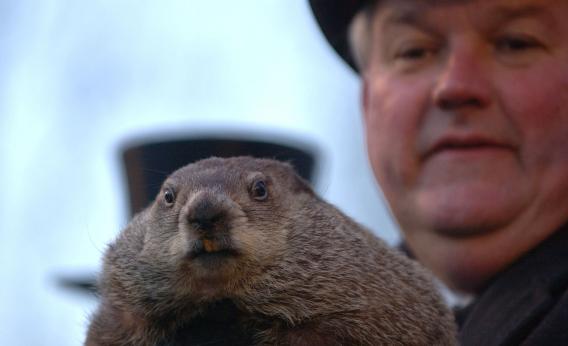 Groundhog Day Special! (Retrocast)
Groundhog Day Special! (Retrocast)
(Featuring a Groundhog Day themed show from 2009!)
Here’s a radio special from six years ago, addressing the rarely-discussed subject of Groundhog’s Day, or in some cases, music about Hogs, the ground, and shadows. In this show, we ask the question: where have all the Groundhog songs gone? This one won’t pop up in the podcast feed, but as always, you can either stream or download this one to your heart’s content.
I was absolutely shocked at how little Groundhog music there was to play for this show. Any musicians out there looking for something to write about, now’s your chance! This holiday is largely unclaimed, and you could be the one to release the very first Groundhog Day Rock Record.
About halfway through the program I offer a rambling and disjointed history of Groundhog Day. Most of the information was culled from several passes over the Inter-Web-A-Tron, so it’s as reliable as anyone else is these days.
I have always had a fascination with holidays like this, and when I was growing up I really felt the need to celebrate as best as I could in whatever way relevant. I was the kid who was planting a tree on Arbor Day, coloring images or our President’s on President’s Day, and reading about the various ceremonies surrounding Flag Day. But with control over the weather, Groundhog Day seemed absolutely magical as a kid.
The irony of Groundhog Day is that it is intentionally set six weeks before the official start of Spring, a sort of joke played on kids who really think the groundhog is special. But there is something nice about being forward thinking in that respect anyway. After a long winter, we sometimes need a little prognostication regarding what is ahead of us, if for no other reason than to feel that we at least know when we’ll see the sun again. Given our atypical weather this year in Oregon, and the drought last year followed by a mind winter, I can only imagine that the next six weeks will actually be cold anyway, to finally deliver the winter we deserve.
But I’ll be happy just to know the little guy popped out of his hole for a moment or two.
[Insert weather report.] If you want to know how things turned out in your area, here’s a very handy website.
Anyway, enjoy this program from the past, and hopefully you are excited about your particular weather report this year.
Enjoy!
*
Post-Groundhog Day Special!
 If you look carefully, you can see the scars where my ears used to be pierced. At one point, I had metal jammed through my conch and parts of my lobes, and the scar from the hole in my tongue is still there, though I doubt I could get a barbell through it anymore. While I was happy to shove metal into my face as a younger man, when I stumbled upon these piercings the other day I almost didn’t recognize them. I was never very good at being a pierced member of society, and the ones that I paid for seem like poor choices now, considering how little money I had back then. While it certainly hasn’t disappeared from the world as a whole, it is clear with hindsight that I got caught up in the piercing craze of the ’90’s. The fact that I don’t have saggy earlobes and tribal scarring on my arms is a testament to how much of a temporary dalliance it actually was for me.
If you look carefully, you can see the scars where my ears used to be pierced. At one point, I had metal jammed through my conch and parts of my lobes, and the scar from the hole in my tongue is still there, though I doubt I could get a barbell through it anymore. While I was happy to shove metal into my face as a younger man, when I stumbled upon these piercings the other day I almost didn’t recognize them. I was never very good at being a pierced member of society, and the ones that I paid for seem like poor choices now, considering how little money I had back then. While it certainly hasn’t disappeared from the world as a whole, it is clear with hindsight that I got caught up in the piercing craze of the ’90’s. The fact that I don’t have saggy earlobes and tribal scarring on my arms is a testament to how much of a temporary dalliance it actually was for me.
Growing up in the ’80’s was complicated for everyone in a number of ways, but by the time I was in school one topic that came up often was that of piercings. Nearly all women were expected to have tasteful piercings of one kind or another, and there is often a rite of passage that young girls go through with their mothers when they are old enough. I remember my mom taking my sister to the mall, who returned in pain and with new holes in both of her ears. I was older than my sister by five years, and while it had never occurred to me that I wanted my ears pierced in a similar fashion, once I saw my peers all wearing them, I wanted it too.
However, once I made a comment about this out loud, the trouble started. “Boys don’t get their ears pierced,” I was told by my family, but I knew that this wasn’t true. I had seen men on TV and in public wearing piercings, and as much as I knew that men could do it, the subtext of the conversation was two-fold then: wanting pierced ears made me gay, and my parents would have nothing to do with it regardless.
It wasn’t until I started talking to my friends about it in Jr. High that I started to hear the, “Left ear, buccaneer; right ear, queer,” rhetoric Prior to this, I had no understanding of sexuality, or even that there was something other than the binary that my parents represented. All I knew is that I wasn’t yet over reading comics and playing with imaginary friends, and that girls were mysterious and not for me, yet. But as my friends started to show up to school with a single piercing on the left and budding facial hair in patches, they usually accounted for it with some sort of phrase like, “Left is right, and right is wrong.” I made a few attempts to ask my parents about this, and the awkward silences and shared glances between them meant that this likely fell into the territory of, “The Talk,” and I wasn’t about to let me dad load me into his truck again so he could drive for hours trying to explain to me something that he was very clearly not entirely comfortable with himself.
I dropped the idea until High School, that time when the venn diagram of self-destruction, boundary pushing and poor impulse control overlap into a fun-filled four-year period where everything sucks. Not only did I see a slight up-tick in the number of piercings I saw my fellow students – on men, no less – but the more I talked to people about it, I discovered that you didn’t really have to pay someone to do it for you. A collection of heshers on our campus accidentally taught me that if you sterilized a safety pin (aka, “burned the end with fire”), you could shove it through any fleshy part you liked, and it only hurt for a few days. I also discovered that, if you do this on your own without telling your mom, she’ll be a little horrified and surprised to see random scraps of metal hanging from you ears. While I was never asked to take them out, I could tell that this wasn’t exactly the best way to win her over as we became strangers to each other through the sheer act of growing up.
Boredom usually motivates much of what teenagers do, and by the end of High School I had removed all the safety pins, and more or less let them heal over. It wasn’t until I moved to Eugene, and more importantly met a dude named Ocean at an IHOP one night, that this began to change.
If you were of a certain age range in the ’90’s – and you were not the kind of person who had discovered alcohol as a wonderful way to enjoy your evening – then your destination when the sun went down was the nearest 24 Hour establishment that served coffee. On any given night, across the country, teens and 20 year olds would wander the streets in packs, looking for a booth to set up camp in and write your crappy poetry, or draw your unpublishable comics, or talk about the bands you would never actually start. I had several circles of friends that all did this, and one night as we were mocking up stuff for the newest issue of my ‘zine, we ran into Ocean, head to toe in piercings and tattoos, with his girlfriend Yannica, who had both just gotten to Eugene and thought John’s Skinny Puppy shirt meant we should all get to know each other. This not only inaugurated Ocean into our circle, but when we found out that he’d gotten a job at High Priestess – the first local shop in Eugene entirely dedicated to piercings – this soon became the place that we hung out at when the staff were between clients.
In those days, piercing shops were not at all common, and while you certainly met people covered in them, I was often left to wonder where this stuff was done. High Priestess was interesting in that it was below a tattoo parlor, and near a convenience store. A parade of weirdos and like-minded folks came into that building every hour, and hanging out there meant a good chance to meet people you knew, listen to music, and in some cases when the clients were into it, you could watch people get undressed as different parts of their bodies were being lanced. Between the watching various tattoos and piercings be administered, I saw a fair and steady string of naked men and women.
I ordered the two small hoops in the picture above, and against Ocean’s recommendation, used a safety pin and made a pair of mostly centered holes for them. One day, while bored and out of clients, gave me a $10 deal on my conch, and I put various items in it over the years. When I would go shopping for new albums, I usually dropped by so Ocean and I could check them out. We would regularly gather at the shop to plan our evening afterward, which sometimes involved dropping acid, or getting coffee, or hitting a party as a group. For a brief period of time, it was the center of our social group.
I had a job that I hated working in a factory at the time, which I got in the wake of being dumped and evicted from the place I was living. I piled everything into a storage locker and started staying with the aforementioned John, but working 12 hour shifts at night only separated me from my friends further, and made be a little bitter about the way it had all worked out. In a fit of anger, I walked out during a shift, quit the job, and cashed out every check and pending income I could find. I made one last stop by High Priestess and asked Ocean to pierce my tongue. Then I left town for a week to sort things out.
The tongue piercing was legendary among many people I knew, largely because it was supposed to improve your oral sex skills through the aid of this studded implement. I can’t really speak to that as someone who had the piercing. What I remember was the pain; it hurt. And continued to for days. Eating was a bitch, and as I tried to each noodles the day after I felt betrayed and horrified by the act that I’d been through. I almost took it out, but let it heal, hating the experience, and when all was said and done, found it to be in the way more than the sexy and alluring accoutrement that I hoped it would be.
As the years wore on, I found it to be in the way more than a bonus to my lifestyle. It would accidentally clack against my teeth, or would get chomped on by mistake. Occasionally it would feel a little sore, and the piercing required regular cleaning that I did not account for. I moved out of John’s place, and eventually moved away from Eugene entirely, and when it had been years, after I’d already removed all the other piercings and decided that was no longer for me, I still had this barbell in my tongue, impressing no one, occasionally causing me pain and getting in the way.
One day I took it out, and set it in a dish near my bed. And I never put it back in again.
I suffered in the long run. One of my front teeth on the bottom – where the piercing would regularly “clack” into by accident – is now gone, it causing incredibly paid one day from the damage it sustained over the years. Instead of the piercing, I get to wear a denture, a fitting end to a bad idea. I occasionally notice the scars these left behind, like memories from a friend you no longer see, lodged in there, waiting to be found by accident.
But so far, I have yet to want to get pierced again.
Our own past is the most challenging to deal with, because it has so many dead ends and so many unanswered questions. Like fads and trends, people and things and hobbies and habits move through our lives and disappear one day, and it can take years to notice what happened to they, or where they might have gone. I don’t think of myself as being pierced, and my own dalliance with the hobby was poorly formed, badly planned, and left me with real scars that I will have for my entire life. But I also don’t notice that I was one a pierced man either. The scars are small, barely noticeable, and wouldn’t even be visible if you didn’t know where to look.
Like all lost friends, these parts of the past might slip away like Ocean did, but the impact will last forever.
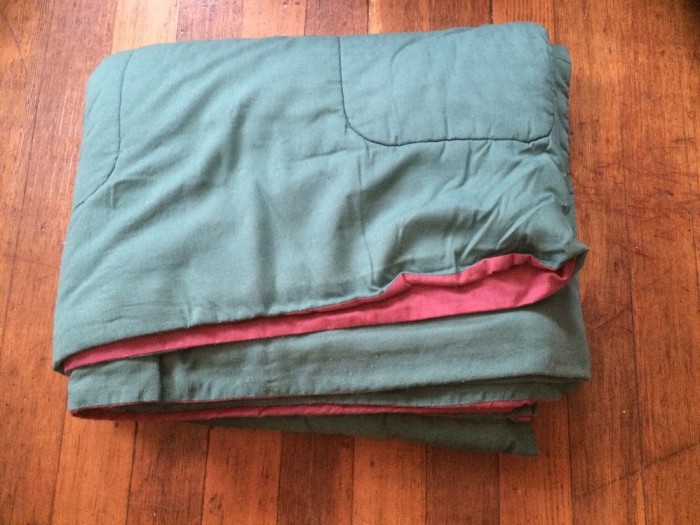 As part of our ongoing effort to perform Spring Cleaning out-of-season, my wife and I have been harassing each other in and effort to open up boxes and look into closets, and reassess our belongings with regard to 2016. In a box beneath our bed that we had not opened in over a year I found this blanket, and for a brief moment I launched into all the reasons why I should keep it. However – and I’m very proud of this, I might add – I shook my head, added it to the Goodwill pile, and since then that pile has remained stagnant in our house, waiting for the day when one of us turns to the other and says, “Seriously, we need to take that shit to Goodwill.”
As part of our ongoing effort to perform Spring Cleaning out-of-season, my wife and I have been harassing each other in and effort to open up boxes and look into closets, and reassess our belongings with regard to 2016. In a box beneath our bed that we had not opened in over a year I found this blanket, and for a brief moment I launched into all the reasons why I should keep it. However – and I’m very proud of this, I might add – I shook my head, added it to the Goodwill pile, and since then that pile has remained stagnant in our house, waiting for the day when one of us turns to the other and says, “Seriously, we need to take that shit to Goodwill.”
Well, at least it is a start.
Even in High School, I was referred to as a pack rat, and this was brought into sharp relief when I was first thrown out in my Senior Year of High School. Not only was it impossible for me to move by myself – I had no car, no truck, no friends with a car or truck, no license to drive, and more stuff than I could fit in a single vehicle anyway, even at 18. While I have had tenures in homes that lasted a decent amount of time – I managed to clock only three years at The Blitzhäus, and kept an apartment in Portland for about the same length of time – between 1993 and 2010, I was never in the same house for very long. Most of my stuff resided in boxes that I would open periodically, remove or add to it, then close it up to store it somewhere again. To this day, in spite of being married and living in a house with a full basement and garage, I still have several of these boxes in storage at my old roommate’s house, and why he hasn’t had them all thrown out yet is a testament to our friendship and my own laziness.
Part of the impulse to keep things came from a collector’s mentality. As a young child, I collected CocaCola paraphernalia, and I still have a few relics from that collection in my toy trunk in the basement. But once I found comics – a hobby that can have pack-ratted-ness at its core – I started to see the value of keeping things to be read and looked back on later. This only amplified when I started making ‘zines; almost anything could be potentially photographed, xeroxed, or re-typed for a future issue, and it was easy enough to say, “I’ll use this someday,” toss it into a box, and never look at it again.
How exactly I came into possession of this blanket is a little lost to the ages. I believe – and I could be very wrong about this – that is was left behind at The Blitzhäus by Captain Morgan, a drinking buddy and carnie who used to make a lot more appearances in our lives, until he fully embraced the carnie life, and hasn’t been seen much since. The Blitzhäus was a huge four bedroom apartment in Eugene that became our party pad between the beginning of 1997 and the Spring of 2000, located above a fancy bar that closed early and never complained about the filth or noise. In the time I managed that apartment, nearly 17 people paid rent, and ever more slept on our floors and couches, staying with us for a few days or weeks or months, depending. The turnover was very high, but the memories were great, and while I would never choose to live in a “punk house” again, I often think fondly of those days.
When I set out to make a life for myself on my own, one of the hardest problems to solve what finding a place to consistently sleep. I had never slept well, even as a kid, but my late teens were full of meeting friends for coffee, and staying up all night to write, so not only was sleep more and more elusive, but the places I would end up sleeping were becoming more and more random. At one point I had a twin mattress (nothing else) that I lugged around when I had a place to put it, and then traded up to a futon which I used for a bit longer. I was gifted two different queen sized mattresses over the years (each of which had seen better days), and then finally, in 2007, I used part of a financial aid check to pick up a bed frame at Ikea.
Blankets and pillows were often a problem. Being a cheapskate and largely poor, I never even bought used stuff, but would occasionally find myself in positions where I had been gifted this or that. Between High School and The Blitzhäus, my bedding was always in flux, but once I found this blanket (and, more importantly, the owner no longer seemed interested in it), I took it to the laundromat, cleaned it, brought it home, and used it until I met my wife. It became the only source of warmth and comfort at night during a period of my life that was at my most lonely.
There is nothing special about this blanket, to be sure. It is thin, and there isn’t much material within it to insulate you. It is just big enough to spread over the area of a queen sized mattress, but isn’t really big enough if you would like to cover both you and a guest. And while I never gave it any thought when it was just the only blanket that I owned, when I see it now, all I can think about is the years that I spent carrying it with me, like some adult version of Linus’ blanket, sometimes the only thing that could keep me warm.
There is no reason for me to keep this; we have a full complement of bedclothes in our house, with extras to spare for when we have guests, and other lap-blankets and warming devices that makes this old and somewhat useless piece of material completely irrelevant. And it is definitely not valuable. If it was, indeed, once something that belonged to Captain Morgan, he never wanted it back, and it can’t be any older than the ’90’s in terms of its “vintage.” And the period of time in which it got the most use was a desolate time, where I was single and miserable, drunk and unhappy about most everything, and would come home from whatever I’d been up to, ragged, beaten, confused, and would crawl beneath that green thing to try and find some sleep – that most elusive of experiences – for a few hours, anyway.
So yes, it goes on the Goodwill pile. I don’t need it. I don’t want it. And I hope that, someday, the memories that flood into me from seeing it will slowly get thinner and thinner from overuse, until I no longer feel the nostalgic warmth they once brought to me. It is time to move on, into a world with heated mattress pads and thick comforters that I can share with my wife.
Yes, I don’t need that blanket anymore. So why is it still in a pile in my house?
 Komodo Fried Chicken Blues * Sufian Abdullah * Music To Break Out of Jail By
Komodo Fried Chicken Blues * Sufian Abdullah * Music To Break Out of Jail By
From Peru we move to Ipoh, Malaysia, and the work of instrumentalist Sufian Abdullah. While the location may change, the story of a lone musician honing his craft for years is universal, and Sufian spent his spare time in Ipoh playing guitar, over and over again, practicing riffs endlessly, perfecting chord changes, mastering solos. Sufian’s story could have happened in any city in the world. The only difference is that modern technology allows us to discover artists like this when, even 10 years ago, we would have never heard of a rock musician from Malaysia. And, in a way, he is merely a voice in a sea of digital albums available across the web, one of hundreds that are all vying for attention and your appreciation. Without having a friend clue me into this record, I probably would never have found it.
Fortunately for me, I did.
Music To Break Out of Jail By is a collection of tunes that are all born out of blues-based rock music. Everything is in that Black Sabbath style vein, with a trace of eastern musicality and form. This western influence on the guitar playing of Sufian is clearly his attempt to break out of the expectation that someone from Malaysia would carry in their musical work. Stuff like the Nirvana cover, “School,” – a droney, extended jam on the riff that veers into doomy territory – illustrates that Sufian is not only skilled, but a connoisseur of guitar, and that includes music from home as well as from all over the world, too. For western audiences, an album like this embodies a similar kind of transition: I recognize the blues progressions, but the format is helping me see this music in a new way that I would have never imagined.
As the story goes, Sufian Abdullah practiced guitar for years at home, playing along to all his favorite punk and metal records. This was mostly a hobby to him, and he took to it like some kids take to video games, relentlessly practicing until he had a huge repertoire of songs he could play upon request. However, it wasn’t until home recording was as easy as getting a laptop with GarageBand on it that Sufian even considered making an album. Made almost entirely by himself, this is a fantastic first effort, and even if this is Abdullah’s only release, it’s a great statement about music in general.
I also enjoy the fact that “Komodo Fried Chicken Blues” contains every imaginable rock and roll cliche in a new and intimidating form, and thus, is perfectly suited for Chickenman.
 Walking The Bridges of Siracusa County.
Walking The Bridges of Siracusa County.
(or, “How I Became A Fan of The Internet Nerd of All Time Without Really Trying, And How You Can, Too.”)
It’s hard to say what I should mention by way of an introduction, to really give you the right kind of background to appreciate his character. Certainly, I would be remiss to leave out his Twitter handle – @siracusa – as that is a primary source of where he communicates with the world and with fans, for sure. Not mentioning his association with the well-loved OS X reviews that used to get nerds in a fervor would be glossing over a huge part of his career, and the fact that he’s hung up his hat as a reviewer is a loss that the Mac Community is still coming to terms with. And, of course he is a programmer by trade, and one of great skill, too. For years now he has supported himself and his family through his work writing code, writing about technology, and podcasting.
Largely, though, John is a geek, and is proud of this fact. He has immersed himself in the world of computers (Macs specifically), and has found a home where he is comfortable, not always easy for the geeky inclined. And yet, while the world of geeks is defined by the technology and the way it is designed and presented to us, Siracusa finds that his immersion within this world makes him the perfect candidate to analyze and define of the problems that nerds go through in a world where software, hardware, and our experiences that go with these things could be so much better designed if someone just took the time to do it.
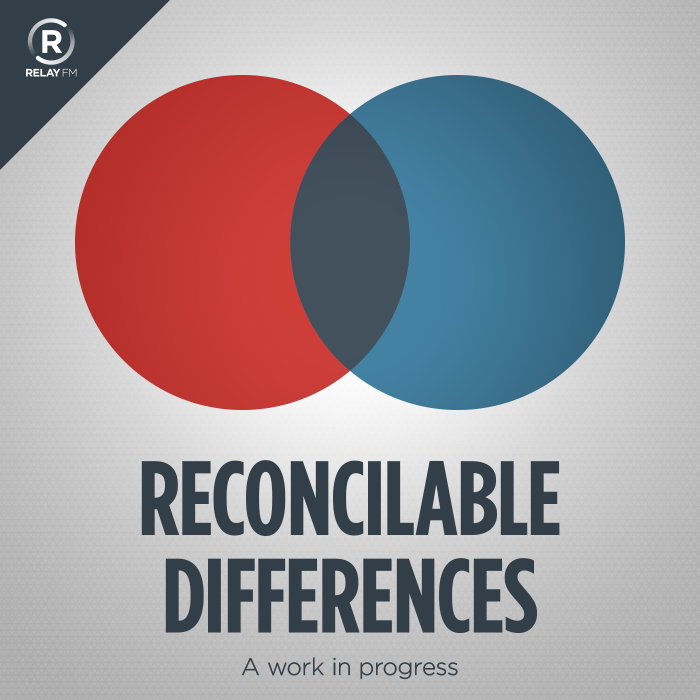 John Siracusa is about as far off the path from my own life as you can get without being a scientist or an astronaut. An East Coaster and fan of TV and Sports, he is the father of two, and by all accounts, a fairly “normal” nerd in a number of ways. Following the show he does with Merlin Mann – Reconcilable Differences, which is a great way to gain insight into both of their lives – you can tell that he is a family man in many ways, who has to deal with the problems of dinner and raising children and getting to work on time. For him, clothing and fashion, music and film must follow very narrow guidelines if they are to make it on his radar, as it is for any other self-respecting nerd. A lover of gangster movies and anime, a gamer and New Yorker by birth, there are only a handful of areas where our mutual interests come into play.
John Siracusa is about as far off the path from my own life as you can get without being a scientist or an astronaut. An East Coaster and fan of TV and Sports, he is the father of two, and by all accounts, a fairly “normal” nerd in a number of ways. Following the show he does with Merlin Mann – Reconcilable Differences, which is a great way to gain insight into both of their lives – you can tell that he is a family man in many ways, who has to deal with the problems of dinner and raising children and getting to work on time. For him, clothing and fashion, music and film must follow very narrow guidelines if they are to make it on his radar, as it is for any other self-respecting nerd. A lover of gangster movies and anime, a gamer and New Yorker by birth, there are only a handful of areas where our mutual interests come into play.
My childless lifestyle, focused on loosing sleep and collecting LPs, seems light-years away from his own, and his confusion about what drugs are and how they work is so cute as to sound like it is a line from a Disney Kids Movie. (And, he’s a U2 fan, for fuck’s sake!) John’s accent, even, spells a very unique venn diagram of Boston and Nerdy that makes my laid-back, West Coast drawl sound absolutely hillbilly by comparison. And, while I understand what computers are and can use them, I can only just barely follow him when it goes on a rant about programming, or game controllers.
This is a long way of saying that I am none of the things that he is. While my own experience with technology goes back to writing in BASIC on a TRS-80, I learned long ago that my interest in the keyboard really ended with the stringing together of English Text, and I didn’t put my time or energy into learning programming and coding, but rather, how to construct a sentence and a paragraph that read well. I could wack at code for hours and get something that might work for a little while (largely by copying and pasting someone elses work), but in spite of that aptitude, I was more interested in building stories. The last thing I made any effort to learn was HTML, and while I’m okay in Visual Basic for writing Macros, I fare much better when the subject is who played in what band. Once I found that calling, I have rarely looked back except to make sure that I’m not such a grandpa that I can’t use modern remote controls or a wireless router.
So what, then, if not a common background or a similarity in interests, draws me to listen to his podcasts? Particularly, the wealth of back-episodes that exists in the form of Hypercritical, a show where he gets into detail about the things wrong with Apple and related topics? It certainly isn’t the current nature of the conversations. While Dan Benjamin – the co-host of Hypercritical with John – makes a fairly good argument that John’s commentary stands up as something worth reviewing at any time, there is something particularly funny about listening to them speculate about what might be in Lion when it is released, then discuss it after it is released, then wonder what the next Pixar movie will be, then discuss it after it is released… there is a rhythm to it that becomes funnier as the years pass, and the specifics are less and less relevant. But that certainly wasn’t what Dan was talking about, when he suggested that there is something to the archival nature of John Siracusa’s work, and there certainly is. There is some other quality to John’s conversations and observations that seems current, even four years after the fact.
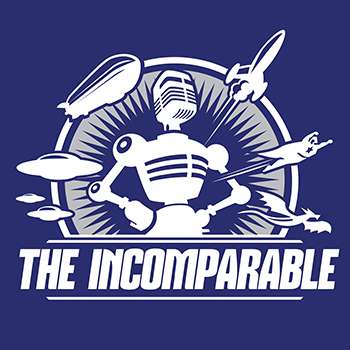 The Incomparable w/ John Siracusa
The Incomparable w/ John Siracusa
It’s probably not that surprising that I discovered all of this through Merlin Mann, and to a second degree, The Incomparable podcast. While I wasn’t really a mover and shaker in the world of the early Interweb, there was a core group of nerds who all got online in the early ’90’s, who have stuck with it for the last 25 years, to see it develop and blossom into the racisim-laced comment threads that we see so much of on YouTube. A lot of those same nerds have helped build the digital media landscape into what it is today, through writing, blogging, and building websites of every variety. Many of those early nerds joined forces over at Jason Snell’s The Incomparable, something that began as a book-club and evolved into the media empire it is. Nearly every guest on The Incomparable is part of this core family of early web icons, and Merlin Mann – who I was already a fan of – led me to them.
(How exactly I found Back To Work is sort of lost to the ages, but it was one of those shows that, when I found it almost two years or so ago, I instantly over-dosed on it, and began to trace all the threads that it sent out into other areas of the web. If Merlin wanted to be a guest on The Incomparable, and played in their world too, I reasoned – correctly – that I should be checking out that show, too.)
John’s role on The Incomparable is not much different than on his own show. He’s finds flaws and pokes holes in the world of pop culture as much as he does with Apple and their mixed bag of products and apps. He is the grumpy old man who sits in on these conversations and waits for a chance to offload his argument, his observations, and his criticisms to a group of nerds who just wanted to say how much they loved Real Genius. For him, it is important to use reason and the clues in the works at hand to find the real meaning and value of a work – be it in software, film, or books – and his willingness to make the unpopular point, and to say things that lay bare the design flaws of things we all love, is not only important, but necessary in our culture.
Too often we get caught up in the enthusiasm machine of marketing and rumor. We are often left to consider that we should always accept the things we encounter as having some value in our lives, merely because they are the overwhelmingly popular thing at the time. Apple is a perfect example; the devotees will devour anything as early as possible, but to criticism the design at any level would sound like you’re being a dick.
But there is a value to looking at culture and being critical, and not just because it is easier to distrust and to poke holes in things. Both John and I want culture to be great. We want to enjoy art and music and digital media and have it presented to us in a way that is good, and good for us. John’s desire to find the flaws, to point them out, and to offer insight into why they worked and why they did not, is a lesson we can all learn in life. It is easy to accept everything, and a tiny bit harder to be critical of all things equally. But to take it a step further, and to be critical while offering helpful advice and insight into why that aspect of the work is not functioning properly, that is a skill that takes all of us further in life, and not just at work or in public.
 A Look Back At The Recent Past
A Look Back At The Recent Past
While I’m enjoying the chance to relive 2011 and 2012 through the magic of podcasts that will live forever on the web, I will warn people that it can be trying to listen to five-year-old stale tech news programs if you are not there for something other than the timeliness. And he does cover a lot of topics on Hypercritical that were valuable then and seem irrelevant now. (Do people care about iBooks anymore? El Capitan more or less makes much of the previous OS X conversations seem antiquated and silly, certainly. And his deconstruction and analysis of programming languages then could probably use an update.)
But even when the topics are not on point, listening to him lay out an argument is a joy to listen to. At several points in the series he gets preachy about Star Wars preservation, and lays out arguments for Fair Use and curating cultural materials for future generations that is simply incredible, and in many ways, still ahead of its time. His ability to looks at software and provide a meta-analysis of its merits and weaknesses is something that is straight out of a literary criticism course, and his no-nonsense attitude (and his absolute, self-admitted lack of cool) makes him willing to say things that others simply won’t. And that, in many ways, is absolutely charming.
He is not offensive. As a father is is looking for culture that uplifts boys and girls too, and he really does want the world to be as well designed as possible for those of us who have to use it. But his eye for films like Goodfellas and Ghost In The Shell gives me pause to consider watching something that I had decided long ago was not for me. While I don’t always agree with him – and, how can anyone always agree with anyone, to be perfectly honest? – his willingness to look at our culture, and to champion where we can make improvements, is absolutely inspirational, and keeps me glued to my podcasts so I can hear another one of his in-depth deconstructions of a book he absolutely hated. (Ready Player One, anyone?)
He is not for everyone. He is certainly an acquired taste, and might not ever be exactly for you. And I even tune out when the tech talk gets a little over my head. (And it does often.) But this kind of show is a challenge to my preconceived notions of what entertainment is, and what it can be, and what perspectives I should be considering when I see something new. I’m getting to view parts of culture through his eyes that I would never look at – and a few things that we both find entertaining, too – and that is giving me pause to re-evaluate my own relationship with parts of culture that I usually never consider. That alone is enough to recommend him for someone who is looking to challenge your own perspectives, and to consider that the world around us is made up of people that thinking differently than I do.
So… Where Do I Start?
So often with these kinds of recommendations, it is hard to give someone a jumping on point. The Incomparable is still running strong, several years and hundreds of episodes deep, and he appears in many of them. Obviously, his current show with Merlin is great, and not only get into the elements that make geeks geeks, but the struggles they have in their own lives with travel, with buying things, witch child rearing, etc. It is exactly what middle aged men love to do – talk about the minutia of life as if it were something of great academic import – and it makes for great listening if you happen to be self-reflective (and middle aged).
However, to get a sense of what I’m really talking about, and to offer something to dig into that is current, I recommend checking out Incomparable #277: Stormtroopers Are People. (You can stream or download it form that link.) This is a THREE HOUR AND TWENTY MINUTE podcast (yes, that is not a typeo) about The Force Awakens, and in it you can hear Siracusa get so excited about this film that even that amount of time seems short for both him and the listener. (John, Jason Snell, Serenity Caldwell & Dan Moren also appear on the panel discussion, all equally excited about this movie.)
I know, I know. I am recommending a three hour commitment so that you can decide if you like a guy who makes a lot of podcasts, and this isn’t even his primary piece of work. But in this three hours you will hear real people who love real things, talk about the way that they love it, and explicate on a story that – hopefully – you also happen to love. (And who doesn’t? I mean, The Force Awakens was fantastic, wasn’t it?) And in this show, you will hear John talk passionately, as a Star Wars fan from childhood, as a person who felt abused and robbed by the CGI Special Editions, as a person who felt betrayed and ripped off by the prequels – and, most importantly, as a human being who was so touched by a movie that he was willing to talk well into the night – for hours – and was still excited to keep talking when everyone else is ready to hang up and get some sleep.
If this does not win you over as a fan of John Siracusa, then I don’t know what will. But I have a feeling you might start listening to The Incomparable now. And that is how all things like this begin.
Let me know when you get a chance to check out his other work, too. And when you are a converted fan like I am, hit me up on Skype. I have a feeling we have a few things that we could talk about, too.
 Time
Time
Is marching on
And time
Is still marching on
*
The old adage that you become wiser as you get older has, so far, proved to be absolute crap as I have watched my own odometer turn over. I have met a wide range of people in my life, many of which were older than I, and most of which were no more skilled or able to make sense of this world (or any other) than I have been able to on my own. More pointedly, the desire to gain wisdom needs to be present first, before anyone of any age can make heads or tails of it. Like with self-help, religion, exercise, or really anything worth a crap, you have to want it to get there first, you have to want to take action in order make it happen, and when you stop moving in that direction, you stop making any kind of progress toward wisdom. You can’t get there without trying.
I remember as a child thinking that people older than me had insight or knowledge that could be useful to me, and for many years that was true. But by the time High School rolled around, I started to notice my teachers began to make stuff up if they didn’t actually know, and would stutter and fumble with ideas and thoughts almost as often as I did. They were capable of as much pettiness and poor judgement as any teenager I had every met, and I started to suspect that they had no insight that I didn’t have myself. My theory was that they had all stopped trying to make sense of the world, assuming they had as much as they already needed. In the years that followed High School, I distrusted anyone who acted older, and made a point of illustrating that they are no different or more informed than I could be after a trip to the library.
Now that I have passed 40, I not only feel certain that I was right then, but the evidence at hand points to the same kind of self-help axiom I’ve always struggled with: you have to want something to get something. Because, essentially, that is the case for anyone who hasn’t tried to pick a direction for themselves and pursue it. That component of reaching out for something that you want – again: personal improvement, a new faith or belief in something, a goal or desire that you will not let yourself live without – if you can’t be bothered to even want it or find out if you do want it badly enough, then you will have no idea what you are doing and why you are doing it. This happens to be the case with most people – young or old – and is the state of being most people prefer to adopt because it is easy.
But what do I do with this revelation? This is the problem that I have encountered in the mental exercise of working out how you communicate this information downstream. At 17, what would have resonated with me that would have opened my eyes? How could anyone have taught me that I need to chase my desires with confidence, that I need to outline what I want and take physical actions to achieve my goals. How do you make that clear to a teenager who is convinced that everything is unfair, and stacked against him? It’s a hard nut to crack. My natural state as a youth was to feel put-upon, to feel abused, to feel distrust toward the world around me, and to feel that the only place I was understood was in music and books of my choosing. Short of taking me to a $5 show where all the bands I like had written ‘zines about how you need to set desire-based goals and pursue them, how would I have ever made this observation at that age? Is is even possible?
A lot of this has to do with confidence, something that I have never been good at and felt little reason to carry as a defining trait. I was not confident. Until I met my wife, I was pretty sure I would be doomed to having short and largely meaningless relationships, and only in the years since we have met, fell in love, and got married do I feel the kind of confidence that I longed for a needed as a teen. But how do you imbue confidence to the awkward and uncomfortable, without the years of experience that created it in me? I still feel this overwhelming panic that my wife will leave me at any moment, and for any reason, and this hyper-vigilance regarding this thought tends to color my every action, even when I know in my heart that this won’t happen. I want her in my life, but the nearly 25 years of experience prior to meeting her has trained me to think that everyone leaves. Even at 40, I don’t have the confidence I’d like to have.
If learning confidence is complicated, developing sophistication is even more challenging. I value my ability to think critically, to hold two thoughts in my mind at once, to consider new ideas and to abandon old ones that no longer work. This is something I wish I had at my disposal as a teen, because in those days, I clung to the one idea I liked with a virulent fervency that bordered on being unhinged. I was convinced that everyone’s ideals never wavered their entire life, that you would always cling to these powerful thoughts of “right” and “wrong,” and that these notions would guide you as you move forward in life. But as you move out into the world, and meet more and more people who challenge you and your ideas, your own level of sophistication begins to increase dramatically. Punk Rock is not the only kind of interesting (or valid) music being made (in spite of a comment to that effect that I might have made as a teen), and the greatest movie of all time is not Pump Up The Volume. (Though that movie is quite excellent, nonetheless, there are much more interesting movies that I’ve come to love more.)
Sophistication allows us to recognize when something is of high quality, even if we don’t like it ourselves. Sophistication suggests that there are more ideas in the world than our own, and that the exploration of them – and the discarding of things that are insane or poorly developed – is a healthy part of interacting with the world around us. We need confidence, to become fully realized people who feel they have purpose and direction, and we need sophistication so we can make sense of other people who are different from us without resorting to racist, sexist, or other exclusionist kinds of behaviors when we meet them.
So: how do you teach a teenager, who is still more excited about video games and exploring their own body and ignoring the entirety of the world that is outside of their peer group, how do you convey the value of analytical thought and personal self-worth? To a teenager, everything is emotion and frenzied thought, barreling through life with a pulsing pleasure center between their legs, an uncomfortable body still growing into maturity, and a huge set of social rules and axioms that dictate how you should be acting. Even the idea of embodying confidence and sophistication is outside of everything a teenager experiences, save for the few that have extreme skill in one area or who have been forced to grow up quickly.
I’ve wrestled with this for a while, but I have no real insight into how to help out my past-self, or even the current crop of youth that are coming to terms with unfairness and adolescence here and now. Being young is hard, and only as I am starting to consider the second half of my life do I feel as if I’m starting to get a sense of how I should have gone about things then. It isn’t that I have a secret that I can share with kids that will even be helpful, any really they must experience this for themselves for it to really hit home. But if anyone younger (or, perhaps, older who still isn’t sure) happens across this and might want to distill my thoughts into something they can use in a practical sense, here are a few thoughts to consider as you try and deal with the universe around you:
*
1.) Nobody Else Knows What You Need. Only you can make that call. Only you know what your dreams and goals are, what your hopes and desires might look like, and what will keep you motivated to live the way you want to. Describe what you want to yourself, make it as clear as possible, and be willing to do this as many times as you need until you think you’re on the right path. You don’t have to share it with anyone unless you want to, but you should ask yourself regularly, “What do I need? What do I want? Can I define it?”
2.) Most Everyone Else Doesn’t Know What’s Going On. They may say they are adults, they may point to more education or experience, they may think they are genuine authority figures, and they may claim that they know better. But they don’t. They never did, and they are faking it if they say they do. They don’t know what your life is like, they don’t know what you’re after and what is important to you, and they probably never will if they haven’t defined what they want in their own lives, too. Be patient with them. Try to understand that they are clueless, and don’t take the things they say as “truth” or “valid” unless you happen to agree. When they are ready to see the world from your eyes, then you will be able to have a valuable conversation (for both of you). Until then: be patient. They mean well, but they don’t know any better.
3.) Try Not To Be A Dick. This is really the only rule in life that I have to say is 100% worth following, even if you don’t believe it or see the value in it at first. This won’t stop others from being a dick. You might even be a dick occasionally, and that is okay too. We all make mistakes. But try not to be. Imagine someone else acting the way you are acting, and see how that feels for a while before you do it yourself. None of us are always successful, and that’s okay. We can forgive you if you are trying. But please try. It is easy to be a dick, and you might even get somewhere at first by being one. But once you start acting like that often, you will find that it becomes a lot harder to stop. Act the way you want to be remembered, not the way you think will yield the biggest result immediately.
4.) Be Willing To Be Wrong. We learn from our mistakes, honestly. It seems counter-intuitive, but as I get older I see it in action every single day. A mistake might seem bad at first, and can be awful depending on the kind of mistake. (And I’ve made plenty of them, for sure.) But you will not be the first person to make a mistake, and you will not be the last, either. I have changed my mind hundreds of times, I have been wrong more times than I can count, and I will continue to make mistakes and be wrong for most of my life, not because I’m trying to make mistakes, but because I only learn the right way after I have exhausted all the wrong ways around me. Be willing to fuck up. But also be willing to learn from that experience.
5.) Don’t Be Afraid To Be Childish If You Want To Be. There is a race in this world to grow up, to put away the interests of your youth and to “embrace” the world of adulthood as soon as possible. This is absolutely insane, because these same people eventually get older and insist that adults should, “never grow up,” and that the way kids see things is precious and valuable. Clearly, they want kids to act like adults, so the old people can act like kids. Don’t listen to them, and pursue your interests, even if they are childish. If you like cartoons, watch cartoons. I do, and I love them. If you want to color, color every day. My wife has coloring books that she loves and uses often. My passions as a kid – computers, comics, writing – these are things that have been lifetime companions for me, both as a child and as an adult, and they have made me happy throughout my life, in spite of what adults told me when I was younger. There is no “one time” when you should act a certain way, and when people start telling you otherwise, you don’t have to listen.
*
And, it is also likely that I don’t know what I’m talking about, so you don’t really have to listen to this advice at all. Maybe you shouldn’t, at first. Maybe you need to learn these on your own. But maybe it is helpful. Maybe you already know it, and maybe you think I’m full of shit and will never understand you. All three are probably true, for some of you anyway. But these are the things I wish I had heard in High School, and more importantly, things I wish I had believed then, too.
Getting older can be awful. There are times when you want to give up being responsible, give up acting the way everyone says you need to, and you will long to give up adulthood and move on to something more fulfilling.
What I’m saying is: you can do this at any age. But only if you want to.
 A Day In Aleph [1]
A Day In Aleph [1]
Jordan finally pulled himself out of his reverie, and went to the back of his house, where his kitchen was. There was a sizable pile of dirty dishes in the sink, and the quality of the plates and mugs seemed to extend to the kitchen as a whole, creating an oppressive atmosphere. Jordan sighed and turned on the radio, and slowly began to busy himself as sound filled the air around him.
He found the largest pot he owned, and used the spray hose to fill it with warm water. Jordan had to grab and squeeze two empty bottles before he was successfully able to add some soap, and then let the pot continue to fill. In the air, a caller asked if there were warning signs that a parent could use to diagnose mental illness. Four experts all gave different answers.
Jordan hated doing dishes. He used to claim it was genetic, but his friends knew differently having met his brother and sister. Not that it changed anything for him; as far back as he could remember, he hated doing dishes, and had assumed that his parents did too, since he was often given the chore. Jordan turned off the hose and began to rearrange the contents of the sink, trying to make a plan of attack. Even though he lived alone, he briefly wondered if anyone would get on his case, or try to step in and show him how to do it correctly.
This rarely happened anymore.
A new caller asked about how We can promote green practices, not just in our homes, but our communities. Jordan laughed to himself, imagining the dialog to be about dope instead.
There was a particular case he remembered, perhaps one of the first times he ever had to wash the dishes. Even he had been surprised at how quickly the chore was finished, and before long he was back in the living room, wondering if Duncan & Orko were going to make another appearance.
Then: “Jordan, come here.”
Where had he heard that before? It sounded so incredibly familiar.
Jordan came into his parents’ kitchen, all of eight years old. The cabinets towered over him. His stuffed bear, Buffalo, nearly dwarfed him as he trundled along. The smooth, vinyl floor stretched out in front of him like a football field, expansive and grid-like, where any number of games could be entertained, provided the adults weren’t around. In front of the sink, next to the Formica counter, stood his father and the stool that he’d left behind.
“Get up here, you’re not done yet.” Déjà vu.
As he began to work on his own sink, he could picture his childhood kitchen perfectly. As he would run a sponge through the handle of a mug, his own father, years ago, repeated the exact same motions, teaching, explaining. No matter how differently he tried to clean his dishes in the present, his father in the past matches his every movement.
“Jordan, come here.”
Jordan turned around, with a spatula in one hand, a young man in a uniform, to see his boss – or was it his father again? – standing next to the industrial sized sink that loomed against the entire back wall of the kitchen. In comparison, his boss looked miniscule, pathetic. The enormous mat on the ground, pock-marked with the remains of food within it’s mesh, enveloped him with an oppressive sensation that seemed much more current than the job he once held, 15 years ago.
“Get over here, you’re not done yet.”
As he approached the sink, the kitchen seemed to grow, making each step toward it seem like a mile as the work ahead of him seemed to instantly fill up the rest of his shift, his week, his life. The murky water swirled in his father’s, his boss’, and now his own sink, a dark whirlpool of soap and filth, past and future, water and air, pulling Jordan in like a hole in space and time.
Uncanny. As Jordan gathered the silverware from his own sink, he vividly saw himself do the same from his father’s sink, from his boss’ sink, from sinks familiar and unfamiliar. “Jordan, come here.” Was that his friend Devin, who needed some help in the kitchen after a party? Maybe Martha, who was tired of him playing Civilization, and wanted him to clean up in their first apartment. The callers disappeared from the air, to be replaced by a physicist talking about string theory.
He began to cry silently. “You’re not done yet.” He looked at his own sink, and no, he wasn’t. Tears began to splash onto the food still stained on his plates and spoons.
How many times had he been shown how to wash dishes? How many times has he stared at the water, and felt overwhelmed by the work ahead of him? How many times have people that loomed so large in his life made him feel useless in front of a sink? His apartment was only big enough for himself, but his kitchen seemed crowded now with ghosts of the past and present.
Jordan, come here. Who said that? Or rather, why is it always being said at all? Being alone was supposed to be the ultimate reprieve from the daily chores that fill up our lives. When you only have to impress yourself, there’s no reason to make the bed, sweep the floor, or scrub the windows if you don’t want to. And yet the impression that’s been made over time fills him with constant guilt. You’re not done yet. He cannot escape it, no matter what town he moves to, or how many years pass between then and now. There will always be one more load of laundry, one more box of recycling to sort, and more dishes to wash. The drying rack will always be ready to receive the next communion saucer.
Jordan continued to wash his dishes with his own tears, and began to pull taught the thread that ran through his entire life. It connects his past to his future, and ran through him completely, filling him with the anxiety that there will always be another load to finish, and someone else not completely happy with his work. Every point along the thread came into focus as he moved through the contents of his own sink and as he sat there, overwhelmed by the cumulative effect flooding through him at that moment, as the air around him filled with abstract explanations that did nothing for him spiritually, he let out a long, sputtering exhalation, punctuated by the fury of his eyes and nose that were now working overtime to make sense of his inner turmoil.
He moved, imperceptibly forward along the thread, and soon 20 minutes had passed, and he was finished. He turned the radio off, left the room, and went to his bathroom to clean himself up. He reached for a towel, wiped off the water now on his face, and locked eyes with himself.
“You’re not done yet,” he said.
[1] Suds & Scrubs, Dishwasher Pete!
(This podcast and essay was originally posted on 21 January 2013. At the time, I worked for Portland State University, and got MLK Day paid off.)

I’ve Been to the Bemsha Mountaintop
(Featuring an audio-essay cut-up of Martin Luther King Jr.‘s last speech delivered to an audience, “I’ve Been to the Mountaintop” from 3 April 1968.)
I have always taken for granted the holiday that we take in January to honor Martin Luther King Jr. It was not that I didn’t care, but that the day usually came when papers were due, or when I worked a job that already required me to work that day. But in light of my new job, getting the day off – paid – felt a little weird. I had to be honest with myself that I had never really listened to any of MLK’s speeches all the way through, and that I knew very little about the work he did other than the most general, basic sense.
So today’s radio blast is a bunch of stuff culled from my collection of audio that relates to MLK Jr. I have an edited cut-up of his last speech, and a radio broadcast from just after his assassination, as a way of presenting some of what I discovered in actually doing some research of this amazing and incredible man.
I do not have any great epiphanies to share with you, and there is no great revelation at work in this show. It seems very clear that, as he delivered this speech, he knew his days were numbered, but this seems to be the case leading up to his assassination. I think the arrangement in this little mini-cast works to reveal why he was considered to be one of the best orators of our day, but also to illuminate much of what his work was about in the most basic and general sense possible.
For those who stay to the end: there’s a little joke to ease the tension of such a serious subject.
I urge all of you to listen to his speeches, read up on this man, and let yourself actually understand the value of this holiday. So much of what happens to us seems so passive, and we let days pass without reflecting on them too often. This time, stop for a moment to consider who this man was, and what effect he had on the world around us.
And: let’s hope you MLK Day was full of the promise and wonder that every new days brings us.
Be seeing you
*
I’ve Been to the Bemsha Mountaintop
01.) (What Did I Do To Be So) Black & Blue [Excerpt] * Louis Armstrong * Say It Loud: Celebrate Black History Month & Martin Luther King Jr. Day.
02.) “I’ve Been to the Mountaintop” [Excerpts] * Martin Luther King Jr. * 3 April 1968
02.) Bemsha Swing * Thelonious Monk * Say It Loud: Celebrate Black History Month & Martin Luther King Jr. Day.
03.) Martin Luther King Jr. Assassinated * Bill Kurtis * We Interrupt This Broadcast * 4 April 1968
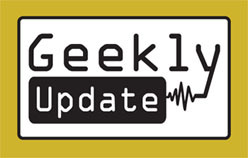 Every Sunday at 2 PM on KMUZ.
Every Sunday at 2 PM on KMUZ.
One of the first things I searched for when my wife and I hit upon the idea of moving to Salem was local radio, and I remember in those early days when I found KMUZ online. It took a while for us to get our marriage and our life in Salem sorted out, and thus my involvement with KMUZ has been only a recent development. I haven’t done a whole lot of mentioning of it (save for a passing reference in the last NewsZine), as I’m still the low guy on the totem pole, but I have been recently adopted by the team at Geekly Update, and have appeared on two recent episodes.
For those who haven’t listened yet, Geekly Update is a panel / talk show format program where guests and hosts talk about all of the topics-de-jour that are of interest to the nerdy and nerdy-adjacent. Comics, novels, movies, TV, music, and anything that comes close to something you would find in your comic collecting friend’s house is covered on the show, and they’ve been going strong for a while. Jason Ramey & David Duncan are the primary hosts, and run the show on alternating weeks. The guests vary from week to week, but some recurring characters appear every week.
I will be archiving my appearances on this program over at AnywhereAnywhen.com, using my newly minted Geekly Update Feed. In an episode from 27 December 2015, we gave an overview of the things we enjoyed from 2015. In an episode from 3 January 2016, we talked about various pieces of culture and whatnot that we are looking forward to in the coming year. (I had to phone in for the second show, as the roads were too icy for us to drive in for the show that day.) I should mention that there was no show on the 10th due to host illness, but I will be back on the 17th, certainly, and hopefully Jason won’t still be sick.
I have been wanting to launch a talk show of my own for some time, and some out there may remember the original incarnation of A Momentary Lapse of Reason was focused on talk. (That is, until Miss Rikki & I turned the show into a collage-based sort of dadaist presentation.) But even that show was not going to have the kind of spirited conversation that we’ve had on these shows. Plus, the subject matter is something that I’m passionate about, but don’t really have an outlet for at the time. As someone with thousands of comics in my basement, I feel bad that I never address that part of my life. Hopefully now I can.
So, make sure to tune in on Sundays, at 2 PM. It’s a good time to listen live, and there will be a podcast either later that day, or by Monday at the latest. Geekly Update. It’s something new I’m involved in, and I’d love it if you listen.
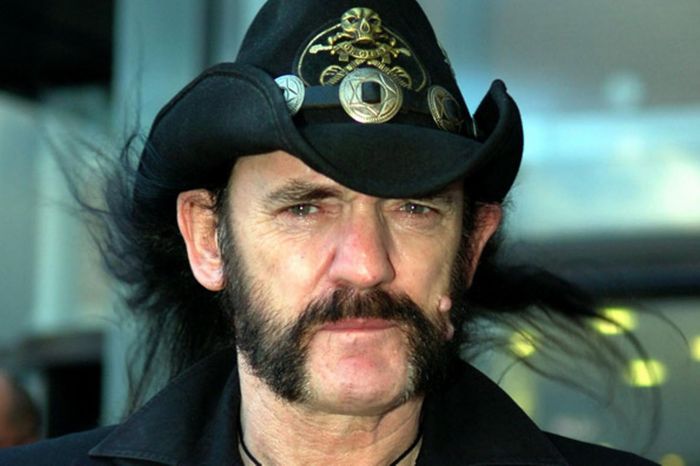 It isn’t that I want to be the flea on a house cat, or just to be contrary, but there’s always such a mixed bag of emotions when someone well-known passes away. I was absolutely broken the day Leonard Nimoy passed away, but found myself at peace when Lemmy’s death was announced. (Probably because I had seen Motorhead live four times, and felt lucky to have done so.) I remember spending hours watching Nirvana videos the day Cobain killed himself, crying and maudlin over someone I never met, but was almost filled with glee when I heard about Jerry Garcia passing, and actually celebrated when Ronald Regan finally died. We all have our own group of myth-makers that we respond to, and my love of Captain Beefheart can’t measure up to that of Robin Williams, no matter what the Inter-Web-A-Tron thinks I should feel that particular day.
It isn’t that I want to be the flea on a house cat, or just to be contrary, but there’s always such a mixed bag of emotions when someone well-known passes away. I was absolutely broken the day Leonard Nimoy passed away, but found myself at peace when Lemmy’s death was announced. (Probably because I had seen Motorhead live four times, and felt lucky to have done so.) I remember spending hours watching Nirvana videos the day Cobain killed himself, crying and maudlin over someone I never met, but was almost filled with glee when I heard about Jerry Garcia passing, and actually celebrated when Ronald Regan finally died. We all have our own group of myth-makers that we respond to, and my love of Captain Beefheart can’t measure up to that of Robin Williams, no matter what the Inter-Web-A-Tron thinks I should feel that particular day.
It isn’t that I don’t like David Bowie. I have a few albums, and there’s some songs of which I’m certainly a fan. He was interesting, too, a character that was looking to create a certain kind of art, not necessarily art that was popular at the time, either. He looked how he wanted to, acted how he wanted to, made music that reached and affected a lot of people, and made a huge impact. I don’t want to deny any of that, or talk shit about him. He was who he was. He just wasn’t my favorite artist in the world.
And, even worse, not even the first well-known person to have died on January 10th of 2016. A well known mathematician, two well known dutch sculptors (the other one is here), a well known writer, two additional musicians (American & Venezuelan), a LGBT activist, a footballer, a journalist, a politician, a businessman & an Australian yachtsman all died on the same day, and a few of them also went to cancer, too. And that doesn’t even account for the scores of others that have already died in 2016. Wikipedia’s Lists of deaths by year is quite eye-opening, and while that doesn’t mean that Bowie’s death isn’t a loss, or isn’t tragic, it is strange to consider all the other’s that are not being remembered as part of this event.
Humanity has never really done well when we try to cope with death. The best we can do is invent an afterlife of some kind, speak to them as if they are still alive, and postpone the actual grieving until we are faced with the fact that this person really is lost, that they really are gone, that they are never coming back. Sometimes we can process these kinds of events in real time. But death is almost always sudden. I didn’t go to bed on the 9th with any kind of preparation that I would wake up in a world without Bowie. None of us did. But it has happened, and we must learn to find a way to deal.
In a way, celebrity deaths are how we come to cope with the fact that humanity is dying. The thought that there will never be any more Motorhead shows is a big thing to process, and it stands in for the fact that everything ends, eventually. There was a time when there were never going to be any more Beatles, or Elvis, or Django Reinhardt, or Mozart. But life continues. Bowie has now been relegated to “old” culture status, and we will only now be able to live in a world that has lost that, and hundred and thousands of those who came before us. Learning to live without new music is a bit like having to come to terms with Grandma dying, or the city we grew up in changing dramatically.
Yes, it is sad we lost him. It is sad we lost everyone. We should be mourning the loss of people, of those who were not famous but touched our lives anyway. We should be learning to come to terms with everything that we might not ever see again, and not just new albums buy a guy who had done the bulk of his best work a few decades ago. This should be an example of the amazing things that we have in front of us, and not a chance to dwell on the great things we used to have, that are completely gone now.
Nostalgia is great. But it is too easy to feel steeped in it, to let it overwhelm us as we realize the thing we love is gone now, or different. But celebrities will live on in our memory longer than our friends, or neighbors will, and rarely do we celebrate them with the same kind of grandiosity of a passed superstar.
No one will ever forget Bowie. Who will remember everyone else that died that day?

In the spirit of newness and change, I’ve decided that it is time to shake up the presentation here on the blog. There are have been a number of ways this interface has taken shape over the years, and when I first started making websites and posting material to the Inter-Web-A-Tron in the ’90’s, I had a number of ideas about what I wanted to post. The frequency of those posts, and the presentation of them has changed dramatically since then, but I’ve done my best to hit upon themes that I’ve always felt strongly about. Often those themes involve art and girls, but that’s true of almost every person who has ever been attracted to either.
The most recent incarnation of this blog – and within that, the most recent reboot of it last year – has been an excellent place to post things that are in-progress, or half-formed, as a means of chewing over ideas that I know I want to see go further. When I first launched a proper blog, just after moving to Portland in 2000-ish (which I’m trying to unearth for the anthropological exercise of it all), my first thought was that the Inter-Web made it possible to have more immediate discourse, or at least, more immediate than the letters I was getting from ‘zines. I still stand by that idea, and I post to the web largely with the notion that all of this is a draft, that it might be revised and re-written before it finds a final home. Text, as any writer knows, is always a living document, and even after they are printed, there is an urge to revise.
The idea to go to five days a week was, of course, fairly bold. That’s a lot of writing, especially if I don’t want most of it to be filler, and especially considering the unforgiving environment that a large part of the web has become. Fortunately for me, I have gone largely un-harassed during my tenure as a denizen of this electronic republic, which either means that I am so uncontroversial as to be worth little regard, or that the offensive things I have said have been met with an eerie kind of agreement by the public at large. It would be ridiculous for me to assume that I have enough notoriety to warrant an enemy or two, but having been online since the ’90’s, I’m shocked that I haven’t found some truly horrible examples of humanity who have wanted to fuck with me for the fun of it.
The idea to have one day a week dedicated to video posts seemed like a cheat that could easily be forgiven, so long as the videos were actually good. (And I’ve been largely successful in that area, I believe.) Giving over another day a week to index cards was certainly a bit of a gamble, as I hadn’t really seen that being done anywhere else, and I wasn’t sure if it was even something people liked. It was a new way of approaching writing, and seemed like something that could be a huge flop if not done right. But like Twitter, the restriction is actually a nice way to force yourself to try new things, and hitting the right length to perfectly fill an index card is a bit of an artform. I’m glad that I’ve gotten some positive responses on them, because I’ve come to really enjoy making them.
(I would like to make a small digression here, and mention that I entirely owe my interest in index cards – and the idea to use it as a springboard for my own writing – was at the suggestion and inspiration offered by Merlin Mann on his show Back To Work. I sort of used index cards in College, to keep track of assignments, but never used them as a way to stimulate writing, or as a means of capture. But Merlin’s observation of the index card as ultimately disposable was something that really stuck with me. Often, we are too precious about our own writing, and we treat each new notebook as a place where treasured and important ideas will live. But there is a need for a place to put ideas that just need to get out, and might not really need to live beyond that. Incorporating index cards into the way that I collect ideas and focus my own writing has been a huge breakthrough for me, and I owe that to Merlin and his suggestions on that program. He does a wide range of other work – including a fair amount of comedy that is priceless – and I recommend checking him out if you are remotely interested in writing, art, comedy, and enjoying life.)
Having accounted for two of the five days each week, I was confident that I could continue to post three new written items every week, and have them not be a rip off. But for some reason, I structured the week in a way where Monday led with a video & Friday closed with an index card, and the good stuff was in the middle. While that idea wasn’t bad, a lot of people pointed out that Fridays are low-traffic for all sites, and Monday is always the strongest. When I started looking at user engagement with our site’s built in tracking tools, this confirmed that observation. Monday was our biggest day, and it had the least to offer readers, every week.
So, we’re going to move the videos to Fridays. This makes more sense to me. You’re only putting in a half-day on Fridays anyway, you already ducked out early with the guys in the other quad for a “lunch” around ten, and you’re just killing time until your boss leaves so you can get out of there. So a video is closer to the amount of time you have at your disposal, and we get it. To accommodate this, we’re sliding everything up a day, putting our index cards out on Thursdays now.
We’re going to try this for a bit and see where it goes. Again, I’m not entirely sure if it’ll stay like this, but if history has taught me anything, it’s that we can change the way we structure this site at least four more times this year and it still will not account for the total number of changes that I will not be able to predict coming. So, we’ll try it this way for a while.
And we’ll see what happens. I invite your feedback, please.
12.) The Down Home Boys / Original Stack O’ Lee Blues * Little Harvey Hull / Long “Cleve” Reed * The Stuff That Dreams Are Made Of
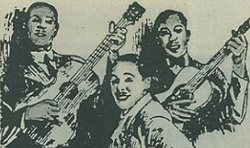 Along with lone mavericks like Lee de Forest and his friends were collectors, people who spent their time reading about and purchasing rare records. For these folks, a unknown 78 was just as important as the legendary statue that Bogart was talking about when he uttered the phrase that became title of this compilation. But there’s an irony to its use in the movie that the people behind this compilation probably shouldn’t have allowed to be associated with their album: the falcon, of course, was a fake, and Sam Spade delivered the line ironically when a cop asked what the fake statue was all about.
Along with lone mavericks like Lee de Forest and his friends were collectors, people who spent their time reading about and purchasing rare records. For these folks, a unknown 78 was just as important as the legendary statue that Bogart was talking about when he uttered the phrase that became title of this compilation. But there’s an irony to its use in the movie that the people behind this compilation probably shouldn’t have allowed to be associated with their album: the falcon, of course, was a fake, and Sam Spade delivered the line ironically when a cop asked what the fake statue was all about.
The plot thickens, as The Stuff That Dreams Are Made Of claims to contain “previously unissued” recordings of music from the 20s and 30s, an allegation that ironically didn’t pan out too well for Yazoo Records in the long run, though in the wake of O Brother Where Art Thou? becoming a global phenomenon, netted them a few dollars. While the pairing of R. Crumb artwork with Richard Nevins liner notes is supposed to drive home the authenticity of these songs, among collectors it is clear that a few of these cuts have made their way to the public before, and perhaps only a handful were “unissued” in any meaningful sense of that word. The claim that some are mastered from unheard test pressings seems, at this late date, to be incredibly unlikely, but nonetheless, The Stuff that Dreams Are Made Of persists as a collection for beginners.
Keep in mind, this was 2006, and the Inter-Web-A-Tron wasn’t as comprehensive as it has become. Old Timey Music was starting to become incredibly popular among the NPR crowd, no longer the realm of people who lived and breathed these recordings. But for new fans, you couldn’t just Lycos “Little Harvey Hull” any easier than you can now, and even still, the information is spotty. Without the deep knowledge of these collectors helping guide you in this largely forgotten world, it is easy enough to end up like Kasper Gutman and Wilmer, tricked by something that looks and sounds like the original, but is not. This does not mean that the fake has no value; in the case of The Maltese Falcon, prop collectors now shell out insane amounts of cash to own a replica that was meant to represent a fake. In the case of this collection, at least there is some great music on it, and the value of a good song – even one you’ve heard before – cannot be underestimated.
Starting here I begin my run of Lee de Forest songs, one of the bit-players in the story of Radio. This original tune has origins that lie in the deep forgotten past, but the “Stack ‘o’ Lee Blues” has taken a number of forms, contemporaneously to the release of this recording, as well as in the misheard forms of “Stagger Lee” in the years since. The beauty of these tunes is that they are reinterpreted by artists endlessly, creating a sort of ‘Song For Any Occasion.’ Considering that both the Lee of this song and Lee de Forest himself shared some of the same qualities, it not only seemed appropriate, but essential.
 02.) Tremens * Sonic Youth * SYR 1
02.) Tremens * Sonic Youth * SYR 1
The incidental music for this episode is “Tremens.” Not only are Sonic Youth the musical heirs to the Captain’s throne of art-rock aspirations, they heartily acknowledge this indebtedness in their own rendition of “Electricity” on a fantastic Beefheart tribute record. “Tremens” holds quite a bit of significance for me, personally. I began my stint on radio when the SYR series began, and I listened to them as I was learning the ropes. This track is featured in an early episode of my program, too. But the title gets at the thesis statement problem too: in order to get us to a place where we can understand the transformative effects electricity has had on music, we may suffer the the aural DTs as we travel back to the acoustic era of recording.
 03.) Two Golden Microphones * Nurse With Wound * Second Pirate Session
03.) Two Golden Microphones * Nurse With Wound * Second Pirate Session
I also use a chunk of “Two Golden Microphones” not only because microphones themselves are such a large part of the narrative, and were the innovation that allowed music to evolve out of the acoustic era of recording, and into the electric era of recordings, but to further acknowledge that Nurse With Wound are the true pioneers of the cut-and-paste music aesthetic. In fact, between them and Negativland – the DNA of which should be apparently audible in nearly everything I’ve done – I would have no other schtick to stand on. So for that, thank you.
 04.) The Very Thought Of You * Bing Crosby & Georgie Stoll
04.) The Very Thought Of You * Bing Crosby & Georgie Stoll
From here on the musical selections are slightly less symbolic and much more literal, though I do hope that these can work on at least two levels as well. Bing Crosby was chosen only because he is a perfect example of the kind of artist that could only have a career post-microphone. His voice is very well suited for an intimate performance, where we is really singing at a quiet and personal way, something that couldn’t be done in the era of acoustic recording.
 05.) Menuett G flat major & Valse bleat * Beethoven (Kathllen Parlow – violin; George Falkensten – piano) * Edison Amberol 4M-28026 (1912)
05.) Menuett G flat major & Valse bleat * Beethoven (Kathllen Parlow – violin; George Falkensten – piano) * Edison Amberol 4M-28026 (1912)
There is something incredibly charming about being able to listen to Beethoven while you wash dishes, but for this I decided that I should find an actual Edison Cylinder recording, because I knew I could actually take the extra step. As this song is in mono, it adds another level of simplicity to the program. There are a number of places online that you can find wax cylinders, and I do very much love listening to these .mp3 transfers of a 100+ year old record for the disjoinedness of it. Therefore, I encourage you to go to The Thomas Edison section of The National Parks website, and download some archived recordings of Edison Cylinders. It’s a lot of fun, and they are all really weird.
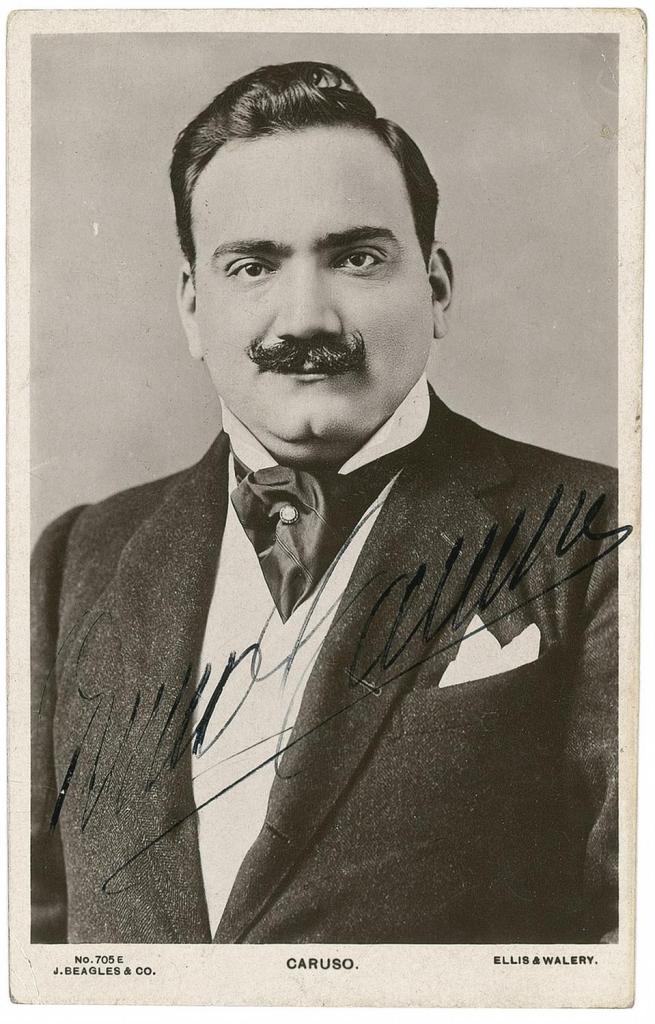 06.) Aria from Massanet’s “Le Cid”: O Souverain, O Juge, O Pere * Enrico Caruso * 1916
06.) Aria from Massanet’s “Le Cid”: O Souverain, O Juge, O Pere * Enrico Caruso * 1916
Something that is lost on audiences 100 years later is the absolute star power of an artist with a name of which you have never heard. Enrico Caruso released more records in his lifetime than most tenors could ever imagine being featured on, and was the opera singer of his time. He packed houses across two continents, and critics have spoken so passionately about the sound of his voice that there are some schools who have annual competitions by students who eager to take a shot at describing Caruso’s vocal performances. If you don’t go that deep into opera, then there’s no reason you would be able to recognize the caliber of his performances, and since the last time Caruso was popular in the US was 100 years ago (and I’m not kidding, it has been that long, precisely), I’m not surprised you don’t know who he is. I only came across his music when I started listening to The Ragged Antique Phonograph Music Program, and even then I can only really say I know of him.
Plus, opera ain’t really my bag. But, as a key player in the early days of recording music, Caruso is a perfect example – unlike Bing – of being able to perform for the acoustic era. It is said that his voice loved the horn, and he could belt out a tune the way no one else could. It is no wonder he recorded over 250 times in his career; the dude could sing.
 07.) After Dinner Toast at Little Menlo * Arthur Sullivan * ENHS E-2439-7 (5 October 1888)
07.) After Dinner Toast at Little Menlo * Arthur Sullivan * ENHS E-2439-7 (5 October 1888)
08.) The Lost Chord * (performers unknown) / composted by Arthur Sulivan * ENHS E-2440-3 (August 1888)
Various corners of the Inter-Web-A-Tron can reveal some incredible things, so here’s something fun I turned up as I was researching this episode: a recording of Arthur Sullivan from 1888 talking about being “thrilled and terrified” by Edison’s invention. Hopefully you have the kind of ear that can dig through the grooves on this one and really “grok” what he’s saying, but the gist of it is something that I think is at the heart of the central conversation about recorded music: the old generation is excited and annoyed by the next generation all at once. It was just too perfect, not only as an artifact, but as a way of framing how long this generation to generation conversation has been going since the beginning. Edison’s later resistance to electric recording technology, then finally giving in and embracing it far too late, is entirely foreshadowed, symbolically.
 09.) Alexander’s Ragtime Band * Billy Murray * EDIS 36065 (1911)
09.) Alexander’s Ragtime Band * Billy Murray * EDIS 36065 (1911)
Caruso might have been the opera equivalent of a rock star, but Billy Murray has often been referred to as the Elvis of his time, mostly in the sense that Murray was known by everyone. Unfortunately, he was considered a novelty for most of his career, which spanned almost 45 years across two centuries. Unquestioningly the biggest household name of the 1900s and 1910s, he sang vaudevillian ballads and novelty songs, and for nearly 20 years made a living touring and singing to people all across the country. His singing style is considered “conversational,” and people really connected with his everyman style, unconventional compared to other artists working the similar circuit. While he continued to get work into the early ’40s, as electric recording techniques and jazz began to dominate the record industry, Murray had less and less star power. In the acoustic era of recording, Billy was the biggest star America had ever known in popular music, and it wasn’t until Louis Armstrong or Frank Sinatra that someone as huge grabbed the American consciousness. While his name is largely forgotten today, this is a sample of American Popular music at the beginning of the 20th Century. Hopefully, as we continue with more History Lessons, we can see this style and format evolve.
 01.) Electricity * Captain Beefheart & His Magic Band * Safe As Milk
01.) Electricity * Captain Beefheart & His Magic Band * Safe As Milk
For a story like this, how can you NOT pick Beefheart’s “Electricity” to kick-start this mother, huh? If the thesis statement runs along the lines of: electricity is to music as punk rock is to pop — then you really have to put your cards on the table up front, dig? And truly, “Electricity” was the lighthouse beacon straight ahead across black seas, a song that laid bare a new path that rock and roll could forge through the saccharine formula that was prevalent across the musical landscape in 1967.
Already in the years between the early and late 1950s the world has seen an incredible revolution in the form of rock ‘n’ roll, and the ’60s see a massive array of miniature musical revolutions to match, each setting the course for a wide number of new interpretations. For Beefheart, it was the dirtiness of rock ‘n’ roll, it was the strangeness of The Blues (with a capital T & B) all mixed with this country shuffle, that really turned him on. But Beefheart wanted to distort both the recording of his vocals specifically and the artform as a whole intellectually, to return the music to its raunchy & rebellious origins. Ambitious? Absolutely. No small feat for any band of any era. Beefheart’s deconstruction of the blues/rock jam is so perverted it just oozes with the grime that is unmistakably punk in spirit and form. “Oh, they do it that way? Well, we do it this way.” There’s a sort of Troggs-y quality to the forward momentum and chord-progressions, true, but even that comparison only highlights the weirdness of the bass-line, a direct ancestor of the first Clash album, or some Ramones tunes. This, in many ways, is the source of the infection, patient zero, at least of this particular strain.
The myths surrounding this number are, themselves, larger than life, and the most appropriate pieces of foreshadowing if ever there were any. As it goes, Jerry Moss (the co-owner of Beefheart’s label) claimed the song was “too negative” for him to allow his daughter to hear it, leading to A&M Records dropping Beefheart. It is also said that in an effort to get the gritty vocals, The Captain shattered a microphone during one take. But the strangest legend of “Electricity” comes from one account of a legendary performance on 11 June 1967. The Magic Band was slated to play on Day Two of The Fantasy Fair and Magic Mountain Music Festival, by all accounts the first true rock festival as they exist in the modern form.
By way of an all too appropriate tangent within a tangent within an annotation, it is interesting to note that the promoters (Tom Rounds and the staff at KFRC 610) were inspired by the success of The Renaissance Pleasure Faire of Southern California, who were putting together these multi-stage, two-day events with music and artists and food and drinks, packaged together as a weekend of renaissance style fun. They wanted to do a rock & roll / freeform radio version of their event, and out of this was born The Fantasy Fair, a less documented affair that happened a full week previous to The Monterey Pop Festival, and really kicked off The Summer of Love.
The Fantasy Fair was, for lack of a glamours way of putting it, trying to capitalize on the rise of Psychedelic Rock. Sgt. Peppers had just come out, and everybody was talking about the San Francisco scene, which was already a few years old by then, and was was already being considered old news by the hipsters who were moving on to the slightly “harder” stuff that was happening in the underground “garage rock” scene of the late ’60’s. KFRC figured they could squeeze a few dollars from these hippies and make a mark in a big way for freeform AM radio by covering the event. Everybody wins.
They were, of course, 100% right. While there were absolutely financial motivations, KFRC was also looking to reclaim rock and roll from the awful version that America was living with in those days. The early ’60’s had seen the rise of the disdainfully named “bubble gum” craze, called such not only for the association that the music was for children, but for the added insult that the music was also quickly flavorless, and ultimately disposable. The Pat Boone-ification of these baby-faced teen idols led to a very bland format, which at the time was parading as “rock and roll.” A lot of people remembered how exciting it was to hear Little Richard on the radio, and were not getting the same vibe from Paul Anka. At least with the scene at The Fillmore, it could be said to be about, and for, adults who liked to rock, and who remembered that rock and roll used to be fierce and seedy, and fun. The Rock Festival, as an artistic statement, was to draw a line in the sand and say, “over here, we try to expand our minds like real adults.”
Were we ever so naive?
The line-up at The Fantasy Fair and Magic Mountain Festival is a veritable who’s who of late ’60’s rock bands: The Doors, Canned Heat, Chocolate Watch Band, Jefferson Airplane, The Byrds, Tim Buckley, The Fifth Dimension. It is in this insane time and place where Captain Beefheart performed his greatest version of “Electricity.” Here’s the scoop: The Seeds has just laid waist to the audience, themselves already declaring so-called “psychedelic” rock to be bullshit they produced their own hard-driving sound that was pretty formidable for audiences who were there to see Tim Buckley, or had heard that, “Mr. Tambourine Man” cover and thought it was “pretty.” The Doors had already begun to walk the darker side of rock music, and there was a small but dedicated group of folks who were exploring things that were new and different. The Magic Band sets up, trying to find a way to follow the propulsive set The Seeds had just offered. The crowd is ravenous. They are ready to rock. Time freezes. You can hear the sound of a pin dropping amplified through stage speakers.
The Magic Band winds up, rears back, and lurches forward. “Electricity” issues forth to a slightly perplexed crowd. They don’t know what to make of it. A few are just loaded, so they start to dance. Others just watch. Several wander off. One person is turned away slightly, eating. But most are trying to get into it, trying to figure it out. This whole weekend has been about something new, and they are eager. This song is a little shaky on the landing. Perhaps not the best song to open with, but Beefheart insisted. If they could just get to their next tune, “Diddy Wah Diddy,” which has been a bit of a hit when it came out and got a ton of radio play, perhaps they could win–
Beefheart signals, and the band lurches to a halt. They’re confused. What happened? The audience is stunned. They really don’t know what to make of the situation. Beefheart silently straightened his tie, and pointed to a girl in the crowd. Off mic he says, “she has turned into a goldfish.” Silence, quieter than before. Beefheart walks toward the girl, right off the front of the stage, pitching up face first in the mud and grass below. “That’s it!” yells Ry Cooder. “I have had it with your pretentious unpredictable bullshit, Don!” Cooder walks off stage, and out of The Magic Band forever. As Cooder leaves The Captain – still face down – signals again, and the band picks up the song (as best they could, sans one guitar), as if nothing had happened. As the show went on, you could see Beefheart smiling through the grass stains on his face.
The Seeds claimed it was the best performance they had every seen anywhere, and they should know, as they caught the whole thing from the side as they shared a joint.
Fuck the Summer of Love. This festival was the beginning of Punk Rock.
Earnest New Year’s Resolutions.
1.) Improve Daily Diet & Exercise Regime. (Will stick with this for the first week. Will go to free gym attached to office and get into cycling for a few days. Will tell everyone how are now exercising over salad lunch. Will feel superior to everyone for those days. Will wake up one day and feel awful. Will not work out that day, and will return to binge watching Rockford Files for entire weekends. Will not exercise again until Summer.)
2.) Loose 10 Pounds. (Will begin to loose weight, will start to feel good about self, will start making plans about all the things will do when you are finally healthy, then will find the last few pounds to be too difficult to shake without actually working out. Will dwell on the fact that resolution one failed so spectacularly, and will have gruesome images of impending death flash before eyes until Spring.)
3.) Read More Books. (Will go to the library. Will find that there is an overdue charge on your account from that Fantastic Four collection forgot to return last year. Will pay the fee. Will pace around the classics until grudgingly pick up Gulliver’s Travels. Will look longingly at DVDs and Comics as checking out. Will try to read book seven times. Will return the book to library to avoid charge. Will go home and have Max Headroom marathon, then re-read an old Conan comic.)
4.) Limit Alcohol Consumption. (Will have made this resolution while drunk the night of New Year’s Eve. Will wake up with incredible hangover and a sense of impending death. Will have a beer that afternoon to take the edge off. Will go to another party that weekend and get wasted. Will have forgotten the resolution by the second week of January.)
5.) Limit Time Spent on MyFacester+ & TwInstablr. (Will install a time tracking app on your phone. Will make public posts about how you are limiting your time on Social Media. Will set a date for your “last day” that is fairly soon, but not tomorrow. Will spend a lot of time pimping out profiles to tell your friends how little you use these sites anymore. Will promise yourself to only use e-mail, and to call when missing a friend.)
6.) Spend More Time With Friends. (Before the end of Social Media hiatus, will reach out to friends requesting to arrange times to actually get together, irl, lol. Will use Social Media embedded chats for communication to set up these meeting. Will keep using Social Media to set up in person meetings. Will not successfully arrange to see anyone new until Summer.)
7.) Pursue More Creative Projects. (Will go to Target and buy four notebooks, pens, dividers, storage bins, paperclips, printer cartridges, scissors, index cards, colored paper and paint. Will take these supplies home. Will realize you don’t actually have that printer anymore. Will find that you have many of these supplies already, in various states and forms. Will open up the first notebook. Will write on the first page: “Project #1:” Will tap pen on notebook for a few seconds. Will pull out phone to see if any friends messaged you yet.)
8.) Go On More Dates With Partner. (Will go online and make lists of places to go in your area. Will drop hints, asking where partner might like to do x or y. Measure responses, then will return to interweb to refine results. Will look at calendar and find day that works best. Will find self feeling unmotivated the week of the date. Will find partner having shitty week at work. Will look at each other that afternoon and agree to put on pajamas early and watch Indiana Jones & The Last Crusade again instead. Will promise to go on more dates next month. Will try again in July.)
9.) Get More Organized. (Will make a list. Will look at the list. Will wonder what to do first on the list. Will tap list with pen. Will make new list in order of priority. Will congratulate self for clever idea with a beer. Will look at list again. Will pick randomly the easiest thing on the list that you added at the last minute anyway. Will do that thing. Will cross off the item on the list. Will look at list. Will think list looks gross with that scrawl in it. Repeat several times a day.)
10.) Reduce Stress. (Will take up yoga. Will listen to relaxation tapes. Will make mind placid with serenity. Will wonder why it isn’t working. Will start to worry about not being able to reduce stress. Will start to worry about not being able to keep any resolutions. Will consider seeing a therapist again. Will go for a walk to clear head. Will feel better for some reason but will fail to make any connection to why that may be. Will try harder to keep resolutions tomorrow. Will make note on list to try harder. Will feel anxious about self improvement. Will wonder if that kind of stress is bad, too. Will get drunk with friends later to forget stress. Will eat fried foods & will forget everything for a while.)
The incredible thing about living in the 21st Century is that we have access to information and media of which our early 20th Century counterparts could never dream. Not only taking into account monoliths like Apple who entirely changed how everyone consumes information in the modern era, but just the access to factoids that would be difficult to source even 10 years ago. We now live in the future, as difficult as that may be to fully process. Case in point: at any given moment I can listen to digital transfers of Edison Wax Cylinders, watch The Avengers on a massive screen, text a friend of mine in Istanbul, and take 1000 pictures of a cat sitting next to me, all through devices that are middle class mundanities in this modern world. The future, indeed.
As a media junkie, I’m always looking for new things to absorb, and with my mind on the very problem of and created by modernity, I stumbled across a CBC Radio broadcast of a program called “The Wire,” and the seeds of this show were first sewn. Our relationship with music today is entirely born out of music’s relationship with electricity, something that goes back to the end of the 1800s. As early pioneers discovered ways to capture music – an experience that, previously, required the listener to be in the same room with the performer – music entered a new kind of simulacrum, where mechanical objects were standing in for the real performance and “playing back” these sounds. Obviously, Edison is one of the movers and shakers in this revolution, but that is not to say that he was the only person fixing sounds to some object in space. However, his work set the template for the record industry that was to come, and in that sense, he is very relevant. Electricity is now married to music in a way that seems inseparable to the modern ear, and yet is in no way apparent when you are turning on a streaming service to help pass the time.
The idea for my particular punny spin goes back to 2011, when I first began to flirt with the “History Lesson” concept. I had done a number of shows where I was getting more and more experimental with the editing thanks to my interest in Negativland and Over The Edge, and in some ways my show from the very beginning was about de-contextualizing recordings against music and other forms of audio, but with a “radio” sensibility to the presentation. (I was, of course, still on the air.)
In 2011 I expanded the scope of these audio essays to a four-hour, two-part broadcast called “Before ’75,” briefly covering as much material as I could about the earliest days of the pre-punk music scene. However, I always felt as if that show was not enough. Four hours covered a ton of music, a number of artists, and included a lot of really good interviews and samples that drove the point home. But the beginning felt lacking. I always thought that, if you logically extend the story back further, punk rock only really has context if you tell the story that came before it. Act I of punk rock is the merger of electricity with music; distorted guitars and DIY cassette releases need the first 70+ years of music history to make their revolution son incredible. I immediately envisioned a new, bigger and grander idea for “History Lesson.” Let’s really take the listeners back to the beginning.
As we roll back the tape to the end of the 19th Century, the state of music was merely that of being in the same room as a music source: a performer. From there, we move forward through acoustic recording techniques with Edison, the major difference microphones had on the sounds you could record, and along the way present music that complements the story while driving the narrative from time to time. Later, we discuss the impact recorded music had on the film industry, and enter a discussion about how these factors lead to the birth of radio itself, a pastime so near and dear to my heart.
At this stage in the program we switch our audio samples over to another very different documentary, “The Empire of The Air.” This Ken Burns documentary of PBS covers the story of Radio through three men, interestingly enough glossing over Marconi, and omitting Tesla entirely. (For shame.) However, it does a good job of drawing a parallel to Edison and his relationship with recorded music: not only do the pioneers of radio develop amazing technology, they are setting the course for how radio would act in the public for generations to come.
And, along the way, there is music to help tell the story. And what a story it is.
01.) Turn It On * The Flaming Lips * Transmissions From The Satellite Heart
02.) Excerpt Part I * Ben Brooks * The First 50 Years of Radio Part One
03.) Edited Excerpts * Mike Staff * How To Become A Radio DJ
 It’s easy to defend The Flaming Lips when they put out a great album, and have a hit song like, “Do You Realize?” and everyone is excited about festival concerts and the extreme production value they bring to their shows. But the cruel eye of hindsight is not so kind to them at times. While their output is treasured by hardcore fans, they become increasingly panned as the flops start to add up. This particular era of the band – we’ll call it the “Don’t Use Jelly” years – was not their strongest, to be perfectly frank. They had not yet written Clouds Taste Metallic, and where quite a long way off from The Soft Bulletin. In many ways they have become a bit of a cut-out-bin band, a novelty act that puts out Zaireeka (an album where you listen to all four discs simultaneously), or their absurd “7 Skies H3” (a 24 Hour Long Song), not to mention the song-for-song cover of Dark Side of The Moon, and “Christmas On Mars,” a holiday movie that is as inscrutable as it is terrifying. I can see why some people find them a problematic start to any story.
It’s easy to defend The Flaming Lips when they put out a great album, and have a hit song like, “Do You Realize?” and everyone is excited about festival concerts and the extreme production value they bring to their shows. But the cruel eye of hindsight is not so kind to them at times. While their output is treasured by hardcore fans, they become increasingly panned as the flops start to add up. This particular era of the band – we’ll call it the “Don’t Use Jelly” years – was not their strongest, to be perfectly frank. They had not yet written Clouds Taste Metallic, and where quite a long way off from The Soft Bulletin. In many ways they have become a bit of a cut-out-bin band, a novelty act that puts out Zaireeka (an album where you listen to all four discs simultaneously), or their absurd “7 Skies H3” (a 24 Hour Long Song), not to mention the song-for-song cover of Dark Side of The Moon, and “Christmas On Mars,” a holiday movie that is as inscrutable as it is terrifying. I can see why some people find them a problematic start to any story.
I don’t want to argue about their relevance or importance; I don’t want to claim that they are essential or a must for any smart psychedelic music fan; I don’t even want to convince you that you need to own or listen to anything else by them.
I just want to ask: have you ever heard anything as uplifting and strangely funny as “Turn It On” with these Mike Staff samples?
I gotta say, it’s better than it should be.
Now that you’re reconsidering The Flaming Lips, let’s get into it for a bit. I can’t change your mind, but they began to click for me when I had a better understanding when I considered the time and place. Mid-West in the early ’80’s, where the rules of punk rock were trying to set fire to the entire pre-history before The Ramones. Punk insisted that the bullshit excess of rock music from the ’60’s was completely valueless, and that only when we get loud and fast do we break out of the norms that had become “standard practice”. The past had nothing to teach us, and in the name of punk, we could only look forward to getting drunk and fucking shit up. The loudfastfuckyounow of punk awoke in their fans a rigidity of thought and uniform, behavior and musical ethos. Its narrowmindedness is often better summarized as a rejection of everything else rather than an articulate analysis of what they didn’t like about… well, anything.
The Flaming Lips understood that punk rock was due for an infusion of something new to save it: psychedelic rock. The story of punk had, ironically, been paved when rock & roll discovered psychedelia, spinning out of it a million permutations on a similar three-chord idea. Punk was a revolution, to be sure, but was insular and defined by negation, following a narrow aesthetic ideology. It had stagnated without anything new to expand it, and the fascistic denouement of all other things became a hinderance. The Flaming Lips never planned to create psychedelic punk per se, and even still, The Butthole Surfers beat them to the punch. But the Lips were such students of psychedelic rock and punk that their ideology was equally in those two worlds. In essence, the heart of the Flaming Lips is their curiosity about music in these varied forms and structures, and they have dedicated their lives to it.
Their early work borders on avant guarde, as the band is clearly still learning how to be a band. But after a handful of albums like this, a thread starts to emerge, and they get good at playing and writing songs. As the ’80’s closed, The Lips were a fairly strong band that could get a crowd, keep ’em, and put on a fun show the whole time. As the ’90’s began, they released records when everyone was watching for the next big alternative act. In the wake of this, Transmissions From The Satellite Heart hit stores, an album that not only summarized their sci-fi / earnest aesthetic in a nutshell, but wove a radio metaphor into the very fabric of their music, specifically the album opener, “Turn It On.”
If a mainstream band wore their heart on their sleeve more in the ’90s than The Lips, I’m hard pressed to name them at this time. “Put your life into a bubble / we can pick you up on radar / hit a satellite with feeling / Give the people what they paid for.” They have chosen this life, have dedicated themselves to being artists on display for us. We, as listeners, have a chance to pick up the signal they are sending, and fortunately for us they are the kind of band who will “hit” us with a feeling that is as real as possible. For the Lips, there is no better experience than that of celebration, or raising your voice to sing along to a song you hear on the radio, to Turn It On and On and WAY UP, and share that moment across the country at the same time and moment connecting us all in a positive expression of loving a simple rock and roll song.
How cool is that?
You can see that thread throughout all their work: this idea of sharing a celebratory feeling with a large number of people to create a magical moment, even a sad one, or a mundane one, and share that feeling through these transmissions, these records and songs The Lips have been making for almost 40 years now. Their perspective is so much a radio metaphor that, while it might seem crazy at first, they are the perfect band to kick off any story about radio.
This particular mix – with the Mike Staff Samples – comes from another audio essay I made in 2009, “A Sound Salvation.” I was rummaging through the library and came across this self-help tape by a NuRock style DJ, Mike Staff, who was going to reveal his tips for those who wanted to become successful professional DJs. This tape was perfect to mix with songs about radio and DJs, and the show wrote itself. While I don’t usually like to listen to individual songs from a show like this one (as I think the show works great as a whole), there is something about the way the mix during “Turn It On” worked that really sounds good to me. Mike Staff is over the top and full of himself, but his voice has that tone that makes you want to believe what he’s saying. And, for all his cheese, he makes a good point: Your Dream is Important to you, and can guide you if you will let it.
It’s that time of year again around the  Capital Couple Hideout, and we’ve had an incredibly strange and wonderful year that we’d like to tell you all about. We began 2015 in the city of Salem, OR, where we had lived for much of 2014, and has become our new home. Not only does Marla’s family live here, but we both found new jobs that not only fit our new lives, but were working out quite well for us. Feyd, of course, has yet to find a job, and continues to take advantage of us, in spite of our best efforts.
Capital Couple Hideout, and we’ve had an incredibly strange and wonderful year that we’d like to tell you all about. We began 2015 in the city of Salem, OR, where we had lived for much of 2014, and has become our new home. Not only does Marla’s family live here, but we both found new jobs that not only fit our new lives, but were working out quite well for us. Feyd, of course, has yet to find a job, and continues to take advantage of us, in spite of our best efforts.
We had some very big changes around the homestead, the first of which is that Marla & I now have a podcast. The Capital Couple (thecapitalcouple.wordpress.com). We’ve done seven episodes so far, and we talk about the things we do for fun, what it’s like here in Salem, and anything else that comes to mind. We have quite a bit of fun doing it, and we would love to urge all of you to check it out. On top of that, I celebrated my 40th Birthday in a fairly dramatic way, with a two-day show in Portland at Plew’s Brews and The Kenton Club, with music and friends. It was one of the most fun things I’ve had the pleasure of arranging, and you can see some highlights using this link: bit.ly/40thPlewsKenton. It was awesome.
As if turning 40 wasn’t enough, Marla and  I also got married! Yeah, that was sort of a big deal, as we had been waiting for over a year to officially tie the knot. But the wait was worth it, as we had friends and family there to help us celebrate, and it was, without a doubt, the best day of my life. I want to thank everyone who was there and helped, as both of us had an incredible time, and I can honestly say I have never looked better, ever. You can find lots of unsorted photos at bit.ly/MarlaCodyWedding. (And, if you took photos that we don’t have yet, please send them along. We would love to see them!) I never imagined that I would ever be married, and I am finding that this life is not only worth the wait, but is something I didn’t know I would enjoy this much. All thanks to my amazing and beautiful wife, who said yes.
I also got married! Yeah, that was sort of a big deal, as we had been waiting for over a year to officially tie the knot. But the wait was worth it, as we had friends and family there to help us celebrate, and it was, without a doubt, the best day of my life. I want to thank everyone who was there and helped, as both of us had an incredible time, and I can honestly say I have never looked better, ever. You can find lots of unsorted photos at bit.ly/MarlaCodyWedding. (And, if you took photos that we don’t have yet, please send them along. We would love to see them!) I never imagined that I would ever be married, and I am finding that this life is not only worth the wait, but is something I didn’t know I would enjoy this much. All thanks to my amazing and beautiful wife, who said yes.
 As if that were not enough (and, in a way, it wasn’t), our Honeymoon involved a two-week trip around the American Southwest, something Marla named, “The Great American Road Trip Colon Southwest Edition.” We drove over 3500 miles, saw The Grand Canyon, Disneyland, Monument Valley and the Zion National State Park, and it was as good as advertised. We had an incredible time, and realized that it was the longest trip we’d ever taken together, and the most time we’d ever spent together, continuously. It was amazing, and I am STILL going through all the photos and video I shot. You can see some of the highlights using this link: bit.ly/MarlaCodyHoneymoon. It was one of those trips that proved that I made the right decision with Marla.
As if that were not enough (and, in a way, it wasn’t), our Honeymoon involved a two-week trip around the American Southwest, something Marla named, “The Great American Road Trip Colon Southwest Edition.” We drove over 3500 miles, saw The Grand Canyon, Disneyland, Monument Valley and the Zion National State Park, and it was as good as advertised. We had an incredible time, and realized that it was the longest trip we’d ever taken together, and the most time we’d ever spent together, continuously. It was amazing, and I am STILL going through all the photos and video I shot. You can see some of the highlights using this link: bit.ly/MarlaCodyHoneymoon. It was one of those trips that proved that I made the right decision with Marla.
2015 had some other ups and downs, but strangely enough, things seem to have worked out pretty well. I made a decision to stop working in jobs that I don’t like, and have been pursuing writing and podcasting full time recently. (acronyminc.org; anywhereanywhen.com). I can’t say that I know exactly in what direction this will all go, but I can’t wait to find out. I enjoy writing and radio almost as much as my wife, and I’m looking forward to seeing where they take me, too.
That’s it from our house this year. We are looking forward to seeing what 2016 had to offer, as this year worked out quite nicely for us. Until then,
– Cody & Marla “Rocket Danger” Rich
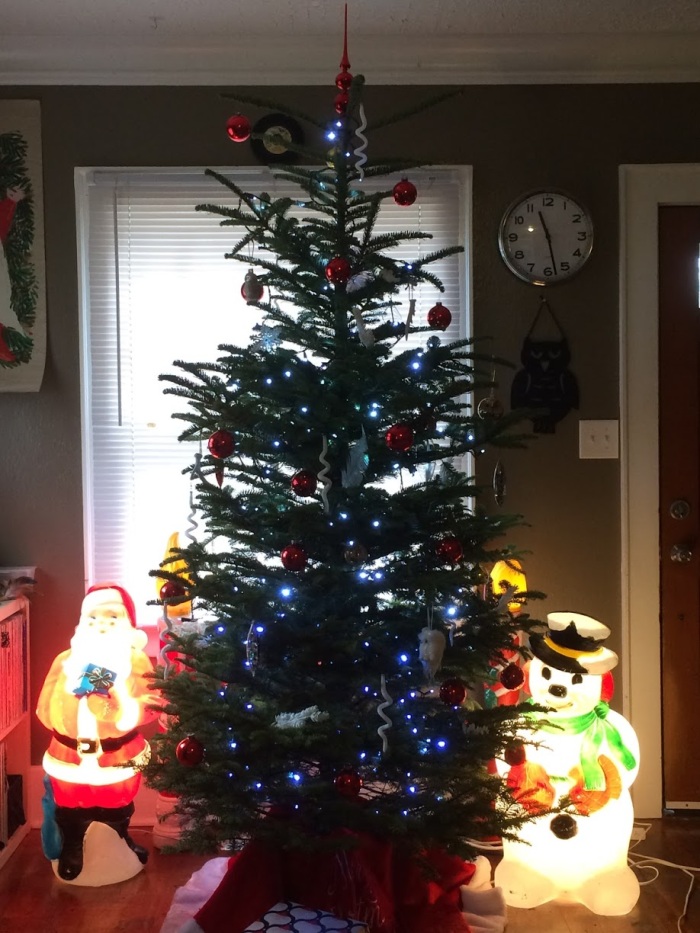 It’s pretty hard to sit in a room with a lit Christmas Tree, a fire on the TV, and vintage holiday songs playing in the background soothingly, and while all of that is going on, frown and say, “man, fuck this holiday.” Because, and this is something I can’t believe I’m saying as an adult male, this time of year can have a soothing effect on you if you let it.
It’s pretty hard to sit in a room with a lit Christmas Tree, a fire on the TV, and vintage holiday songs playing in the background soothingly, and while all of that is going on, frown and say, “man, fuck this holiday.” Because, and this is something I can’t believe I’m saying as an adult male, this time of year can have a soothing effect on you if you let it.
It’s funny how Christmas has, embedded within it, a narrative that goes on about how it has become too commercial in the current form, and must revert to that of some pure form that probably never was. There’s some form of that in the story of Christ himself, and nearly every iteration of it retains some piece of the over-commercialization of the way the holiday is celebrated. (The Peanuts Christmas special – arguably one of the first and best holiday specials to date, is about that very subject from the get-go.) There is something about Christmas that has come to embody everything that is both bad and good about the spirit of spending money during the season, and the true meaning of the holiday is to find a way to embrace the contradictory ideas, and that there is intrinsic value in the experience of the season. It just so happens that you must also buy and spend like Wilma & Betty on The Flintstones.
Christmas as a child is always so incredibly simple, and you have fewer years under your belt to really begin weighing the strangeness of this arrangement. Good behavior throughout the year usually led to a boatload of presents being magically delivered to your home in December, and even with those draconian rules in place, you could often undo quite a bit of poor sportsmanship on your part through a hand-wavey explanation that it was in the spirit of the season, so long as you were good when your parents asked you to be.
But as the complexity of these experiences develops over the years, and layered meanings begin to create loaded holiday symbols that can cause even the strongest person to burst into tears. It is one thing to love the tree that shows up when your parents return with it, and for presents to appear beneath it after a lot of build-up and waiting. But when you remember all the holiday fights, the times spent alone, how you never really get what you really want anyway, and the overhanging threat that Santa is watching you at all times (with the surprise ending when it is revealed what is really happening as you get older), well… this time of year can take on a very different meaning. Especially if you have lost a family member that played a roll in all of this.
 When I began to live on my own, I made a few deconstructed efforts to participate in the holiday, and they were all met with equal parts derision and head-scratching. As a kid, I had made a habit of finding a decorating very small trees in my bedroom with a more home-spun and Comic Book aesthetic, and this tradition for me continued through to High School. On my own, my trees grew full sized, and soon accumulated beer cans and cigarettes as a sort of upraised middle finger to the spirit of the holiday.
When I began to live on my own, I made a few deconstructed efforts to participate in the holiday, and they were all met with equal parts derision and head-scratching. As a kid, I had made a habit of finding a decorating very small trees in my bedroom with a more home-spun and Comic Book aesthetic, and this tradition for me continued through to High School. On my own, my trees grew full sized, and soon accumulated beer cans and cigarettes as a sort of upraised middle finger to the spirit of the holiday.
Even this grew tedious for me after a few years, and soon Christmas was just became another day where I had to pay special attention to the bus schedule, had to get to the liquor store around this new schedule, but at least I might be able to earn an extra fat paycheck if I worked certain days in November and December. Aside from a few random occasions, the time between my early 20s and my late 30s were often spent Christmas-less, tree-less, and only occasionally did I celebrate with family, when it was convenient for both of us. I just couldn’t quite bring myself to get into the holiday spirit on my own, unless that spirit was bourbon.
While I have had girlfriends in the past who liked Christmas, right from the very first year we were together, my wife felt strongly about the holiday. Before I could protest much, she had arranged for me to spend the holiday with her family, and it has been the way we have celebrated every year since. Her dedication to the cool parts of the holiday, mixed with our mutual understanding that we prefer to leach out all of the religious elements of the holiday, has led to us developing a very nice collection of holiday decorations, and traditions that we both enjoy and love.
Included here is a photoset of our Holiday Photos going back to the first year that we were together, and it includes some of my favorite trees and decorations that we use every year. We got a little ambitious this year, and wanted to set up more stuff than we were able to get to, but this often happens because of the hustle and bustle of the year, and we inevitably fall behind on this or that. Obviously, we enjoy having a good tree, but there are some other decorations that we love putting up every year, too. Here’s a few of them:
Blowmolds: 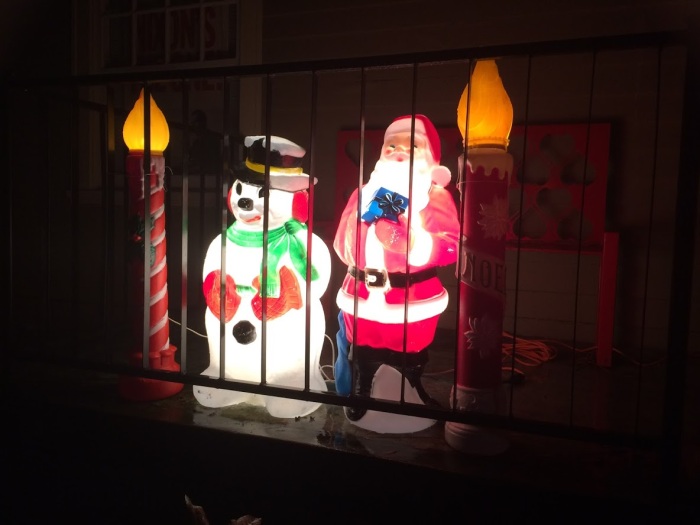 Be it Halloween or Christmas, a good blowmold will attract our attention if we are out shopping. When I first met my wife, she had one of the candles, but since then we have acquired the other three pieces. Frosty is the most recent addition to the family. However, the exceptional wind and rain this year made it a little difficult to keep these guys upright and in place. Next year we’re going to use some loose gravel to weigh them down, along with ties to keep them from blowing over.
Be it Halloween or Christmas, a good blowmold will attract our attention if we are out shopping. When I first met my wife, she had one of the candles, but since then we have acquired the other three pieces. Frosty is the most recent addition to the family. However, the exceptional wind and rain this year made it a little difficult to keep these guys upright and in place. Next year we’re going to use some loose gravel to weigh them down, along with ties to keep them from blowing over.
 Stockings: If you look at the enlarged version of this photo, you can see that we have five stockings up on the mantel this year. In the early days, we used the small red stockings, and added the small green one for our cat. But I had the larger green and white Santa Claus stocking (on the right) from when I was a kid, and would bring it out occasionally as an extra decoration for the house. This year, my wife surprised me by finding a matching stocking in the same style online (the white and green Santa Claus stocking on the left), and had it shipped to us for the holiday. It was a very sweet thing for her to do, and now we have two sets of stockings.
Stockings: If you look at the enlarged version of this photo, you can see that we have five stockings up on the mantel this year. In the early days, we used the small red stockings, and added the small green one for our cat. But I had the larger green and white Santa Claus stocking (on the right) from when I was a kid, and would bring it out occasionally as an extra decoration for the house. This year, my wife surprised me by finding a matching stocking in the same style online (the white and green Santa Claus stocking on the left), and had it shipped to us for the holiday. It was a very sweet thing for her to do, and now we have two sets of stockings.
 Danish Paper Craft Decorations: I may have mentioned before, but both my wife and I are thrift store aficionados, and a surprising amount of holiday schwag will show up in stores, often at rock-bottom prices, to help the items move, quickly.
Danish Paper Craft Decorations: I may have mentioned before, but both my wife and I are thrift store aficionados, and a surprising amount of holiday schwag will show up in stores, often at rock-bottom prices, to help the items move, quickly.
To that end, for a dollar each my wife found both of these Santa & Frosty Paper-Craft items. Both of them came with these super-funky paperclips that not only spoke to their foreign nature, but how strange these
items are.
It is hard to c onvey how
onvey how
strange these are in photos and text, but let me describe: in Frosty, the hathead, and body are interlocked folded constructions that rotate independent of each other, but also work together. in Santa, the beard is a weird cardboard overhang that wraps around the face, folding out of the way when you collapse him. They’re both incredibly neat and very weird at the same time, and they are excellent additions to our collection.
 Tiffany Glass Candle Holders: We see these at thrift stores fairly often, occasionally in their original packaging, and we now have five of them in our collection. We struggled with how to light them at first, as burning actual candles was costly and didn’t quite work well. (You would have to either buy short stubby candles, which were hard to find and did not burn long, or tall narrow candles, and let them burn down until they were the right hight, at which point they, again, don’t last long. This year, my wife found electric candles that were the right height and diameter to fit into the candle holder in the back, and they now look great. They not only light up very well, but they are much safer than when we had fires burning behind each ofthem.
Tiffany Glass Candle Holders: We see these at thrift stores fairly often, occasionally in their original packaging, and we now have five of them in our collection. We struggled with how to light them at first, as burning actual candles was costly and didn’t quite work well. (You would have to either buy short stubby candles, which were hard to find and did not burn long, or tall narrow candles, and let them burn down until they were the right hight, at which point they, again, don’t last long. This year, my wife found electric candles that were the right height and diameter to fit into the candle holder in the back, and they now look great. They not only light up very well, but they are much safer than when we had fires burning behind each ofthem.
 Late ’50’s Paper Print Wall Hangings: As estate sale junkies, another place to find excellent holiday decor is in a place where someone old has passed on. It is part of the natural life-cycle of material goods: the young pilfer cool shit from the elder folks that pass away, and we horde it until we pass away, and let some other young person pilfer all our cool shit at some far point in the future. My wife is much more tuned into that part of the resale market than I, but this hasn’t stopped me from being impressed with the stuff she comes home with.
Late ’50’s Paper Print Wall Hangings: As estate sale junkies, another place to find excellent holiday decor is in a place where someone old has passed on. It is part of the natural life-cycle of material goods: the young pilfer cool shit from the elder folks that pass away, and we horde it until we pass away, and let some other young person pilfer all our cool shit at some far point in the future. My wife is much more tuned into that part of the resale market than I, but this hasn’t stopped me from being impressed with the stuff she comes home with.
These two prints were together 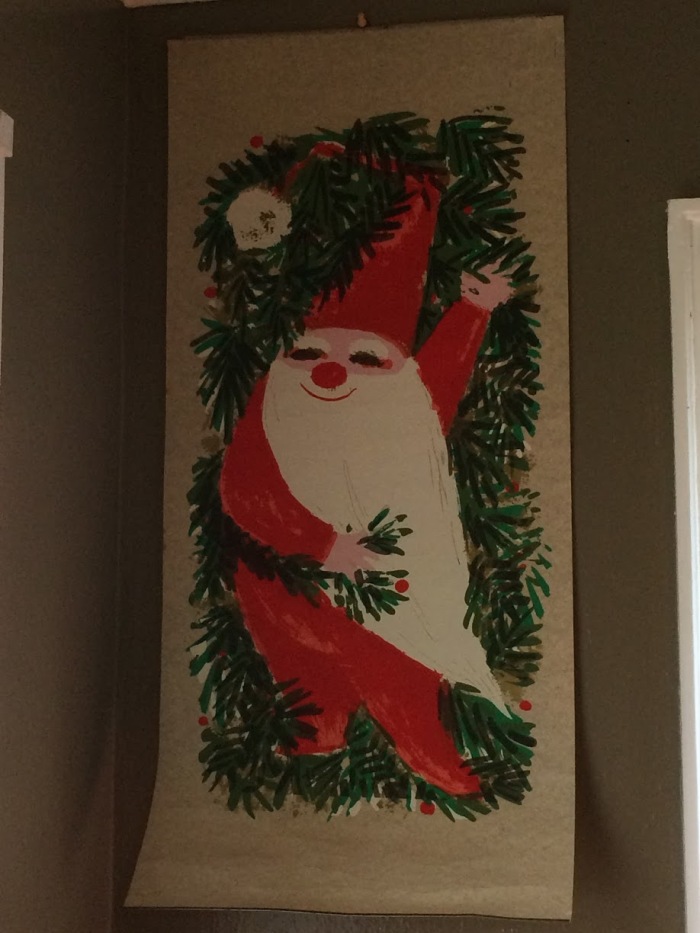 when she found them, and while we don’t know the exact
when she found them, and while we don’t know the exact
provenance of where they came from, we know that they have been around at least since the late ’50’s. On the back of the prints, one of the previous owners has carefully written out the years that these were hung in their house. It’s not only a great added feature to these images, but it tells an entire story of a family in a few scrawled years and dates on the back of these prints. I have become obsessed with these ever since my wife found them, and I’m very happy to have them in my home.
 Ralphie Radio: My wife and I have very different tastes in music, but one thing we can agree on is that older is often better. And to that end we like to listen to Ralphie Radio when this time of year comes around. I discovered this several years ago, and found that this is the perfect kind of holiday music because it is from the 1940’s (or, in some cases, older), and that helps when you are listening to the same pop pap that is often circulated this time of year. The premise is that the music is appropriate for the time period in A Christmas Story, a detail that not only makes it more appealing, but sort of preps you for that movie, anyway, which everyone will see at least once this year. While I would hope that you are listening to my Holiday Podcast Feed in iTunes, it would make sense that if you are not listening to that, you would want to listen to Ralphie Radio instead. While I find the commercials on Live365 to be very annoying, and the interface for most programming in not ideal, the quality of the music on this station is well worth tuning in for, even for a little while.
Ralphie Radio: My wife and I have very different tastes in music, but one thing we can agree on is that older is often better. And to that end we like to listen to Ralphie Radio when this time of year comes around. I discovered this several years ago, and found that this is the perfect kind of holiday music because it is from the 1940’s (or, in some cases, older), and that helps when you are listening to the same pop pap that is often circulated this time of year. The premise is that the music is appropriate for the time period in A Christmas Story, a detail that not only makes it more appealing, but sort of preps you for that movie, anyway, which everyone will see at least once this year. While I would hope that you are listening to my Holiday Podcast Feed in iTunes, it would make sense that if you are not listening to that, you would want to listen to Ralphie Radio instead. While I find the commercials on Live365 to be very annoying, and the interface for most programming in not ideal, the quality of the music on this station is well worth tuning in for, even for a little while.
 A Digital Fireplace: When my wife and I bought our first TV (and a Roku to go with it in 2011), we discovered that Roku had created a holiday Yule Log, a digital fire with Christmas Music that played along with it. (You could also just turn off the music and have the fire.) We loved it so much that we’ve been trying to recreate it ever since Roku discontinued their version of the Yule Log a couple years ago, and in the place of it, they introduced other, much less impressive holiday programming. Fortunately, nearly all streaming devices now have YouTube embedded within them, and finding a digital fireplace is easier than ever. (Netflix also has a pretty decent one, too, but I find the YouTube ones last longer.) Just play your favorite holiday tunes while you watch this, and you have the ideal environment for celebrating Christmas, without having to add logs or stoke the fire.
A Digital Fireplace: When my wife and I bought our first TV (and a Roku to go with it in 2011), we discovered that Roku had created a holiday Yule Log, a digital fire with Christmas Music that played along with it. (You could also just turn off the music and have the fire.) We loved it so much that we’ve been trying to recreate it ever since Roku discontinued their version of the Yule Log a couple years ago, and in the place of it, they introduced other, much less impressive holiday programming. Fortunately, nearly all streaming devices now have YouTube embedded within them, and finding a digital fireplace is easier than ever. (Netflix also has a pretty decent one, too, but I find the YouTube ones last longer.) Just play your favorite holiday tunes while you watch this, and you have the ideal environment for celebrating Christmas, without having to add logs or stoke the fire.
* * * * * *
The two things we did not get to this year was our Christmas Village – which we got started on, but just could not finish – and our outdoor lights, which were hindered by the rain and wind, making it difficult to get them up at a time when we were free to spend a lot of time outside anyway. But there is always next year, and I look forward to trying again then, too.
I never appreciated how enjoyable the holidays can be when you get to celebrate it exactly the way you want to, and with the people that you care about most. Now that I have someone like that in my life, this time of year means more to me than it ever used to. Hopefully, however you prefer to celebrate, make sure that you do it with someone who you actually want to spend time with.
And, if you can, hang up a stocking or two. It’ll help you get in the right mood.
 I Mean This When I Say: Sometimes Democracy Needs More Upraised Middle Fingers That Clean Up Nice.
I Mean This When I Say: Sometimes Democracy Needs More Upraised Middle Fingers That Clean Up Nice.
I often like to argue that I am more of a patriot than most, because I am the first person to jump at the possibility that the entire system is broken, and needs to be rebuilt in a decentralized way, run by women and minorities, preferably. The right combination of influences, friends, drugs, music, and intellectual journeys I made as a late teen / 20 something bred in me this notion that most systems are flawed by default, and to tear them down in favor of something else – sometime, anything else – is always preferable in the end. As time went on, I started to see the folly in much of that thinking, and more pointedly, exposure to other ideas and systems of thought – filtered through this hypercritical bullshit punk rock perspective – only led to me to having a much more well rounded point of view by the time I graduated from college.
That being said, I have come to believe that most systems are still flawed, yes, but that by asking questions, and trying to understand these broken systems, you can interject into them the kind of meta-analysis that might cause others to think. This does not mean that I have often been successful or right when I’ve had to navigate local government or bureaucracies. At least I feel as if I’m not compromising my own principles when I behave that way, as artificial and arbitrary as my ever-evolving principles might be.
All of this is a long was of saying that I’m absolutely in support of attending and participating in Jury Duty when you get called. I would only hope that there would be a skeptical ex-weirdo who can put on a shirt and tie on my own jury if, for whatever reason, I wound up in some sort of trial. That’s not to suggest that I’m the kind of guy who would end up in a trial on a regular basis, just that I would want someone to be “of my peers” if I were in their shoes, so it only stands to reason the opposite would be true. I feel it is my responsibility to be the agent of question-asking and curious weirdos in public, and that applies to Jury Duty, too.
Flashback. Portland. 2002.
I was called for Jury Duty one other time in life, over 10 years ago. What I remember most was a lot of waiting and reading, an eventually I was sent home, and I never heard from Multnomah County again. I was single at the time, and my job paid for me to go, so why not participate in the world of law in a meaningful way? And, so what if I wasn’t called for a case? It would all happen again, and I was happy to be a cog in that wheel. Eventually I would actually participate, the next time I was called, and that would be fine.
As the years went on, it became clear that not only was I not going to get called again, I just got sadder about how this vestige of democracy was within my reach, and yet so far away. I was convinced that I was a perfect candidate, but I was just never called into action, and never given a chance to give my particular assets a chance to shine. Another case of the super-hero who could have saved the day, save for the world’s inability to recognize the power he could wield, if they would only let him. This seemed to be so symbolic of my relationship with so many things, and it just made me feel bad to think about what that might mean for how broken the system really might be. Or legal fate is not through carefully reasoned measurements of truth, but given over to random chance.
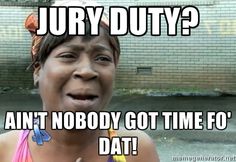 Now, In Present Day Salem, OR.
Now, In Present Day Salem, OR.
My wife got a jury summons a while back, and I was immediately jealous, until I got my own summons a couple weeks later, in late November. It made sense. We moved to a new county, then got married, and our names were now in the system, anew. We have heard, through the grapevine, that Marion County has a system that usually turns over every two years, without fail. My wife went in for her chance to serve, and was not picked, and came home quickly. It did not bode well for my own chances.
As instructed in my letter, I checked in for duty online, and as further instructed, returned to check on the website if I would be needed for the summons in the morning of the day I was supposed to attend. I didn’t think much of anything, as I was kind of excited about going, and skimmed the site. I didn’t see anything that overtly read “don’t come in,” so I took it as read that I was to do as instructed in the letter, and show up before 8 AM.
So, prepped with a lunch and fortified with a few cups of coffee, I arrived on time, filled out the paperwork, and was happy to go to the front desk only to find that, as part of the trial jury, since it was so close to the holiday, my services would not be needed. “Unless you want to volunteer to be a part of the Grand Jury,” he said.
I wasn’t exactly sure what that meant, but I eagerly jumped at the chance to do it, having already gotten myself down to the courthouse dressed in respectable clothing before 8 AM. (No easy feat, mind you.) He explained that it was a two week commitment if I was selected, and I could be in the courtroom for up to six days during that period. The more he explained, the more I got excited about it. While never seen in the movies or on Perry Mason, a Grand Jury gets to decide if there’s even a reason for the case to go to trial, which is itself a very important function that is unglamorous and little known, on top of all of that.
While I won’t drag out the climax for too much longer, in less than two hours I was sent home, being thanked for my service in spite on not getting selected to do anything. While I did see that it was absolutely random that I was not selected, I was disappointed to get to a courtroom finally only to be sent home because they were not going to need my help. (The bailiff and Judge chose jurors from a fanned-out set of papers that represented all of us.) Fortunately, the city of Salem provides you with a bus ticket good for the day that you are serving Jury Duty, so I was home so early that I didn’t even get a chance to want to snack on my lunch early, as I could have prepared myself an entire meal at home and still have time to spare, considering how early I was out. It was such a whirlwind, I barely even noticed the inconvenience it might have been.
Some Quick Observations
Everyone I met at the courthouse was not only friendly and kind, but seemed a little desperate for levity and a smile. It was a Monday morning, and it was close to Christmas, so I’m sure there was a little lightness in the air that was not there normally. But whatever the case, I had positive interactions with everyone, and a smile really went a long way in terms of getting a nice laugh or exchange out of them. On the other side of this, the people who had all been called for Grand Jury seemed like a huge group of sourpusses. No one looked like they wanted to be there, and I could understand, in a way. I have no idea what their personal lives are like, and I don’t know what they are leaving behind at home. But no one looked happy to be there.
The process is pretty quick. There is certainly some down time, but I’ve waited longer for instructors to show up for appointments, so I felt pretty good about those intervals. The Judge was nice a friendly, and once he got started, the courtroom ran efficiently while I was there. I was sort of shocked, but then again, they do this five days a week, every week, so they have it down. Even the security check at the entrance of the building seemed far too simple and easy to get through to be that much of a problem or hassle. As with a lot of public places like this, they ask you to turn off your phone, and remove your hats, which I thought was an interest request. (Probably to avoid having hidden recording devices.
 I did find it a bit weird that most of the people I was in Jury Duty with were women. The men were outnumbered by a factor of three. While not completely hard to explain – that’s just the way the random number thingy worked that day – I did find it odd. There was one other guy who was in his 20s, but I was still the second youngest man in the room.
I did find it a bit weird that most of the people I was in Jury Duty with were women. The men were outnumbered by a factor of three. While not completely hard to explain – that’s just the way the random number thingy worked that day – I did find it odd. There was one other guy who was in his 20s, but I was still the second youngest man in the room.
I should also add, while I’m at it: I’m surprised at how understanding The Judge is with regard to people who just don’t feel like doing it. Now, I’m not here to be judgmental about the way other people spend their time. I probably don’t have the greatest management of my own time. But I barely believe in systems of any kind, and would rather see bullshit from the past be burned down than reinforced by bureaucracy at this late date, Twenty Fifteen. But I was a little astounded at how bad the excuses could be for people to be let off the hook for serving. I understand that missing even a day of work can be a hardship for a lot of people, and it is not my place to judge anyone who is in that situation. It just seemed strange to hear excuses like, “I would be tired to try and fit it in,” and, “It’s hard to get here,” as legitimate excuses that the Judge will accept. Yes, I’m tired early in the morning too, and now that you mention it, compared to my bathroom, this was very hard for me to get to. Where’s my parade?
Regardless, I don’t believe anyone was really trying to take advantage of a gullible system, but again, they did not need all of us, and I guess the system is designed to include a padding that will account for lazy jurors. They could easily afford let a few people go because they don’t “feel like it,” and still have plenty of people leftover. I just want it on record that I did not try to pull out any kind of excuse, but instead, decided to throw my lot in with chance, and was randomly not picked. So much for taking a shower and putting on shoes.
Conclusions
Having only devoted six hours total to the task of Jury Duty over the last 40 years, I can only say that I have yet to have an experience other than feeling like I wasted everyone’s time, since most of those six hours were spent waiting, filling out forms, and being told that I wasn’t needed (somehow being rejected three times in the two I’ve been called). However, I’m probably being a little dramatic to think that this system must be broken in some way, only because I haven’t had a chance to be involved in a Murder 1 Trial.
It makes total sense that the people who want nothing to do with it are all sighing and making excuses, and the guy who wants to people involved can’t get a sideways look to save his life. But, who am I to Judge? This must be the system in place because it works, right?
The problem goes back to 2007 or so, in the final days of my dedication to file sharing and downloading, but even my history with that goes back to 2000, when I started having a continuous Inter-Web-A-Tron connection. As soon a it was possible, I got into Audiogalaxy, and spent ages collecting albums and tunes that I could not find anywhere else. This continued through Limewire and, finally, Soulseek, but when school began to ramp up and I needed to focus more on other projects, the time spent downloading was not worth the time trade-off. Before long I had given up, and had moved on to actually listening to my music, which was quite nice. Without an external drive to help me out, I burned off everything I had collected up to that point, put the discs in the basement, and forgot about them entirely.
Flash-forward, and I’m getting rid of the rotting discs in my basement. These days, I do have a few external drives offloading files, and I decide it is better to consolidate these CDRs into a massive, digital archive, and toss the discs. And the process has been fun. I’m rediscovering music I’d forgotten about. But I finally came across my .mp3 discs, and therein lies the problem.
When I was collecting music via downloading, I got very systematic about things I was searching for, and largely pursued things I couldn’t find in stores. (I was at the tail end of my $200 a month record store habit in these days, so spending money on music was never the problem.) To that end, I went after the Killed By Death series, which follows in the Nuggets tradition, and collects rare punk 45s of every variety. Some of the Killed By Death records are really amazing, and it was incredible to hear this music that I had only read about. Of course, getting these songs from various users, a number of files came from a variety of sources, too. A few files contained the “␀” character, as the source of these files was from a Windows machine. In 2007, iTunes seemed to have no issue reading those, playing them for me, and letting me load them on various devices. I was even able to burn all the .mp3s to a disc.
Now, the state of Mac products in 2015 is fairly stable, and fairly high-end. I rarely run into a problem I can’t easily troubleshoot, and furthermore, anything that is really complicated is easily Google-able. And, Mac systems are pretty intuitive, for me. So, imagine my confusion when I tried to load the files on this .mp3 disc into iTunes, only to find that they wouldn’t copy. I opened the disc in Finder, and could not only preview the files, but could copy them to the Desktop. But they still wouldn’t load into iTunes. I did notice that I could open the files in Audacity, and decided that I would attempt to convert the files to another audio format that iTunes could also read. And, while I was at it, I’ll save these new files with a better name.
So far, so good. These newly converted files read and load just fine, and iTunes likes them great. So, I put everything where it goes, and get ready to delete the files I had copied to my Desktop, the ones with the “␀” character at the end of each name. These, for some reason, would not delete. As a consequence, this has sent me down a rabbit hole of problems that I still have not resolved. And not being able to delete things is only the beginning.
Let me be clear: I have no real idea why these files won’t delete. I’m not an expert, I didn’t get a CS Degree, and I have focused my energies into other areas outside of computing. I just don’t have the background to full understand exactly what is happening. As I have pieced together from random Googling is:
There is a different range of characters that are available for use in many Windows-based file systems, and because of that, Mac OS systems have trouble interpreting those characters, and rendering them in a way that makes sense. This results in a problem with the way the file is created: the “␀” isn’t really there in the eyes of a Mac, and yet because it can’t render that character, it can’t sufficiently name the problem in order to get rid of it.
This makes sense to me in a sort of 19th Century Psychiatry sort of way, but it is merely speculation on my part when it comes to what the real problem might actually be. I would love to understand why this is happening on a more granular level, and what causes this, but now I would also just like it to be solved so I can move on. If there is anyone with a more technical background who knows why a file like this won’t delete, please contact me. I would love to chat.
The Thick Plottens
If you have stuck with me this far, then you must really want the gory details, and for that I thank you for going on what is has to be a techno-slog through a music hoarding problem. Here’s what keeps happening:
I am running El Capitan. (Perhaps this is relevant?) I put the files in the Trash. These files are originally located on the Desktop, having originated from an .mp3 CDR I made on my Mac laptop in 2007. I empty the trash. And I get the following message:
“The operation can’t be completed because an unexpected error occurred (error code -50).”
Being a diligent user, I Googled the error code, and found a lot of message board posts that relate to errors involving saving to (or deleting from) an External Hard Drive. I guess that might track – perhaps the system thinks the files are still “on” the disc, and not the Desktop? Regardless, I had such a hard time finding a single other user who experienced a similar error code when the files went from the Desktop to the Trash.
At this point I decided it was time to use the Terminal, which I’m quite rusty at, but again, can use Google fairly well. I found a number of pages that suggested I try to use “sudo rm -f” to force the file to delete, which was unsuccessful, returning “invalid argument” in response. I found a number of people online who did encounter files that would not delete because of a character out of place, and in all the cases I found online, using the Terminal and this command worked. However, after trying a number of variants and hitting dead ends on forums, I only ever got “invalid argument.” Just to make sure I wasn’t going crazy, I decided to test other files, to make sure it wasn’t my entire system. But I could easily remove, delete and copy other files with normal characters in their name. Just not these “␀” files.
I found a few pages (like that one) that were dedicated to utilities that claimed they could rename files, and force documents to remove these characters that are causing the error. However, none of them have worked for me yet. Name Mangler and OnyX were ineffective. I’m sure there are others I can try, but I’m starting to think that I have a fairly unique problem that 3rd party apps might not be able to fix. I suspect it may take something bespoke. Using the Terminal, and using some basic commands to force the Trash to empty, should work. And yet it does not on my machine.
The problem has also developed in Audacity, in another way. I have been a strong supporter of Audacity since the early 2000s, and it is an incredible audio editing / mixing / producing utility that continues to impress me with how simple it is. One feature that has saved my ass a number of times is the Project Recovery utility. If Audacity crashes, it captures everything as best as it could from the temp files, and keeps them until you try to load the program again, when it will ask you if you would like to restore the Project. Much of the time Audacity can save almost everything, and most things are not lost when using that program.
Since I used Audacity (ver. 2.1.1) to load the pernicious .mp3s (to convert them), Audacity has developed a hiccup whenever I try to load the program. Because of this “␀” character, Audacity was unable to close properly when I was done converting those files, and crashed. I didn’t think of it at the time, but now when I try to reload Audacity, I get the Recovery Screen, asking to recover all these files with “␀” characters. And, of course, I can’t. So it churns through all eight of these non-existent files, trying to load them, and failing, before it finally gives up, and sputters to life. There eight open files with no recovered data, all of which need to be closed. And, when I’m done using Audacity, it cannot “close,” but merely “crashes,” causing this recovery screen to pop up again every time I load Audacity. This adds at least 60 seconds to the loading process, as it cycles through these eight files that can’t be recovered.
At first I thought I could just delete, reboot, and reinstall Audacity to fix the problem, but even after that, Audacity would go through the same cycle. Naively, I thought I could navigate to a temp directory and find a file that Audacity was trying to restore, but there was no such file, anywhere that I could find. (I did have to use the Terminal to turn on hidden files to do this, and even then, I imagine I’m not seeing everything. But I gave up after an hour of searching directories and trying to Spotlight something.) As a last resort, I rolled back a few versions of Audacity, hoping that an older one would point to a different tempt folder, and not try to restore these files. But every version I can get successfully loaded onto this machine keeps trying to restore.
When Audacity is loaded onto a computer, it is clearly putting meta-data somewhere, that it then refers to with nearly every version of the software, that contains the information about restoring projects during a crash scenario. But how I can clear that cache, and where that meta-data is stored, is beyond this user to figure out at this stage in the game. I should add that Audacity is not entirely useless to me. If I am willing to wait through the process of it trying to recover everything, a cycle that takes a good minute, I can use Audacity – eventually – provided I’m willing to put up with it being more unstable and crash-prone while using it.
In other words: I can’t get attached to my editing on this machine anymore. Half the time, I don’t get very far.
Now. Deep Breath.
I have not yet exhausted the possibilities. There is, very likely, a solution out there somewhere, and with enough patience and Googling I could get to the bottom of that. Part of the problem is how to define it. Searching for the error code brings up problems that are like mine, but not the same. Searching for “␀” characters issues gets at some of the problem, but not entirely. Searching for files that won’t delete gets me part of the way there again, but these “invalid arguments” that I keep encountering are driving me up the wall. There is a taxonomy to this problem I have yet to learn, and because of that, I have a “␀” character in my own understanding of the issue. I can’t even get at it until I learn what that is, and that is not going to come with a few minutes Googling here and there when I have free time, but with a deep-dive into how these things work on a very granular level.
I’m not computer illiterate. If I have a set of instructions I can follow them, and I usually have no problems fixing basic problems with easily understood symptoms. But this problem very quickly escalated to well outside of my expertise. I would love to be able to spend a few years learning this stuff in and out, and I have some ideas for Apps and software that I could make if I were to ever go down that road, and I could leverage that into an item I could offer in conjunction with my writing and radio projects. But that’s not the hobby I signed up for. I want to write, not learn computer science, as interesting as it is.
My hope is that someone out there reads this, knows the solution, and would be able to get in touch with me. I would like to have Audacity back, and I’d like to be rid of these files (short of a Nuke & Repave, which I am considering). I don’t have much to offer as a way of saying thanks, but I would gladly send you some home made granola if you could fix my problem, and I would immortalize you in a blog post as a means of thanks.